EMS Technologies Canada HSD-MK2 Satcom Transeiver User Manual MN 1252 33412
EMS Technologies Canada, Ltd. Satcom Transeiver MN 1252 33412
HSD-MK2 User Manual
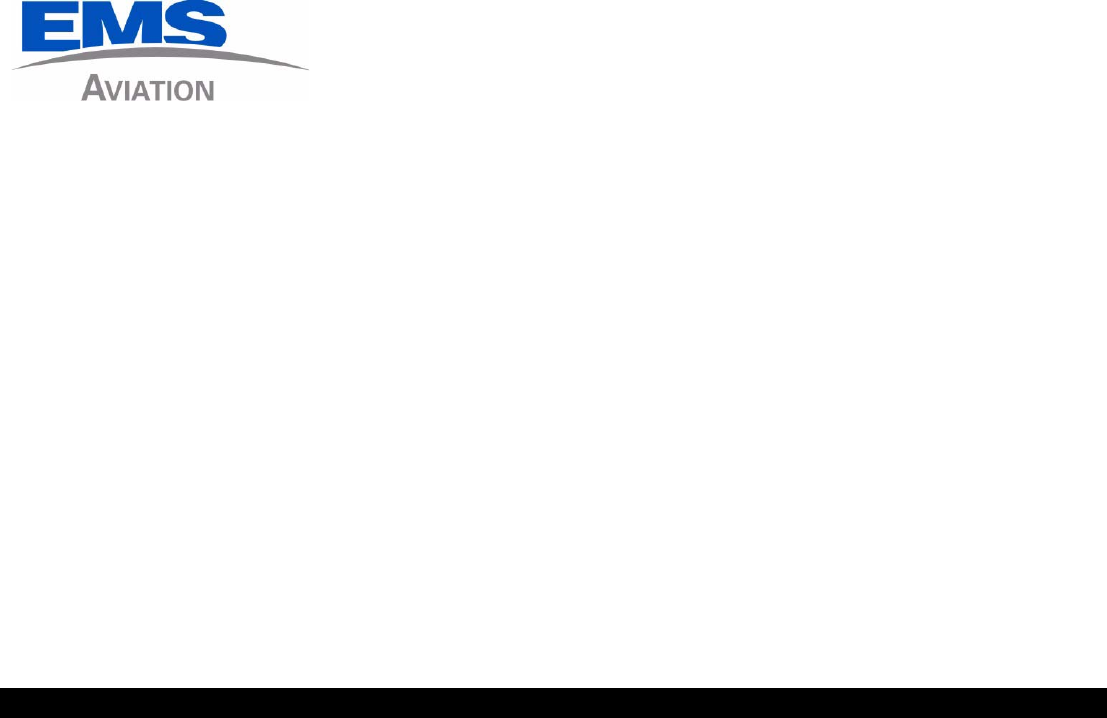
23-15-30 TITLE PAGE T-1
3 JUN 10
eNfusion® HSD-440 Mark 2 Terminal
System Description, Installation, and Maintenance Manual
MN-1252-33412, Revision 001
This document provides procedures for the equipment listed below.
Model Part Number
eNfusion® HSD-440 Mark 2 Terminal
115 V ac or 28 V dc
1252-A-3820-01
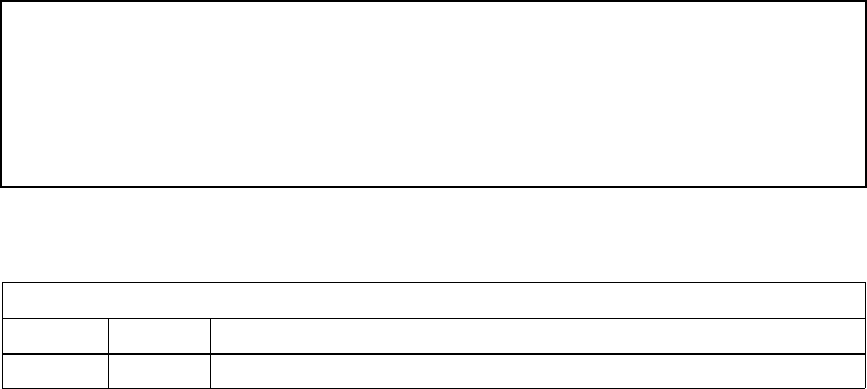
23-15-30 TITLE PAGE T-2
3 JUN 10
PROPRIETARY STATEMENT
This document contains information which is proprietary and confidential to EMS Aviation (EMS Technologies
Canada, Ltd., Formation Inc., Sky Connect LLC). Neither this document nor the information contained within
may be used for any purpose other than the purpose for which it was prepared. Neither this document nor the
information contained within may be disclosed or copied without the prior written permission of EMS Aviation.
© 2010 EMS Technologies Canada, Ltd., Formation Inc., Sky Connect LLC. All Rights Reserved.
HSD-440 Mark 2 Terminal System Description, Installation, and Maintenance Manual
Document Number: MN-1252-33412, Revision 001
Revision Table
Revision ECR Description
001 N/A Draft release for review.
Cabin Network Xcelerator® and CNX® are registered trademarks of EMS Technologies, Ltd. Windows® is a
registered trademark of Microsoft Corporation in the United States and other countries. Other product, brand,
service, and company names herein are the trademarks of their respective owners.
Our products are under continuous research and development. Any information may therefore be changed
without prior notice. EMS Aviation reserves the right to make improvements or changes in the product described
in this manual at any time without notice. While reasonable efforts have been made in the preparation of this
document to assure its accuracy, EMS Aviation assumes no liability resulting from any errors or omissions in
this document, or from the use of the information contained herein.
Printed in Canada.
EMS Aviation
400 Maple Grove Road, Ottawa, Ontario, K2V 1B8, CANADA
EMS Aviation Reception: (613) 591-9064
EMS Aviation Product Support: (888) 300-7415 (calls are routed to an on-call Product Support specialist
after regular business hours)
+44 1684 290 020 (UK)
(613) 591-3086 (outside North America)
EMS Aviation E-mail Help: support@emsaviation.com
EMS Aviation Web site: www.emsaviation.com
EMS Aviation Sales and Marketing: 800-600-9759
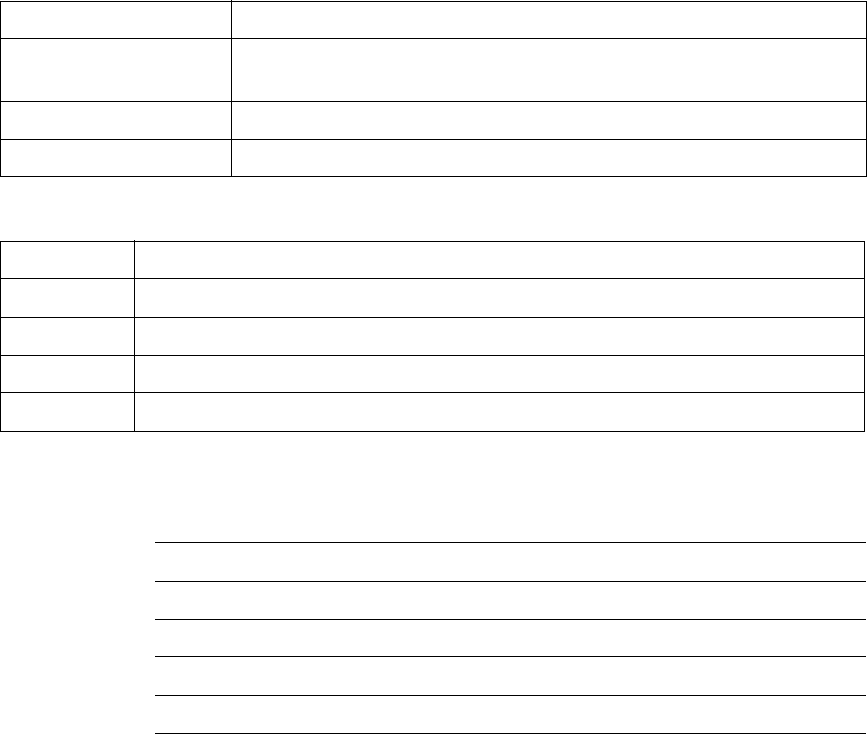
23-15-30 CR-1
3 JUN 10
CUSTOMER RESPONSE FORM
To help us improve the quality of our product documentation, EMS Aviation would appreciate your
comments and suggestions on this publication. Please complete the following customer survey and
send to EMS Aviation at:
EMS Aviation
400 Maple Grove Road
Ottawa, ON K2C 0P9
E-mail: techdocs@emsaviation.com
Publication information:
Publication number: MN-1252-33412
Publication title: HSD-440 Mark 2 TerminalSystem Description, Installation, and
Maintenance Manual
Latest issue date: June 3, 2010
Document revision: 001
Customer information:
Name:
Company:
Tel:
Fax:
Email:
Comments and suggestions:
Date:
Comments:
23-15-30 CR-2
3 JUN 10
Blank Page
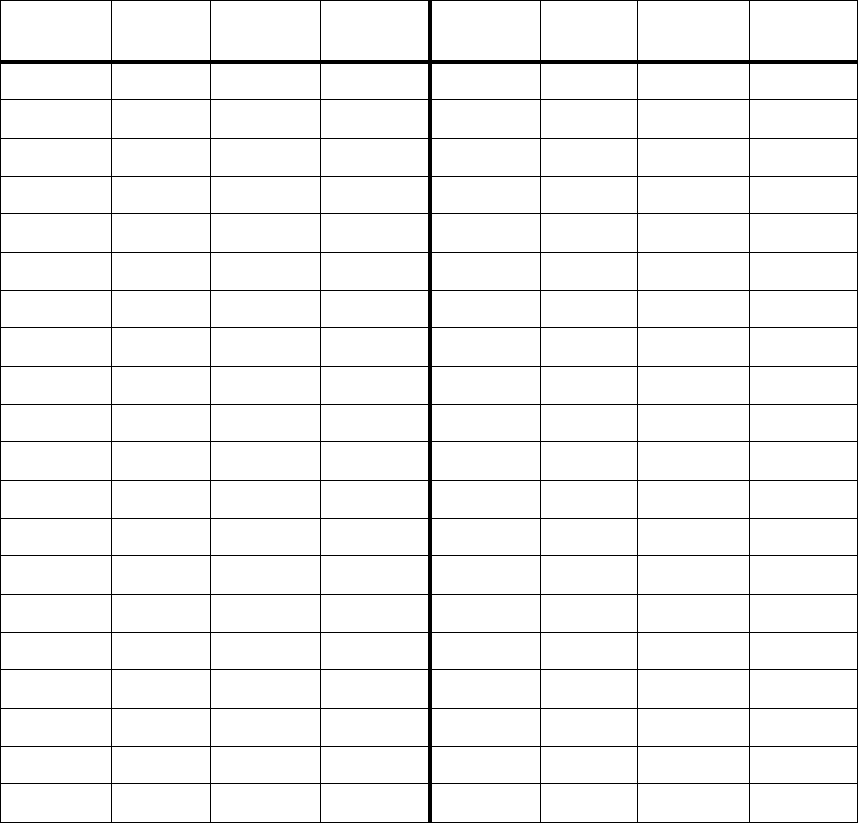
SYSTEM DESCRIPTION, INSTALLATION, AND MAINTENANCE MANUAL
eNfusion® HSD-440 Mark 2 Terminal
23-15-30 RR-1
3 JUN 10
RECORD OF REVISIONS
When revisions are received, insert revised pages, record the date, and initial.
Revision
Number Issue
Date Date
Inserted Inserted
by (initial) Revision
Number Issue
Date Date
Inserted Inserted
by (initial)
SYSTEM DESCRIPTION, INSTALLATION, AND MAINTENANCE MANUAL
eNfusion® HSD-440 Mark 2 Terminal
23-15-30 RR-2
3 JUN 10
Blank Page
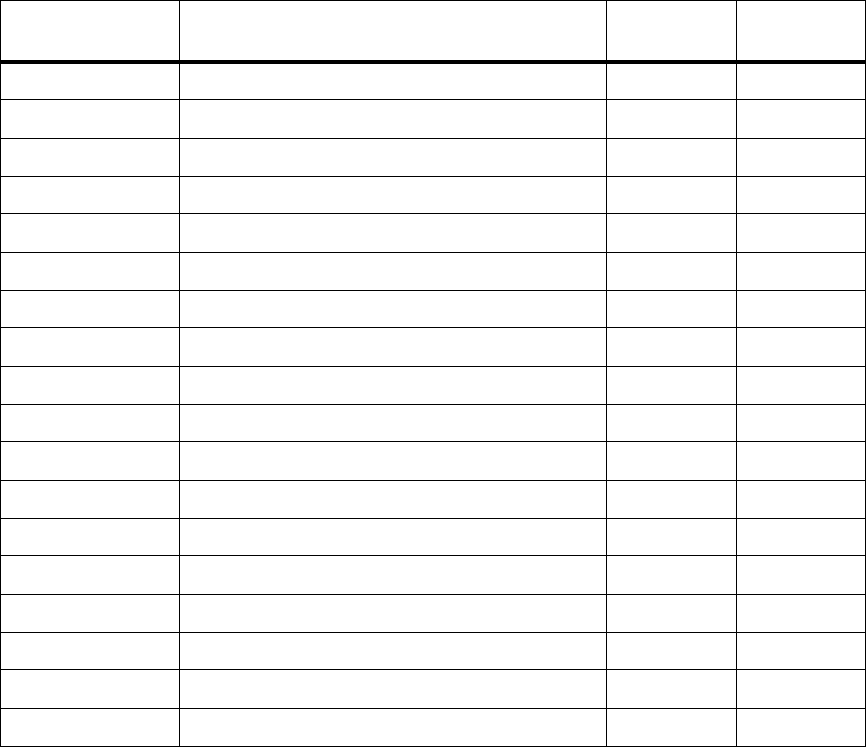
SYSTEM DESCRIPTION, INSTALLATION, AND MAINTENANCE MANUAL
eNfusion® HSD-440 Mark 2 Terminal
23-15-30 SBL-1
3 JUN 10
SERVICE BULLETIN LIST
Service Bulletin
Number Subject Manual Rev.
Number Manual Rev.
Date
N/A N/A N/A N/A
SYSTEM DESCRIPTION, INSTALLATION, AND MAINTENANCE MANUAL
eNfusion® HSD-440 Mark 2 Terminal
23-15-30 SBL-2
3 JUN 10
Blank Page
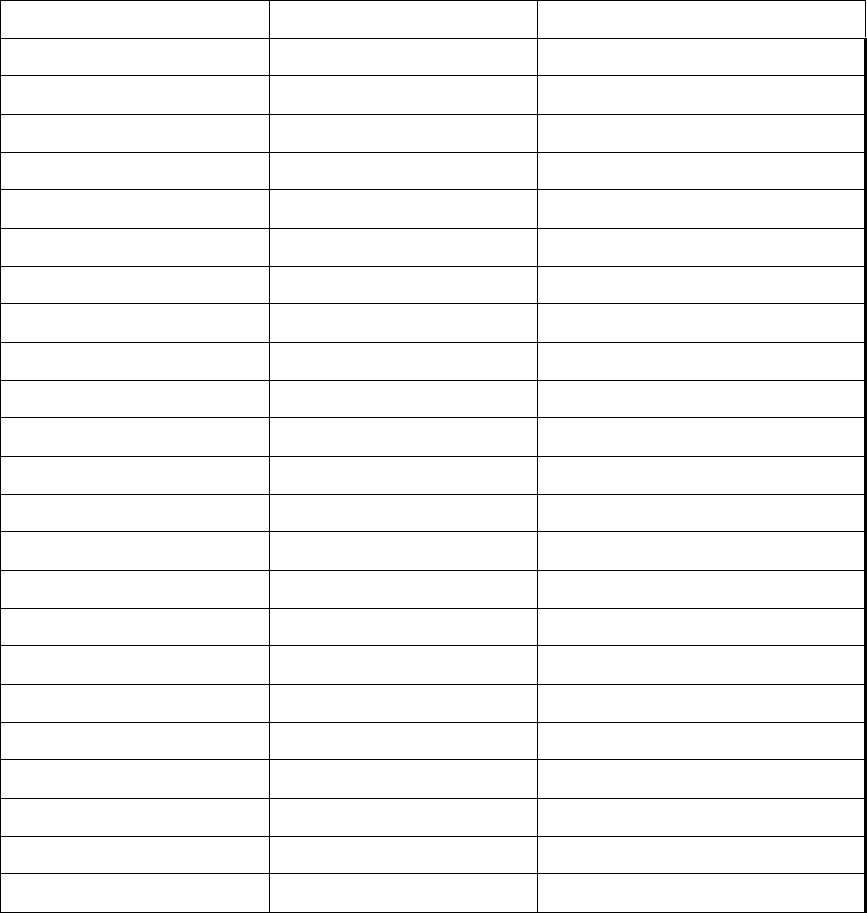
SYSTEM DESCRIPTION, INSTALLATION, AND MAINTENANCE MANUAL
eNfusion® HSD-440 Mark 2 Terminal
23-15-30 LEP-1
3 JUN 10
LIST OF EFFECTIVE PAGES
* An asterisk indicates pages changed, added, or deleted by the current revision.
F indicates a right foldout page with a blank back.
Section Page Date
SYSTEM DESCRIPTION, INSTALLATION, AND MAINTENANCE MANUAL
eNfusion® HSD-440 Mark 2 Terminal
23-15-30 LEP-2
3 JUN 10
Blank Page
SYSTEM DESCRIPTION, INSTALLATION, AND MAINTENANCE MANUAL
eNfusion® HSD-440 Mark 2 Terminal
23-15-30 TC-1
3 JUN 10
TABLE OF CONTENTS
1. Illustration of Equipment .............................................................................INTRO-2
2. Product Terms and Conditions...................................................................INTRO-2
3. Acronyms and Abbreviations......................................................................INTRO-2
4. Safety Advisories .........................................................................................INTRO-6
1. Inmarsat System Overview...................................................................................1-1
2. Equipment Overview.............................................................................................1-3
3. Equipment Specifications.....................................................................................1-5
4. System Interfaces................................................................................................1-10
A. Central Maintenance Computer (CMC) ..........................................................................1-10
B. Source Destination Identification (SDI) .......................................................................... 1-11
C. FWD IDs, ICAO IDs, and IMSI ....................................................................................... 1-11
D. Weight-On-Wheel (WOW) Pin Wiring ............................................................................ 1-11
E. IRS ARINC 429 Interface ...............................................................................................1-12
F. Antenna Interface ...........................................................................................................1-14
G. CMU ..............................................................................................................................1-14
H. Antenna Subsystem RF Interface ..................................................................................1-14
5. User Interfaces.....................................................................................................1-14
A. MCDU ............................................................................................................................1-14
B. WSC ...............................................................................................................................1-15
C. Remote Reset ................................................................................................................1-15
D. ISDN Circuit-Switched Data Interface ............................................................................1-15
E. Ethernet Data Interfaces ................................................................................................1-16
F. POTS Tip/Ring Interfaces ...............................................................................................1-16
G. CEPT-E1 Interface .........................................................................................................1-17
H. Maintenance Port Interface ............................................................................................1-17
(1) End User Access: Level 1..........................................................................................1-17
(2) Field Representative Access: Level 2........................................................................1-17
I. Fault Indicator LED ..........................................................................................................1-18
J. Self-Test .........................................................................................................................1-19
K. Remote Status Panel (Optional) ....................................................................................1-19
SYSTEM DESCRIPTION, INSTALLATION, AND MAINTENANCE MANUAL
eNfusion® HSD-440 Mark 2 Terminal
23-15-30 TC-2
3 JUN 10
6. Software Description .......................................................................................... 1-19
A. Software Specifications .................................................................................................. 1-19
B. Operational Software Part Numbers ..............................................................................1-19
C. Owner Requirements Table (ORT) ................................................................................ 1-20
1. Registering and Activating Terminals................................................................. 2-1
A. Preparing Terminal Information .......................................................................................2-1
(1) Obtaining ISNs.............................................................................................................2-1
(2) Identifying the Swift 64 Service Category and Terminal Type ..................................... 2-1
B. Obtaining ICAO Addresses .............................................................................................. 2-2
C. Choosing Service Providers ............................................................................................ 2-2
D. Registering Terminals ......................................................................................................2-2
2. Configuring Terminals ..........................................................................................2-3
A. Setting up Airborne Networks ..........................................................................................2-3
B. Mapping User Devices for ISDN Services .......................................................................2-3
C. IMNs ................................................................................................................................2-3
D. MSNs ...............................................................................................................................2-3
E. Configuring User ORT Parameters with the Maintenance Port Utility (MPU) .................. 2-4
F. Configuring Secure ORT Parameters with the Maintenance Port Utility (MPU) ............... 2-4
G. Creating ORTs with the Maintenance Port Utility (MPU) ................................................. 2-4
H. Understanding CMU Messages ....................................................................................... 2-4
I. Configuring Swift 64 LES Access Codes .........................................................................2-4
(1) General Overview ........................................................................................................ 2-4
(2) Changing Default LESs Using the MPU.......................................................................2-5
J. Removing the LED Label ..................................................................................................2-6
K. Activating Configurations .................................................................................................2-6
L. Verifying Configurations ...................................................................................................2-7
3. Using Terminals ....................................................................................................2-7
A. Placing Swift 64 Voice, SwiftBroadband, and Fax Calls .................................................. 2-7
(1) Dial Code Prefixes ....................................................................................................... 2-8
(2) Mobile-to-Mobile Communication...............................................................................2-10
B. Placing Calls with the CEPT-E1 Interface ...................................................................... 2-11
C. Using Data Connections ................................................................................................ 2-11
D. Operating the MCDU ..................................................................................................... 2-11
(1) Output Ports............................................................................................................... 2-11
(2) Input Ports.................................................................................................................. 2-11
(3) Screen........................................................................................................................ 2-11
SYSTEM DESCRIPTION, INSTALLATION, AND MAINTENANCE MANUAL
eNfusion® HSD-440 Mark 2 Terminal
23-15-30 TC-3
3 JUN 10
(4) Keyboard....................................................................................................................2-12
(5) Special Symbols......................................................................................................... 2-12
(6) Navigating the MCDU ................................................................................................2-13
(7) Viewing Flight Information..........................................................................................2-14
(8) Logging On and Off.................................................................................................... 2-14
(9) Viewing Channel Information ..................................................................................... 2-17
(10) Viewing Maintenance Information............................................................................ 2-21
(11) Configuring Headsets...............................................................................................2-23
E. Operating the WSC ........................................................................................................ 2-23
F. Performing Cockpit Communications with the MCDU .................................................... 2-24
(1) Modes of Operation.................................................................................................... 2-24
(2) Accepting and Making Calls....................................................................................... 2-24
1. Advisories..............................................................................................................3-1
2. Pre-Installation Inspection ...................................................................................3-1
A. Unpacking and Inspecting Equipment ............................................................................. 3-1
B. Cabling Notes ..................................................................................................................3-1
(1) Cabling.........................................................................................................................3-2
(2) Coaxial Cable Loss Considerations .............................................................................3-2
3. Mechanical Installation.........................................................................................3-2
A. Physical Placement ..........................................................................................................3-2
B. Environmental Requirements ........................................................................................... 3-2
(1) Heating and Cooling..................................................................................................... 3-2
(2) Fan Tray Requirements ............................................................................................... 3-3
C. Chassis Grounding ..........................................................................................................3-4
4. Electrical Installation ............................................................................................3-4
A. Cabling and Connector Requirements ............................................................................. 3-4
(1) Power Requirements.................................................................................................... 3-4
(2) Ground Requirements..................................................................................................3-4
(3) Cable Shielding and Termination................................................................................. 3-4
B. Installation Wiring Notes ..................................................................................................3-5
(1) Source/Destination Identification.................................................................................. 3-5
(2) Maintenance Port Interface.......................................................................................... 3-5
(3) Antenna Subsystem RF Interface ................................................................................3-6
(4) WOW Pins....................................................................................................................3-6
(5) ICAO IDs......................................................................................................................3-7
(6) Remote Status Panel (Optional) ..................................................................................3-9
(7) System Configuration Strapping ................................................................................ 3-10
(8) System Mode Strap Pins Coding ............................................................................... 3-10
(9) Call Light Activation Strapping ................................................................................... 3-11
SYSTEM DESCRIPTION, INSTALLATION, AND MAINTENANCE MANUAL
eNfusion® HSD-440 Mark 2 Terminal
23-15-30 TC-4
3 JUN 10
(10) Hookswitch Strapping .............................................................................................. 3-11
(11) Priority 4 Call Strapping............................................................................................ 3-11
(12) Cockpit Voice Strapping........................................................................................... 3-12
(13) User Interfaces......................................................................................................... 3-12
(14) System Interfaces .................................................................................................... 3-13
C. Connection Details .........................................................................................................3-15
5. Passive Intermodulation (PIM) Test................................................................... 3-16
A. Overview ........................................................................................................................3-16
B. PIM Requirements ......................................................................................................... 3-16
C. PIM Test ........................................................................................................................3-16
D. PIM Test Results ...........................................................................................................3-17
(1) PIM Test Overall Status ............................................................................................. 3-17
(2) Directional PIM Test Results......................................................................................3-19
6. Installation and Engineering Diagrams.............................................................3-19
A. Outline and Installation Diagrams .................................................................................. 3-19
B. Interconnection and Contact Assignment Drawings ...................................................... 3-19
7. Connection Details..............................................................................................3-19
1. Operational and Diagnostic Testing..................................................................4-35
A. General ..........................................................................................................................4-35
B. Test and Fault Isolation Equipment Requirements ........................................................ 4-35
C. Terminal Maintenance Port Utility ..................................................................................4-36
(1) General Overview ...................................................................................................... 4-36
(2) Connection Requirements..........................................................................................4-37
(3) Accessing the MPU.................................................................................................... 4-39
(4) Using the Terminal MPU............................................................................................4-39
(5) Menu Item Descriptions ............................................................................................. 4-40
(6) Report Descriptions....................................................................................................4-53
(7) Activating Maintenance Reports ................................................................................ 4-56
D. Inmarsat Cause Codes ..................................................................................................4-60
E. Operational and Diagnostic Test Procedures ................................................................ 4-60
(1) Test Setup Procedure ................................................................................................ 4-61
(2) Post Test....................................................................................................................4-61
(3) Installation and Operational Verification Tests........................................................... 4-62
(4) Configuration Parameters Verification .......................................................................4-63
(5) System Power-up Checks..........................................................................................4-68
(6) System On-Air Checks...............................................................................................4-70
(7) Antenna Tracking Checks.......................................................................................... 4-72
(8) Optional System Checks............................................................................................ 4-73
SYSTEM DESCRIPTION, INSTALLATION, AND MAINTENANCE MANUAL
eNfusion® HSD-440 Mark 2 Terminal
23-15-30 TC-5
3 JUN 10
2. Troubleshooting and Fault Isolation .................................................................4-74
A. Troubleshooting Practices .............................................................................................4-74
(1) Non-specific Complaints ............................................................................................ 4-74
(2) Specific Complaints.................................................................................................... 4-74
B. Equipment Required ...................................................................................................... 4-74
C. Troubleshooting Aids .....................................................................................................4-74
(1) Fault Isolation Screen Displays..................................................................................4-75
(2) Troubleshooting Table ............................................................................................... 4-79
D. Fault Isolation and Diagnostic Procedures .................................................................... 4-86
(1) General ...................................................................................................................... 4-86
(2) Saving a Diagnostic Reports File............................................................................... 4-86
3. Adjustment/Alignment Procedures ...................................................................4-88
4. Modification History............................................................................................4-88
1. Maintenance........................................................................................................... 5-1
2. Repair .....................................................................................................................5-1
A. Repair Tools and Supplies ............................................................................................... 5-1
B. Repair Procedures ...........................................................................................................5-1
C. Battery Replacement .......................................................................................................5-1
D. Removal Procedures ....................................................................................................... 5-1
E. Repair Facility Approvals .................................................................................................5-1
F. Return for Repair Information ...........................................................................................5-2
3. Instructions for Continued Airworthiness ..........................................................5-2
1. Configuring ORT Parameters Using the MPU ....................................................6-1
A. Connecting to the MPU .................................................................................................... 6-4
B. Configuring the ORT Part Number ...................................................................................6-4
C. Configuring Cockpit Communication Parameters ............................................................6-5
(1) Configuring the Call Signaling Mode............................................................................ 6-5
(2) Configuring Outgoing Call Signaling ............................................................................ 6-5
(3) Configuring Ground Public Routing.............................................................................. 6-5
D. Configuring 4-wire Parameters ........................................................................................ 6-6
(1) Configuring 4-wire Wiring.............................................................................................6-6
(2) Configuring Ground-to-Cockpit Call Routing................................................................ 6-6
(3) Configuring 4-wire Parameters .................................................................................... 6-6
E. Configuring POTS Parameters ........................................................................................6-7
(1) Configuring POTS........................................................................................................6-7
SYSTEM DESCRIPTION, INSTALLATION, AND MAINTENANCE MANUAL
eNfusion® HSD-440 Mark 2 Terminal
23-15-30 TC-6
3 JUN 10
F. Configuring CEPT-E1 Parameters .................................................................................... 6-7
(1) Configuring CEPT-E1 Interface....................................................................................6-8
(2) Configuring the CEPT-E1 Interface Type.....................................................................6-8
G. Configuring High Speed Data Services ...........................................................................6-8
(1) Configuring the Default PPPoE Service.......................................................................6-8
(2) Configuring SCPC High Speed Service....................................................................... 6-8
(3) Configuring MPDS High Speed Service.......................................................................6-9
(4) Configuring SBB High Speed Service.......................................................................... 6-9
H. Configuring Ethernet Parameters .................................................................................... 6-9
(1) Configuring Ethernet Wiring.........................................................................................6-9
(2) Configuring Ethernet Duplex Mode............................................................................6-10
(3) Configuring the Ethernet Port Address ...................................................................... 6-10
(4) Configuring the Ethernet Mask................................................................................... 6-10
I. Configuring Networking Parameters For Ethernet 1 and Ethernet 2 ............................... 6-11
(1) Configuring the Host Name........................................................................................ 6-11
(2) Configuring the Access Concentrator Name.............................................................. 6-11
(3) Configuring the SNMP Server.................................................................................... 6-11
(4) Configuring the SNMP Community String.................................................................. 6-11
(5) Configuring the TFTP Server .....................................................................................6-12
(6) Configuring the DHCP Client ..................................................................................... 6-12
(7) Configuring the DHCP Server....................................................................................6-12
(8) Configuring Telnet Access ......................................................................................... 6-12
(9) Configuring the Managed Range ...............................................................................6-12
(10) Configuring the Number of Managed Addresses..................................................... 6-13
(11) Configuring the Access Point Name......................................................................... 6-13
J. Configuring Avionics Parameters ................................................................................... 6-13
(1) Configuring the Primary Inertial Reference System (IRS).......................................... 6-13
(2) Configuring the Secondary IRS.................................................................................. 6-14
(3) Configuring the Secondary IRS Input Speed ............................................................. 6-14
(4) Configuring GNSS Equipment ...................................................................................6-14
(5) Configuring the ICAO Code Source........................................................................... 6-15
K. Configuring Satellite Service ORT Parameters .............................................................. 6-15
(1) Configuring the Forward ID........................................................................................ 6-15
(2) Configuring Satellite Information................................................................................ 6-16
(3) Configuring GES Service Provider Information.......................................................... 6-17
(4) Configuring the Frequency Table............................................................................... 6-18
(5) Configuring LES Service Provider Information........................................................... 6-19
(6) Configuring the SwiftBroadband Timing Mode........................................................... 6-19
(7) Configuring the Priority Service for Channel Card One ............................................. 6-20
(8) Configuring the Service Type Priority......................................................................... 6-20
SYSTEM DESCRIPTION, INSTALLATION, AND MAINTENANCE MANUAL
eNfusion® HSD-440 Mark 2 Terminal
23-15-30 TC-7
3 JUN 10
L. Configuring Antenna ORT Parameters .......................................................................... 6-20
(1) Configuring the Antenna Type ...................................................................................6-20
(2) Configuring the Antenna Mounting Rotation Angle.................................................... 6-21
(3) Configuring the Antenna Mounting Pitch Angle ......................................................... 6-21
(4) Configuring the Antenna Mounting Roll Angle ...........................................................6-21
(5) Configuring the HPA to Antenna Loss........................................................................ 6-22
(6) Configuring the Diplexer.............................................................................................6-22
M. Configuring MCDU ORT Parameters ............................................................................ 6-23
(1) Configuring MCDU Wiring.......................................................................................... 6-23
(2) Configuring the MCDU Input Speed........................................................................... 6-23
(3) Configuring the MCDU Output Speed........................................................................ 6-23
(4) Configuring the MCDU Controller Type .....................................................................6-23
(5) Configuring the MCDU Type...................................................................................... 6-24
(6) Configuring the MCDU Font Colour ........................................................................... 6-24
(7) Configuring Manual Dialing........................................................................................ 6-24
(8) Configuring Outgoing Call Pre-Selection ................................................................... 6-24
(9) Configuring the Address Book Categories................................................................. 6-25
N. Configuring the CMU ..................................................................................................... 6-25
(1) Configuring CMU Wiring ............................................................................................ 6-25
(2) Configuring the CMU Input Speed ............................................................................. 6-26
(3) Configuring the CMU Output Speed .......................................................................... 6-26
(4) Configuring the CMU-SDU Join/Leave Word.............................................................6-26
(5) Configuring Hardcoded SAL ...................................................................................... 6-27
O. Configuring Terminal Operation ....................................................................................6-27
(1) Configuring Air/Ground Status Restrictions ............................................................... 6-27
(2) Configuring Transmit on Ground................................................................................ 6-27
(3) Configuring Self-test in Air .........................................................................................6-28
(4) Configuring Maintenance Command Execution in Air................................................ 6-28
(5) Configuring MCDU PAST........................................................................................... 6-28
(6) Configuring Field Loadable Software......................................................................... 6-28
(7) Configuring the Logon/Handover Policy..................................................................... 6-29
(8) Configuring Logon Interrogation................................................................................. 6-29
(9) Configuring High-rate R/T in Global Beam................................................................. 6-29
(10) Masking Position in Logs ......................................................................................... 6-29
(11) Configuring HSD SAL............................................................................................... 6-30
P. Configuring Passive Intermodulation (PIM) Parameters ................................................ 6-30
(1) Configuring PIMBIT HGA Azimuth Offset Angle ........................................................ 6-30
(2) Configuring PIMBIT IGA Azimuth Offset Angle.......................................................... 6-30
(3) Configuring PIMBIT IGA Elevation Offset Angle1...................................................... 6-31
(4) Configuring PIMBIT IGA Elevation Offset Angle2...................................................... 6-31
(5) Configuring PIMBIT HGA Elevation Offset Angle1 ....................................................6-31
SYSTEM DESCRIPTION, INSTALLATION, AND MAINTENANCE MANUAL
eNfusion® HSD-440 Mark 2 Terminal
23-15-30 TC-8
3 JUN 10
(6) Configuring PIMBIT HGA Elevation Offset Angle2 ....................................................6-31
(7) Configuring PIMBIT Measurement Discard Ratio ...................................................... 6-31
(8) Configuring PIMBIT Failure Threshold....................................................................... 6-32
(9) Configuring PIMBIT Pointing Failure Threshold......................................................... 6-32
2. Configuring ORT Parameters Using the EMS ORT Application......................6-32
A. Creating an ORT Configuration .....................................................................................6-33
B. Opening a Saved ORT Configuration ............................................................................6-35
C. Importing a Phone Book Into the ORT Configuration .................................................... 6-35
D. Exporting an ORT File ................................................................................................... 6-37
E. Loading an ORT File into the HSD-440 Mark 2 Terminal ..............................................6-37
1. I-3 Satellites .......................................................................................................... A-1
2. I-4 Satellites .......................................................................................................... A-4
1. Understanding Messages Transmitted to the HSD-440 Mark 2 Terminal ........F-1
A. Understanding System Identification Label 172 ...............................................................F-1
B. Understanding Status Word 1; Label 270 ........................................................................F-1
C. Understanding Status Word 2; Label 276 ........................................................................F-2
D. Understanding Protocol File Transfer to SDU1 via Williamsburg ....................................F-2
2. Understanding Messages Received from the HSD-440 Mark 2 Terminal.........F-2
A. Understanding System Identification Label 172 ...............................................................F-2
B. Understanding Status Word 1; Label 270 ........................................................................F-3
C. Understanding Join/Leave Word; Label 271 ....................................................................F-5
D. Understanding Protocol File Transfer to CMU via Williamsburg ......................................F-6
3. Understanding BOP Options................................................................................F-6
4. Understanding LDUs and File Size......................................................................F-7
5. Understanding LDU Size and Word Count .........................................................F-7
6. Understanding Word Format................................................................................F-7
A. Understanding SALs ........................................................................................................F-7
B. Understanding Data .........................................................................................................F-7
C. Understanding General Format Identifier (GFI) Definitions .............................................F-8
7. Understanding Word Types .................................................................................F-8
A. Understanding the Full Binary Data Word .......................................................................F-9
B. Understanding the Partial Binary Data Word ...................................................................F-9
C. Understanding Protocol Words ........................................................................................F-9
SYSTEM DESCRIPTION, INSTALLATION, AND MAINTENANCE MANUAL
eNfusion® HSD-440 Mark 2 Terminal
23-15-30 TC-9
3 JUN 10
D. Understanding the Solo Word ........................................................................................F-10
E. Understanding Start of Transmission (SOT) ..................................................................F-11
F. Understanding End of Transmission (EOT) ....................................................................F-11
SYSTEM DESCRIPTION, INSTALLATION, AND MAINTENANCE MANUAL
eNfusion® HSD-440 Mark 2 Terminal
23-15-30 TC-10
3 JUN 10
Blank Page
SYSTEM DESCRIPTION, INSTALLATION, AND MAINTENANCE MANUAL
eNfusion® HSD-440 Mark 2 Terminal
23-15-30 TC-11
3 JUN 10
LIST OF FIGURES
Figure INTRO-1 HSD-440 Mark 2 Terminal........................................................................INTRO-2
Figure 1-1 Simplified Aeronautical Satellite Communications System ........................................1-2
Figure 1-2 HSD-440 Mark 2 Terminal SCM.................................................................................1-4
Figure 1-3 HSD-440Stand-Alone Terminal Interfaces ...............................................................1-10
Figure 1-4 HSD-440 Mark 2 Terminal ISDN Connections .........................................................1-16
Figure 2-1 Dialing-Sequence Components..................................................................................2-7
Figure 2-2 Mobile-to-Mobile Dialing Sequence..........................................................................2-10
Figure 2-3 MCDU Screen ..........................................................................................................2-12
Figure 2-4 MCDU Menus...........................................................................................................2-13
Figure 3-1 Fan Tray Plug Configuration (black = installed, white = removed).............................3-3
Figure 3-2 ICAO ID, Hex to Binary Conversion ...........................................................................3-8
Figure 3-3 Remote Reset Circuit Switch......................................................................................3-9
Figure 3-4 Remote LED Panel Circuit........................................................................................3-10
Figure 3-5 RJ45 Connector Terminator Details .........................................................................3-13
Figure 3-6 Example PIM Test Results .......................................................................................3-18
Figure 3-7 (Sheet 1). HSD-440 Mark 2 Terminal Outline and Installation Diagram
(1252-E-3820-01, Rev A) ...............................................................................................3-27
Figure 3-8 (Sheet 2). HSD-440 Mark 2 Terminal Outline and Installation Diagram
(1252-E-3820-01, Rev A) ...............................................................................................3-29
Figure 3-9 (Sheet 1). HSD-440 Mark 2 Terminal
System Interconnection Diagram (1252-B-3820, Rev B) ...............................................3-31
Figure 3-10 (Sheet 2). HSD-440 Mark 2 Terminal
System Interconnection Diagram (1252-B-3820, Rev B) ...............................................3-33
Figure 4-1 Remote Connection, Maintenance Cable.................................................................4-38
Figure 4-2 Direct Connection, Maintenance Cable ....................................................................4-38
Figure 4-3 Menu 2 Screen Display ............................................................................................4-42
Figure 4-4 Menu 3 Screen Display ............................................................................................4-43
Figure 4-5 Menu 3 - Item M: Miscellaneous EEPROM Parameters ..........................................4-45
Figure 4-6 Menu 4 Screen Display ............................................................................................4-48
Figure 4-7 Menu 10 Screen Display ..........................................................................................4-49
Figure 4-8 Menu 13 Screen Display ..........................................................................................4-50
Figure 4-9 Menu 14 Screen Display ..........................................................................................4-51
Figure 4-10 Menu 15 Screen Display ........................................................................................4-51
Figure 4-11 Menu 21 Screen Display ........................................................................................4-52
SYSTEM DESCRIPTION, INSTALLATION, AND MAINTENANCE MANUAL
eNfusion® HSD-440 Mark 2 Terminal
23-15-30 TC-12
3 JUN 10
Figure 4-12 Menu 30 Screen Display ........................................................................................ 4-53
Figure 4-13 HSD-440 Mark 2 Terminal MPU Reports.............................................................. 4-56
Figure 4-14 Example Report 23 Output..................................................................................... 4-57
Figure 4-15 Prompt to Select Channel for Report Generation................................................... 4-58
Figure 4-16 Example of Report 17, Channel Card 2, Channel 3 ............................................... 4-58
Figure 4-17 Example of Report 20............................................................................................. 4-59
Figure 4-18 Example Report 21.................................................................................................4-59
Figure 4-19 HSD-440 Mark 2 Terminal ORT Display Example ................................................. 4-67
Figure 4-20 HSD-440 Mark 2 Terminal Power-Up Display Example......................................... 4-70
Figure 4-21 HSD-440 Mark 2 Terminal Call Display Example.................................................. 4-72
Figure 4-22 Successful OR Registration (report 21 activated) ..................................................4-75
Figure 4-23 Failed OR Registration ...........................................................................................4-75
Figure 4-24 No Call (report 23).................................................................................................. 4-75
Figure 4-25 In Call—Swift 64 Voice Call on Channel 1 (reports 21 and 23).............................. 4-75
Figure 4-26 No IRS Data (report 23 activated) ..........................................................................4-76
Figure 4-27 FWD ID Not Strapped (no reports activated) ......................................................... 4-76
Figure 4-28 No Strap on SDI Lines, Open (no reports activated).............................................. 4-77
Figure 4-29 Wrong Strap on SDI Lines (TP5A to GND) ............................................................4-78
Figure 4-30 Incorrect Dialing Format (report 52 enabled) ......................................................... 4-78
Figure 4-31 Top/Port Antenna Status (reports 18, 19, and 20 activated) .................................. 4-79
Figure A-1 ORs............................................................................................................................A-1
Figure A-2 Inmarsat I-3 Satellite Beam Coverage—Composite Map ..........................................A-2
Figure A-3 Inmarsat I-3 Satellite Beam Coverage—OR Maps ....................................................A-3
Figure A-4 Inmarsat I-4 Satellite Beam Coverage Map ...............................................................A-4
SYSTEM DESCRIPTION, INSTALLATION, AND MAINTENANCE MANUAL
eNfusion® HSD-440 Mark 2 Terminal
23-15-30 TC-13
3 JUN 10
LIST OF TABLES
Table 1-1 HSD-440 Mark 2 Terminal Characteristics and Specifications ...................................1-5
Table 1-2 HSD-440 Mark 2 Terminal RTCA/DO-160E Environmental Characteristics ..............1-8
Table 1-3 Inertial Type Labels ..................................................................................................1-12
Table 1-4 GNSS Type Labels...................................................................................................1-12
Table 1-5 Hybrid Type Labels...................................................................................................1-13
Table 1-6 AES ID Type Labels .................................................................................................1-14
Table 1-7 HSD-440 Mark 2 Terminal LED Output Designations ..............................................1-18
Table 1-8 HSD-440 Mark 2 Terminal Operational Software .....................................................1-19
Table 2-1 Inmarsat Swift 64 LES Operator and Access Codes..................................................2-5
Table 2-2 Dial Code Prefixes for Forcing Service Type Selection..............................................2-8
Table 2-3 Dial Code Prefixes for System Overrides .................................................................2-10
Table 2-4 Call Discrete Outputs in HSD-440 Mark 2 Terminal .................................................2-25
Table 2-5 Priority Codes ...........................................................................................................2-26
Table 3-1 Cable Shielding and Termination Specifications ........................................................3-5
Table 3-2 RF Parameters Definitions..........................................................................................3-6
Table 3-3 WOW Pin Wiring.........................................................................................................3-7
Table 3-4 Configuration Pin Summary......................................................................................3-10
Table 3-5 System Pin Strapping ...............................................................................................3-11
Table 3-6 Call Light Activation Configuration Strapping ...........................................................3-11
Table 3-7 Hookswitch Configuration Strapping.........................................................................3-11
Table 3-8 Priority 4 Call Configuration Strapping......................................................................3-12
Table 3-9 Chime and Light Strapping for Cockpit Voice...........................................................3-12
Table 3-10 RJ45 Wiring Details ................................................................................................3-13
Table 3-11 HSD-440 Mark 2 Terminal to BSU Interconnects...................................................3-14
Table 3-12 CMU Strapping .......................................................................................................3-15
Table 3-13 MCDU Strapping.....................................................................................................3-15
Table 3-14 HSD-440 Stand-Alone Terminal Top Plug Connection Details...............................3-20
Table 3-15 HSD-440 Stand-Alone Terminal Middle Plug Connection Details ..........................3-23
Table 3-16 HSD-440 Stand-Alone Terminal Bottom Plug Connection Details .........................3-26
Table 4-1 List of Required Test Equipment ..............................................................................4-36
Table 4-2 List of Optional Test Equipment................................................................................4-36
Table 4-3 Remote Connection Cabling.....................................................................................4-37
Table 4-4 Direct Connection Cabling........................................................................................4-37
SYSTEM DESCRIPTION, INSTALLATION, AND MAINTENANCE MANUAL
eNfusion® HSD-440 Mark 2 Terminal
23-15-30 TC-14
3 JUN 10
Table 4-5 Terminal Connection Settings .................................................................................. 4-39
Table 4-6 Menu 1 Item Descriptions......................................................................................... 4-41
Table 4-7 Menu 2 Item Descriptions......................................................................................... 4-42
Table 4-8 Menu 3 Item Descriptions......................................................................................... 4-43
Table 4-9 Menu 3, Item M EEPROM Parameter Descriptions.................................................. 4-45
Table 4-10 Menu 4 Item Descriptions....................................................................................... 4-48
Table 4-11 Menu 10 Item Descriptions..................................................................................... 4-49
Table 4-12 Menu 13 Item Descriptions..................................................................................... 4-50
Table 4-13 Menu 14 Item Descriptions..................................................................................... 4-51
Table 4-14 Menu 15 Item Descriptions..................................................................................... 4-52
Table 4-15 Menu 21 Item Descriptions..................................................................................... 4-52
Table 4-16 Menu 30 Item Descriptions ...................................................................................4-53
Table 4-17 Report 23 Item Descriptions ................................................................................... 4-57
Table 4-18 Reports 8 and 20 Item Descriptions .......................................................................4-59
Table 4-19 Report 21 Item Descriptions ................................................................................... 4-60
Table 4-20 Test Setup Procedure.............................................................................................4-61
Table 4-21 Post Test Procedure............................................................................................... 4-61
Table 4-22 HSD-440 Mark 2 Terminal Mechanical Verification...............................................4-62
Table 4-23 HSD-440 Mark 2 Terminal Electrical Verification Checklist...................................4-62
Table 4-24 Troubleshooting and Fault Isolation ....................................................................... 4-80
Table 6-1 Configuring Secure ORT Parameters......................................................................... 6-1
Table 6-2 User ORT Parameters................................................................................................ 6-4
Table F-1 Status Word 1.............................................................................................................F-1
Table F-2 Bits 9 and 10 Positions...............................................................................................F-2
Table F-3 Status Word 1 Bits......................................................................................................F-3
Table F-4 Join/Leave Word Bits .................................................................................................F-5
Table F-5 BOP Option Defaults ..................................................................................................F-6
Table F-6 BOP Word Format......................................................................................................F-7
Table F-7 GFI Definitions............................................................................................................F-8
Table F-8 Word Types ................................................................................................................F-8
Table F-9 Protocol Words and Uses...........................................................................................F-9
Table F-10 Data Types .............................................................................................................F-10
Table G-1 International Access and Country Codes ................................................................. G-1
Table H-1 Inmarsat Cause Code Definitions ............................................................................. H-1

SYSTEM DESCRIPTION, INSTALLATION, AND MAINTENANCE MANUAL
eNfusion® HSD-440 Mark 2 Terminal
23-15-30 INTRO-1
3 JUN 10
INTRODUCTION
This manual provides the specifications, principles of operation, and information necessary to install
the:
• HSD-440 Mark 2 Terminal, 1252-A-3820-01
This document is divided into the following sections:
• System Description
• System Operation
• Installation
• Test and Fault Isolation
• Maintenance and Repair
• Configuring the Owners Requirements Table (ORT)
• Appendix A: Inmarsat Satellite Beam Coverage
• Appendix B: Troubleshooting Checklist
• Appendix C: RJ45 Cable Termination Details
• Appendix D: Installation Planning Checklist
• Appendix E: Installation Checklist
• Appendix F: CMU Messages
• Appendix G: International Access and Country Codes
• Appendix H: Inmarsat Cause Codes
• Appendix I: CMC Messages
NOTE: An Illustrated Parts List is not included with this manual.
Only qualified avionics personnel who are knowledgeable in the technical and safety issues related
to the installation of aircraft communications equipment should perform the installation procedures
provided in this manual.
This manual includes general installation guidelines only; it is not intended to provide specific
procedures for every type of installation.
If necessary, the information in this manual will be revised. Before attempting the installation
procedures presented in this manual, verify that you have a complete and up-to-date release of this
document.
NOTE: Depending on your HSD-440 Mark 2 Terminal’s software version and configuration, the
actual (live) system messages you see, such as dialog boxes and screen displays, may
differ slightly from the examples in this manual.
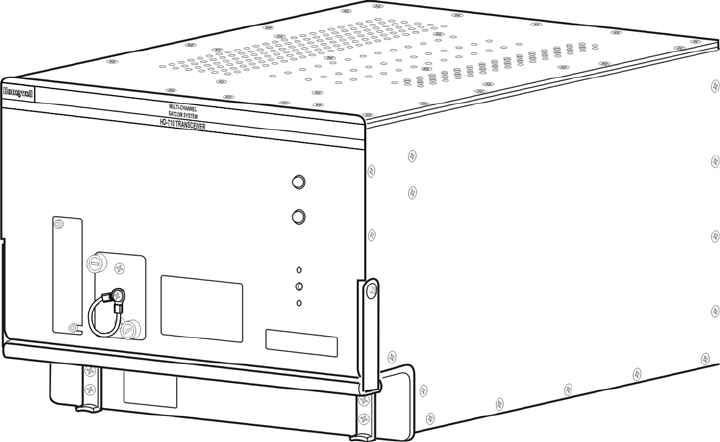
SYSTEM DESCRIPTION, INSTALLATION, AND MAINTENANCE MANUAL
eNfusion® HSD-440 Mark 2 Terminal
23-15-30 INTRO-2
3 JUN 10
1. Illustration of Equipment
Figure INTRO-1 shows the HSD-440 Mark 2 Terminal.
Figure INTRO-1 HSD-440 Mark 2 Terminal
2. Product Terms and Conditions
As stipulated in the Terms and Conditions of Sale, which accompanied the Product, EMS
Aviation shall not at any time be liable for the activation, continuation, or cancellation of satellite
airtime services relating to the Product nor be responsible for any Product-related airtime or
network charges, however incurred. In the event EMS Aviation is charged network or airtime
fees relating to the customer’s use of the Product, the customer shall immediately upon
notification by EMS Aviation reimburse EMS Aviation in full for such charges.
3. Acronyms and Abbreviations
The following acronyms and abbreviations are used in this document.
AC Access Concentrator
ac Alternating Current
ACARS Aircraft Communication Addressing and Reporting System
ACP Audio Control Panel
ACSE Access Control and Signalling Equipment
ACU Antenna Control Unit (also known as BSU or Driver)
AERO Aeronautical
AES Aircraft Earth Station
AMBE Advanced Multi Band Excitation
SYSTEM DESCRIPTION, INSTALLATION, AND MAINTENANCE MANUAL
eNfusion® HSD-440 Mark 2 Terminal
23-15-30 INTRO-3
3 JUN 10
Americas Americas (satellite)
AMO Approved Maintenance Organization
AOR-E Atlantic Ocean Region-East
AOR-W Atlantic Ocean Region-West
APAC Asia-Pacific (satellite)
ATC Air Traffic Control
AWG American Wire Gauge
BGAN Broadband Global Area Network
BITE Built-In Test Equipment
BOP Bit Oriented Protocol
bps Bits per second
BRI Basic Rate ISDN
BSU Beam Steering Unit (also known as ACU or Driver)
C/No Carrier-to-Noise
CCW Counter Clockwise
CFDS Centralized Fault Display System
CMC Central Maintenance Computer
CMU Communications Management Unit
CRC Cyclic Redundancy Check
CW Clockwise
dc Direct Current
DITS Digital Information Transfer System
DLNA Diplexer/Low-Noise Amplifier
DSL Digital Subscriber Line
D-UART Dual Universal Asynchronous Receiver Transmitter
EIRP Effect Isotropic Radiated Power
EMI Electromagnetic Interference
ESD Electrostatic Discharge
EST Eastern Standard Time
EMEA Europe / Middle East Africa (satellite)
FAA Federal Aviation Authority
FET Field-Effect Transistor
FMS Flight Management System
FRLP Forward Return Link Pair
FWD ID Forward ID
GES Ground Earth Station
GND Ground
GNSS Global Navigation Satellite System
HGA High-gain Antenna
HPA High Power Amplifier
HTML Hyper Text Markup Language
Hz Hertz
SYSTEM DESCRIPTION, INSTALLATION, AND MAINTENANCE MANUAL
eNfusion® HSD-440 Mark 2 Terminal
23-15-30 INTRO-4
3 JUN 10
I/O Input/Output
ICAO International Civil Aviation Organization
ICD Interconnection Drawing
IMEI International Mobile Equipment Identifier
IMSI International Mobile Subscriber Identifier
IMN Inmarsat Mobile Number
INS Inertial Navigational System
IOR Indian Ocean Region
IRS Inertial Reference System
ISDN Integrated Services Digital Network
ISN Inmarsat Serial Number
ISP Inmarsat Service Providers
ISP Internet Service Provider
JAA Joint Aviation Authorities
kbps Kilobits per Second
LAN Local Area Network
LES Land Earth Station
LRU Line Replaceable Unit
LS line select
LSB Least Significant Bit
MA Mechanical Steered Antenna
Mbps Megabit per second
MCDU Multipurpose Control Display Unit
MCU Modular Concept Unit
MES Mobile Earth Station
M-ISDN Mobile Integrated Services Digital Network
MPDS Mobile Packet Data Services
MPU Maintenance Port Utility
ms Millisecond
MSB Most Significant Bit
MSN Mobile Serial Number
MSN Multiple Subscriber Number
MTSAT Meteorological Satellite
NAT Network Address Translation
NO normally open
NT Network Terminator
O&I Outline and Installation Diagram
OA Other Antenna
OCXO Oven Controlled Crystal Oscillator
OEM Original Equipment Manufacturer
OR Ocean Region
ORR Ocean Region Registration
SYSTEM DESCRIPTION, INSTALLATION, AND MAINTENANCE MANUAL
eNfusion® HSD-440 Mark 2 Terminal
23-15-30 INTRO-5
3 JUN 10
ORT Owner Requirements Table
PAST Person Activated Self Test
PC Personal Computer (or laptop)
PIM Passive Intermodulation
PN Part Number
POR Pacific Ocean Region
POST Power On Self Test
POTS Plain Old Telephone System
PPP Point-to-Point Protocol
PPPoE Point-to-Point Protocol over Ethernet
PSTN Public Switch Telephone Network
PTT Push-to-Talk
RAM Random Access Memory
REA Responsible Engineering Authority
RF Radio Frequency
RFI Radio Frequency Interference
RFU Radio Frequency Unit
rms root mean square
ROM Read-only Memory
RTN Return
Rx Receive
S/T (ISDN) ISDN ‘S interface’ refers to the electrical interface between NT1 and NT2
devices, such as a PBX. ISDN ‘T interface’ refers to the electrical interface
between NT1 or NT2 and ISDN devices.
SBB SwiftBroadband
SCM SDU Configuration Module
SCPC Single Channel per Carrier
SDI Source/Destination Identification
SDU Satellite Data Unit
SNAC Single Network Access Code
SPID Service Profile Identifier
STBD Starboard
STE Secure Terminal Equipment
STU Secure Telephone Unit
TA Terminal Adapter
TE Terminal Equipment
TFTP Trivial File Transfer Protocol
Tx Transmit
USIM Universal Subscriber Identity Module
VHF very high frequency
VSWR Voltage Standing Wave Ratio
WOW Weight on Wheels
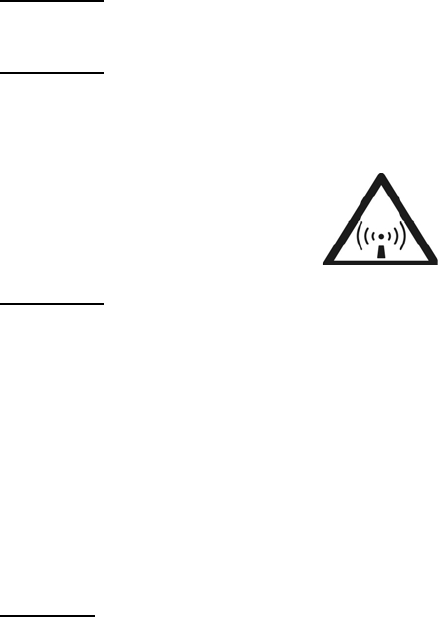
SYSTEM DESCRIPTION, INSTALLATION, AND MAINTENANCE MANUAL
eNfusion® HSD-440 Mark 2 Terminal
23-15-30 INTRO-6
3 JUN 10
WSC Williamsburg SDU Controller
WSCI Williamsburg SDU Controller Interface
4. Safety Advisories
Warnings, cautions, and notes in this manual provide the reader with the following information:
• A WARNING describes an operation, procedure, or condition that, if not obeyed, could
cause injury or death.
• A CAUTION describes an operation, procedure, or condition that, if not obeyed, could cause
damage to the equipment.
• A NOTE provides supplementary information or explanatory text that makes it easier to
understand and perform procedures.
All personnel who install, operate, and maintain the HSD-440 Mark 2 Terminal and associated
test equipment must know and obey the safety precautions listed below. The procedures
provided in this manual assume that the person performing installation or maintenance tasks
is familiar with and obeys standard aviation shop and safety practices.
The general safety advisories include the following:
WARNING: TO AVOID RISK OF INJURY FROM ELECTRIC SHOCK, DISCONNECT THE
POWER FROM THE TERMINAL DURING INSTALLATION AND REMOVAL.
WARNING: SERVICE PERSONNEL MUST OBEY STANDARD SAFETY PRECAUTIONS,
SUCH AS WEARING SAFETY GLASSES, TO PREVENT PERSONAL INJURY
WHILE INSTALLING OR PERFORMING SERVICE ON THIS TERMINAL.
WARNING: ASSOCIATED SATELLITE COMMUNICATIONS EQUIPMENT RADIATES
HIGH FREQUENCY RADIATION AND POSES A RADIATION HAZARD OF 1.6
GHZ. SERVICE PERSONNEL MUST EXERCISE CARE TO KEEP CLEAR OF
THE ANTENNA'S BEAM WHILE PERFORMING OPERATIONAL TESTS OR
INSTALLATION VERIFICATION PROCEDURES.
DO NOT APPROACH WITHIN 8 FEET (2.5 METRES) OF THE ANTENNA
DURING ANTENNA OPERATION (TRANSMISSION).
DURING ANTENNA OPERATION (TRANSMISSION), MAKE SURE THAT
PERSONNEL ARE EXPOSED TO A MINIMUM OF ANY REFLECTED,
SCATTERED, OR DIRECT BEAMS.
CAUTION: TURN OFF POWER BEFORE DISCONNECTING ANY TERMINAL FROM
WIRING. DISCONNECTING THE TERMINAL WITHOUT TURNING POWER
OFF MAY CAUSE VOLTAGE TRANSIENTS THAT CAN DAMAGE THE
TERMINAL.

SYSTEM DESCRIPTION, INSTALLATION, AND MAINTENANCE MANUAL
eNfusion® HSD-440 Mark 2 Terminal
23-15-30 INTRO-7
3 JUN 10
CAUTION: THIS EQUIPMENT INCLUDES ITEMS THAT ARE ELECTROSTATIC
DISCHARGE SENSITIVE (ESDS) DEVICES. ESDS DEVICES ARE SUBJECT
TO DAMAGE BY EXCESSIVE LEVELS OF VOLTAGE AND/OR CURRENT.
THE LOW-ENERGY SOURCE THAT MOST COMMONLY DESTROYS ESDS
DEVICES IS THE HUMAN BODY, WHICH, IN CONJUNCTION WITH
NONCONDUCTIVE GARMENTS AND FLOOR COVERINGS, GENERATES
AND RETAINS STATIC ELECTRICITY. TO ADEQUATELY PROTECT ESDS
DEVICES, THE DEVICE AND EVERYTHING THAT CONTACTS IT MUST BE
BROUGHT TO GROUND POTENTIAL BY PROVIDING A CONDUCTIVE
SURFACE AND DISCHARGE PATHS. USE STANDARD INDUSTRY
PRECAUTIONS TO KEEP RISK OF DAMAGE TO A MINIMUM WHEN
TOUCHING, REMOVING, OR SERVICING THE EQUIPMENT.
SYSTEM DESCRIPTION, INSTALLATION, AND MAINTENANCE MANUAL
eNfusion® HSD-440 Mark 2 Terminal
23-15-30 INTRO-8
3 JUN 10
Blank Page
SYSTEM DESCRIPTION, INSTALLATION, AND MAINTENANCE MANUAL
eNfusion® HSD-440 Mark 2 Terminal
23-15-30 1-1
3 JUN 10
SYSTEM DESCRIPTION
This section includes basic information about HSD-440 Mark 2 Terminals, and includes the following
sections:
• Inmarsat System Overview
• Equipment Overview
• Equipment Specifications
• System Interfaces
• User Interfaces
• Software Description
1. Inmarsat System Overview
This section provides an overview of the Inmarsat satellite communications system and
networks.
The satellite communication system includes global satellite networks, Land Earth Stations
(LESs), Ground Earth Stations (GESs), Aircraft Earth Stations (AESs), and Mobile Earth
Stations (MESs).
The LES/GES is the part of the satellite communication system that is on the ground. These
numerous, international stations are responsible for routing voice and data calls from the
MES/AES to their destinations around the world.
The MES/AES is the part of the satellite communication system that is on the aircraft. This
station includes the following components:
• HSD-440 Mark 2 Terminal
• Antenna subsystem
• Cabin communications system
• Analog connected telephones
• Cockpit voice system
• Other aircraft avionics
Figure 1-1 illustrates a simplified satellite communications system.
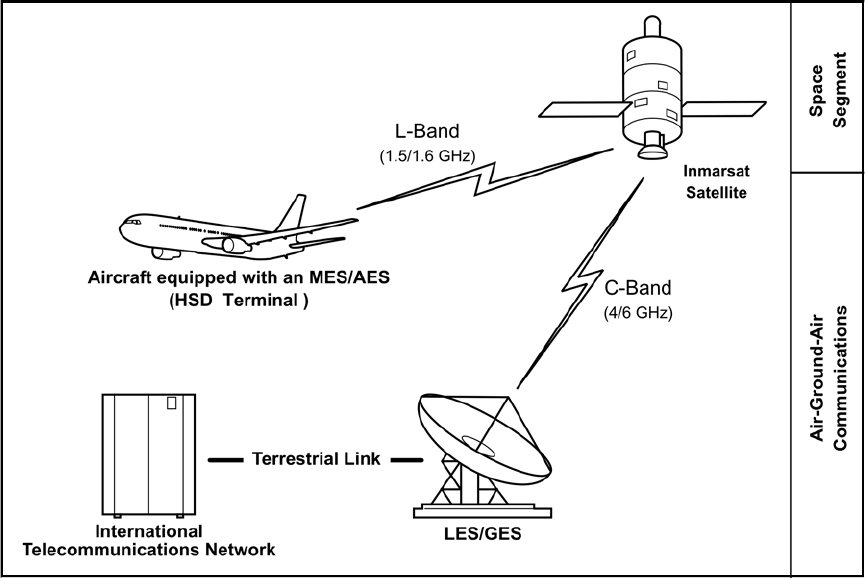
Figure 1-1 Simplified Aeronautical Satellite Communications System
SYSTEM DESCRIPTION, INSTALLATION, AND MAINTENANCE MANUAL
eNfusion® HSD-440 Mark 2 Terminal
23-15-30 1-2
3 JUN 10
Satellite communication systems provide users with long-range voice and data communication
by accessing global satellite and ground communications networks.
Inmarsat is an international organization that operates and maintains multiple geostationary
satellites and satellite networks. Inmarsat networks provide services for aviation, shipping, and
land-mobile terminals. Inmarsat provides information about satellite beam coverage at
www.inmarsat.com.
Inmarsat’s I-3 satellites provide Aero H+ and Swift 64 services for aviation. The satellites
connect to ground telecommunication systems through the LES/GES. Each satellite is located
over an Ocean Region (OR)—the current OR names are:
• Atlantic Ocean Region-East (AOR-E)
• Atlantic Ocean Region-West (AOR-W)
• Indian Ocean Region (IOR)
• Pacific Ocean Region (POR)
SYSTEM DESCRIPTION, INSTALLATION, AND MAINTENANCE MANUAL
eNfusion® HSD-440 Mark 2 Terminal
23-15-30 1-3
3 JUN 10
Inmarsat’s I-4 satellites provide SwiftBroadband (SBB) services and Aero H+ services. The
three I-4 satellites are:
• Americas
• EMEA (Europe, Middle East and Africa)
• Asia-Pacific
The HSD-440 Mark 2 Terminal, in conjunction with an ARINC 741/781 High-gain Antenna
(HGA), acts as an MES/AES. The combined system provides users with a data and voice
communications link to the satellite network and global telecommunications system.
2. Equipment Overview
HSD-440 Mark 2 Terminals are scalable, high-speed data, satellite communications terminals
that provide world-wide voice and data services to aircraft through high-speed communication
links with the Inmarsat Satellite Network. HSD-440 Mark 2 Terminals interface with ARINC
741/781-compatible antenna subsystems to communicate with the space segment of the
Inmarsat Satellite Network via L-band RF signals.
HSD-440 Mark 2 Terminals communicate with various avionics equipment, such as the aircraft’s
IRS and CMU, to coordinate and access a wide range of services. The HSD-440 Mark 2
Terminals also communicate with cabin and cockpit voice and data equipment to provide phone,
fax, Internet connection, and other services on board the aircraft.
HSD-440 Mark 2 Terminals contain the following:
• One channel card for Swift 64 or SBB services
• One Classic Aero multi-channel channel card
• Data input/output (I/O) card
• High stability reference oscillator
• Control processor card
• High Power Amplifier (HPA)
• SDU Configuration Module (SCM)
• Universal (115 V ac 400 Hz / 28 V dc) power supply
HSD-440 Mark 2 Terminals support the following services:
• Inmarsat Mobile Integrated Services Digital Network (M-ISDN) Single Channel Per Carrier
(SCPC) Service
• Inmarsat Mobile Packet Data Services (MPDS) via PPPoE
• Inmarsat Aero P, R, T channel data
• Two channels of Inmarsat Aero C channel H+ voice
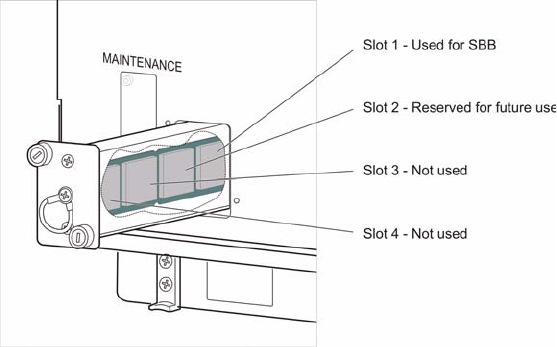
SYSTEM DESCRIPTION, INSTALLATION, AND MAINTENANCE MANUAL
eNfusion® HSD-440 Mark 2 Terminal
23-15-30 1-4
3 JUN 10
• Cockpit communications for air-to-ground calls using the MCDU, or the WSC
• CEPT-E1
• SwiftBroadband (SBB) packet-switched and circuit-switched services
The HSD-440 Mark 2 Terminal contains a SCM that has four SIM card slots. Each slot (and
each SIM card) is associated with a specific channel. To use the SBB service, the HSD-440
Mark 2 Terminal obtains subscriber information from the SIM card installed in Slot 1. Slot 2 is
reserved for future use. Channel card two provides Classic services and as Classic services
do not require a SIM card, slots 3 and 4 are not used. Figure 1-2 shows the HSD-440 Mark 2
Terminal SCM.
Figure 1-2 HSD-440 Mark 2 Terminal SCM
HSD-440 Mark 2 Terminals have four different types of ports that provide ISDN, CEPT-E1,
Ethernet, and Plain Old Telephone Service (POTS) to users in the aircraft cabin. Although able
to support multiple configurations depending on user needs, the following constraints apply:
• EURO ISDN S/T port supports:
• In Swift 64 mode, one or two channels of 64kbps UDI, 56kbps Data, 64kbps 3.1kHz
Audio, or 64kbps Speech
• In SBB mode, one channel of 64kbps UDI, 56kbps Data, 64kbps 3.1kHz Audio, or
4kbps AMBE+2 Voice
• 10BASE-T port supports:
• In Swift 64 mode, one or two channels of 64kbps data or MPDS through PPPoE
• In SBB mode, up to 11 simultaneous packet-switched (PS) data calls and one
circuit-switched (CS) call
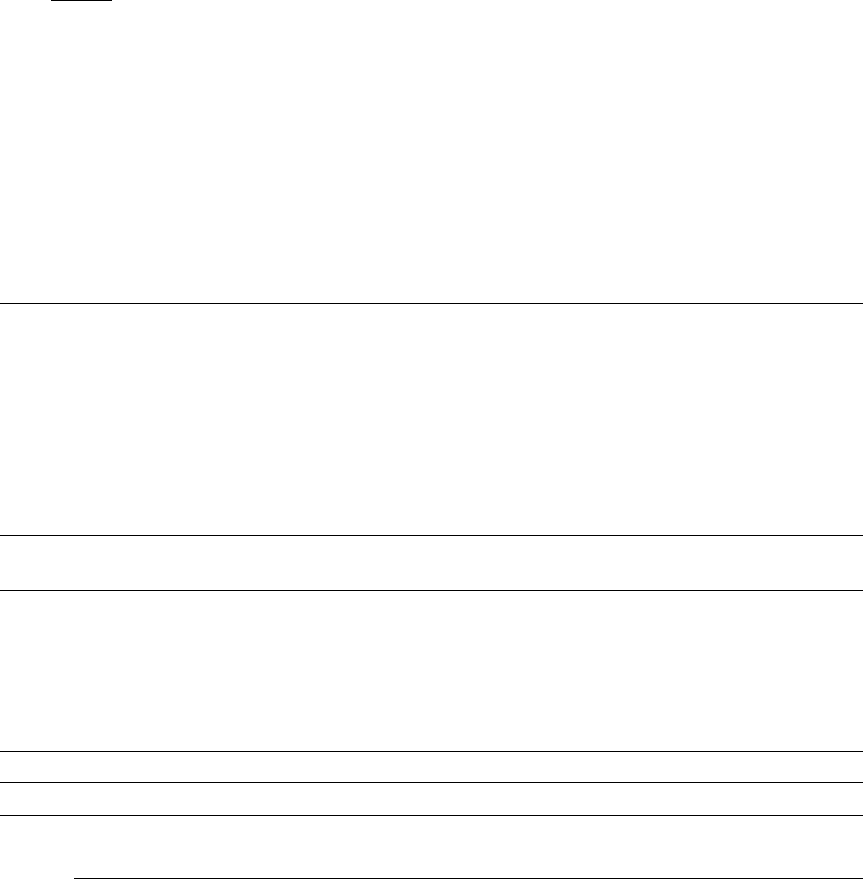
SYSTEM DESCRIPTION, INSTALLATION, AND MAINTENANCE MANUAL
eNfusion® HSD-440 Mark 2 Terminal
23-15-30 1-5
3 JUN 10
• POTS supports:
• In Swift 64 mode, one or two channels of ISDN (speech) or 3.1kHz audio (fax)
• In SBB mode, one channel AMBE+2 voice or 3.1kHz audio (fax)
• CEPT-E1 is offered through the Aero-H+ service and offers 1 or 2 channels of voice
NOTE: Only one service type can be used at one time on aHSD-440 Mark 2 Terminal channel.
Channel card 1 can support two channels of Swift 64 service when in this mode or
one channel of SwiftBroadband service.
3. Equipment Specifications
This section includes the physical and environmental characteristics of HSD-440 Mark 2
Terminals.
Table 1-1 lists the physical characteristics and specifications for HSD-440 Mark 2 Terminals.
Table 1-1 HSD-440 Mark 2 Terminal Characteristics and Specifications
Characteristic Specification
Certification/related documents
ARINC characteristics 600-12, Air Transport Avionics Equipment Interfaces,
December 12, 1998
Attachment 10 of the ARINC 704-7
RTCA documents RTCA/DO-160E, Environmental Conditions and Test
Procedures for Airborne Equipment,
July 29, 1997
HSD-440 Terminal Software RTCA/DO-178B Level D/E (For more information, refer
to "Software Specifications" on page 1-19)
Physical Size
Height 19.41 cm (7.64 in)
Width 26.09 cm (10.27 in)
Length 38.66 cm (15.22 in)
Weight 16.1 kg (35.5 lbs)
Mounting information 8-MCU Tray (per ARINC 600, 8-MCU LRU)
Maintenance requirements No scheduled maintenance is required
Electrical specifications
HSD-440 Mark 2 Terminal AC input power
Voltage Minimum: 92 V rms—min start voltage: 100V rms
Typical: 115 V rms
Maximum: 122 V rms
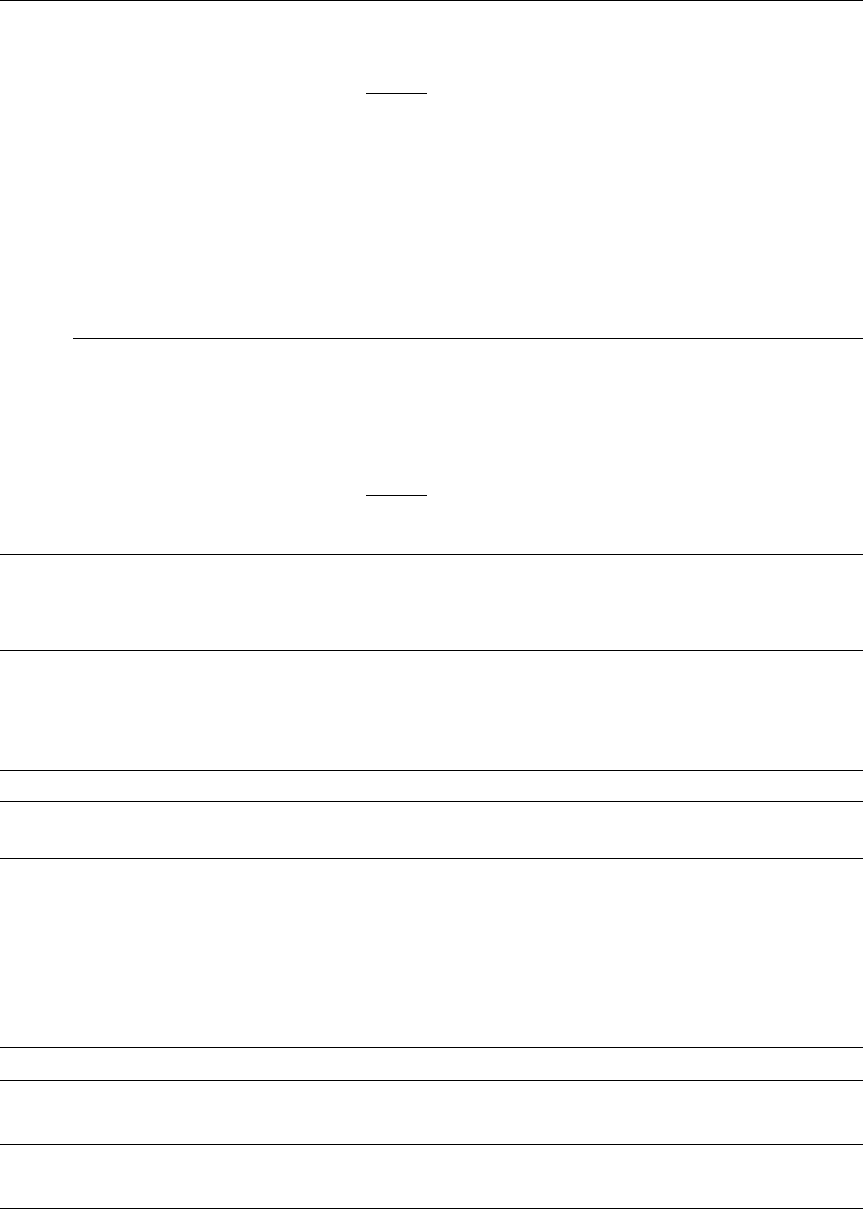
SYSTEM DESCRIPTION, INSTALLATION, AND MAINTENANCE MANUAL
eNfusion® HSD-440 Mark 2 Terminal
23-15-30 1-6
3 JUN 10
Power consumption Maximum: 460 W
NOTE: Of this power consumption, 400 W is dissipated
internally and 60 W of RF power is dissipated
externally.
Frequency Minimum: 360 Hz
Typical: 400 Hz
Maximum: 800 Hz
Power Factor Leading: >0.77
Lagging: >0.62
HSD-440 Mark 2 Terminal DC input power
Voltage Minimum: 22 V dc for startup, 20.5 V dc for operation
Typical: 28 V dc
Maximum: 33.2 V dc
Power consumption Maximum: 460 W
NOTE: Of this power consumption, 400 W is dissipated
internally and 60 W of RF power is dissipated
externally.
Power requirements
AC 115 V ac, 400 Hz nominal, @ 4 A (460 W maximum)
DC + 28 V dc @ 15.5 A (460 W maximum)
Wire gauge DC power: 12 AWG
AC power: 20 AWG (hot lead), 12 AWG (cold lead)
Signals: Unless otherwise specified, use 22 AWG for all
signal wires
Ground requirements ARINC 741
Circuit breakers Install circuit breakers according to the maintenance
requirements of the aircraft.
Heating and cooling requirements
Cooling air As per ARINC 600 Section 3.5.1.6 (220 kg/(kWhr)
Flow rate 88 kg/hr (194 lbs/hr) at air temperature 40ºC
Pressure drop 5 ± 3 mm (0.20 ± 0.12 in.) of H2O
Frequency band Tx: 1626.5 to 1660.5 MHz
Rx: 1525.0 to 1559.0 MHz
Receive input impedance 50 ohms
Transmit output impedance 50 ohms
Transmit VSWR 2:1 maximum
External interfaces
External parameters
Table 1-1 HSD-440 Mark 2 Terminal Characteristics and Specifications (Continued)
Characteristic Specification
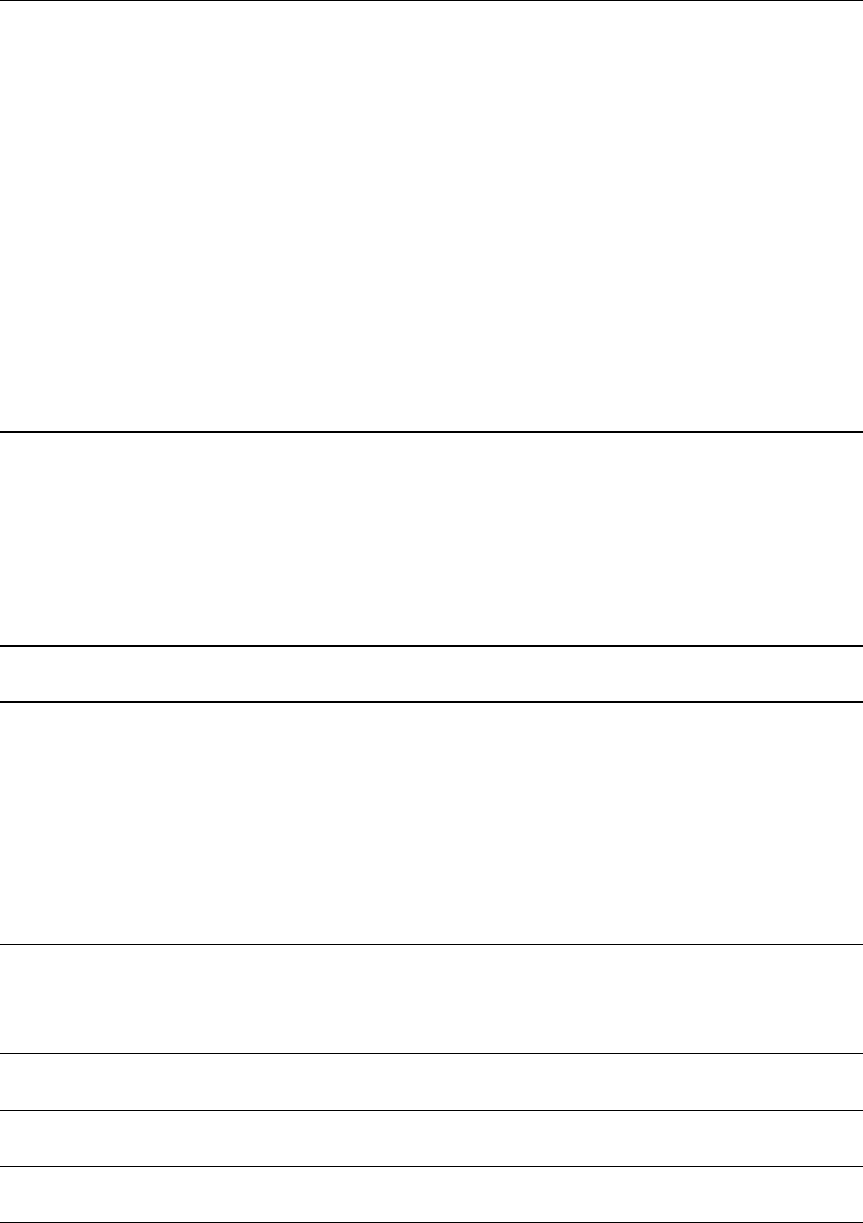
SYSTEM DESCRIPTION, INSTALLATION, AND MAINTENANCE MANUAL
eNfusion® HSD-440 Mark 2 Terminal
23-15-30 1-7
3 JUN 10
Antenna gain (HGA) Minimum: 12 dB
Maximum: 17 dB
Antenna to DLNA loss Maximum: 0.3 dB
DLNA gain Minimum: 53 dB
Maximum: 60 dB
DLNA noise Maximum: 1.8 dB
DLNA to HSD-440 Mark 2
Terminal total loss Minimum: 6 dB
Maximum: 25 dB (Rx)
HSD-440 Mark 2 Terminal to
antenna loss Minimum: 1 dB
Maximum: 2.5 dB (Tx) (including DLNA loss)
DLNA insertion loss Maximum: 0.8 dB
External digital interfaces
Control interface up to three MCDU (speed configurable)
two CMUs
Multi-control bus
Top/Port and Starboard antenna bus
Top/Port and Starboard antenna mute
two IRS buses—second port speed configurable
RS-232 maintenance interface
(rear and front connector) 19 200 kbps (For connection specification, refer to
"Maintenance Port Interface" on page 1-17)
Ethernet user interface (2) 10BASE-T input and output for SCPC (Swift 64 Mobile
ISDN) and MPDS using Point-to-Point Protocol over
Ethernet (PPPoE)
Used for placing PPPoE calls using the MPDS, SCPC,
SBB PS, SBB CS services
Controls BGAN secondary contexts via the side AT
handler
Provides status information to the client system using
SNMP
ISDN () ISDN S/T physical interface supporting up to six external
connections to Terminal Adapter (TA) or Terminal
Equipment (TE) devices
One ISDN interface to high-speed data services
POTS tip/ring interface (2) POTS analog interface provides access to services over
Swift 64 or SBB
CEPT-E1 Provides priority 4 (public) calls to the cabin over the
Aero H+ service
4-Wire interfaces Providing cockpit voice services through the audio
control panel over Aero-H+ services
Table 1-1 HSD-440 Mark 2 Terminal Characteristics and Specifications (Continued)
Characteristic Specification
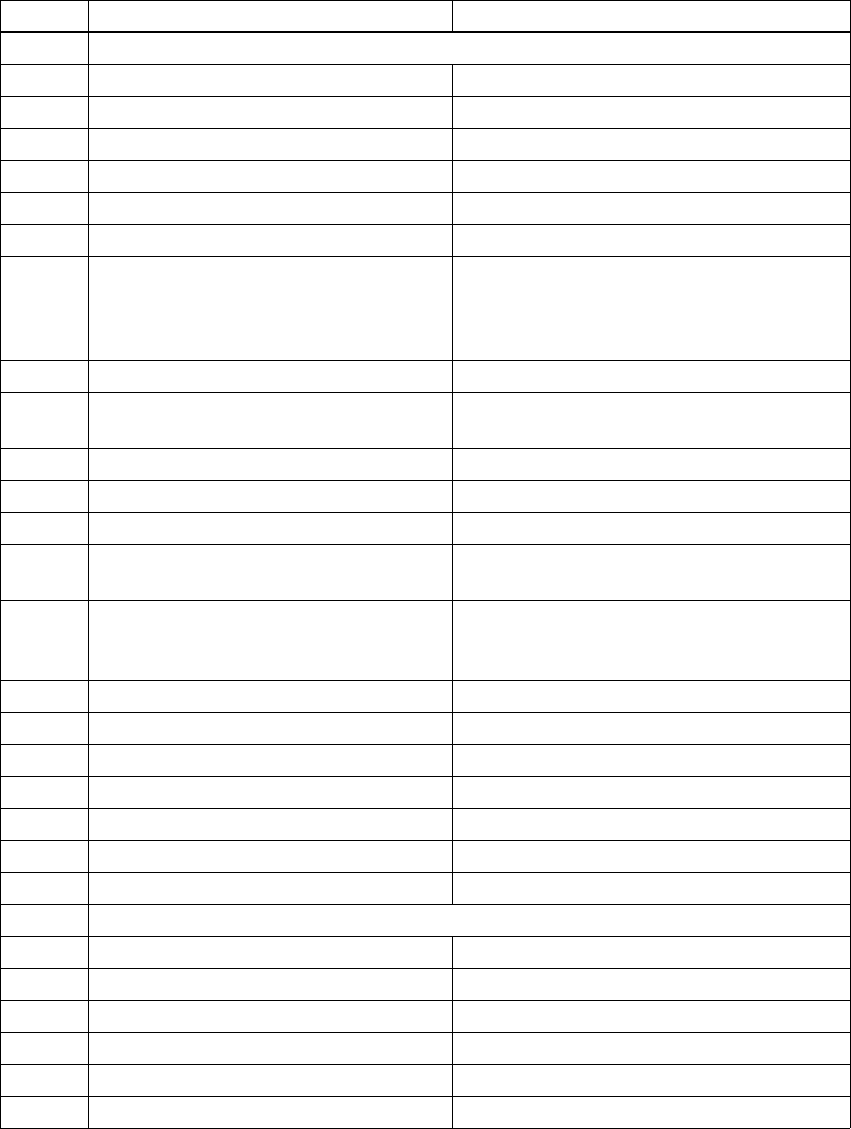
SYSTEM DESCRIPTION, INSTALLATION, AND MAINTENANCE MANUAL
eNfusion® HSD-440 Mark 2 Terminal
23-15-30 1-8
3 JUN 10
Table 1-2 lists the RTCA/DO-160E environmental characteristics for HSD-440 Mark 2
Terminals.
Table 1-2 HSD-440 Mark 2 Terminal RTCA/DO-160E Environmental Characteristics
Section Environmental Condition Category/Comment
4Temperature and Altitude
4.5.1 Ground Survival Low F2
4.5.1 Short Time Operating Low F2
4.5.2 Operating Low Temperature F2
4.5.3 Ground Survival High Temperature F2
4.5.3 Short Term Operating High Temperature F2
4.5.4 Operating High Temperature F2
4.5.5 In Flight Loss of Cooling Z—Operate for 30 minutes @40ºC with 10W
Output RF power and 180 minutes @40C
without damage and without producing
smoke or fire
4.6.1 Altitude Test F2
4.6.2 Decompression Test A2—Modified to include an extra test of 4
hours at 10,000 ft.
4.6.3 Over Pressure Test A2
5Temperature Variation A
6Humidity B
7Operational Shock and Crash Safety B—Modified to include an extra test after the
5th cycle
8Vibration S (CURVE B, C)—equipment exposed to 1
hour curve C (unpowered) prior to testing
with curve B.
9Explosive Atmosphere E—Modified to test at 0 ft and 41000 ft.
10 Waterproofness W
11 Fluids Susceptibility Y
12 Sand and Dust S
13 Fungus Resistance F
14 Salt Spray S
15 Magnetic Effect Z
16 Power Input
16.5 Power Input (ac) A(WF)H
16.5.1.1 Normal Operating Conditions A(WF)H
16.5.1.2 Voltage Modulation A(WF)
16.5.1.3 Frequency Modulation A(WF)
16.5.1.4 Momentary Power Interruptions A(WF)
16.5.1.5 Transient/Voltage Surge—Normal A(WF)

SYSTEM DESCRIPTION, INSTALLATION, AND MAINTENANCE MANUAL
eNfusion® HSD-440 Mark 2 Terminal
23-15-30 1-9
3 JUN 10
16.5.1.6 Normal Frequency Variation, 360 Hz to
800 Hz A(WF)
16.5.1.7 DC Content A(WF)
16.5.1.8 Voltage Distortion A(WF)
16.5.2.1 Abnormal Operating Condition A(WF)
16.5.2.2 Abnormal Frequency and Voltage
Condition A(WF)
16.5.2.3 Transient/Voltage Surge—Abnormal A(WF)
16 Power Input (dc) Z
16.6 Normal Operating Conditions A
16.6.1.1 Emergency Operation A
16.6.1.1 Ripple Voltage A
16.6.1.3 Momentary Power Interruptions A
16.6.1.4 Normal Surge Voltage A
16.6.2.1 Abnormal Operating Conditions A
16.6.2.3 Momentary Undervoltage Operation A (No damage)
16.6.2.4 Abnormal Surge Voltage Z
16.7.1 Current Harmonic Emissions from
Loads (ac) A(WF)H
17 Voltage Spike A—600 V, and repeated at 1000 V
18 Audio Frequency Conducted
Susceptibility
Power Input (115 V ac) K(NF)
Power Input (28 V dc) Z
19 Induced Signal Susceptibility (ac) ZW
Induced Signal Susceptibility (dc) ZC
20 Radio Frequency Susceptibility RR
21 Emission of RF Energy M
22 Lightning Induced Transient
Susceptibility A3J33
23 Lightning Direct Effects X
24 Icing X
25 Electrostatic Discharge (ESD) A —Modified to apply 4kV to all connector
pins connecting to other equipment
26 Fire Flammability C—Modified to include compliance with 14
CFR (FAR) 25.853a and 25.869(a) including
amendment 25-72
Table 1-2 HSD-440 Mark 2 Terminal RTCA/DO-160E Environmental Characteristics
Section Environmental Condition Category/Comment
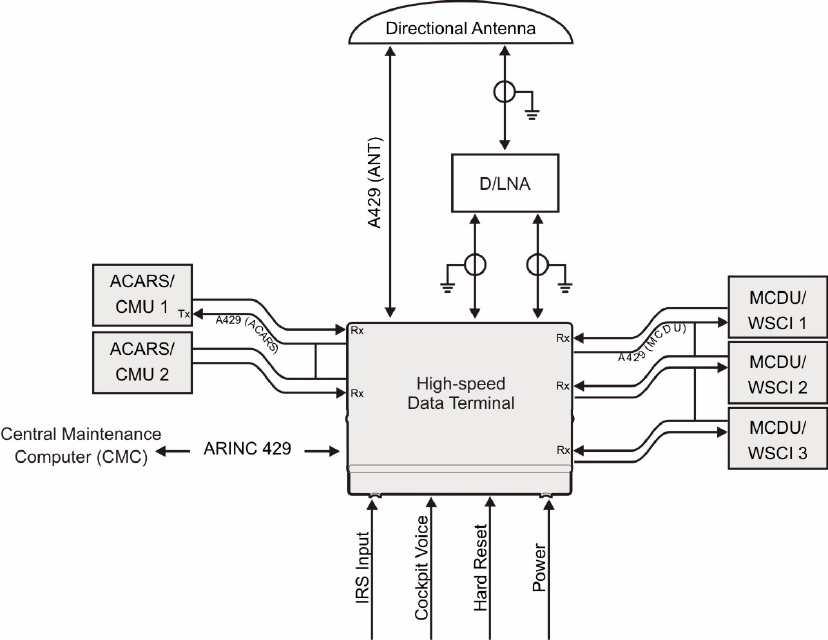
SYSTEM DESCRIPTION, INSTALLATION, AND MAINTENANCE MANUAL
eNfusion® HSD-440 Mark 2 Terminal
23-15-30 1-10
3 JUN 10
4. System Interfaces
This section briefly describes the external HSD-440 Mark 2 Terminal system interfaces required
to control, monitor, maintain, and supplement the terminal. "Installation" on page 3-1 provides
a detailed description of interface connections.
Figure 1-3 shows the system interfaces of the HSD-440 Stand-Alone terminal.
Figure 1-3 HSD-440Stand-Alone Terminal Interfaces
A. Central Maintenance Computer (CMC)
The CMC can include a video display system and keyboard or it can interface with a
separate multi-purpose control display system, such as an MCDU. The HSD-440 Mark
2 Terminal supports CMC interfaces defined in ARINC 741 Part 1 Appendix 1, with minor
customization as required.
The CMC receives BITE data using the standard ARINC 429 maintenance words from
all subsystems attached to it. In turn, the CMC broadcasts data, such as time, date, flight
number, flight phase, and aircraft ID, that the HSD-440 Mark 2 Terminals attached to it
can use to log events.
The CMC enables you to query the equipment attached to it for BITE data and control
the systems attached to it.

SYSTEM DESCRIPTION, INSTALLATION, AND MAINTENANCE MANUAL
eNfusion® HSD-440 Mark 2 Terminal
23-15-30 1-11
3 JUN 10
For more information about using the CMC, refer to the CMC manufacturer’s
documentation.
B. Source Destination Identification (SDI)
The SDI is strapped to indicate the installation type.
C. FWD IDs, ICAO IDs, and IMSI
The HSD-440 Mark 2 Terminal uses two 24-bit IDs called Forward/Return Link Pairs
(FRLPs) for the Swift 64 service: a Forward ID (FWD ID) and a Return ID (RTN ID). The
HSD-440 Mark 2 Terminal reads the FWD ID from the EEPROM and performs a look-up
for the RTN ID. The terminal obtains the second FRLP from the table based on the first
FRLP. For security reasons, each assembly contains an encrypted look-up table with the
whole addressing space assigned to the product by Inmarsat. To minimize the risk of
unauthorized use of its contents, the table is not accessible to the user.
The ISN consists of the type approval number and the FWD ID address. Each FRLP is
associated with Inmarsat Mobile Numbers (IMNs), which are the numbers that a user
dials from the ground to reach a terminal on an aircraft. There is a unique IMN for each
of the service types (for example, data or voice).
The HSD-440 Mark 2 Terminal provides IMEI and IMSI for SBB. The IMEI identifies the
equipment type to the network . The equipment types identity is hard coded in the
equipment. The IMSI identifies the subscriber. This identity is contained within the USIM
housed in the SCM.
The HSD-440 Mark 2 Terminal provides two ways to define the ICAO ID—by strapping
or over the secondary IRS bus. You can select strapping or the IRS bus as the source
of the ICAO ID by the secure ORT parameter ICAO CODE SOURCE.
NOTE: If the ICAO address source is set to the IRS bus, the secondary IRS type ORT
parameter must be set to AES ID.
The 24-bit ICAO ID forms part of the Inmarsat Serial Number (ISN).
The HSD-440 Mark 2 Terminal uses the International Mobile Subscriber Identity (IMSI)
number for access to SBB services. The IMSI is stored in the terminal’s SIM card, and
is printed on the SCM. Register your IMSI with your service provider to begin using SBB
services.
D. Weight-On-Wheel (WOW) Pin Wiring
WOW discretes indicate when an aircraft is on the ground or in the air, and are used for
flight data-logging purposes. Since data that the aircraft is airborne is supplied to the
HSD-440 Mark 2 Terminal by other equipment, this information from the discretes is not
required. However, EMS Aviation recommends wiring the WOW discretes if you plan to
load software while the HSD-440 Mark 2 Terminal is installed in the aircraft.
WOW is only used to determine aircraft on-ground status if the Inertial Reference System
(IRS) has no valid data, and the CMC is not installed, or if the CMC is not providing valid
data.
Note 40 of the ARINC 741 specification documentation defines the requirement for WOW
data.
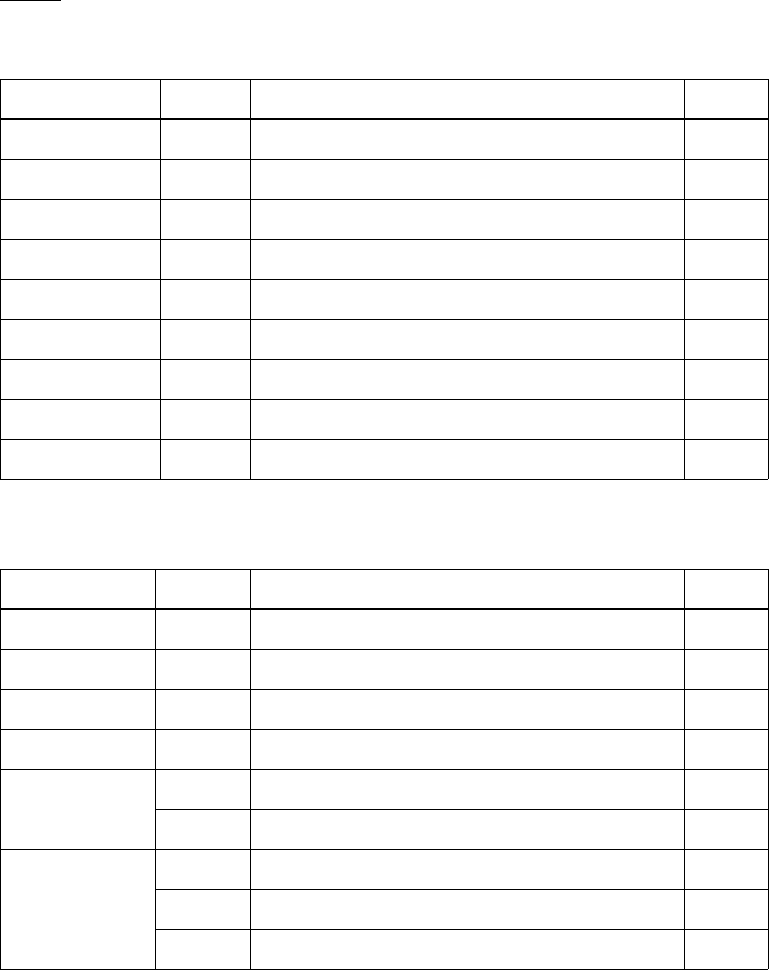
SYSTEM DESCRIPTION, INSTALLATION, AND MAINTENANCE MANUAL
eNfusion® HSD-440 Mark 2 Terminal
23-15-30 1-12
3 JUN 10
E. IRS ARINC 429 Interface
The HSD-440 Mark 2 Terminal supports two IRS inputs and three types of labels:
•Inertial
•GNSS
• Hybrid
Table 1-3, Table 1-4, and Table 1-5 list the labels for both primary and secondary IRS
inputs.
NOTE: The HSD-440 Mark 2 Terminal does not process the equipment ID label.
Table 1-3 Inertial Type Labels
Label Type Priority Name Label
Latitude N/A AIRCRAFT_LATITUDE 310
Longitude N/A AIRCRAFT_LONGITUDE 311
Ground speed N/A AIRCRAFT_GROUND_SPEED 312
True track N/A AIRCRAFT_TRUE_TRAK 313
True heading N/A AIRCRAFT_HEADING 314
Pitch angle N/A AIRCRAFT_PITCH 324
Roll angle N/A AIRCRAFT_ROLL 325
Altitude N/A AIRCRAFT_ALTITUDE 361
Other N/A EQUIPMENT_ID 377
Table 1-4 GNSS Type Labels
Label Type Priority Name Label
Latitude N/A GNSS_LATITUDE 110
Longitude N/A GNSS_LONGITUDE 111
Ground speed N/A GNSS_GROUND_SPEED 112
True track N/A GNSS_TRUE_TRAK 103
Altitude 1GNSS_ALTITUDE_370 370
2GNSS_ALTITUDE_76 76
Other N/A GNSS_SENSOR_STATUS_WORD 273
N/A HDOP_WORD 101
N/A EQUIPMENT_ID 377
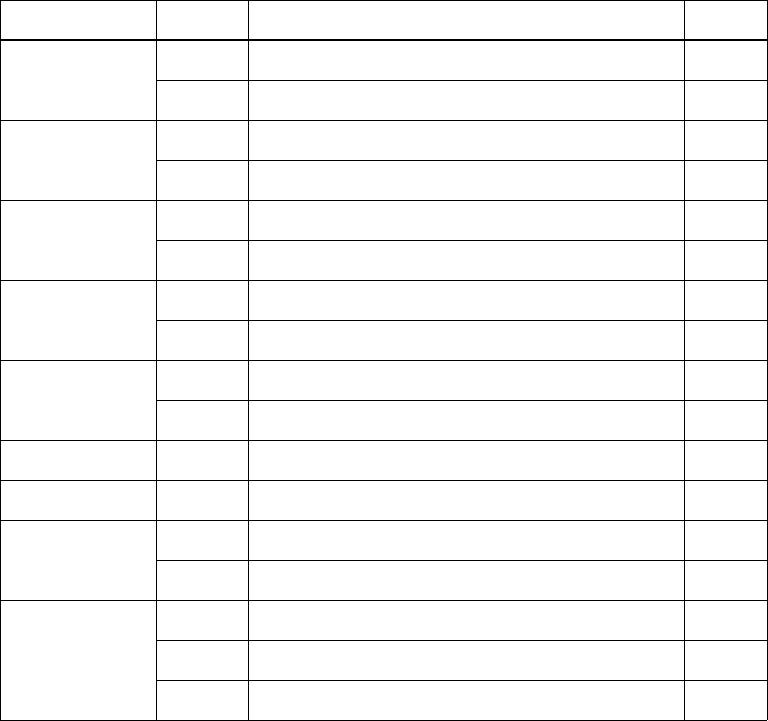
Table 1-5 Hybrid Type Labels
Label Type Priority Name Label
Latitude 1HYBRID_LATITUDE 254
2GNSS_LATITUDE 110
Longitude 1HYBRID_LONGITUDE 255
2GNSS_LONGITUDE 111
Ground speed 1HYBRID_GROUND_SPEED 175
2GNSS_GROUND_SPEED 112
True track 1HYBRID_TRUE_TRAK 137
2GNSS_TRUE_TRAK 103
True heading 1HYBRID_HEADING_132 132
2AIRCRAFT_HEADING 314
Pitch angle N/A AIRCRAFT_PITCH 324
Roll angle N/A AIRCRAFT_ROLL 325
Altitude 1HYBRID_ALTITUDE_261 261
2GNSS_ALTITUDE_76 76
Other N/A HDOP_WORD 101
N/A GNSS_SENSOR_STATUS_WORD 273
N/A EQUIPMENT_ID 377
SYSTEM DESCRIPTION, INSTALLATION, AND MAINTENANCE MANUAL
eNfusion® HSD-440 Mark 2 Terminal
23-15-30 1-13
3 JUN 10
The HSD-440 Mark 2 Terminal uses the navigation data according to the following priority
rules:
• For all labels other than Altitude, hybrid labels have the highest priority, followed by
GNSS and inertial labels.
• For Altitude labels, the highest priority label is 370, followed by 261, 75, and 361.
• If both buses have the same label and label type, the HSD-440 Mark 2 Terminal
control processor uses the 429 bus source of one of the labels as long as the label
is present and valid.
The secondary IRS port set to AES ID mode provides the ICAO ID. Table 1-6 lists the
AES ID type labels.

Table 1-6 AES ID Type Labels
Name Label
ICAO Part 1 275
ICAO Part 2 276
SYSTEM DESCRIPTION, INSTALLATION, AND MAINTENANCE MANUAL
eNfusion® HSD-440 Mark 2 Terminal
23-15-30 1-14
3 JUN 10
F. Antenna Interface
The HSD-440 Mark 2 terminal interfaces to any mechanically-steered, conformal-array,
or phased-array antenna subsystems that are compatible with ARINC 741 and 781. The
antenna-pointing commands and status messages are communicated between the
HSD-440 Mark 2 Terminal and antenna subsystem over ARINC 429, multi-control,
top/port and/or starboard BITE and HPA mute buses, as defined in ARINC 741, Part 1.
HSD-440 Mark 2 Terminals support high gain antennas.
HSD-440 Mark 2 Terminals do not support the third MCDU when a side-mount antenna
is installed.
G. CMU
Each HSD-440 Mark 2 Terminal can be connected to up to two ARINC 724B/758 CMUs.
A CMU is a general purpose instrument used to create and direct low data rate messages
to different ground-based systems, including airline headquarters and operations. The
CMU also provides access to Aero H/H+ PRT channels.
The CMUs operate in two modes: it can select from a number of Satellite Service
Providers rather than Inmarsat only, or it can operate with no preferred Satellite Service
Provider.
The HSD-440 Mark 2 Terminal exchanges information with the CMU over ARINC 429
interfaces. The default speed is low, but you can set the speed of the buses to high
through the ORT.
H. Antenna Subsystem RF Interface
The system RF parameters, such as cable losses and antenna gain, are delimited to
make sure that the HSD-440 Mark 2 Terminal performance requirements are met. Refer
to "Installation" on page 3-1 for a definition of these parameters and their expected values.
5. User Interfaces
This section describes the HSD-440 interfaces that enable users to access Inmarsat services
and monitor the operation of the HSD-440 Mark 2 Terminal.
A. MCDU
The MCDU is a device that uses an ARINC 429 interface per ARINC 739, which lets you
communicate with individual instruments on an aircraft, including the Flight Management
System (FMS), very high frequency (VHF) radio, and the HSD-440 Mark 2 Terminal. You
can make air-to-air and air-to-ground voice calls with the MCDU. You can also use the
MCDU to answer ground-to-air and air-to-air voice calls.
SYSTEM DESCRIPTION, INSTALLATION, AND MAINTENANCE MANUAL
eNfusion® HSD-440 Mark 2 Terminal
23-15-30 1-15
3 JUN 10
The HSD-440 Mark 2 Terminal supports three MCDUs.
B. WSC
The WSC is a device that uses an ARINC 429 interface per ARINC 741 Part 2 Attachment
2F-42.1, which provides display functions similar to the MCDU. For more information
about the WSC, see the WSC manufacturer’s documentation and ARINC 741 Part 2
Attachment 2F-42.1.
C. Remote Reset
The remote reset output provides an external reset function for the complete HSD-440
Mark 2 Terminal. Pressing the momentary normally open (NO) switch resets the system's
processor-card circuitry.
The remote reset has the same function as pressing the test button on the front panel of
the terminal.
D. ISDN Circuit-Switched Data Interface
HSD-440 Mark 2 Terminals connect to a variety of interface options. The physical
interface for ISDN BRI service is EURO S/T, which supports several types of connections
to user equipment.
HSD-440 Mark 2 Terminals provide one ISDN S/T bus interface which is capable of
hosting up to six external physical connections to EURO ISDN devices.
The ISDN BRI S/T bus accesses only the Swift 64/SBB channel card. In SBB mode, the
interface provides one SBB circuit-switched connection. In Swift 64 mode, the interface
provides two Swift 64 circuit-switched connections. If the channel is busy or in-call, the
request for service is denied.
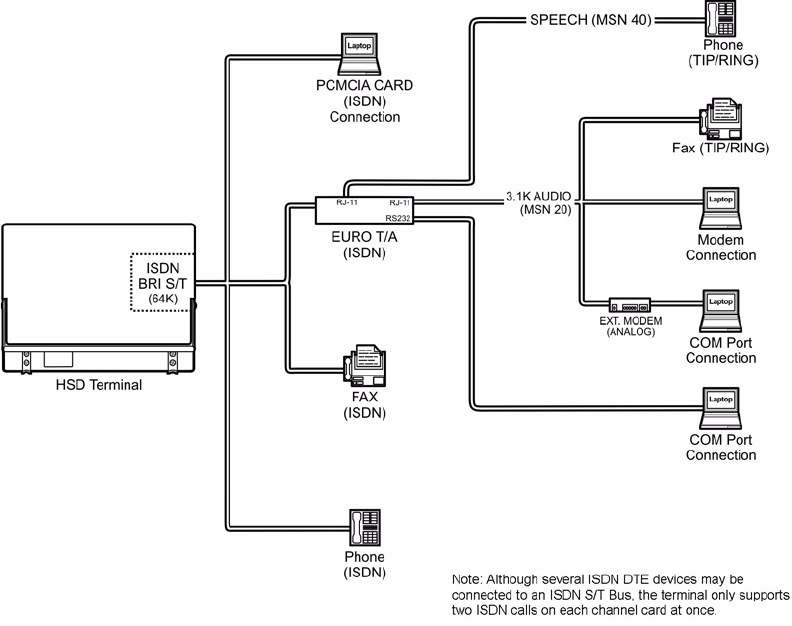
SYSTEM DESCRIPTION, INSTALLATION, AND MAINTENANCE MANUAL
eNfusion® HSD-440 Mark 2 Terminal
23-15-30 1-16
3 JUN 10
Figure 1-4 HSD-440 Mark 2 Terminal ISDN Connections
You can install RJ45 interface connectors in the cabin area to facilitate connection to the
ISDN interface. Refer to "Installation" on page 3-1 for a description of the RJ45 connector
and cable termination.
E. Ethernet Data Interfaces
HSD-440 Mark 2 Terminals provide two Ethernet data interfaces. Each Ethernet port
provides a 10 Mbps access with a 10BASE-T physical interface. The HSD-440 Mark 2
Terminal data I/O controller takes the PPP data stream and directs it to the required port
on the channel card, depending on the type of service selected by the user. PPPoE is
required on the user equipment to allow the establishment of virtual connections to either
service. You can use the Ethernet ports for either Mobile ISDN or MPDS service when
operating in Swift 64 mode, or PS (background or streaming) or CS (Mobile ISDN) when
operating in SBB mode
The Ethernet interface also provides access to equipment monitoring functions through
SNMP, and to the side AT handler for control of secondary contexts in SBB
F. POTS Tip/Ring Interfaces
The HSD-440 Mark 2 Terminal includes two POTS analog interfaces that connect to the
Swift 64/SBB channel card. The default setting for POTS port 1 is 64 kbps Speech, and
the default setting for POTS port 2 is 3.1 kbps Audio, which is appropriate for fax calls.
SYSTEM DESCRIPTION, INSTALLATION, AND MAINTENANCE MANUAL
eNfusion® HSD-440 Mark 2 Terminal
23-15-30 1-17
3 JUN 10
G. CEPT-E1 Interface
The CEPT-E1 interface provides access to a maximum of two calls through Aero H+
voice services.
The CEPT-E1 interface connects to standard ITU or ARINC 746-compliant equipment.
Users can select the equipment through an ORT parameter.
H. Maintenance Port Interface
The HSD-440 Mark 2 Terminal is equipped with a maintenance port, located on the front
panel of the HSD-440 Mark 2 Terminal, with remote access also available through the
rear ARINC 600 connector. If the ports on both the front and back panels are connected,
the front-panel connection has priority and the back-panel connection does not function.
The maintenance port provides the physical connection to a password-protected MPU
that provides a system interface for users or service personnel who need to upgrade,
monitor, or troubleshoot the system.
The user connects to the maintenance port either through the maintenance 25-pin socket
D-Sub (DB25) connector on the front panel of the HSD-440 Mark 2 Terminal or through
a remote 9-pin socket D-Sub (DE9) connector via the ARINC 600 connector, as described
in "Connection Requirements" on page 4-37.
A standard VT100 compatible terminal or computer (PC/laptop) running an emulator
program such as HyperTerminal©, ProComm (PCPLUS)©, or another serial
communication package provides the user interface to the HSD-440 Mark 2 Terminal
MPU. Configure the connection as follows:
• Bits per second—19200
• Data bits—8
• Parity—none
• Stop bits—1
• Flow control—none
The HSD-440 Mark 2 Terminal supports two different end user access levels within the
maintenance port architecture: End User and Field Representative.
(1) End User Access: Level 1
Password: menu
This limited-access level is for anyone without technical training on the product. It
provides read-only access to help users diagnose problems with the assistance of
product support personnel.
(2) Field Representative Access: Level 2
Password: maint
This level is for trained installers and product support personnel. This access level
supports read and limited write capabilities. Users are able to disable/mask/clear
faults, change satellite or LES/GES preferences, view and modify certain EEPROM
parameters, and perform other maintenance or upgrade functions.

SYSTEM DESCRIPTION, INSTALLATION, AND MAINTENANCE MANUAL
eNfusion® HSD-440 Mark 2 Terminal
23-15-30 1-18
3 JUN 10
"Test and Fault Isolation" on page 4-35 provides a detailed description of the two
levels of user access and the menus, report selections, functions, and system
diagnostic procedures of the HSD-440 Mark 2 Terminal MPU.
I. Fault Indicator LED
Table 1-7 provides a description of the fault indicator LED functions.
Table 1-7 HSD-440 Mark 2 Terminal LED Output Designations
LED
SignalLabel Color Indication Description
LED1 Power On Green Normal operation: on.
HPA output is greater than 30dBm: flashes at 1 Hz.
Power on: HSD-440 Mark 2 Terminal supply voltage is
active. Self-test: flashes at 1 Hz alternately with the Fault
LED.
LED2 Fault Red Fault: Fault condition as described in "Fault Indicator LED"
on page 1-18.
Self-test: flashes once per second alternately with the Power
On LED.
A failure in the HSD-440 Mark 2 Terminal may be due to a number of fault conditions.
When fault condition is detected, the HSD-440 Mark 2 Terminal activates a red, Fault
LED. Some of the potential fault conditions are:
•CP RAM
• CP Application code CRC
• CC power up
•CP D-UART
• CP ARINC Chipset
• PSU Power rail
• Previous Power Up CP RAM
• PSU Over temperature
• OCXO Warmup
• PA Over Current
• PA Voltage Driver
• PA Over temperature shutdown
• PA 12VDC STATUS DISCRETE
• SDU Configuration Module
• CP Boot Code CRC
• DIO Boot

SYSTEM DESCRIPTION, INSTALLATION, AND MAINTENANCE MANUAL
eNfusion® HSD-440 Mark 2 Terminal
23-15-30 1-19
3 JUN 10
• VP RAM
• VP Application Code CRC
• VP Kernel
• VP 4-Wire or POTS COM
• VP 4-Wire #1
• VP 4-wire #2
J. Self-Test
The self-test button activates the HSD-440 Mark 2 Terminal self-test.
The self-test button resets the HSD-440 Mark 2 Terminal. The HSD-440 Mark 2 Terminal
performs a POST when the self-test button is pressed for over ten seconds.
K. Remote Status Panel (Optional)
In HSD-440 Stand-Alone terminals, the outputs to the optional remote status panel
provide a visual indication of the operational status of the HSD-440 Mark 2 Terminal—
they mirror the front panel LEDs labeled as Power (LED1) and Fault (LED2). Refer to
"Installation" on page 3-1 for detailed installation and circuit requirements.
6. Software Description
This section describes the software specifications and operational software components of
HSD-440 Mark 2 Terminals.
A. Software Specifications
HSD-440 Mark 2 Terminal software meets the following DO-178B standards:
• SBB to Level E
• Swift 64 to Level
• Classic Aero voice and data to Level D
B. Operational Software Part Numbers
Table 1-8 provides a list of software part numbers for HSD-440 Mark 2 Terminals.
Table 1-8 HSD-440 Mark 2 Terminal Operational Software
HSD-440 Mark 2
Terminal Part Number EMS Aviation Part
Number Description
1252-A-3800-01 LI-1252-38015 HSD-440 Mark 2 Terminal firmware
assembly
SYSTEM DESCRIPTION, INSTALLATION, AND MAINTENANCE MANUAL
eNfusion® HSD-440 Mark 2 Terminal
23-15-30 1-20
3 JUN 10
C. Owner Requirements Table (ORT)
The HSD-440 Mark 2 Terminal includes an ORT that stores information relevant to the
operation of the terminal. The ORT is divided into two parts: secure and user. The secured
partition contains those items that are installation-dependent and crucial to the proper
operation of the satellite communication system. End users cannot modify these
parameters.
The user partition includes items that aircraft operators can modify, such as 4-wire
headset speaker volume.
You can use the EMS ORT Application to change ORT parameters and to create ORT
files on your computer. You can then load the ORT file to the HSD-440 Mark 2 Terminal
through TFTP on an Ethernet connection. You can load the same ORT file to various
HSD-440 Mark 2 Terminals in your fleet. Section "2. Configuring ORT Parameters Using
the EMS ORT Application" on page 6-32 provides more information about the EMS ORT
Application.
SYSTEM DESCRIPTION, INSTALLATION, AND MAINTENANCE MANUAL
eNfusion® HSD-440 Mark 2 Terminal
23-15-30 2-1
3 JUN 10
SYSTEM OPERATION
This section provides basic information on registering and operating HSD-440 Mark 2 Terminals,
including the following sections:
• Registering and Activating Terminals
• Configuring Terminals
• Using Terminals
1. Registering and Activating Terminals
Registering and activating HSD-440 Mark 2 Terminals has the following steps:
• Preparing Terminal Information
• Obtaining ICAO Addresses
• Choosing Service Providers
• Registering Terminals
A. Preparing Terminal Information
Before installing the HSD-440 Mark 2 Terminal, obtain an ISN and identify the Swift 64
terminal type and service category.
(1) Obtaining ISNs
Honeywell provides ISNs for the HSD-440 Mark 2 Terminal based on the intended
installation configuration. The last six digits of the ISN form the Forward ID.
When requesting ISNs, have the following information available:
• End customer name, including contact information
• The part number of the HSD-440 Mark 2 Terminal
• Tail registration number, aircraft type, and serial number of the aircraft on which
the terminal is being installed
• Serial number of the HSD-440 Mark 2 Terminals
• Intended installation configuration mode
(2) Identifying the Swift 64 Service Category and Terminal Type
Inmarsat divides the band of frequencies assigned to Swift 64 high-speed data into
two separate categories: Category A and Category B. Category B frequencies are
restricted to those that do not overlap with Aero H/H+ frequency allocations. HSD-440
Mark 2 Terminals do not require restricted frequency allocations. Register HSD-440
Mark 2 Terminals as Category A systems.
SYSTEM DESCRIPTION, INSTALLATION, AND MAINTENANCE MANUAL
eNfusion® HSD-440 Mark 2 Terminal
23-15-30 2-2
3 JUN 10
The Swift 64 terminal type for all modes of HSD-440 Mark 2 Terminals is 76HW07.
Currently, supported service types for HSD-440 Mark 2 Terminals operating Swift 64
are:
• 64 kbps speech
• 3.1 kHz audio
• 56 kbps data
• 64 kbps UDI
• AMBE voice
•MPDS
B. Obtaining ICAO Addresses
Obtain your ICAO address from your local aeronautical authority. Your service provider
will require this address when you register.
C. Choosing Service Providers
Contact Inmarsat for an up-to-date list of Inmarsat Service Providers using the following
contact information:
Inmarsat
99 City Road, London
EC1Y 1AX
Tel: +44 20 7728 1000
Fax: +44 20 728 1044
Customer Care
Tel: +44 20 7728 1777
Fax: +44 20 7728 1142
Email: customer_care@inmarsat.com
Web address: www.inmarsat.com
D. Registering Terminals
Contact your Inmarsat service provider and ask for a registration for service activation of
Aircraft Earth Station form. With this form, you can register for Swift 64, SBB, and Aero H+
services. The services available depend on your service provider.
To complete the registration form you need the following information:
• Customer information (address and contact information)
• Service provider details (obtained from your ISP)
• System and terminal information (terminal type, manufacturer, model number, serial
number of terminal)
• ICAO 24 bit technical address for Aero H+ services
• ISN for Swift 64 services
• IMEI and IMSI (printed on the SCM label) for SBB services

SYSTEM DESCRIPTION, INSTALLATION, AND MAINTENANCE MANUAL
eNfusion® HSD-440 Mark 2 Terminal
23-15-30 2-3
3 JUN 10
• Aircraft information (tail number, fuselage/airframe number, manufacturer and model,
and country of registration)
• List of services required (for example, Swift 64 Mobile ISDN, Aero H+ data-2, SBB
PS and SBB CS services)
NOTE: When requesting a logon class, you must request Class 3, even if your installation
does not support data services. The channel card software does not support
Class 2.
2. Configuring Terminals
This section provides basic information on how to configure HSD-440 Mark 2 Terminals for
operation with user devices.
A. Setting up Airborne Networks
For information about setting up airborne networks that use Swift 64 and SBB services,
refer to the HSD Terminal Developer’s Guide, MN-1252-13005.
B. Mapping User Devices for ISDN Services
HSD-440 Mark 2 Terminals support connection to a multitude of user devices, allowing
the user to customize their system. The HSD Terminal Developer’s Guide,
MN-1252-13005, provides more information about ISDN devices and services.
C. IMNs
IMNs are unique routing numbers that act similarly to telephone numbers. IMNs are
assigned by Inmarsat to each service type (64 kbps Speech, 3.1 kHz Audio, 56 kbps
data, and 64 kbps data).
When registering your system, request IMNs for each service-type device attached to
the HSD-440 Mark 2 Terminal on the Service Activation form. Although the service
provider may support an unlimited number of IMNs assigned to a particular system, the
number of physical connections available on a system defines the number of IMNs
supported.
NOTE: To get assigned extra or multiple IMNs per service type, you must request them
from your service provider when filling out your service registration and
application form.
The HSD Terminal Developer’s Guide, MN-1252-13005, provides more information
about IMNs.
D. MSNs
MSNs act as identification and routing codes for user devices attached to the HSD-440
Mark 2 Terminal ISDN bus. MSNs identify the device on the system so that incoming
calls route to the appropriate device. Each device must be assigned an appropriate MSN
to identify to the Inmarsat system what type of service that device needs on outgoing
calls. The MSNs also provide routing information for incoming calls.
The HSD Terminal Developer’s Guide, MN-1252-13005, provides more information
about MSNs.

SYSTEM DESCRIPTION, INSTALLATION, AND MAINTENANCE MANUAL
eNfusion® HSD-440 Mark 2 Terminal
23-15-30 2-4
3 JUN 10
E. Configuring User ORT Parameters with the Maintenance Port Utility (MPU)
You can use the MPU to configure user-level parameters in the ORT. This feature will be
available in a future release.
F. Configuring Secure ORT Parameters with the Maintenance Port Utility (MPU)
You can use the MPU to configure secure-level parameters in the ORT.
The Forward ID is a secure ORT parameter that you must configure in order to use
Swift 64 services. Refer to section "K: Configuring Satellite Service ORT Parameters" on
page 6-15.
G. Creating ORTs with the Maintenance Port Utility (MPU)
can use the MPU to configure the ORT. Refer to "Configuring the Owners Requirements
Table (ORT)" on page 6-1 for instructions.
H. Understanding CMU Messages
The CMU communicates with the HSD-440 Mark 2 Terminal using two types of ARINC
429 messages: Broadcast messages and Bit Oriented Protocol (BOP) messages. Both
types of communication are supported at the same time.
Appendix F: “CMU Messages” on page F-1 includes descriptions of the messages that
the CMU will transmit to the HSD-440 Mark 2 Terminal and receive from the HSD-440
Mark 2 Terminal.
I. Configuring Swift 64 LES Access Codes
This section describes how to configure the HSD-440 Mark 2 Terminal with the LES
Access Codes provided by your Inmarsat service provider to support Swift 64 service.
Configure LES access codes only if you plan to use Swift 64 services. This configuration
is not required for SBB or classic services.
NOTE: You can remove the label that covers the LES Access Codes LEDs once you
have configured the LES Access Codes.
(1) General Overview
ISPs operate LESs. The ISPs are typically public telephone companies of the country
where the LES is located.
Using satellite communications antennas and up-and-downlink communications
equipment, the LES converts the space segment to a format compatible with public
and private telephone and data networks. Each satellite is associated with a number
of LESs that fall within its coverage.
Inmarsat assigns each LES an access code. These access codes are used by the
Inmarsat system to route calls to the correct OR satellite and LES.
NOTE: HSD-440 Mark 2 Terminals are shipped with the factory default LES Access
Codes set to 0 (zero). All HSD-440 Mark 2 Terminals must be configured
with the valid LES Access Codes provided by your ISP.
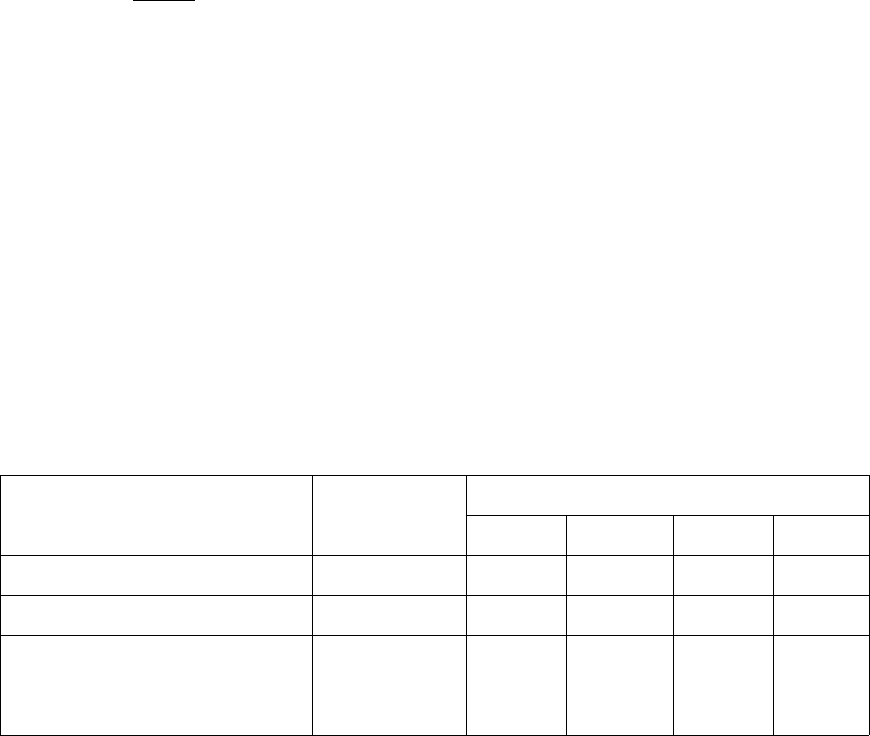
SYSTEM DESCRIPTION, INSTALLATION, AND MAINTENANCE MANUAL
eNfusion® HSD-440 Mark 2 Terminal
23-15-30 2-5
3 JUN 10
(2) Changing Default LESs Using the MPU
The LES Access Codes can be configured using the HSD-440 Mark 2 Terminal MPU.
You can access the MPU by connecting a computer running a VT100 terminal
emulation program to the RS-232 maintenance port on the HSD-440 Mark 2
Terminals. Refer to "Test and Fault Isolation" on page 4-35 for connection settings
and cabling information).
NOTE: When configuring the LES Access Codes using the HSD-440 Mark 2
Terminal MPU, the application requests the input of a Secondary LES
Access Code. At the time of writing, Inmarsat has not implemented the
recognition of the secondary LES value in their systems. However, a valid
Secondary LES Access Code must be entered in the HSD-440 Mark 2
Terminal. The Secondary LES Access Code must be the same as the
Primary LES Access Code.
Inmarsat usually provides LES Access Codes for the ISPs providing Swift 64
services. Contact Inmarsat directly for an up to date list of LES and Swift 64 service
providers.
For more information, visit Inmarsat's Web site at www.inmarsat.com or contact their
Customer Care Service at:
Telephone: +44 20 7728 1777
Fax: +44 20 7728 1142
E-mail: customer_care@inmarsat.com
Table 2-1 Inmarsat Swift 64 LES Operator and Access Codes
Land Earth Station Operator Country OR
AOR-E AOR-W IOR POR
Telenor Satellite Services Inc. USA 001 001 001 001
Stratos UK/Canada 002 002 002 002
Stratos (Auckland LES)
Xantic (Burum LES)
Xantic (Perth LES)
New Zealand
Netherlands
Australia
012 012 012 012
(a) Equipment Required
You need the following to change the default LES Access Code in an HSD-440
Mark 2 Terminal:
• Computer
• Terminal emulation program (e.g., HyperTerminal)

SYSTEM DESCRIPTION, INSTALLATION, AND MAINTENANCE MANUAL
eNfusion® HSD-440 Mark 2 Terminal
23-15-30 2-6
3 JUN 10
(b) Connecting to the Maintenance Port
To connect to the maintenance port:
• Connect a computer running a terminal emulation program to the HSD-440
Mark 2 Terminal maintenance port, and then power up the system. (Refer
to "Test and Fault Isolation" on page 4-35 for detailed connection
information.)
(c) Changing LES Access Codes Using the Control Processor Software
To change all of the LES Access Codes simultaneously to the same LES Access
Code:
1. Connect to the HSD-440 Mark 2 Terminal maintenance port.
2. Type the password maint.
3. To navigate to Menu 3, press CTRL + N.
4. In Menu 3, press i.
5. Follow the application prompts, and enter the LES Access Code.
The Menu 3, option i configures the Primary and Secondary LES Access Codes
for all of the ORs to the same LES Access Code.
NOTE: In cases where the Service Provider requires different LES Access
Codes for different ORs, each LES Access Code must be programmed
individually using Menu 3, item P.
(d) Changing LES Access Codes on a Call-by-Call Basis
To change the LES Access Code on a call-by-call basis:
• Dial the 901 prefix before your dial sequence:
901 + LES CODE + International Code + Country Code + Area Code +
Telephone Number + POUND KEY
Example: 901 + 012 + 00 + 1+ 613+5551212 + #
NOTE: The call connects only if the service is authorized by the LES. To
obtain LES codes, call your Swift 64 service provider.
J. Removing the LED Label
A label covers the LES Access Codes LEDs. You can remove this label once you have
configured the LES Access Codes.
K. Activating Configurations
After you configure the HSD-440 Mark 2 Terminal parameters, you must rest the
HSD-440 Mark 2 Terminal using one of the following methods:
• In Menu 2, press z
• Cycle the power to the HSD-440 Mark 2 Terminal
When the reset or restart is completed, the configuration values and parameters are
activated.
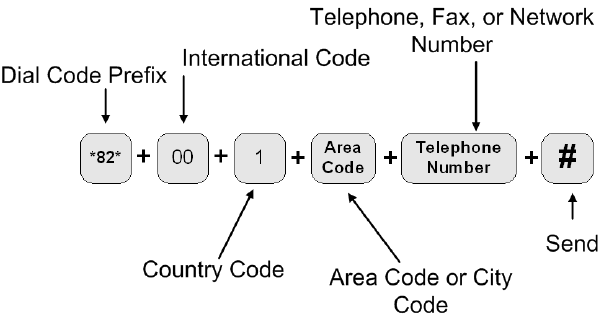
SYSTEM DESCRIPTION, INSTALLATION, AND MAINTENANCE MANUAL
eNfusion® HSD-440 Mark 2 Terminal
23-15-30 2-7
3 JUN 10
L. Verifying Configurations
This section describes how to view the HSD-440 Mark 2 Terminal configuration
parameters.
To view the HSD-440 Mark 2 Terminal ORT system configuration:
1. In Menu 3, press o.
The List ORT appears.
2. To scroll through the listing until you see a table of ORT ORs, press o.
The LES Access Codes are listed in this table.
3. Using Terminals
This section describes how to perform the following tasks:
• Placing Swift 64 Voice, SwiftBroadband, and Fax Calls
• Placing Calls with the CEPT-E1 Interface
• Using Data Connections
• Operating the MCDU
• Operating the WSC
• Performing Cockpit Communications with the MCDU
A. Placing Swift 64 Voice, SwiftBroadband, and Fax Calls
Placing voice and fax calls using the HSD-440 Mark 2 Terminal is similar to placing an
international telephone call or entering a telephone number for dial-up networking data
calls. Like international telephone numbers, the HSD-440 Mark 2 Terminal
dialing-number-sequence includes different routing components or codes. Figure 2-1
illustrates the required order of the dialing components.
Figure 2-1 Dialing-Sequence Components
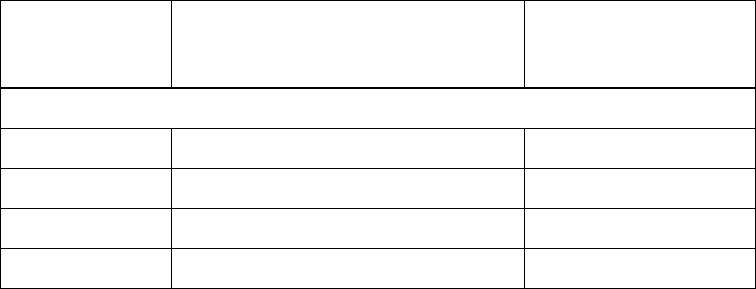
SYSTEM DESCRIPTION, INSTALLATION, AND MAINTENANCE MANUAL
eNfusion® HSD-440 Mark 2 Terminal
23-15-30 2-8
3 JUN 10
Each dialing sequence component serves a different routing function:
• Dial Code Prefix:
Use service-specific dial code prefixes when sending a fax or using analog modems,
or for overriding system defaults to force the system to request a specific service
type. Figure 2-1 uses the dial code prefix for 3.1 KHz audio service type (*82*). See
Table 2-2 for other dial code prefixes.
• International Access Code:
The international access code for all airborne equipment is 00.
• Country Code:
Use the Public Switch Telephone Network (PSTN) number assigned to the country
of your call destination.
• Area Code (and City Code, if applicable):
Use the PSTN routing number assigned to the area (and if applicable, city) of your
call destination.
• POUND SIGN (#):
To signal the system to send the call, at the end of the telephone dial string, press
or enter POUND SIGN (#). Certain devices using the HSD-440 Mark 2 Terminal may
not have the function to insert the POUND SIGN (#) at the end of the dialing
sequence. For those devices, additional dial code prefixes are required to override
the send command requirement. Refer to Table 2-3 for more information.
(1) Dial Code Prefixes
Although the system automatically selects the appropriate service types on outgoing
calls for ISDN devices, a dial code prefix is required to send a fax, identify an analogue
modem, or force the system to override the system defaults to select a specific service
type (see Table 2-2).
Table 2-2 Dial Code Prefixes for Forcing Service Type Selection
Service Type Service Description Dial Code Prefix
(Forces service
selection)
Swift 64 Prefixes
Speech 64 kbps High-speed voice *81* or none
3.1 kHz audio Fax, analogue modem, STU-III, STE *82*
56 kbps data High-speed data *85*
64 kbps data High-speed data *84*
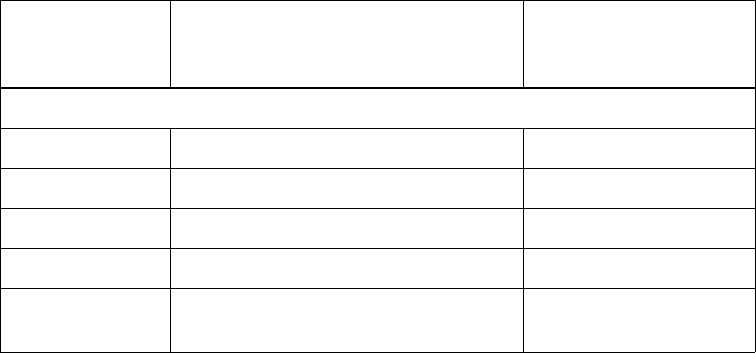
SYSTEM DESCRIPTION, INSTALLATION, AND MAINTENANCE MANUAL
eNfusion® HSD-440 Mark 2 Terminal
23-15-30 2-9
3 JUN 10
The system requires the dial code prefix *82* for sending faxes or when using
analogue modems. It forces the system to request the required 3.1 kHz audio service
from the Inmarsat Satellite Communications Network. If required, use the dial code
prefixes to override the system defaults for selecting specific service types. Dial code
prefixes for all service types require an asterisk (*) before and after the code number.
Other dial code prefixes provide system overrides required if you are using devices
that cannot add a POUND SIGN (#) to the dialing string or devices that are slow
dialing. Table 2-2 provides a description of the additional dial code prefixes used for
system overrides. Table 2-1 provides a list of the LESs and their associated codes.
SBB Prefixes
Speech 64 kbps N/A
3.1 kHz audio Fax, analogue modem, STU-III, STE *82* or none
56 kbps data High-speed data *83*
64 kbps data High-speed data *84*
Speech
(AMBE+2) *80* or none
Table 2-2 Dial Code Prefixes for Forcing Service Type Selection (Continued)
Service Type Service Description Dial Code Prefix
(Forces service
selection)
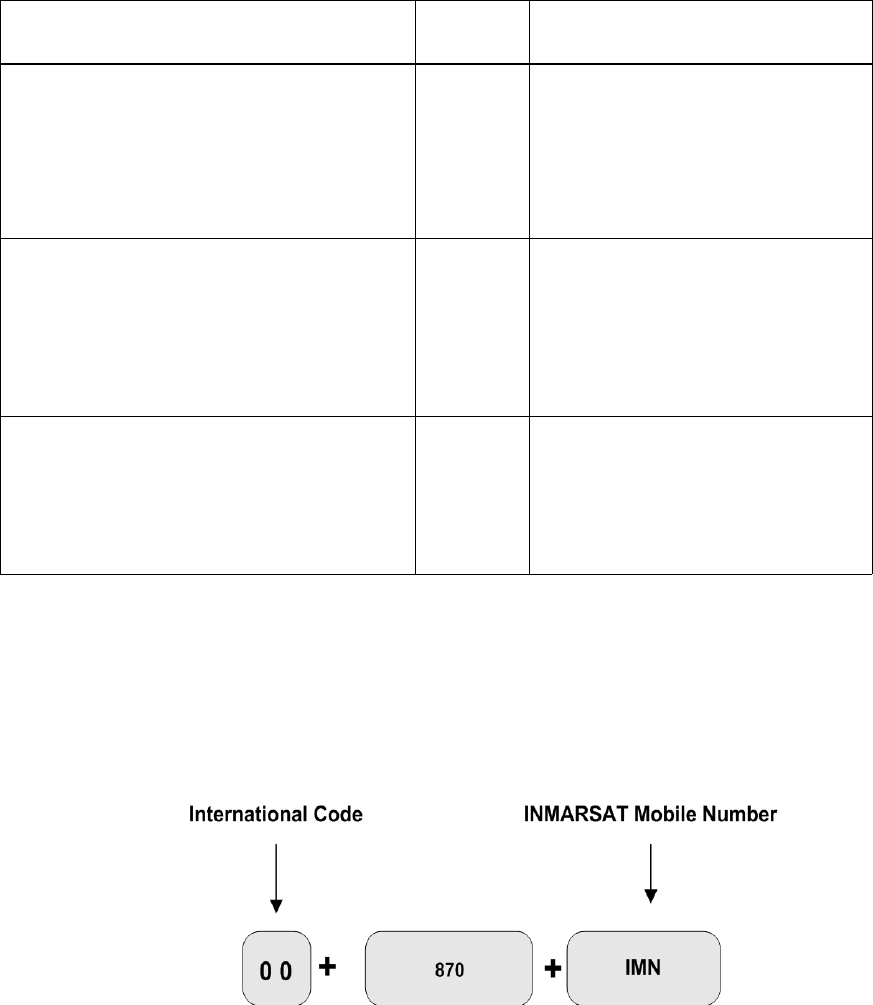
Table 2-3 Dial Code Prefixes for System Overrides
Reason for Override Dial Code
Prefix Example Dialing Sequence
Use this dial code prefix to override the default
LES/GES configured in the system.
This dial code prefix signals the system to
override the default LES/GES and use the
selected LES/GES instead. (See Figure 2-2
or contact Inmarsat for Swift 64 LES/GES
codes)
901 +
LES/GES
CODE
901 + LES/GES CODE +
International Code + Country Code +
Area Code + Telephone Number +
POUND KEY
901 + 002 + 00 + 1+ 613 +5551212
+ POUND KEY
Use with fast (e.g. automated) dialing devices
that cannot produce or add a POUND SIGN
to end the dialing sequence.
This dial code prefix signals the system to
send the call after a specified delay in user
input when the POUND SIGN cannot be
entered (about 4 seconds).
902
902 + International Code + Country
Code + Area Code + Telephone
Number
902 + 00 + 1+ 613 + 5551212
Use with slow (e.g. manual) dialing devices
that cannot produce or add a POUND SIGN
to end the dialing sequence.
This dial code prefix signals the system to
send the call after a specified delay in user
input (about 20 seconds).
903
903 + International Code + Country
Code + Area Code + Telephone
Number
903 + 00 + 1+ 613 + 5551212
SYSTEM DESCRIPTION, INSTALLATION, AND MAINTENANCE MANUAL
eNfusion® HSD-440 Mark 2 Terminal
23-15-30 2-10
3 JUN 10
(2) Mobile-to-Mobile Communication
The HSD-440 Mark 2 Terminal provides a two-way link for aircraft-to-aircraft
communication. Calling aircraft-to-aircraft requires additional information. You need
to know the IMN of the device or service on the aircraft you are calling.
Figure 2-2 illustrates the Mobile-to-Mobile dialing sequence.
Figure 2-2 Mobile-to-Mobile Dialing Sequence
SYSTEM DESCRIPTION, INSTALLATION, AND MAINTENANCE MANUAL
eNfusion® HSD-440 Mark 2 Terminal
23-15-30 2-11
3 JUN 10
B. Placing Calls with the CEPT-E1 Interface
HSD-440 Mark 2 Terminal CEPT-E1 interface provides Cabin Telecommunication Unit
(CTU) access to two Aero-H+ 4800 bps AMBE voice calls simultaneously. Since the
CEPT-E1 interface shares the Aero H+ voice channels with the cockpit, CTU calls maybe
preempted from either the air or ground by higher priority calls.
Air-to-ground and ground-to-air calls over the CEPT-E1 interface are priority 4 (public)
calls.
For information on how to place a call over the CEPT-E1 interface, see the CTU
documentation.
C. Using Data Connections
For information about data connections, optimizing your airborne network and selecting
the service that best meets your needs, refer to the HSD High-speed Data Terminal
Developer’s Guide, MN-1252-13005.
D. Operating the MCDU
This section provides information about the MCDU and its interfaces—output and input
ports, the screen, and the keyboard.
(1) Output Ports
The MCDU transfers its identification and commands to the HSD-440 Mark 2
Terminal using 32 bit words and a 12-14.5 kbps output port, as defined in ARINC
Specification 429, Digital Information Transfer System (DITS).
(2) Input Ports
The MCDU receives identification information and displays data from individual
subsystems using seven input ports, as defined by ARINC Specification 429. Ports
1 and 2 are reserved for FMSs, and they operate at 100 kbps. Ports 3 to 7 are
available for the MCDU to communicate with the HSD-440 Mark 2 Terminal, and they
operate at 12-14.5 kbps.
(3) Screen
The MCDU displays all data on the screen, as shown in Figure 2-3.

1SATCOM MA I N MENU
1L 3 1R
SAT 1 AVA I LABLE PR I
2L 5*MAKE CAL L 3 2R
0016135601243
3L 73R
SA T 2 I NCOM I NG CA L L
4L 9*ANS
W
ER CA L L REJ ECT * 4R
PUBL I C
5L 11 E5R
6L 13 <SUBMENU D I RECTORY> 6R
SYSTEM DESCRIPTION, INSTALLATION, AND MAINTENANCE MANUAL
eNfusion® HSD-440 Mark 2 Terminal
23-15-30 2-12
3 JUN 10
Figure 2-3 MCDU Screen
The top of the screen displays the title of the menu on the screen. The bottom of the
screen (Line 14) is the scratchpad that displays information that you enter on the
keyboard.
The MCDU has six buttons on each side of the screen that activate MCDU functions.
Figure 2-3 displays these buttons on the left and right sides of the screen. When the
functions corresponding to a button are available, the function’s name appears
beside the button—for example, in Figure 2-3, ANSWER CALL and REJECT (a call)
are available functions for the incoming call on SAT 2.
Other lines on the MCDU screen display information relevant to the function or status
of the HSD-440. In Figure 2-3, line 6 displays the phone number the HSD-440 Mark
2 Terminal will dial when the user presses the MAKE CALL button, and the number
3 under PRI in row 5 indicates that the priority of the outgoing call is 3.
(4) Keyboard
The MCDU’s keyboard includes a set of numeric keys and a set of alphabetic keys,
both of which you can use to enter data into the MCDU.
The keyboard may include preset keys, such as the following:
• The IDX or MAIN MENU key: this key returns you to the MCDU’s main menu.
• The CLR key: this key clears any text you type into the scratchpad.
• The NEXT PAGE key: this key brings up the next page of a menu if one is
available.
(5) Special Symbols
Because of space constraints on the screen, the MCDU uses a number of special
symbols to indicate actions:
• < and > appear at the far left or right to indicate that another menu page is
available in that direction.
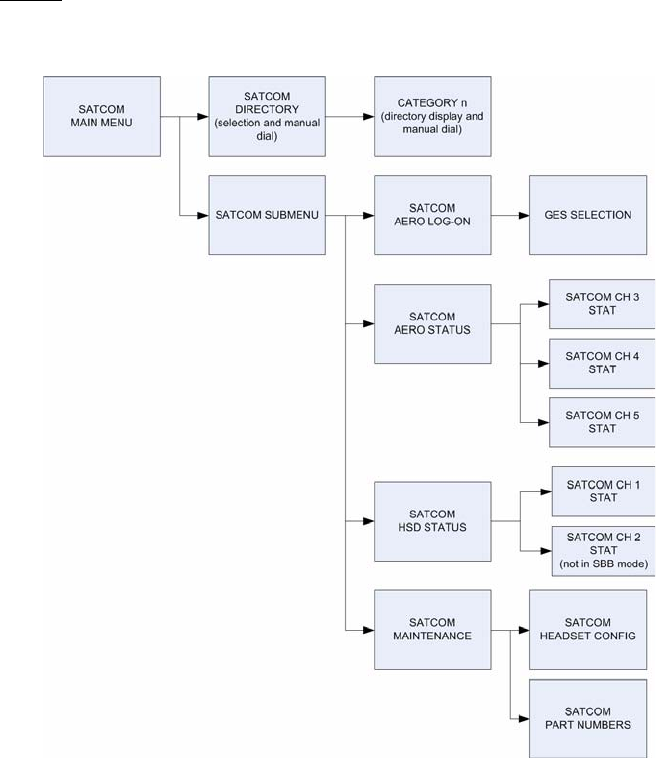
SYSTEM DESCRIPTION, INSTALLATION, AND MAINTENANCE MANUAL
eNfusion® HSD-440 Mark 2 Terminal
23-15-30 2-13
3 JUN 10
• * appears at the far left or right to indicate that pressing that key results in an
action.
• NUMBER/NUMBER appears to tell you which page out of how many pages you
are viewing. For example, 1/3 would appear when you are on page 1 of 3 pages
in total.
• [ and ] appear around empty data fields where you can enter data. However,
entering data is not mandatory in these fields.
(6) Navigating the MCDU
The MCDU includes a number of menus, as shown in Figure 2-4. There are four
category pages in the address book and up to 25 pages (100 phone numbers) for
each category.
NOTE: The SATCOM CH 2 STAT menu is not present when the HSD-440 Mark 2
Terminal is operating in SBB mode.
Figure 2-4 MCDU Menus

SYSTEM DESCRIPTION, INSTALLATION, AND MAINTENANCE MANUAL
eNfusion® HSD-440 Mark 2 Terminal
23-15-30 2-14
3 JUN 10
This section will help you perform the following tasks:
• Viewing Flight Information
• Logging On and Off
• Viewing Channel Information
• Configuring Headsets
(7) Viewing Flight Information
You can view the flight identification from the MCDU.
To view flight information:
1. On the first page of the MCDU’s main menu, press the key next to SUBMENU.
The SATCOM SUBMENU page appears.
SATCOM SUBMENU
LOG-ON STATE
LOGGED - OF F
<LOG-ON
AERO CHANNEL
STATUS>
HSD CHANNEL
STATUS>
FLT ID
12345 MA I NT ENANCE >
RETURN>
You can view the following information from this screen:
• Flight identification on the line below FLT ID
(8) Logging On and Off
You can use the MCDU to initiate a manual or automatic logon from the HSD-440
Mark 2 Terminal to the satellite network.
The HSD-440 Mark 2 Terminal boot-up logon mode is specified in the
Logon/Handover Policy in the ORT. You can set this parameter to automatic or
manual. After the terminal has finished the boot-up process, you can use the MCDU
to log off (from an automatic logon) or to initiate a manual (constrained) logon.
During an automatic logon, the system selects the most appropriate GES depending
on HSD-440 Mark 2 Terminal location.
During a manual logon, you must select the GES. Even if the ORT parameter is
configured for automatic logon, you can still constrain the terminal to logon using a
particular GES.

SYSTEM DESCRIPTION, INSTALLATION, AND MAINTENANCE MANUAL
eNfusion® HSD-440 Mark 2 Terminal
23-15-30 2-15
3 JUN 10
(a) Viewing the Log Status
The log status defines whether the HSD-440 Mark 2 Terminal is currently logged
on or logged off. The logon status can be:
• Logged-Off—The HSD-440 Mark 2 Terminal is logged off.
• Logged-Off Inop—The HSD-440 Mark 2 Terminal is configured to log on
manually but the terminal is in an inoperable state. Clear all problems
for the logon to continue.
• Logged-Off Rejected—The HSD-440 Mark 2 Terminal is logged on and
a second logon attempt is made. The second attempt fails and the status
is Logged-Off Rejected.
• Logging-On Inop—The HSD-440 Mark 2 Terminal is configured to log
on automatically but the terminal is in an inoperable state. Clear all
problems for the logon to continue.
• Logged-On Constrained—The HSD-440 Mark 2 Terminal is logged on
manually.
• Logged-On Auto—The HSD-440 Mark 2 Terminal is logged on
automatically.
• Logging-off—TheHSD-440 Mark 2 Terminal is in the process of logging
off.
• Logging-on—The HSD-440 Mark 2 Terminal is in the process of logging
on.
To view the log status:
1. On the main page of the MCDU, press the key next to SUBMENU.
The SATCOM SUBMENU page appears.
The logon state appears on the line below LOG-ON STATE.
You can view additional details about the logon, including the GES and satellite
name. To view additional logon details:
1. On the main page of the MCDU, press the key next to SUBMENU.
The SATCOM SUBMENU page appears.
2. On the SUBMENU page, press the key next to LOG-ON.
The SATCOM AERO LOG-ON screen appears as shown below. The logon
state appears on the line below LOG-ON STATE. You can also view the GES
name, satellite name, signal level, antenna type, azimuth and elevation, and
8-digit ICAO ID.
NOTE: If the HSD-440 Mark 2 Terminal is logged off, the LOG-OFF option
is not available. If the HSD-440 Mark 2 Terminal is logged on, the
AUTO LOG-ON option is not available.
(b) Initiating an Automatic Logon
When the HSD-440 Mark 2 Terminal logs on automatically, it selects an
appropriate GES and satellite based on its position.

SYSTEM DESCRIPTION, INSTALLATION, AND MAINTENANCE MANUAL
eNfusion® HSD-440 Mark 2 Terminal
23-15-30 2-16
3 JUN 10
To log on automatically:
1. On the main page of the MCDU, press the key next to SUBMENU.
The SATCOM SUBMENU page appears.
2. On the SUBMENU page, press the key next to LOG-ON.
The SATCOM AERO LOG-ON page appears.
3. On the SATCOM AERO LOG-ON page, press the key next to AUTO
LOG-ON.
The HSD-440 Mark 2 Terminal logs on and the logon state is LOGGED-ON
AUTO.
NOTE: The AUTO LOG-ON key is not available if the HSD-440 Mark 2
Terminal is already logged on.
(c) Selecting a GES (Initiating a Constrained Logon)
You can constrain the HSD-440 Mark 2 Terminal to logon using a particular GES.
If the HSD-440 Mark 2 Terminal is logged off, selecting a GES initiates a
constrained log on (logon state is LOGGED-ON CONSTRAINED).
If the HSD-440 Mark 2 Terminal is already logged on and you select a new GES,
the MCDU displays the SATCOM AERO LOG-ON page and automatically logs
off the old GES and logs on to the new GES. This also results in a constrained
logon.
To select a GES:
1. On the main page of the MCDU, press the key next to SUBMENU.
The SATCOM SUBMENU page appears.
2. On the SUBMENU page, press the key next to LOG-ON.
The SATCOM AERO LOG-ON page appears.
3. On the SATCOM AERO LOG-ON page, press the key next to GES SEL.
The GES SELECTION page appears.

GES SELECT I ON 1 / 3
AORW
*AUSSAGUEL / 005
AORW
*EIK / 002
AORE
*AUSSAGUEL / 103
AORE
*EIK / 104
POR
*PERTH / 205
RETURN>
SYSTEM DESCRIPTION, INSTALLATION, AND MAINTENANCE MANUAL
eNfusion® HSD-440 Mark 2 Terminal
23-15-30 2-17
3 JUN 10
4. To select a GES, press the button next to the GES name.
A logon confirmation (LOG-ON) appears at the bottom of the screen.
5. To log on to the new GES, press the key next to LOG-ON.
(d) Logging Off
You can use the MCDU to initiate the HSD-440 Mark 2 Terminal logoff sequence.
To log off:
1. On the main page of the MCDU, press the key next to SUBMENU.
The SATCOM SUBMENU page appears.
2. Press the key next to LOG-OFF.
The HSD-440 Mark 2 Terminal logs off.
(9) Viewing Channel Information
There are three Aero channels and two Swift 64 channels, or one SwiftBroadband
channel, available with the HSD-440 Mark 2 Terminal. You can use the MCDU to
view the following information about each of the channels:
• Logon status (Aero channels only)—Logon status may be Valid or Invalid.
• ORR status (Swift 64 channels only)—Ocean Region Registration (ORR) status
may be Valid or Invalid.
• Attach status (SwiftBroadband channels only)—Attach status may be Valid or
Invalid.
• Call Termination Code (CALL TERM)
• Transmitter Effect Isotropic Radiated Power (TX EIRP)
• Receiver carrier-to-noise ratio (RX C/NO)
• Service type—Possible service types are:
• AERO P/R/T
• AERO VOICE
•SWIFT64

SYSTEM DESCRIPTION, INSTALLATION, AND MAINTENANCE MANUAL
eNfusion® HSD-440 Mark 2 Terminal
23-15-30 2-18
3 JUN 10
• SBB (SwiftBroadband)
• Number of bits transmitted per second (TX KBPS)—for Swift 64 MPDS or SBB
background services, the number of bits being transmitted per second is
expressed in kilobits per second (kbps).Otherwise, the number of bits transmitted
is zero.
• Number of bits received per second (RX KBPS)—for Swift 64 MPDS or SBB
background services, the number of bits being received per second is expressed
in kilobits per second (kbps). Otherwise, the number of bits received is zero.
• Service information (CONNECTED)—For Aero service, service information
includes the GES name and number. For GAN (Swift 64) service, service
information includes the service provider number and name description. For SBB
service, no information is provided.
• Satellite ID (SAT)—Satellite ID includes the index number of each satellite, a
mnemonic and abbreviated alphanumeric description, and the spot beam that
theHSD-440 Mark 2 Terminal is currently using.
(a) To view information about an Aero channel:
1. On the main page of the MCDU, press the key next to SUBMENU.
The SATCOM SUBMENU page appears.
2. On the SUBMENU page, press the key next to AERO CHANNEL STATUS.
The SATCOM AERO STATUS page appears.
SATCOM AERO STATUS
<CHAN 3 - ACARS DATA
<CHAN 4 - AERO VO I CE
<CHAN 5 - AERO VO I CE
RETURN>
3. On the SATCOM AERO STATUS page, press the key next to a channel.
The SATCOM CH STAT page appears. (MCDU pages for Channel 3 and
Channel 4 are shown below.)

SATCOM CH 3 STAT
LOGON
W
A I T FOR P CHAN SYNC
CALL TERM TX KBPS
0.00
TX E I RP RX KBPS
13 . 5 0 . 00
RX C / N0 CONNECTED
50 . 0 EIK
SERV TYPE SAT
AERO P/R/T AORE B5
RETURN>
SATCOM CH 4 STAT
LOGON
VAL I D
CALL TERM TX KBPS
0.00
TX E I RP RX KBPS
0.0 0.00
RX C / N0 CONNECTED
0.0 EIK
SERV TYPE SAT
AERO VO I CE AORE B5
RETURN>
SYSTEM DESCRIPTION, INSTALLATION, AND MAINTENANCE MANUAL
eNfusion® HSD-440 Mark 2 Terminal
23-15-30 2-19
3 JUN 10
(b) To view information about a Swift 64 channel:
1. On the main page of the MCDU, press the key next to SUBMENU.
The SATCOM SUBMENU page appears.
2. On the SATCOM SUBMENU page, press the key next to HSD CHANNEL
STATUS.
The SATCOM HSD STATUS page appears.

SATCOM HSD STATUS
<CHAN 1 - S
W
IFT64
<CHAN 2 - S
W
IFT64
RETURN>
SYSTEM DESCRIPTION, INSTALLATION, AND MAINTENANCE MANUAL
eNfusion® HSD-440 Mark 2 Terminal
23-15-30 2-20
3 JUN 10
3. On the SATCOM HSD STATUS page, press the key next to a Swift 64
channel.
The SATCOM CH STAT page appears.
SATCOM CH 1 STAT
ORR S TA T
REG I STER I NG
CALL TERM TX KBPS
0.00
TX E I RP RX KBPS
14 . 0 0 . 00
RX C / N0 CONNECTED
53 . 0 LES 1
SERV TYPE SAT
S
W
IFT64 AORE B5
RETURN>
(c) To view information about a SBB channel:
1. On the main page of the MCDU, press the key next to SUBMENU.
The SATCOM SUBMENU page appears.
2. On the SATCOM SUBMENU page, press the key next to HSD CHANNEL
STATUS.
The SATCOM HSD STATUS page appears.

SATCO
M
HSD STATUS
<CHAN 1 - SBB
RETURN>
SYSTEM DESCRIPTION, INSTALLATION, AND MAINTENANCE MANUAL
eNfusion® HSD-440 Mark 2 Terminal
23-15-30 2-21
3 JUN 10
3. On the SATCOM HSD STATUS page, press the key next to the SBB channel.
The SATCOM CH STAT page appears.
SATCOM CH 1 STAT
ATTACH
YES
CALL TERM TX KBPS
0.00
TX E I RP RX KBPS
20 . 0 0 . 00
RX C / N0 CONNECTED
72 . 2
SERV TYPE SAT
BGAN AORE B5
RETURN>
(10)Viewing Maintenance Information
The maintenance page provides information about:
• Terminal status
• Terminal part numbers
(a) Viewing Terminal Status
To view the terminal status:
1. On the main page of the MCDU, press the key next to SUBMENU.
The SATCOM SUBMENU page appears.
2. On the SATCOM SUBMENU page, press the key next to MAINTENANCE.
The SATCOM MAINTENANCE page appears.

SATCO
M
M
A I NTENANCE
STATUS
TERMI NAL TRANSMI T
OK NOR
M
AL
<HEADSET CONF I G
<PART NU
M
BERS
RESET SATCO
M
SYSTE
M
NOT AVA I L - I N A I R
RETURN>
SYSTEM DESCRIPTION, INSTALLATION, AND MAINTENANCE MANUAL
eNfusion® HSD-440 Mark 2 Terminal
23-15-30 2-22
3 JUN 10
The maintenance menu displays the following information:
• Terminal status on the line below TERMINAL—Terminal status may be
OK or FAULT.
• Transmit status on the line below TRANSMIT—Transmit status may be
NORMAL or INHIBITED.
• Air/Ground status on the line below RESET SATCOM SYSTEM—When
set to ON GROUND, the system is on the ground and can be reset.
When set to NOT AVAIL – IN AIR, the system is in the air and cannot
be reset.
(b) Viewing Terminal Part Numbers
To view terminal part numbers:
1. On the main page of the MCDU, press the key next to SUBMENU.
The SATCOM SUBMENU page appears.
2. On the SATCOM SUBMENU page, press the key next to MAINTENANCE.
The SATCOM MAINTENANCE page appears.
3. On the SATCOM MAINTENACE page, press the key next to PART
NUMBERS.
The SATCOM PART NUMBERS page appears.
The part numbers menu displays the following information:
• HSD-440 Mark 2 Terminal part number and version
• HSD-440 Mark 2 Terminal software load and version
• 8-digit ICAO ID
• 3-digit HSD-440 Mark 2 Terminal serial number
• 6-digit (hexadecimal) Forward IDs (FWD ID 1 and FWD ID 2)

SYSTEM DESCRIPTION, INSTALLATION, AND MAINTENANCE MANUAL
eNfusion® HSD-440 Mark 2 Terminal
23-15-30 2-23
3 JUN 10
• 15-digit IMSI number
(11)Configuring Headsets
To configure the headset(s):
1. On the main page of the MCDU, press the key next to SUBMENU.
The SATCOM SUBMENU appears.
2. On the SATCOM SUBMENU page, press the key next to MAINTENANCE.
The SATCOM MAINTENANCE page appears.
3. Press the key next to HEADSET CONFIG.
The SATCOM HEADSET CONFIG page appears.
NOTE: Toggle between the two 4-wire headsets by pressing the key next to
SAT. When you toggle between headsets, the speaker, microphone,
sidetone, and noise values are displayed for that headset.
SATCO
M
HEADSET CONF I G
SAT
*DEFAULT 1
SPEAKER
*D
W
N50 UP*
M I CROPHONE
*D
W
N 70 UP*
S I DETONE
*D
W
N50 UP*
NO I SE
*D
W
N-50 UP*
RETURN>
4. To increase or decrease the speaker, microphone, sidetone, and noise insertion
levels, press the keys next to DWN and UP. When you change either of the levels,
a SAVE label appears at the bottom of the screen.
NOTE: The speaker, microphone, and sidetone values move up and down by
5, and the noise value moves up and down through values -60, -50, -40,
and OFF.
NOTE: To reset all the settings to the default values, press the key next to
DEFAULT. Default values are speaker (50), microphone (70), sidetone
(50), and noise (-50).
5. To save the new levels, press the key next to SAVE.
E. Operating the WSC
The WSC performs the same functions as the MCDU. For more information on operating
the WSC, see the WSC manufacturer’s documentation and ARINC 741 Part 2
Attachment 2F-42.1.
SYSTEM DESCRIPTION, INSTALLATION, AND MAINTENANCE MANUAL
eNfusion® HSD-440 Mark 2 Terminal
23-15-30 2-24
3 JUN 10
F. Performing Cockpit Communications with the MCDU
This section provides instructions for making calls with the MCDU and 4-wire voice
services available in the aircraft’s cockpit. The cockpit communications system operates
with one or two headsets in the aircraft’s cockpit, depending on the operational mode.
(1) Modes of Operation
The cockpit communication services are configured in one of two modes of operation
before installation: Latched mode and Push-to-Talk (PTT) mode. These
configurations are strapped at the terminal and cannot be changed without removing
and rewiring the terminal.
In PTT mode, a telephone number can be dialed only using the MCDU keys, not with
the switches on the cockpit communication console. In Latched mode, a call to a
telephone number loaded into the MCDU can be initiated using the switches on the
Audio Control Panel (ACP), and calls can be answered and ended with the switches
or the MCDU buttons.
(2) Accepting and Making Calls
You can accept and make voice calls using
• the HSD-440 Mark 2 Terminal, the MCDU, the ACP, and one or two 4-wire cockpit
headsets
or
• the HSD-440 Mark 2 Terminal, the WSC, the ACP, and one or two 4-wire cockpit
headsets.
(a) Automatic Call Handling Priority and Preemption
The HSD-440 Mark 2 Terminal automatically disconnects (preempts) a call if it
receives a higher priority call when both classic Aero channels are in use. When
two calls are in progress, the HSD-440 Mark 2 Terminal preempts the lower
priority call. If both calls are the same priority, the HSD-440 Mark 2 Terminal
preempts the last call received.
When the HSD-440 Mark 2 Terminal preempts the lower priority call and
connects the higher priority call, the caller in the aircraft does not receive a notice.
The new, high priority call starts as soon as the HSD-440receives it.
(b) Accepting and Making Calls
You can use the MCDU and ACP to accept calls, make air-to-ground calls, and
make air-to-air calls. You can manually dial calls or dial previously saved
telephone numbers from the MCDU’s telephone directory.
The way in which you can accept or make calls depends on the mode in which
your 4-wire cockpit headset is strapped (PTT mode or Latched mode) and the
Cockpit Outgoing Call Pre-Select ORT parameter. Refer to "Configuring
Outgoing Call Pre-Selection" on page 6-24.
The combination of lights and chimes that alert you to an incoming call depends
on the way in which the HSD-440 Mark 2 Terminal Cockpit Call Signalling Mode
ORT parameter is set. Refer to C. “Configuring Cockpit Communication
Parameters” on page 6-5. If you use the alternate output discretes, the call
discrete outputs are driven as per Table 2-4 instead of using lights and chimes.

Table 2-4 Call Discrete Outputs in HSD-440 Mark 2 Terminal
Channel State
Audio Discrete Alternate Discrete
Digital Audio
System Light Digital Audio
System Chime Discrete 1 Discrete 2
On hook Off Off Off Off
Call initiated/connected 1 Hz flash Off On Off
Call answered Steady or 3 Hz flash Off Off On
Incoming call 1 Hz flash Single-stroke On On
SYSTEM DESCRIPTION, INSTALLATION, AND MAINTENANCE MANUAL
eNfusion® HSD-440 Mark 2 Terminal
23-15-30 2-25
3 JUN 10
To accept the call:
• On the first page of the MCDU’s main menu, press the key next to ANSWER
CALL.
• Assert the Place/End switch.
• Assert the VoiceMic On switch.
or
• In Latched mode, on the ACP, assert the SAT 1 or SAT 2 switch.
• In PTT mode, on the ACP, assert the SAT 1 or SAT 2 switch and press the
PTT switch.
(c) Manual Dialing Calls
Making calls using the HSD-440 Mark 2 Terminal is similar to placing an
international telephone call. Air-to-ground telephone numbers include an
international access code, country code, and area code.
International access codes and country codes are shown in Appendix G:
“International Access and Country Codes” on page G-1.
To manually dial a call:
1. On the main page of the MCDU, press the key next to DIRECTORY.
The SATCOM DIRECTORY page appears.
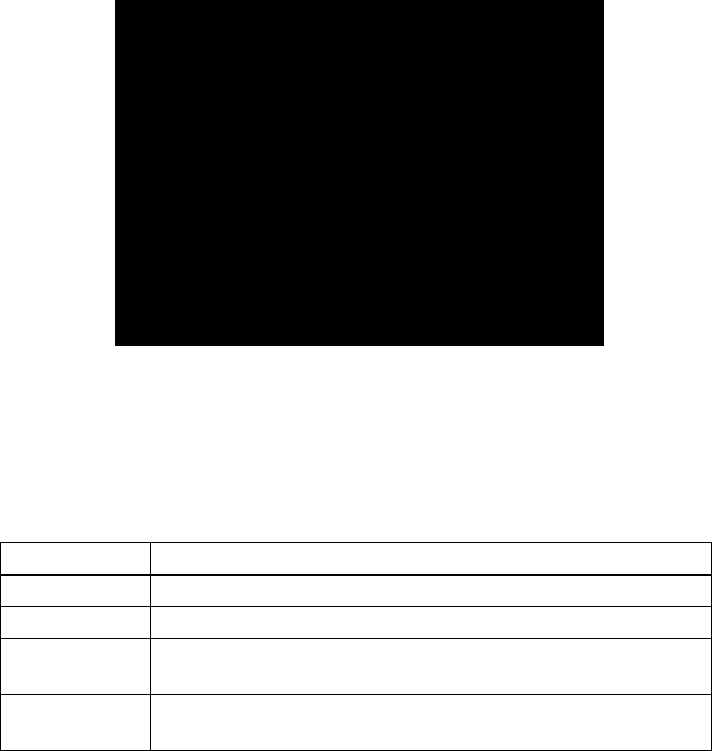
SATCO
M
DIRECTORY
<CATEGORY0 1 CATEGORY0 3 >
<CATEGORY0 2 CATEGORY0 4 >
SAT
2
[ MANUAL D I AL ] PR I
3
RETURN>
SYSTEM DESCRIPTION, INSTALLATION, AND MAINTENANCE MANUAL
eNfusion® HSD-440 Mark 2 Terminal
23-15-30 2-26
3 JUN 10
2. To select a channel, on the SATCOM DIRECTORY page, press the key next
to SAT (the channel number).
3. To set the priority for your call using Table 2-5, type the priority number on
the MCDU scratchpad and press the key next to PRI (the priority value).
Table 2-5 Priority Codes
Call priority Description
1Emergency—used for distress or urgent calls
2Operational-High—used for Flight Safety communications
3Operational-Lo—used for Regularity of Flight, Meteorological or
Administrative communications
4Non-Operational—used for Non Safety of Flight or public phone
call (cabin) communications
4. To dial the call, type the phone number into the scratchpad and press the
key next to MANUAL DIAL.
With Pre-Select Mode disabled, the MCDU Main Menu page appears and
the HSD-440 Mark 2 Terminal initiates the call. With Pre-Select Mode
enabled, the MCDU Main Menu page appears.
• To start the call with Pre-Select mode enabled, in either Latched or PTT
mode, press the key next to MAKE CALL.
• To start the call in PTT mode with Pre-Select mode enabled, on the ACP,
assert the PLACE/END CALL 1 or PLACE/END CALL 2 switch.
or
assert the SAT 1 or SAT 2 switch and then press the PTT switch.
• To start the call In Latched mode with Pre-Select mode enabled, on the
ACP, assert the SAT 1 or SAT 2 switch.

SYSTEM DESCRIPTION, INSTALLATION, AND MAINTENANCE MANUAL
eNfusion® HSD-440 Mark 2 Terminal
23-15-30 2-27
3 JUN 10
(d) Making Calls from the Telephone Directory
You can make voice calls from the numbers you have saved in the MCDU’s
telephone directory.
The HSD-440 Mark 2 Terminal MCDU enables you to keep four separate
telephone books for different uses. By default, these books are called Category
01, Category 02, Category 03, and Category 04. You can customize the directory
names in the HSD-440 Mark 2 Terminal ORT.
To make a call from the telephone directory:
1. On the main page of the MCDU, press the key next to DIRECTORY.
The SATCOM DIRECTORY page appears.
SATCO
M
DIRECTORY
<CATEGORY0 1 CATEGORY0 3 >
<CATEGORY0 2 CATEGORY0 4 >
SAT
2
[ MANUAL D I AL ] PR I
3
RETURN>
2. To access the phone numbers in a directory, press the key next to the
directory name.
The selected directory appears.
CATEGORY 1 1/1
MAKE CAL L : SAT
1
0116135551111 PRI
* 01 - LABEL 1 3
0116135552222
* 02 - LABEL 2 1
[]
[][]
* SORT RETURN>

SYSTEM DESCRIPTION, INSTALLATION, AND MAINTENANCE MANUAL
eNfusion® HSD-440 Mark 2 Terminal
23-15-30 2-28
3 JUN 10
3. To dial or load a telephone number, press the key next to the number.
With Pre-Select mode disabled, the MCDU main menu page appears and
the HSD-440 Mark 2 Terminal starts the call.
With Pre-Select mode enabled, the MCDU main menu page appears.
SATCO
M
M
AIN
M
ENU
SAT 1 AVA I LABLE PR I
*
M
AKE CALL 3
0016135551111
SAT 2 I NCOMI NG CAL L
*ANS
W
ER CA L L REJ ECT *
PUBL I C
<SUB
M
ENU D I RECTORY>
4. To dial the telephone number with Pre-Select mode enabled:
• In PTT or Latched mode, on the MCDU, press the key next to MAKE
CALL.
or
• In PTT mode, on the ACP, assert the PLACE/END CALL 1 or
PLACE/END CALL 2 switch or close the SAT 1 or SAT 2 switch, and
then press the PTT switch.
or
• In Latched mode, on the ACP, close the SAT 1 or SAT 2 switch.
(e) Ending Calls
To end the call:
• In PTT or Latched mode, on the MCDU main menu, press the key next to
END CALL.
or
• In PTT or Latched mode, assert the PLACE/END CALL 1 or
PLACE/END CALL 2 switch.
or
• In Latched mode, on the ACP, assert the VoiceMic On switch for the active
call.
(f) Saving Telephone Numbers in the Telephone Directory
You can save telephone numbers to the MCDU’s telephone directory to use later,
and you can dial telephone numbers from the telephone directory.

SYSTEM DESCRIPTION, INSTALLATION, AND MAINTENANCE MANUAL
eNfusion® HSD-440 Mark 2 Terminal
23-15-30 2-29
3 JUN 10
To save telephone numbers to the telephone directory:
1. On the main page of the MCDU, press the key next to DIRECTORY.
The SATCOM DIRECTORY page appears.
2. To view telephone numbers stored in a directory, press the key next to the
directory name.
The directory listing appears.
3. Navigate to the page with the last entry in the directory, type the phone
number into the scratchpad, and then press the key next to the empty
brackets on the MCDU screen.
The telephone number appears in the brackets.
4. Type the name associated with the telephone number and then press the
key next to the empty brackets on the MCDU screen.
5. Type the priority associated with the telephone number and then press the
key next to the empty brackets on the MCDU screen.
6. To save the number, press the key next to SAVE. To cancel the new entry,
press the key next to CANCEL.
NOTE: Press the key next to SORT to alphabetically sort the entries in the
directory. Entries remain sorted even after the HSD-440 Mark 2
Terminal is rebooted.
SYSTEM DESCRIPTION, INSTALLATION, AND MAINTENANCE MANUAL
eNfusion® HSD-440 Mark 2 Terminal
23-15-30 2-30
3 JUN 10
Blank Page
SYSTEM DESCRIPTION, INSTALLATION, AND MAINTENANCE MANUAL
eNfusion® HSD-440 Mark 2 Terminal
23-15-30 3-1
3 JUN 10
INSTALLATION
This section provides procedures to install HSD-440 Mark 2 Terminals on an aircraft, including the
following sections:
• Advisories
• Pre-Installation Inspection
• Mechanical Installation
• Electrical Installation
• Passive Intermodulation (PIM) Test
• Installation and Engineering Diagrams
1. Advisories
Read the safety advisories in the Introduction section on page INTRO–6 of this manual before
you begin installing the terminal.
2. Pre-Installation Inspection
Inspect all parts before you install any HSD-440 Mark 2 Terminal, to make sure that no damage
occurred during shipping.
A. Unpacking and Inspecting Equipment
• Unpack the HSD-440 Mark 2 Terminals from the shipping containers.
• Verify that the part number displayed on the shipping box and equipment component
matches the model and part number ordered. If components are missing from the
shipment, contact the supplier or Honeywell Product Support immediately and report
the problem.
• Visually inspect the terminal for any shipping damage. If any shipping damage has
occurred, contact the shipping carrier immediately and report the problem.
• Check the HSD-440 Mark 2 Terminal connectors for corrosion and damage. If
damage is noted, do not apply power to the terminal. Contact the supplier or
Honeywell Product Support immediately to report the problem.
B. Cabling Notes
Before proceeding with the installation of the HSD-440 Mark 2 Terminal, read all cabling
notes provided on the HSD-440 Mark 2 Terminal Interconnection and Contact
Assignment drawings at the end of this section.
SYSTEM DESCRIPTION, INSTALLATION, AND MAINTENANCE MANUAL
eNfusion® HSD-440 Mark 2 Terminal
23-15-30 3-2
3 JUN 10
(1) Cabling
When installing the HSD-440 Mark 2 Terminal, follow the cabling requirements listed
below:
• Maximum recommended length for Ethernet cables is 50 feet.
• LAN cables must meet flammability, TIA/EIA568-A CAT 5, requirements and
conform to ARINC 628 specifications.
• Wire size recommendations:
•For +28 V dc HOT (BP2), +28 V dc RTN GND (BP3), 115 V ac COLD (BP7),
and Chassis GND (BP8), use 12 AWG
•For 115 V ac HOT (BP1), use 20 AWG
• Unless otherwise specified, for signaling, use 22 AWG
(2) Coaxial Cable Loss Considerations
When installing HSD-440 Mark 2 Terminals, consider the following coaxial cable loss
requirements:
• Transmit cable: maximum loss is 2.5 dB, including DLNA (typically <0.8 dB), as
per ARINC 741. In installations that use a high power relay, the high power relay
loss must be included.
• Receive cable: minimum loss is 6 dB, maximum loss is 25 dB (including any
in-line attenuator), as per ARINC 741.
3. Mechanical Installation
This section contains the information required to plan the physical placement of HSD-440 Mark
2 Terminals. The Outline and Installation diagrams, shown in Figure 3-6 and Figure 3-7,
illustrate the physical and mechanical specifications of the HSD-440 Mark 2 Terminal.
In typical aircraft installations, the HSD-440 Mark 2 Terminal assembly fits into standard ARINC,
8-MCU mounting trays.
A. Physical Placement
When selecting a location for the HSD-440 Mark 2 Terminal, allow for adequate spacing
for the installation while providing reasonable access for servicing. Leave a minimum
gap of 0.5 inches between LRUs.
B. Environmental Requirements
The environmental requirements that must be considered during the physical placement
of the HSD-440 Mark 2 Terminals are based on the RTCA/DO-160E Environmental
Specifications detailed in "System Description" on page 1-1.
The mounting trays offer a number of fan configuration options depending on the physical
placement of the LRU in the aircraft.
(1) Heating and Cooling
Refer to "System Description" on page 1-1 for a complete listing of the
RTCA/DO-160E Environmental Specifications for the HSD-440 Mark 2 Terminals.
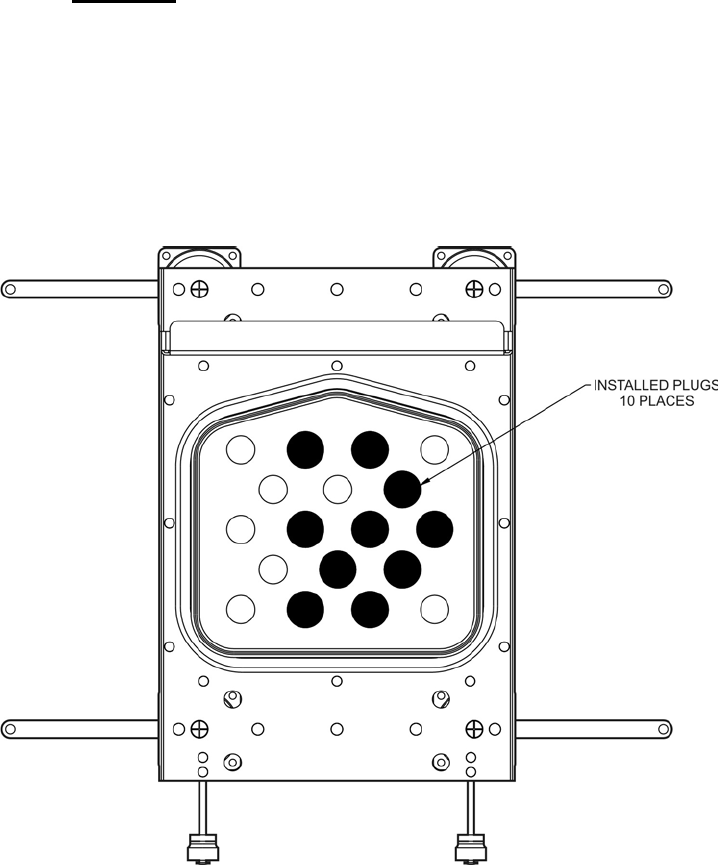
SYSTEM DESCRIPTION, INSTALLATION, AND MAINTENANCE MANUAL
eNfusion® HSD-440 Mark 2 Terminal
23-15-30 3-3
3 JUN 10
When selecting an installation location for the HSD-440 Mark 2 Terminal, consider
the heating and cooling requirements listed below:
• Power Dissipation (AC/DC models): 275 Watts nominal, 400 Watts maximum
• Cooling Air: per ARINC 600
• Recommended Flow rate: 88 kg/hr (185 lbs/hr)
• Pressure drop: 5 ±3 mm (0.07 ±0.025 in.) H2O
(2) Fan Tray Requirements
WARNING: FAILURE TO INSTALL AND CONFIGURE THE FAN TRAY
ASSEMBLY AS INSTRUCTED MAY SERIOUSLY COMPROMISE
THE HSD-440 TERMINAL'S EXTREME TEMPERATURE
OPERATION.
For adequate airflow to the HSD-440 Mark 2 Terminal subassemblies, install plugs
in the fan/tray configuration as illustrated in Figure 3-1. Fan tray assemblies may be
shipped with or without plugs. If required, order additional plugs from your fan tray
manufacturer.
Figure 3-1 Fan Tray Plug Configuration (black = installed, white = removed)

SYSTEM DESCRIPTION, INSTALLATION, AND MAINTENANCE MANUAL
eNfusion® HSD-440 Mark 2 Terminal
23-15-30 3-4
3 JUN 10
C. Chassis Grounding
The HSD-440 Mark 2 Terminal tray-mounted assemblies must be electrically bonded to
the airframe. Make sure that the mating surfaces are free from contaminants such as
paints or other non-conductive elements. Where surface preparations are insufficient to
ensure a proper bond, EMS Aviation recommends using a short, tin-coated, copper
bonding strap of at least 6.35 mm (0.25 in.) in width. The LRU and tray assemblies should
provide a low impedance path of <0.2 ohms.
4. Electrical Installation
This section provides electrical installation details for HSD-440 Mark 2 Terminals.
A. Cabling and Connector Requirements
This section provides general electrical installation information on power, ground,
shielding requirements, and cabling.
(1) Power Requirements
The HSD-440 Mark 2 Terminal can operate from the aircraft’s +28 V dc or 115 V ac,
400 Hz (nominal) power supply. If both power sources are connected, the terminal
will use the 115 V ac supply.
(2) Ground Requirements
Improper grounding can lead to ground loops and induced Electromagnetic
Interference (EMI) or Radio Frequency Interference (RFI). When installing an
HSD-440 Mark 2 Terminal, follow standard grounding practices for both chassis and
cabling shields. Refer to "Chassis Grounding" on page 3-4 for chassis and tray
grounding instructions.
(3) Cable Shielding and Termination
The preferred method of cable shield termination is in accordance with NEMA WC
27500:2000 and ARINC 741. ARINC Report 413A—Guidance for Aircraft Electrical
Power Utilization and Transient Protection provides more detailed information in
Attachment 3-2, Wire Shielding and Grounding Requirements and in Appendix 7.
Unless otherwise stated, all cable shields must be connected to the closest aircraft
ground at both ends of the cable and on both sides of any production break in the
cable. Where applicable, terminate shields with connectors via the backshell or via
a pigtail with a suitable termination to the closest aircraft ground.
General aviation cable-routing guidelines apply. See Table 3-1 for detailed
information.
NOTE: Typically, Ethernet and ISDN cables have multiple shields; terminate each
shield separately.

Table 3-1 Cable Shielding and Termination Specifications
Cable Function Conductor Type
(Typical) Single
Point Multiple
Point Minimum Conductor
Coverage By Shield
Power Lines Single conductor, stranded N/A N/A N/A
Digital Control Twisted pair, stranded Yes 85%
Serial Data Twisted pair, stranded Yes 85%
Ethernet Data Twisted pair, stranded Yes 85%
ISDN Data Twisted pair, stranded Yes 85%
Discrete Lines Single conductor, stranded N/A N/A N/A
RF TX and RX Coaxial Yes 95%
Single Point: Cable shield terminated at one end only via a connector or suitable crimp terminal.
Multiple Point: Cable shield terminated at both ends via a connector or suitable crimp terminal,
usually at both ends of the cable and at both sides of any production break.
N/A: Not applicable.
SYSTEM DESCRIPTION, INSTALLATION, AND MAINTENANCE MANUAL
eNfusion® HSD-440 Mark 2 Terminal
23-15-30 3-5
3 JUN 10
To minimize Passive Intermodulation (PIM), the coaxial cable between the DLNA and
the antenna must be double-shielded (braid and foil wrap) with gold-plated and soldered
(not crimped) connector contacts. Do not use nickel, nickel plating, or stainless steel.
B. Installation Wiring Notes
This section includes wiring notes and connection details about strapping.
(1) Source/Destination Identification
Source/Destination Identification (SDI) is provided for the HPA as per ARINC 741
specifications. Pins marked 0 are left open-circuit and pins marked 1 are strapped
on the airframe side of the connector to the pin assigned as SDI Common (TP5D).
For this HGA application, strap pin TP5B (1) and leave TP5A (0) open.
NOTE: The logic for the SDI/WOW is explained in ARINC 741 Characteristic
Attachment 1-4, Note 19. The SDI/WOW logic in this case (where 0=open
and 1=strapped to common) is the reverse of the logic applied to all other
HSD-440 Mark 2 Terminal connectors, FWD ID, system configuration, and
data I/O configuration, where 0=strapped to common and 1=open.
(2) Maintenance Port Interface
The HSD-440 Mark 2 Terminal has an RS-232 maintenance port interface that
provides access to the MPU for data loading, system monitoring, and testing
purposes.
Access to the HSD-440 Mark 2 Terminal MPU is achieved by connecting an RS-232,
VT-100 terminal (computer operating a terminal emulation program) to the RS-232
maintenance port.
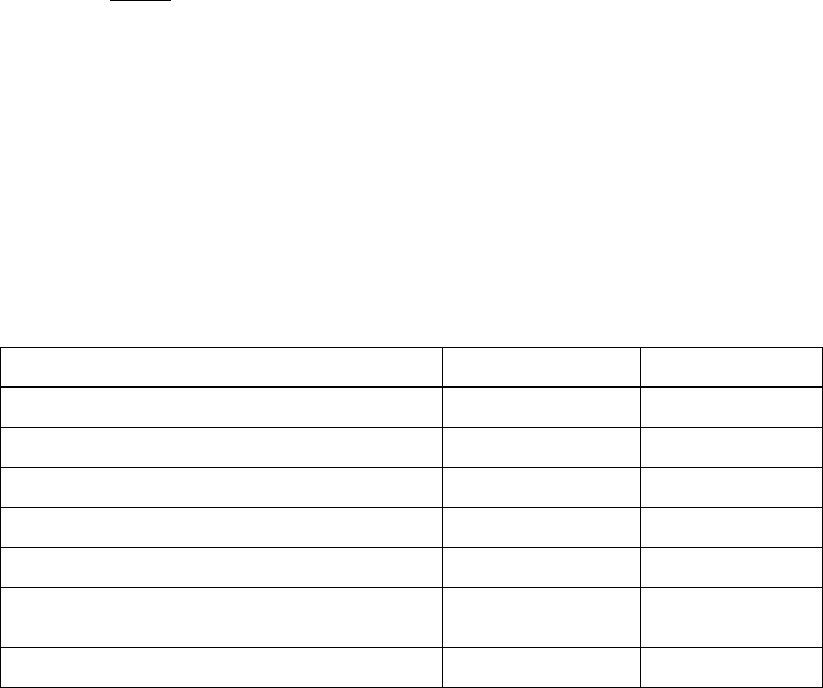
SYSTEM DESCRIPTION, INSTALLATION, AND MAINTENANCE MANUAL
eNfusion® HSD-440 Mark 2 Terminal
23-15-30 3-6
3 JUN 10
The HSD-440 Mark 2 Terminal maintenance port is available at the front of the
HSD-440 Mark 2 Terminal and at the rear ARINC 600 connector. Connection on the
front of the HSD-440 Mark 2 Terminal is accessible via a DB25S connector for local
maintenance of the terminal. Remote access is provided for cases where local access
is unavailable. For remote access, install an accessible DB9S connector in the cabin
area.
NOTE: The front panel and remote connections to the maintenance port cannot
operate simultaneously.
Refer to "Test and Fault Isolation" on page 4-35 for information on how to connect
and use the maintenance port, including equipment requirements, connection and
cabling requirements, software loading instructions, and configuration details.
(3) Antenna Subsystem RF Interface
Several external RF parameters (such as cable losses and antenna gain) that must
be delimited to ensure proper operation dictate the HSD-440 Mark 2 Terminal
performance requirements.
Table 3-2 defines the RF parameters and their expected values.
Table 3-2 RF Parameters Definitions
Parameter Min. Value (dB) Max. Value (dB)
Antenna Gain 12 17
Antenna to DLNA Loss 0.3
DLNA Gain 53 60
DLNA Noise Figure 1.8
DLNA to HSD-440 Mark 2 Terminal (Rx) Loss 625
HSD-440 Mark 2 Terminal to Antenna (Tx) Loss 05 (including DLNA
loss)
DLNA Insertion Loss (Tx to Antenna Port) –0.8
(4) WOW Pins
The WOW1 and WOW2 pins are either left open circuit or connected to the airframe
DC ground through a ground proximity switch. The WOW Program Select (PGM) pin
is either left open circuit or connected to the Forward Address Common. The two
ground states for any pin are open and closed circuit.
Resolve any conflict between WOW1 and WOW2 by assuming the aircraft is in-air.
The interpretation of the state of the WOW1 and WOW2 pins is defined by the state
of the WOW program select pin. Refer to Table 3-3 for details.
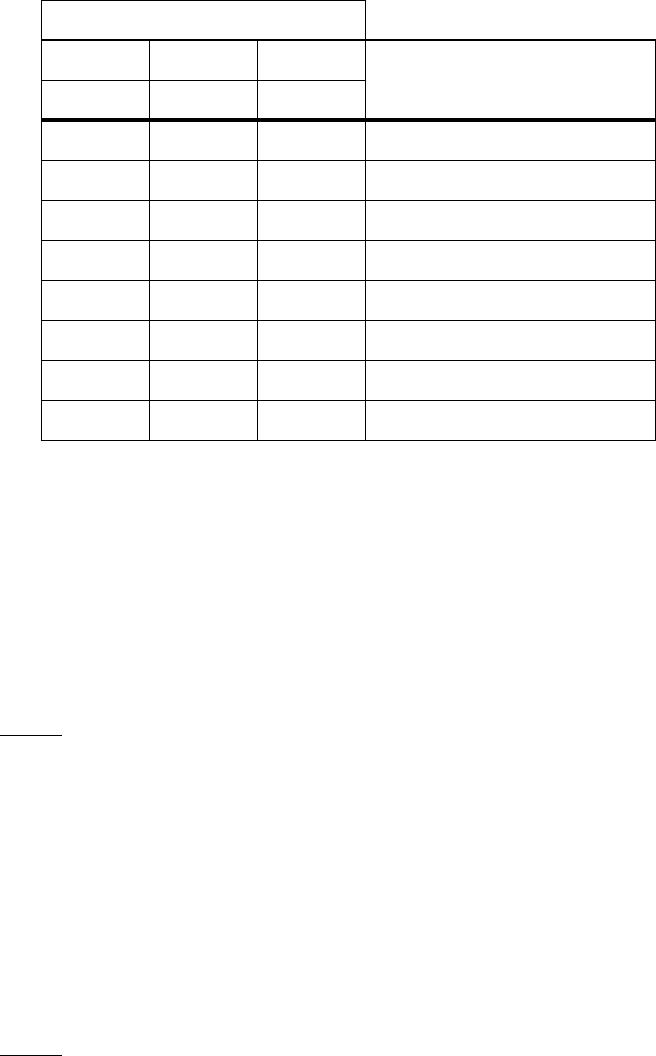
Table 3-3 WOW Pin Wiring
Pin Name and Location
WOW1 WOW2 PGM Aircraft Status
TP3G TP3K TP3J
CLOSED CLOSED CLOSED In-air
OPEN CLOSED CLOSED Not valid—Default in-air
CLOSED OPEN CLOSED Not valid—Default in-air
OPEN OPEN CLOSED On-ground
CLOSED CLOSED OPEN On-ground
OPEN CLOSED OPEN Not valid—Default in-air
CLOSED OPEN OPEN Not valid—Default in-air
OPEN OPEN OPEN In-air
SYSTEM DESCRIPTION, INSTALLATION, AND MAINTENANCE MANUAL
eNfusion® HSD-440 Mark 2 Terminal
23-15-30 3-7
3 JUN 10
WOW discretes indicate when an aircraft is on the ground and are used for flight
data-logging purposes. Since data that the aircraft is airborne is supplied to the
HSD-440 Mark 2 Terminal by other equipment, this information from the discretes is
not required. WOW is only used to determine aircraft on-ground status, if the Inertial
Reference System (IRS) has no valid data, and the CMC is not installed, or if the
CMC is not providing valid data.
The function of WOW can inhibit RF transmission when the aircraft is on the ground.
This function is disabled by default and must be enabled through the ORT parameter
TRANSMIT ON GROUND—see "Configuring Transmit on Ground" on page 6-27.
NOTE: If the WOW function is disabled, do not perform normal maintenance when
the system is active to avoid RF exposure. Follow normal safety procedures
and disable the system before performing antenna maintenance.
(5) ICAO IDs
TheHSD-440 Mark 2 Terminal requires an ICAO ID to operate and access classic
services. The HSD-440 Mark 2 Terminal receives the ICAO ID either from discrete
strapping or from an ARINC 429 source as determined by the ICAO CODE SOURCE
ORT parameter—see "Configuring the ICAO Code Source" on page 6-15.
Figure 3-2 provides an example of a strapped ICAO ID address. This number (for
example: Decimal 11256099, Hex ABC123, or Octal 52740443) must be converted
into a binary number for strapping.
NOTE: MSB is the Most Significant Bit and LSB is the Least Significant Bit.
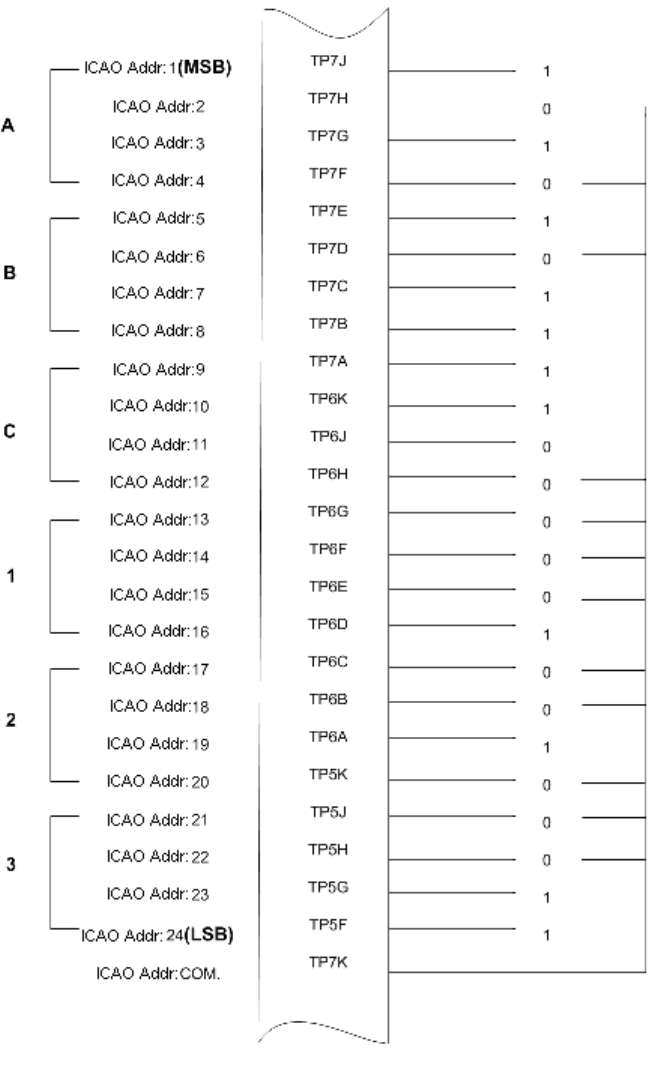
SYSTEM DESCRIPTION, INSTALLATION, AND MAINTENANCE MANUAL
eNfusion® HSD-440 Mark 2 Terminal
23-15-30 3-8
3 JUN 10
Figure 3-2 ICAO ID, Hex to Binary Conversion
A pin strapped to the same potential as TP7K is considered a logical 0, whereas an
open circuit pin is considered a logical 1.
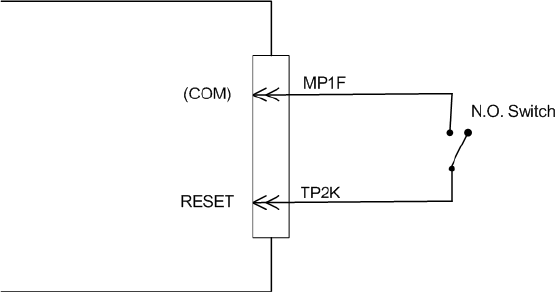
SYSTEM DESCRIPTION, INSTALLATION, AND MAINTENANCE MANUAL
eNfusion® HSD-440 Mark 2 Terminal
23-15-30 3-9
3 JUN 10
(6) Remote Status Panel (Optional)
An optional remote status panel may be installed when HSD-440 Mark 2 Terminals
are located in inaccessible or remote locations. The installation of a remote status
panel is recommended as it provides visual indications of the power and faults for
each terminal.
A remote reset switch for HSD-440 Mark 2 Terminals can also be installed and
located with the remote status panel. Figure 3-3 illustrates a typical wiring diagram
for the remote reset circuit.
(a) Remote Reset Circuit Switch Requirements
HSD-440 Mark 2 Terminals support the installation of a Remote Reset Switch
circuit as shown in Figure 3-3.
The HSD-440 Mark 2 Terminal Remote Reset circuit requires less than 100 ohms
between TP1K (RESET) and MP1F(COM) to be asserted and greater than 10
kilohms to be de-asserted (includes all cable and switch contact resistance).
Figure 3-3 Remote Reset Circuit Switch
(b) Remote LED Driver Circuit Requirements
The circuit requirements for the HSD-440 Mark 2 Terminal Remote Status LED
drivers are shown in Figure 3-4. Each LED driver circuit provides an open-drain
Field-Effect Transistor (FET) interface that has a maximum continuous
drain-to-source voltage of 35 V dc and drain-to-source current of 0.5 A dc. These
circuits are designed to sink current to ground only. Any external lamps or LEDs
connected to these driver circuits require the appropriate external voltage and
series impedance to be connected.
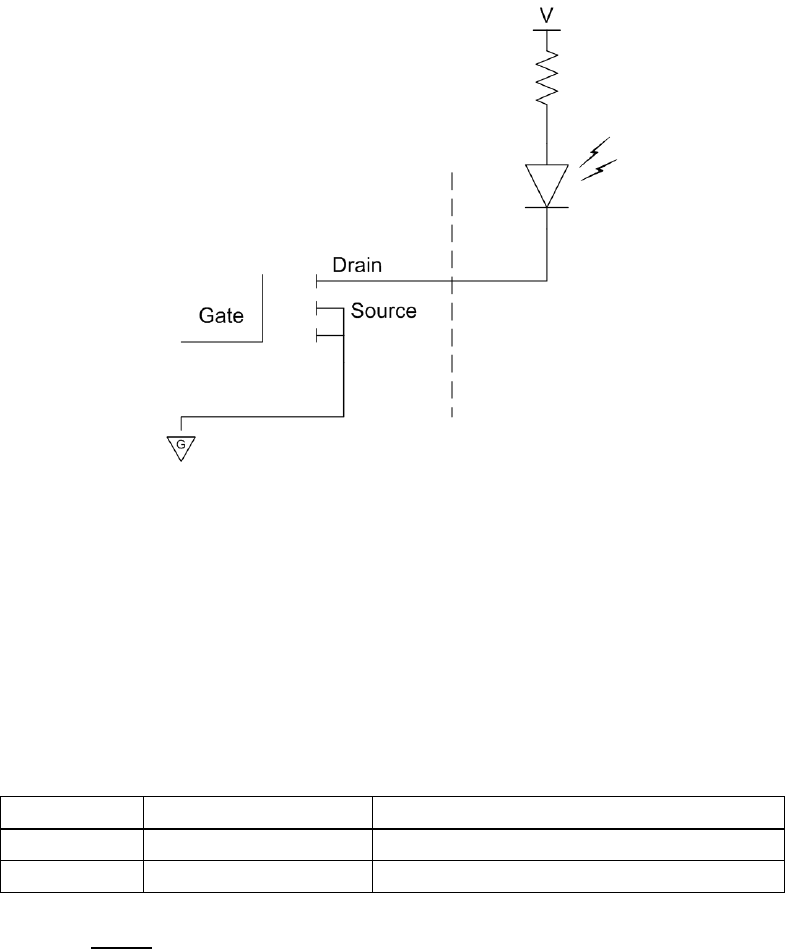
SYSTEM DESCRIPTION, INSTALLATION, AND MAINTENANCE MANUAL
eNfusion® HSD-440 Mark 2 Terminal
23-15-30 3-10
3 JUN 10
Figure 3-4 Remote LED Panel Circuit
(7) System Configuration Strapping
The HSD-440 Mark 2 Terminal adjusts its configuration according to the status of
several strap pins on the rear ARINC 600 connector.
Configuration pins are assigned based on system mode configuration selection and
data I/O requirements, as shown in Table 3-4. Detailed pin assignment is shown in
Table 3-5.
Table 3-4 Configuration Pin Summary
Pin Number Name Function
TP4A to D System Config 1 to 4 System Mode Strap Pins
MP5G to K I/O config 1 to 4 Not assigned (set to 1)
NOTE: The logic for the System Configuration pins is reverse to the logic explained
in ARINC 741 Characteristic Attachment 1-4, Note 19.
• Pins marked 0 are signaled by strapping to Address Common (TP7K).
• Pins marked 1 are signaled by an open circuit-no connection.
• Configurations resulting in all ones (1) are invalid.
(8) System Mode Strap Pins Coding
The HSD-440 Mark 2 Terminal must be externally strapped according to its intended
operational configuration mode. Table 3-5 illustrates the system pin strapping for
currently supported HSD-440 Mark 2 Terminal operational modes and
configurations.
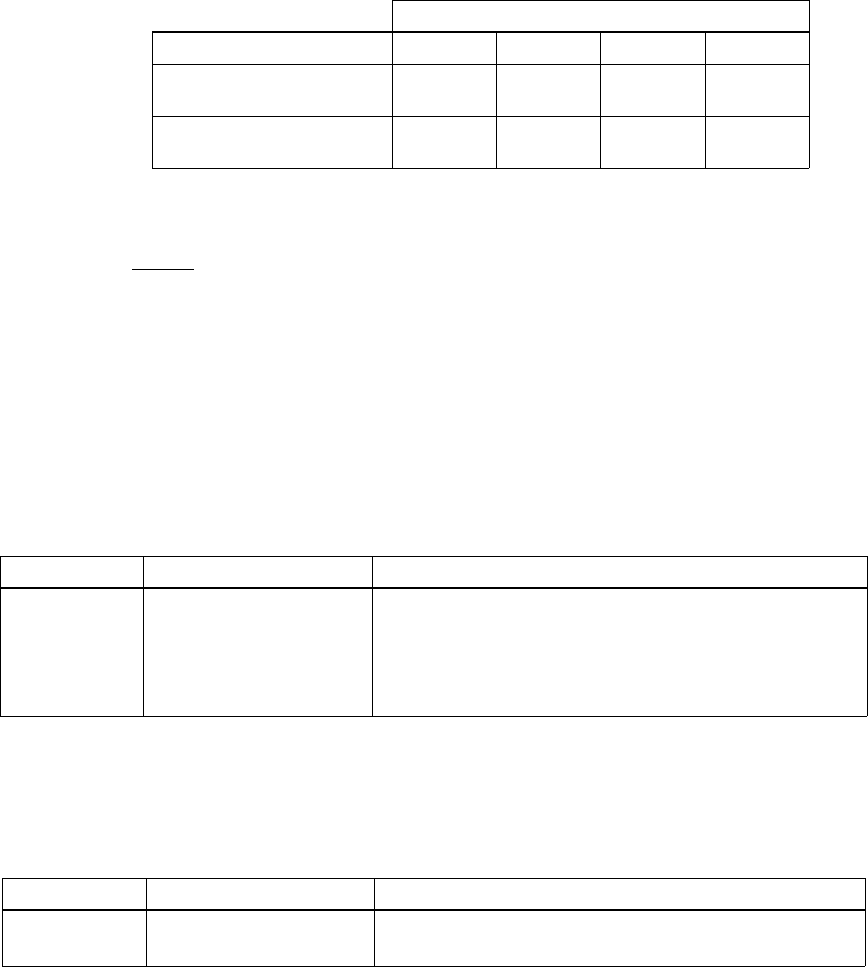
Table 3-5 System Pin Strapping
Pin Status
System Mode TP4A TP4B TP4C TP4D
Valid - provides Aero H+
services only 0 1 0 0
Valid - provides Aero H+
and Swift services 0 1 0 1
SYSTEM DESCRIPTION, INSTALLATION, AND MAINTENANCE MANUAL
eNfusion® HSD-440 Mark 2 Terminal
23-15-30 3-11
3 JUN 10
All other combinations are invalid and could cause an operating failure.
NOTE: The logic for the System Configuration pins is reverse to the logic explained
in ARINC 741 Characteristic Attachment 1-4, Note 19.
• Pins marked 0 are signaled by strapping to Address Common (TP7K).
• Pins marked 1 are signaled by an open circuit—no connection.
• Configurations resulting in all ones (1) are invalid.
(9) Call Light Activation Strapping
Table 3-6 shows the configuration strapping for call light activation.
Table 3-6 Call Light Activation Configuration Strapping
Pin Number Name Function
TP4E Call Light Activation Determines whether the call light illuminates on call
activation or initialization. Activation occurs when the
GES is responding to the call request, and initialization
occurs the moment the call is placed. (1=Activation;
0=Initialization)
(10)Hookswitch Strapping
Table 3-7 shows the configuration strapping for the hookswitch method.
Table 3-7 Hookswitch Configuration Strapping
Pin Number Name Function
TP2G Hookswitch Method Determines Push To Talk (PTT) or Latched Mode
(0=Latched; 1=PTT)
(11)Priority 4 Call Strapping
Table 3-8 shows the configuration strapping for priority 4 calls.
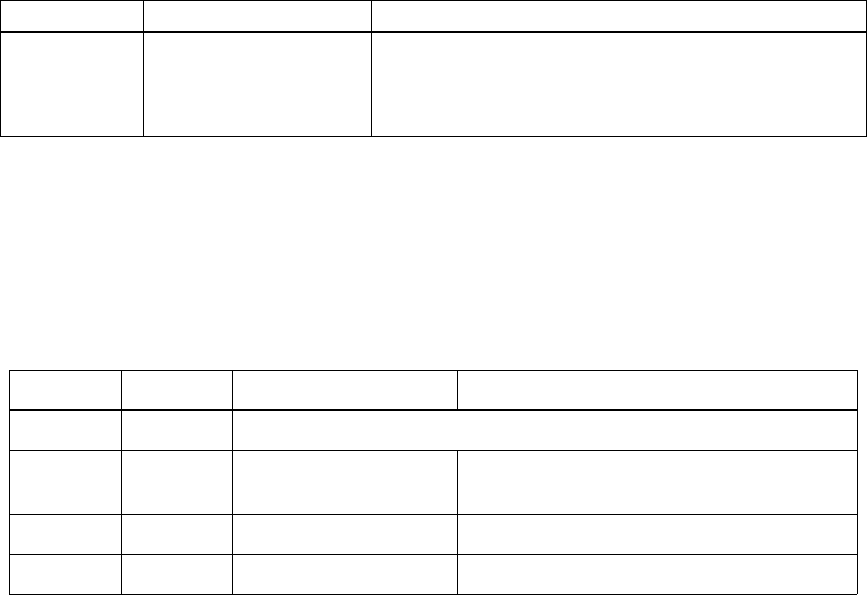
Table 3-8 Priority 4 Call Configuration Strapping
Pin Number Name Function
TP4F Inhibit Priority 4 Calls Determines whether priority 4 calls are inhibited to and
from the cockpit. When these calls are inhibited,
incoming calls are not allowed, and outgoing priority 4
calls are rejected. (1=Uninhibited; 0=Inhibited)
SYSTEM DESCRIPTION, INSTALLATION, AND MAINTENANCE MANUAL
eNfusion® HSD-440 Mark 2 Terminal
23-15-30 3-12
3 JUN 10
(12)Cockpit Voice Strapping
The HSD-440 Mark 2 Terminal announces incoming calls with chimes and lights or
the Call Control (CD) discretes, as determined by the Cockpit Call Signaling Mode
ORT parameter. If set to Light/Chime, the strapping for this function is shown in
Table 3-9.
Table 3-9 Chime and Light Strapping for Cockpit Voice
TP4G TP4H Lights Chime
Strapped Strapped Spare
Strapped Open Steady Multi-stroke (chime sounds every 0.5 to 1
second)
Open Strapped Flashing Single-stroke (chime sounds once)
Open Open Steady Single-stroke
(13)User Interfaces
To facilitate access to the HSD-440 Mark 2 Terminal interfaces, install the following
connectors in the appropriate cabin area.
(a) ISDN Interface
Install an RJ45 connector in the cabin area for user connections to the ISDN
interface.
(b) Ethernet Data Interface
Install one or two RJ45 interface connectors in the cabin area for user access to
the Ethernet interfaces.
(c) RJ45 Connector Termination Details
Details relating to the RJ45 cable terminations required for both the ISDN and/or
10BASE-T services are shown in Figure 3-5 and Table 3-10.
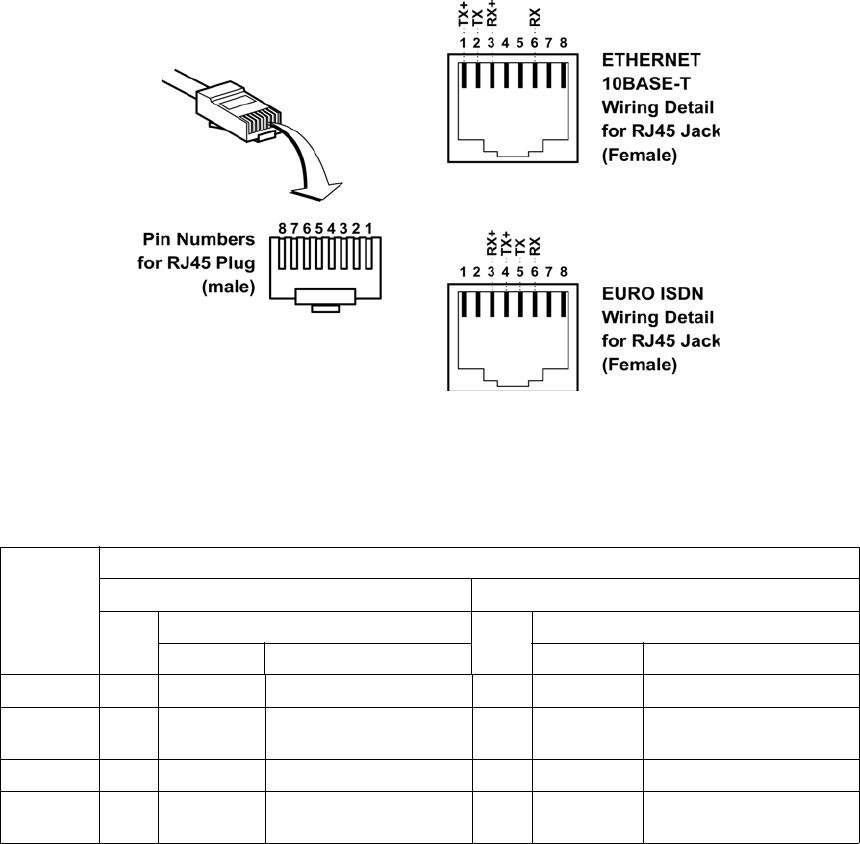
SYSTEM DESCRIPTION, INSTALLATION, AND MAINTENANCE MANUAL
eNfusion® HSD-440 Mark 2 Terminal
23-15-30 3-13
3 JUN 10
Figure 3-5 RJ45 Connector Terminator Details
Table 3-10 RJ45 Wiring Details
SIGNAL
Service
EURO ISDN ETHERNET 10BASE-T
PIN CABLE PIN CABLE
ECS OTHER ECS OTHER
RX+ 3White White/green 3White White/orange stripe
RX- 6Blue Green 6Green Orange/white stripe or
solid orange
TX+ 4White Blue 1White White/green stripe
TX- 5Orange White/blue 2Brown Green/white stripe or
solid Green
Use LAN cables that meet flammability and TIA/EIA568-A CAT-5 requirements.
Cables #922404 (4 conductor) and # 922408 (8 conductor), as supplied by
Electronics Cable Specialists, are acceptable. Equivalent substitutions from
other manufacturers may be used.
(14)System Interfaces
(a) ARINC 429 IRS Bus Interface
Navigational information is provided to the HSD-440 Mark 2 Terminal through
the high-speed ARINC 429 IRS bus interface. Refer to "System Description" on
page 1-1 for more information. The IRS bus connects through the top plug of the
ARINC 600 connector to the HSD-440 Mark 2 Terminal as follows:

SYSTEM DESCRIPTION, INSTALLATION, AND MAINTENANCE MANUAL
eNfusion® HSD-440 Mark 2 Terminal
23-15-30 3-14
3 JUN 10
• IRS#1 A TP4J
• IRS#1 B TP4K
• IRS#2 A TP5C*
• IRS#2 B TP5E*
You can configure IRS#2 as a secondary IRS bus, or an input bus for the
AES ID.
(b) Antenna Interface
The ARINC 741 antenna subsystem BSU is connected to the HSD-440 Mark 2
Terminal as specified in Table 3-11.
Table 3-11 HSD-440 Mark 2 Terminal to BSU Interconnects
Signal Name
Signal Source Signal
Destination
HSD-440 Mark
2 Terminal Mechanical
HGAPhased-Array or
Conformal HGA
HPA MUTE A Top/Port BSU-G TP3A
STBD BSU-G TP3C
HPA MUTE B Top/Port BSU-H TP3B
STBD BSU-H TP3D
BSU BITE A BSU-W(G)* Port BSU-W TP2A
STBD BSU-W TP2C
BSU BITE B BSU-X(H) Port BSU-X TP2B
STBD BSU-X TP2D
Multi-Control A TP3E BSU-T(A)
Multi-Control B TP3F BSU-U(B)
*Letters in (brackets) represent EMS Aviation AMT-50 BSU pin designations
Top/Port (T/P): Refers to Mechanical (fin-mount) HGA Subsystem
Port: Refers to Phased Array (Fuselage-mount) or Port side of Dual (side)
Conformal-mount, HGA subsystem
Starboard (STBD): Refers to starboard side of Dual (side) Conformal-mount HGA subsystem
NOTE: If a third MCDU is installed, the HSD-440 cannot use the side mount
antennas because the input is allocated to either the third MCDU or the
starboard BSU Bite.
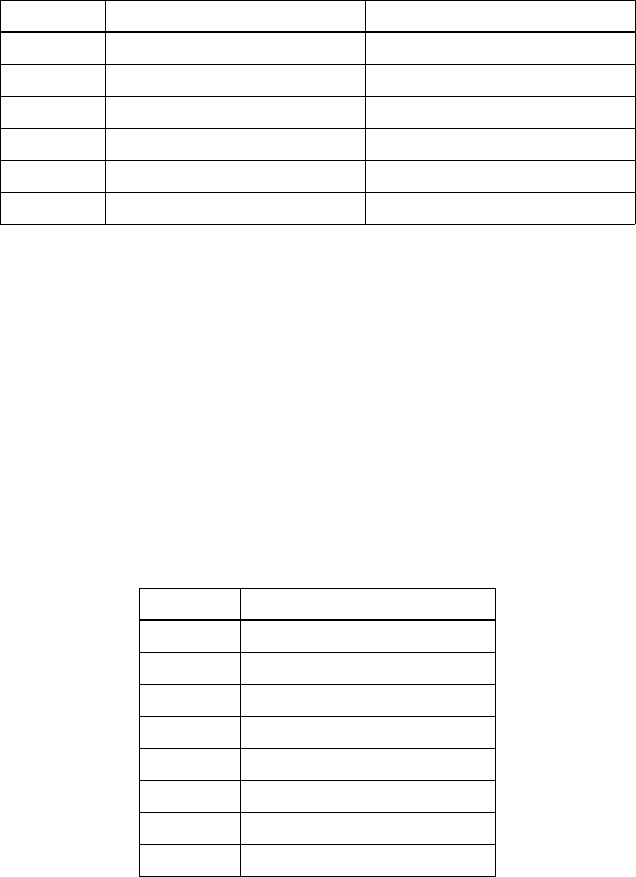
SYSTEM DESCRIPTION, INSTALLATION, AND MAINTENANCE MANUAL
eNfusion® HSD-440 Mark 2 Terminal
23-15-30 3-15
3 JUN 10
(c) CMU Interface
Data rates, voltage thresholds, and electrical interface specifications are per
ARINC Specification 429. (741 p2-7 p4.7.2). The ARINC 600 wiring
interconnections for the HSD-440 Mark 2 Terminal and each CMU are shown in
Table 3-12.
Table 3-12 CMU Strapping
Pin Name To
TP1A CMU 1 Input A CMU 1 TP1A
TP1B CMU 1 Input B CMU 1 TP1B
TP1C CMU 1/2 Output A CMU 1/2 MP2C
TP1D CMU 1/2 Output B CMU 1/2 MP2D
MP1K CMU 2 Input A CMU 2 TP1A
MP2K CMU 2 Input B CMU 2 TP1B
You can set the bus speed either low or high. Both the transmit and receive ports
of the HSD-440 Mark 2 Terminal ARINC 429 CMU ports operate together at
either low speed or high speed. Both CMUs therefore work at either low speed
or high speed, but not at different speeds. You can select the speed by setting
a flag in the ORT parameter CMU INPUT SPEED SELECT and CMU OUTPUT
SPEED SELECT instead of setting a program pin on the HSD-440 Mark 2
Terminal A600 connector (there are no pins available). If information is not
available from the ORT, the bus speed default is low.
(d) MCDU Interface
Table 3-13 shows the strapping for the MCDU.
Table 3-13 MCDU Strapping
Pin Name
TP2C MCDU 3 input A
TP2D MCDU 3 input B
MP3E MCDU 2 input A
MP3F MCDU 2 input B
MP7G MCDU 1 input A
MP7H MCDU 1 input B
MP7J MCDU 1/2/3 output A
MP7K MCDU 1/2/3 output B
C. Connection Details
"Connection Details" on page 3-19 provides all top, middle, and bottom plug connection
details for all installations.

SYSTEM DESCRIPTION, INSTALLATION, AND MAINTENANCE MANUAL
eNfusion® HSD-440 Mark 2 Terminal
23-15-30 3-16
3 JUN 10
5. Passive Intermodulation (PIM) Test
This section describes the passive intermodulation (PIM) test. You must execute the PIM test
after installation, if theHSD-440 Mark 2 Terminal operates in SwiftBroadband mode.
A. Overview
To meet Inmarsat requirements for SBB operation, the HSD-440 Mark 2 Terminal can
test for passive intermodulation effects. The PIM test verifies that the transmit signal from
the HSD-440 Mark 2 Terminal does not degrade or interfere with the receive signals as
a result of PIM.
The HSD-440 Mark 2 Terminal can only perform the PIM test when the aircraft is on the
ground.
When theHSD-440 Mark 2 Terminallogs on to the SBB network, the network assigns the
terminal two channels for PIM testing. These channels are not used by other terminals
so that theHSD-440 Mark 2 Terminalcan transmit the test frequencies without interfering
with other satellite communication equipment or the Inmarsat satellite.
NOTE: You can monitor the progress of the PIM test by turning on report 208 in the
HSD-440 Mark 2 TerminalMPU. When report 208 is not running, the terminal
displays only the results of the test, not the progress.
B. PIM Requirements
In order to successfully perform the PIM test, the aircraft and the satellite communication
system must meet the following requirements:
• The HSD-440 Mark 2 Terminal must have successfully logged on to a satellite that
is visible at the test location within the last 168 hours (8 days).
• The aircraft must not be near any sources of PIM, such as hangars and towers.
• The aircraft must be facing due north in the northern hemisphere, and due south in
the southern hemisphere.
C. PIM Test
To start the PIM test:
1. In theHSD-440 Mark 2 Terminal MPU, navigate to Menu 30.
MENU 30 FIRMWARE Vx.x GND
L list PIMBIT parameters M initiate manual PIMBIT
F fakeout PIMBIT parameters P initiate/stop PIMBIT
<CTRL> N next menu <CTRL> O previous menu = select reports
2. To start the PIM test, press p.
The PIM test starts. The test takes about five minutes.

PIMBIT REPORT: OVERALL STATUS PASS
TEST STARTED: Jan 16 08:15:58 2001 TEST ENDED: Jan 16 08:20:36 2001
ICAO ADDRESS: NOT OBTAINED ANTENNA SERIAL NUMBER: 456
TESTED USING MANUALLY ENTERED FREQUENCIES
TRANSMIT CHANNEL 1 = $1CE8 (1630.000 MHz)
TRANSMIT CHANNEL 2 = $4268 (1654.000 MHz)
RECEIVE CHANNEL = $4B00 (1558.000 MHz)
INTERMOD ORDER = 7.00
LAST INFORMATION RECEIVED (APPROX) 8:00:00 Tue Jan 16, 2001
PARAMETERS UNCHANGED SINCE 8:00:00 Tue Jan 16, 2001
DIRECTION 1: STATUS PASS
GEOGRAPHIC AZ=-11.00 DEG EL=12.50 VEH-REL AZ=-162.50 EL=12.50
SIGNAL DEGRADATION: MEAN 0.14 dB STD DEV 0.03 dB
?[7m!! POSSIBLE INTERFERENCE !!?[0m
SIGNAL BEFORE TEST: -17.19 dBm NOISE BEFORE TEST: -32.71 dBm
SIGNAL AFTER TEST: -17.05 dBm NOISE AFTER TEST: -32.85 dBm
DIRECTION 2: STATUS PASS
GEOGRAPHIC AZ=0.00 DEG EL=18.00 VEH-REL AZ=-151.50 EL=18.00
SIGNAL DEGRADATION: MEAN 0.07 dB STD DEV 0.01 dB
?[7m!! POSSIBLE INTERFERENCE !!?[0m
SIGNAL BEFORE TEST: -16.66 dBm NOISE BEFORE TEST: -32.92 dBm
SIGNAL AFTER TEST: -17.23 dBm NOISE AFTER TEST: -33.05 dBm
DIRECTION 3: STATUS PASS
GEOGRAPHIC AZ=11.00 DEG EL=12.50 VEH-REL AZ=-140.50 EL=12.50
SIGNAL DEGRADATION: MEAN 0.14 dB STD DEV 0.02 dB
?[7m!! POSSIBLE INTERFERENCE !!?[0m
SIGNAL BEFORE TEST: -16.01 dBm NOISE BEFORE TEST: -32.96 dBm
SIGNAL AFTER TEST: -17.21 dBm NOISE AFTER TEST: -32.94 dBm
DIRECTION 4: STATUS PASS
GEOGRAPHIC AZ=-11.00 DEG EL=18.00 VEH-REL AZ=-162.50 EL=18.00
SIGNAL DEGRADATION: MEAN 0.13 dB STD DEV 0.01 dB
?[7m!! POSSIBLE INTERFERENCE !!?[0m
SIGNAL AFTER TEST: -16.04 dBm NOISE AFTER TEST: -32.84 dBm
DIRECTION 5: STATUS PASS
GEOGRAPHIC AZ=0.00 DEG EL=12.50 VEH-REL AZ=-151.50 EL=12.50
SIGNAL DEGRADATION: MEAN 0.12 dB STD DEV 0.01 dB
?[7m!! POSSIBLE INTERFERENCE !!?[0m
SIGNAL BEFORE TEST: -17.00 dBm NOISE BEFORE TEST: -32.73 dBm
DIRECTION 6: STATUS PASS
GEOGRAPHIC AZ=11.00 DEG EL=18.00 VEH-REL AZ=-140.50 EL=18.00
SIGNAL DEGRADATION: MEAN 0.10 dB STD DEV 0.01 dB
?[7m!! POSSIBLE INTERFERENCE !!?[0m
SIGNAL BEFORE TEST: -17.14 dBm NOISE BEFORE TEST: -33.03 dBm
SIGNAL AFTER TEST: -17.87 dBm NOISE AFTER TEST: -33.02 dBm
PIMBIT COMPLETE
SYSTEM DESCRIPTION, INSTALLATION, AND MAINTENANCE MANUAL
eNfusion® HSD-440 Mark 2 Terminal
23-15-30 3-18
3 JUN 10
Figure 3-6 Example PIM Test Results
SYSTEM DESCRIPTION, INSTALLATION, AND MAINTENANCE MANUAL
eNfusion® HSD-440 Mark 2 Terminal
23-15-30 3-19
3 JUN 10
The first line of the PIMBIT report displays the overall PIM status. If the overall status
is PASS, the HSD-440 can continue to use SBB services.
If the overall status is FAIL:
• Check the cable connections of the antenna and the HSD-440 Mark 2 Terminal.
• Check the direction in which the test failed and verify that the antenna is not
blocked in that direction—see "Directional PIM Test Results" on page 3-19.
(2) Directional PIM Test Results
The HSD-440 Mark 2 Terminal performs the PIM test with the antenna pointing in
different directions and displays the results of the test in each direction. If the overall
status of the PIM test is FAIL, you can check the specific directions in which the test
failed.
For each direction, the PIM test results provide:
• Overall Status—pass or fail.
• The direction coordinates.
• The signal degradation—the maximum value to pass the test is 3 dB.
• Possible interference—interference caused by environmental factors, not the
HSD-440 Mark 2 Terminal transmit frequencies. Interference indicates that the
HSD-440 Mark 2 Terminal received a signal in the receive band even when it
wasn’t transmitting, therefore an external signal may be interfering with
communication in that direction.
• Signal and noise levels before and after the test—the HSD-440 Mark 2 Terminal
uses this information to check for possible interference.
6. Installation and Engineering Diagrams
This section contains the Outline and Installation diagrams, and Interconnection and Contact
Assignment drawings for HSD-440 Mark 2 Terminals.
All foldout pages are odd-numbered and not-backed for print production purposes.
A. Outline and Installation Diagrams
Figure 3-7 and Figure 3-8 illustrate the physical characteristics of the HSD-440 Mark 2
Terminal and provides installation data for the terminal.
B. Interconnection and Contact Assignment Drawings
Figure 3-9 and Figure 3-10 show the Interconnection details for the HSD-440 Mark 2
Terminals.
7. Connection Details
Table 3-14, Table 3-15, and Table 3-16 show the top, middle, and bottom plug connection
details for HSD-440 Stand-Alone terminals.

SYSTEM DESCRIPTION, INSTALLATION, AND MAINTENANCE MANUAL
eNfusion® HSD-440 Mark 2 Terminal
23-15-30 3-20
3 JUN 10
Table 3-14 HSD-440 Stand-Alone Terminal Top Plug Connection Details
I/O From
Top
Plug Signal Name To Description
I1A CMU 1 Input A CMU 1 TP1A CMU 1 RX A
I1B CMU 1 Input B CMU 1 TP1B CMU 1 RX B
O1C CMU 1/2 Output A CMU 1/2 MP2C CMU 1/2 TX A
O1D CMU 1/2 Output B CMU 1/2 MP2D CMU 1/2 TX B
I1E ARINC 615 Input A
ARINC 615 Data Loader
I1F ARINC 615 Input B
O1G ARINC 615 Output A
O1H ARINC 615 Output B
I1J ARINC 615 Link A
O1K ARINC 615 Link B
(GND)
I2A BSU Top/Port BITE A
Mech. Steered Antenna
(MA): BSU, Pin G or W or
Other Antenna (OA): BSU,
PORT-W and starboard-P
ARINC Tx-HI BITE from
BSU
I2B BSU Top/Port BITE B MA: BSU, Pin H or X, or OA:
BSU, PORT-X and STBD-R ARINC Tx-LO BITE
from BSU
I2C BSU Starboard (STBD)
BITE A or MCDU 3 Input
A
MA: Not required
OA: BSU, PORT-P and
STBD-W
ARINC Tx-HI BITE from
BSU
I2D BSU STBD BITE B
or MCDU 3 Input B
MA: Not required
OA: BSU, PORT-R and
STBD-X
ARINC Tx-LO BITE
from BSU
O2E Spare 1 ARINC 429
Output A
O2F Spare 1 ARINC 429
Output B
2G Hookswitch method
I2H Spare 2 ARINC 429
Input A
I2J Spare 2 ARINC 429
Input B
I2K Remote Reset Normally open momentary
switch-open side.
(Closed side to MP1F) Remote System Reset

SYSTEM DESCRIPTION, INSTALLATION, AND MAINTENANCE MANUAL
eNfusion® HSD-440 Mark 2 Terminal
23-15-30 3-21
3 JUN 10
I3A Top/Port HPA MUTE A MA: Not required
OA: BSU, PORT-G HPA Mute-A, Port BSU
I3B Top/Port HPA MUTE B MA: Not required
OA: BSU, PORT-H HPA Mute-B, Port BSU
I3C STBD HPA MUTE A MA: Not required
OA: BSU, STBD G HPA Mute-A, STBD
BSU
I3D STBD HPA MUTE B MA: Not required
OA: BSU, STBD-H HPA Mute-B, STBD
BSU
O3E Multi-Control A MA: BSU, Pin A or T, or OA:
BSU, PORT-T and STBD-T
Multi-Control-HI to
HSD-440 Mark 2
Terminal and antenna
subsystem
O3F Multi-Control B MA: BSU, Pin B or U, or OA:
BSU, PORT-U and STBD-U
Multi-Control-LO to
HSD-440 Mark 2
Terminal and antenna
subsystem
I3H Tx Disable
I3G WOW 1 TP3G Weight On Wheel, as
defined in Note 40 of
ARINC 741, Part 1.
Refer to "WOW Pins" on
page 3-6
I3K WOW 2 TP3K
I3J WOW Program Select TP3J
I4A–4D System Config 1 to 4
4A and 4C=0 (TP7K
common), 4B,
4D=1(open) for standalone
mode
and
Wire 4A 4C, 4D =0 (TP7K
common), 4B =1 (open) for
Aero only operation
I4E Call light activation
Open for Call light On at
Call Connection
Closed for Call Light on
at Call Initiation
I4F Priority 4 Calls
Open Allow Priority 4
calls to and from
Cockpit
Closed Inhibit Priority 4
calls to and from
Cockpit
Table 3-14 HSD-440 Stand-Alone Terminal Top Plug Connection Details (Continued)
I/O From
Top
Plug Signal Name To Description

SYSTEM DESCRIPTION, INSTALLATION, AND MAINTENANCE MANUAL
eNfusion® HSD-440 Mark 2 Terminal
23-15-30 3-22
3 JUN 10
I4G Chime/light option MS
G=0(strapped),
4H=1(open) Steady
lamp, multi-stroke
chime
4G=1(open),
4H=0(strapped)
Flashing lamp, single
stroke chime
4G=1(open),
4H=1(open) Steady
lamp, single-stroke
chime
I4H Chime/light option LS
I4J IRS 1A Aircraft main IRS IRS 429 data, Rx HI
I4K IRS 1B Aircraft main IRS IRS 429 data, Rx LO
I5A SDI 1 Not connected HPA Select Code for
HGA
I5B SDI 2 SDI common (TP5D) HPA Select Code for
HGA
I5C Spare 1 ARINC 429
Input A
I5D SDI Common 5C IRS #2 Input A
5E IRS #2 Input B SDI Common for HPA
select codes
I5E Spare 1 ARINC 429
Input B
I5F–7J ICAO Address,
BITS 24 to 1
1 = no connection
0 = common (TP7K)
I7K ICAO Address,
Common
Common GND
connection for system
and I/O configuration
and ICAO ID
Table 3-14 HSD-440 Stand-Alone Terminal Top Plug Connection Details (Continued)
I/O From
Top
Plug Signal Name To Description

SYSTEM DESCRIPTION, INSTALLATION, AND MAINTENANCE MANUAL
eNfusion® HSD-440 Mark 2 Terminal
23-15-30 3-23
3 JUN 10
Table 3-15 HSD-440 Stand-Alone Terminal Middle Plug Connection Details
I/O From
Middle
Plug Signal Name To Description
O1A Discrete output 1 Remote status panel HSD-440 Mark 2
Terminal-Power On
(Optional)
O1B Discrete output 2 Remote status panel HSD-440 Mark 2
Terminal-Fault
(Optional)
1C Spare
1D Switch HI current from
chime
1E 1D 1E outputs to Audio
control panel
O1F Discrete Common Remote status panel Discrete Common
O1G Maint Port Tx Maint Port serial data,
DB9S-2
Maintenance computer
(laptop/PC), for Remote
access
I1H Maint Port Rx Maint Port serial data,
DB9S-3
I/O 1J Maint Port Signal
Ground Maint Port serial data,
DB9S-5
I1K CMU 2 Input A CMU 2 TP1A CMU 2 RX A
O2A Data I/O Tx No connection
I2B Data I/O Rx No connection
O2C SDU data Future
O2D SDU data Future
I2E SCM data Future
I2F SCM data Future
O2G SCM power +12 V Future
O2H SCM power return 0 V Future
2J Data I/O Ground No connection
I2K CMU 2 Input B CMU 2 TP1B CMU 2 RX B
O3A Call light 1 Audio Control Panel
I3B Mic on 1 Audio Management System
I3C Chime light inhibit Audio Control Panel
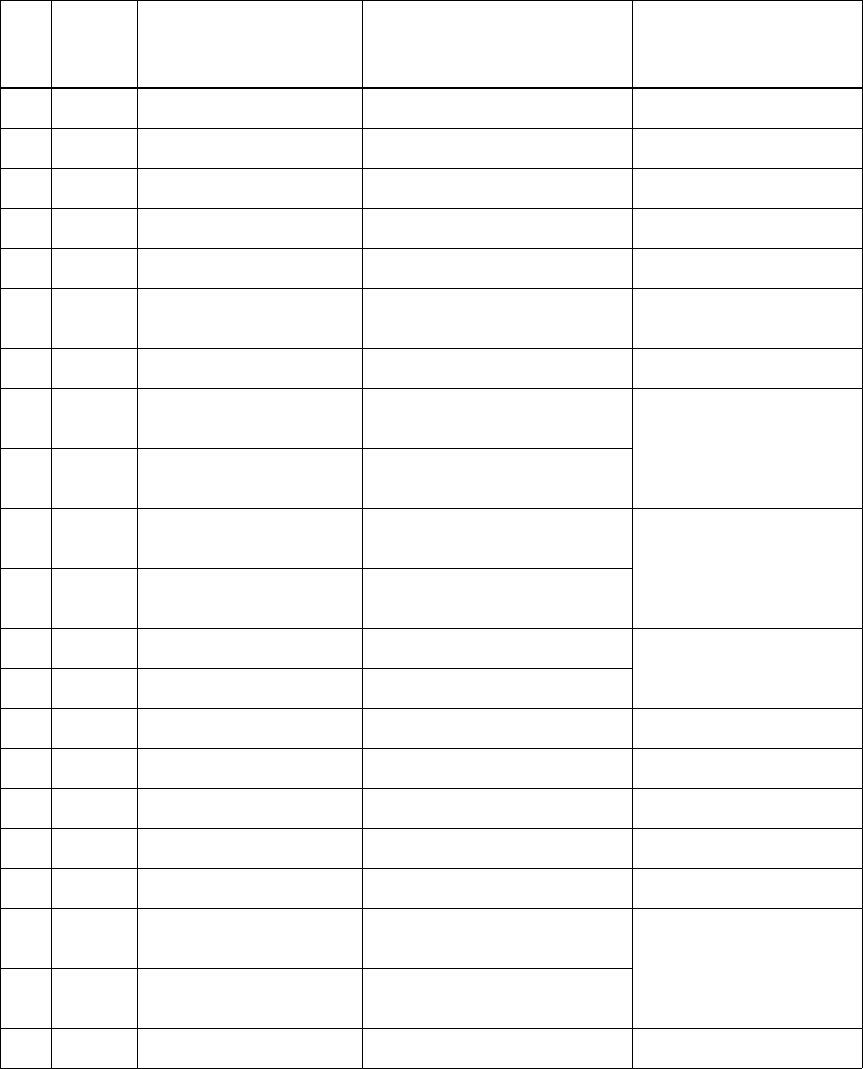
SYSTEM DESCRIPTION, INSTALLATION, AND MAINTENANCE MANUAL
eNfusion® HSD-440 Mark 2 Terminal
23-15-30 3-24
3 JUN 10
I3D Place/end 1 Audio Management System
I3E MCDU 2 input A MCDU 2 J4-27 MCDU 2 RX A
I3F MCDU 2 input B MCDU 2 J4-28 MCDU 2 RX B
O3G Call light 2 Audio Control Panel
I3H Mic on 2 Audio Management System
I3J Go-ahead / Chime
reset Audio Control Panel
I3K Place/End 2 Audio Management System
I/O 4A POTS 1 TIP 2-wire Analog Phone TIP
(RJ-11, Pin 3) POTS Line 1
I/O 4B POTS 1 RING 2-wire Analog Phone RING
(RJ-11, Pin 2)
I/O 4C POTS 2 TIP 2-wire Analog Phone TIP
(RJ-11, Pin 3) POTS Line 2
I/O 4D POTS 2 RING 2-wire Analog Phone RING
(RJ-11, Pin 2)
I4E Input Audio 1 HI cockpit headset 1 cockpit headset 1
I4F Input Audio 1 LO cockpit headset 1
I/O 4G–4K Reserved
I5A CEPT-E1 Rx+ CTU Satcom1 E1 TX+ CTU E1 Bus
I5B CEPT-E1 Rx- CTU Satcom1 E1 TX- CTU E1 Bus
O5C CEPT-E1 Tx+ CTU Satcom1 E1 RX+ CTU E1 Bus
O5D CEPT-E1 Tx- CTU Satcom1 E1 RX- CTU E1 Bus
O5E Output Audio 1 HI Cockpit Headset 2
Microphone HI Cockpit Headset 1
Speaker
O5F Output Audio 1 LO Cockpit Headset 2
Microphone LO
I/O 5G–5K Reserved
Table 3-15 HSD-440 Stand-Alone Terminal Middle Plug Connection Details (Continued)
I/O From
Middle
Plug Signal Name To Description
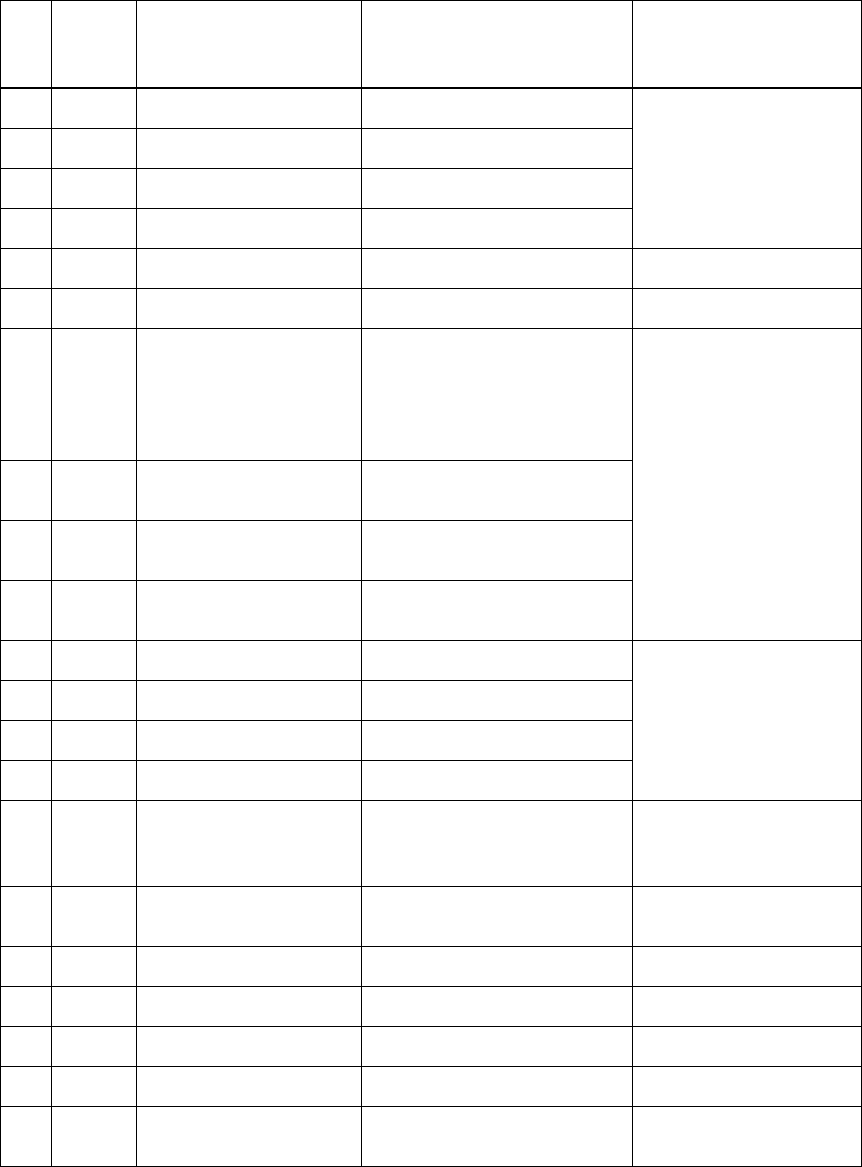
SYSTEM DESCRIPTION, INSTALLATION, AND MAINTENANCE MANUAL
eNfusion® HSD-440 Mark 2 Terminal
23-15-30 3-25
3 JUN 10
I6A ISDN 1 Rx+ ISDN, RJ45-3
User data, ISDN-1
Refer to "User
Interfaces" on page
3-12
I6B ISDN 1 Rx- ISDN, RJ45-6
O6C ISDN 1 Tx+ ISDN, RJ45-4
O6D ISDN 1 Tx- ISDN, RJ45-5
I6E Input Audio 2 HI
I6F Input Audio 2 LO
O6G 10BASE-T Tx+
Cockpit Headset 2
Microphone HI
Cockpit Headset 2
Microphone LO
Cockpit Voice
Microphone 2
O6H 10BASE-T Tx- Ethernet 10BASE-T
RJ45, Pin 2
I6J 10BASE-T Rx+ Ethernet 10BASE-T
RJ45, Pin 3
I6K 10BASE-T Rx- Ethernet 10BASE-T
RJ45, Pin 6
O7A 10BASE-T Tx+ Ethernet 10BASE-T, RJ45-1
Port 1
User data
Ethernet 10BASE-T
O7B 10BASE-T Tx- Ethernet 10BASE-T, RJ45-2
I7C 10BASE-T Rx+ Ethernet 10BASE-T, RJ45-3
I7D 10BASE-T Rx- Ethernet 10BASE-T, RJ45-6
O7E Output Audio 2 HI Cockpit Headset 2 Speaker
HI
O7F Output Audio 2 LO Cockpit Headset 2 Speaker
LO
I7G MCDU 1 Input A
I7H MCDU 1 Input B
O7J MCDU 1/2 Output A
O7K MCDU 1/2 Output B
OC1 RF Tx Output Antenna subsystem-DLNA
or HPR-J Coaxial cable, RF
Transmit
Table 3-15 HSD-440 Stand-Alone Terminal Middle Plug Connection Details (Continued)
I/O From
Middle
Plug Signal Name To Description
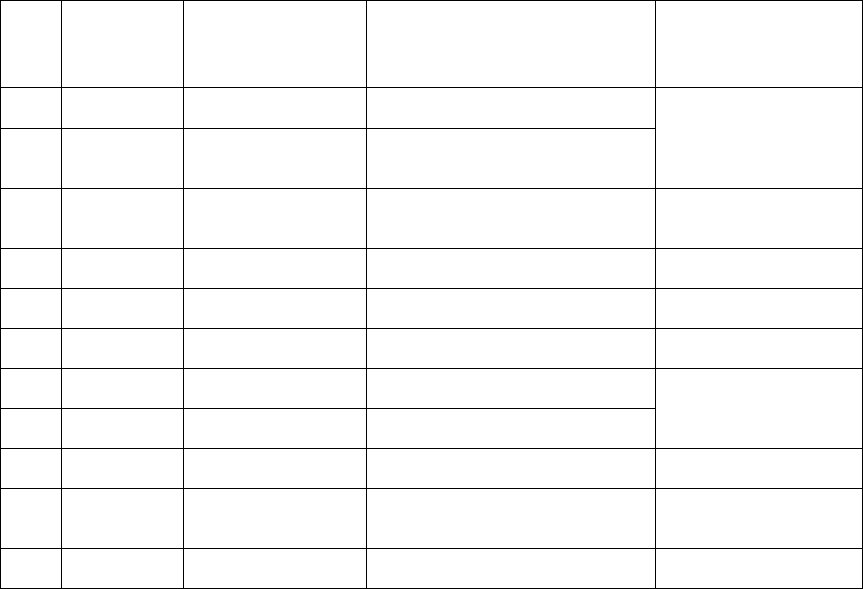
Table 3-16 HSD-440 Stand-Alone Terminal Bottom Plug Connection Details
I/O From
Bottom
Plug Signal Name To Description
IBP2 +28 V dc HOT Aircraft power source, HOT
+28 V dc supply
IBP3 +28 V dc return
GND Aircraft power source, return
IBP8 Chassis GND Aircraft ground Aircraft Chassis
Ground
I/O BP4 Reserved
I/O BP5 Spare
I/O BP6 Reserved
IBP1 115 V ac HOT Aircraft power source, HOT 115 V ac 400 Hz
supply
IBP7 115 V ac COLD Aircraft power source, COLD
I/O BP9–BP11 Spare
IBP12 RF Rx Input Antenna subsystem-DLNA Coaxial cable, RF
Receive
OBP13 Reserved
SYSTEM DESCRIPTION, INSTALLATION, AND MAINTENANCE MANUAL
eNfusion® HSD-440 Mark 2 Terminal
23-15-30 3-26
3 JUN 10
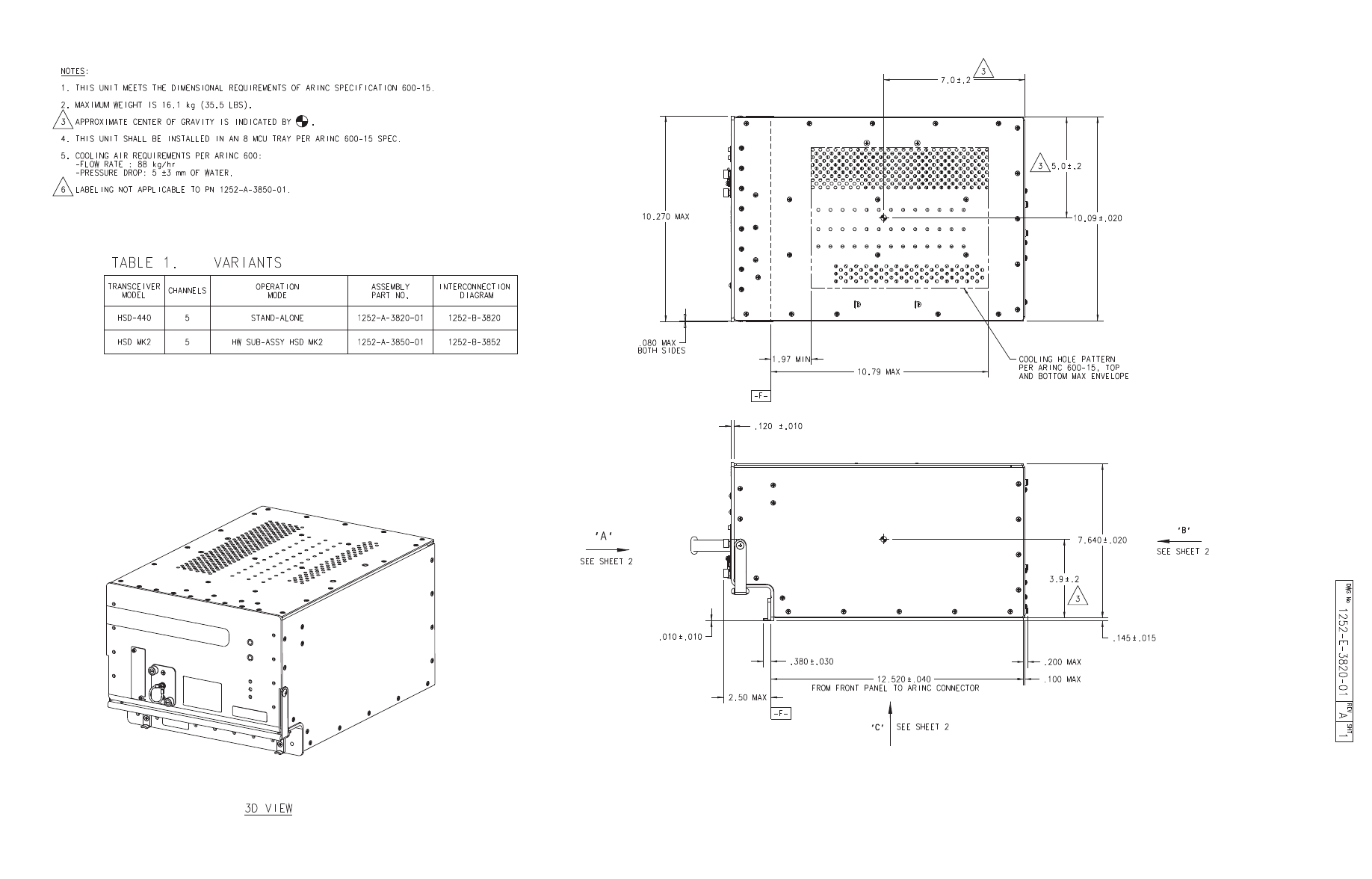
SYSTEM DESCRIPTION, INSTALLATION, AND MAINTENANCE MANUAL
eNfusion® HSD-440 Mark 2 Terminal
23-15-30 3-27
3 JUN 10
Figure 3-7 (Sheet 1). HSD-440 Mark 2 Terminal Outline and Installation Diagram
(1252-E-3820-01, Rev A)
Blank Page
SYSTEM DESCRIPTION, INSTALLATION, AND MAINTENANCE MANUAL
eNfusion® HSD-440 Mark 2 Terminal
23-15-30 3-28
3 JUN 10
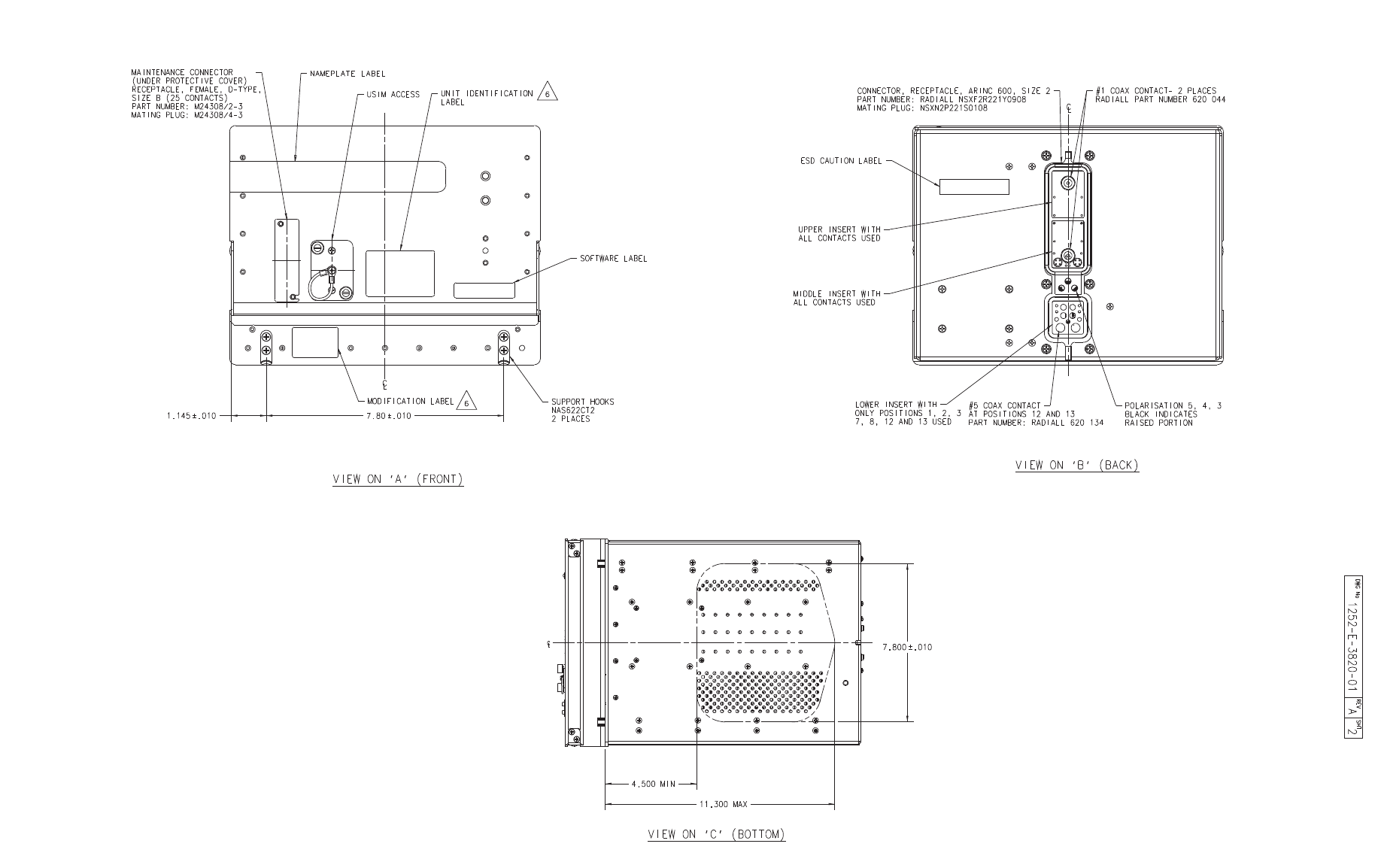
SYSTEM DESCRIPTION, INSTALLATION, AND MAINTENANCE MANUAL
eNfusion® HSD-440 Mark 2 Terminal
23-15-30 3-29
3 JUN 10
Figure 3-8 (Sheet 2). HSD-440 Mark 2 Terminal Outline and Installation Diagram
(1252-E-3820-01, Rev A)
Blank Page
SYSTEM DESCRIPTION, INSTALLATION, AND MAINTENANCE MANUAL
eNfusion® HSD-440 Mark 2 Terminal
23-15-30 3-30
3 JUN 10
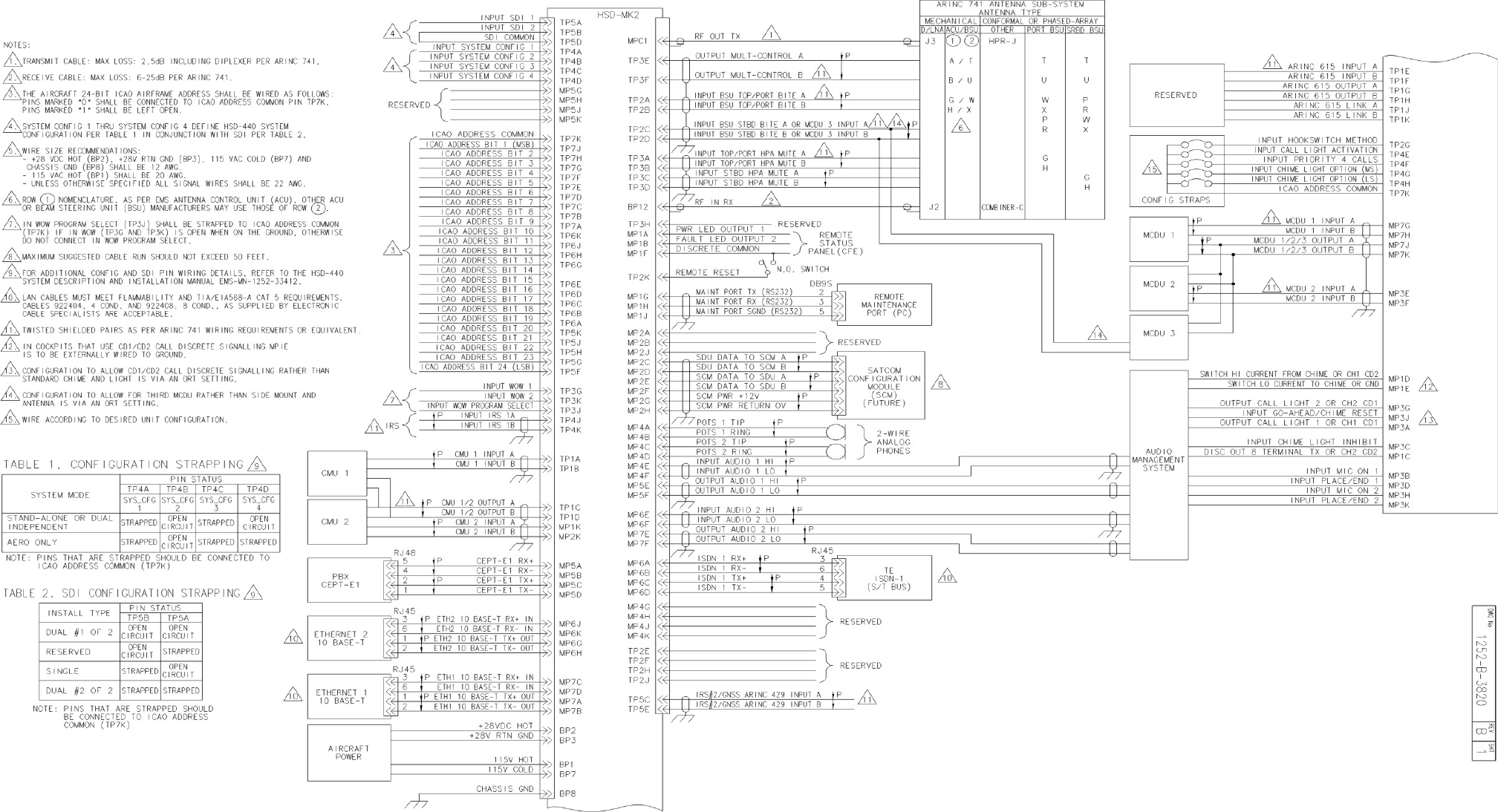
SYSTEM DESCRIPTION, INSTALLATION, AND MAINTENANCE MANUAL
eNfusion® HSD-440 Mark 2 Terminal
23-15-30 3-31
3 JUN 10
Figure 3-9 (Sheet 1). HSD-440 Mark 2 Terminal
System Interconnection Diagram (1252-B-3820, Rev B)
Blank Page
SYSTEM DESCRIPTION, INSTALLATION, AND MAINTENANCE MANUAL
eNfusion® HSD-440 Mark 2 Terminal
23-15-30 3-32
3 JUN 10
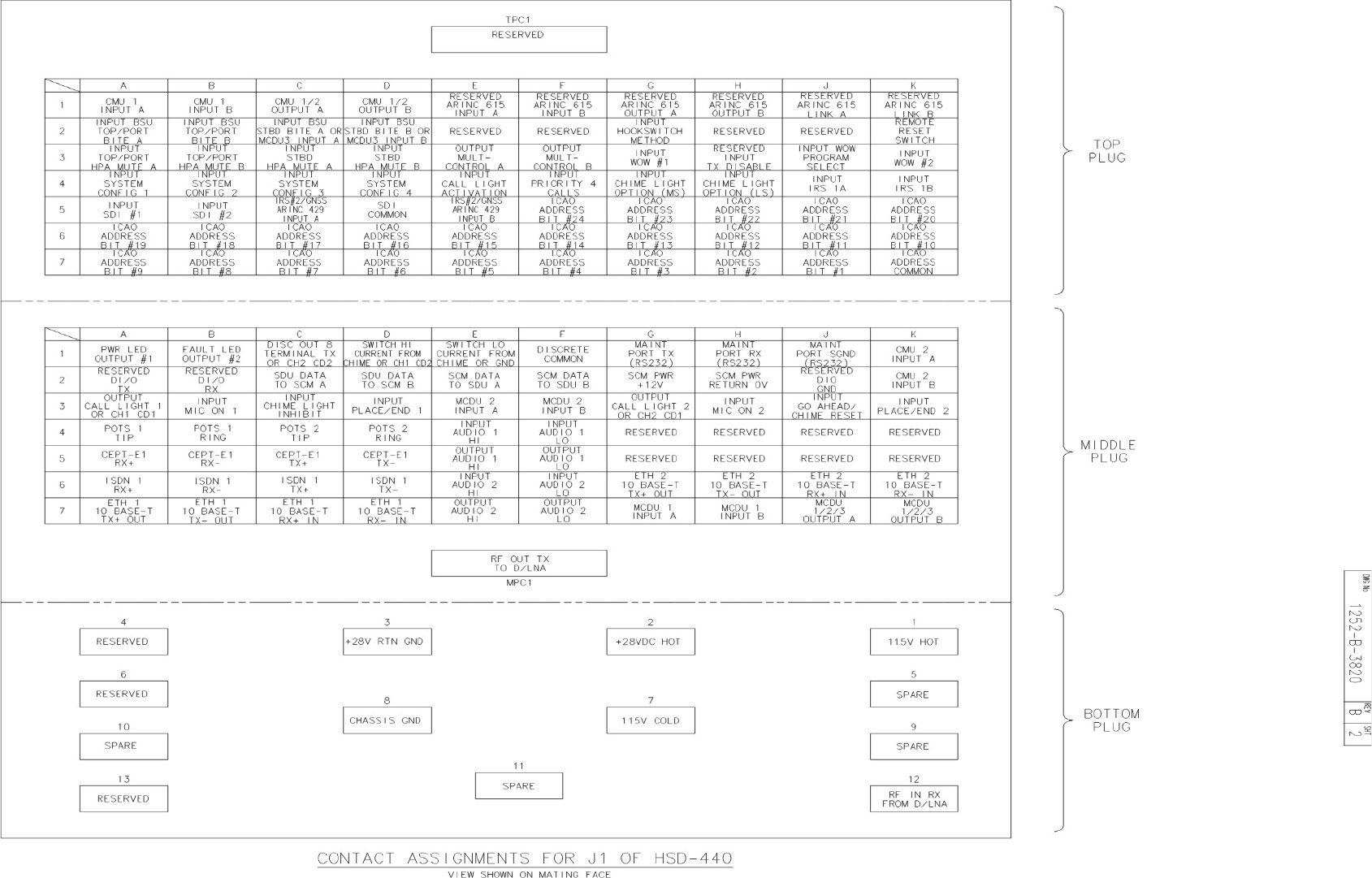
SYSTEM DESCRIPTION, INSTALLATION, AND MAINTENANCE MANUAL
eNfusion® HSD-440 Mark 2 Terminal
23-15-30 3-33
3 JUN 10
Figure 3-10 (Sheet 2). HSD-440 Mark 2 Terminal
System Interconnection Diagram (1252-B-3820, Rev B)
SYSTEM DESCRIPTION, INSTALLATION, AND MAINTENANCE MANUAL
eNfusion® HSD-440 Mark 2 Terminal
23-15-30 3-34
3 JUN 10
Blank Page

SYSTEM DESCRIPTION, INSTALLATION, AND MAINTENANCE MANUAL
eNfusion® HSD-440 Mark 2 Terminal
23-15-30 4-35
3 JUN 10
TEST AND FAULT ISOLATION
This chapter provides information required to determine the operational readiness of HSD-440 Mark
2 Terminals and aid service personnel in diagnosing system faults. The operational and diagnostic
tests described in this section require using the HSD-440 Mark 2 Terminal’s built-in diagnostic tool,
the MPU.
This chapter includes:
• Operational and Diagnostic Testing
• Troubleshooting and Fault Isolation
• Adjustment/Alignment Procedures
• Modification History
NOTE: Depending on the version of software installed, the MPU report and menu screens displayed
may differ from those shown as examples in this manual. The menu screens in this section
correspond to the HSD-440 Stand-Alone terminal in maintenance user mode.
1. Operational and Diagnostic Testing
This section includes the following sections:
• General
• Test and Fault Isolation Equipment Requirements
• Terminal Maintenance Port Utility
• Inmarsat Cause Codes
• Operational and Diagnostic Test Procedures
A. General
Usually, terminals require testing for one of the following reasons:
• To verify the operational readiness of the terminal during and after installation on an
aircraft
• To verify that a fault exists and produce system reports for troubleshooting purposes
• To verify the operational readiness of repaired LRUs during re-installation on an
aircraft
This section includes test and fault isolation procedures for the HSD-440 Mark 2
Terminals. All test and load procedures require the HSD-440 Mark 2 Terminal MPU,
which is accessed by connecting to the maintenance port of the terminal.
B. Test and Fault Isolation Equipment Requirements
Table 4-1 lists the equipment required to access the HSD-440 Mark 2 Terminal MPU and
perform operational and diagnostic testing and software loading on the HSD-440 Mark
2 Terminal.
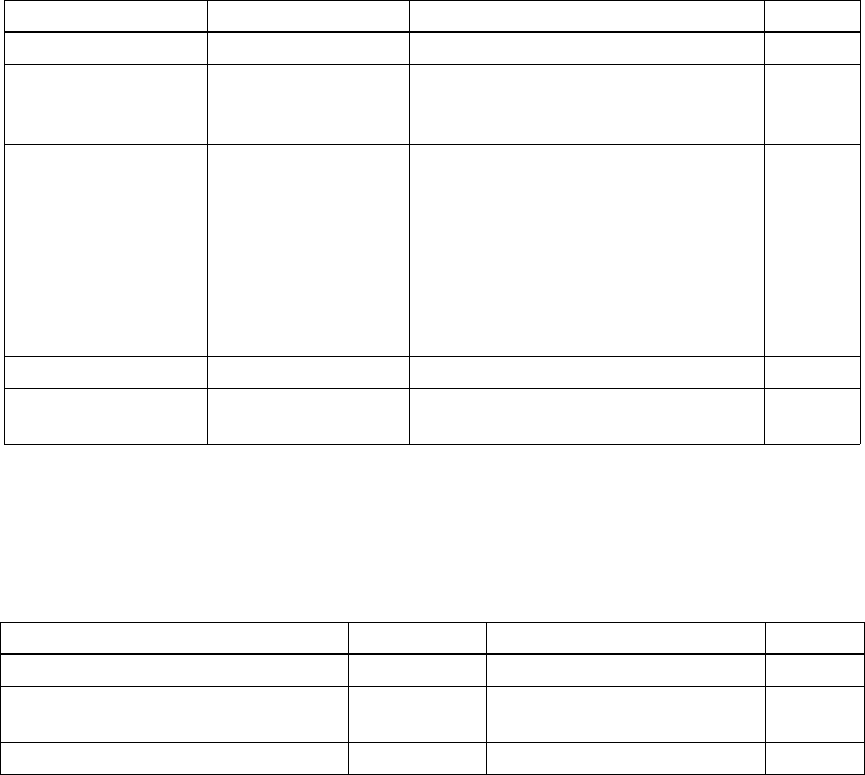
Table 4-1 List of Required Test Equipment
Item Equipment Specification Quantity
Computer Standard VT-100 386 CPU, 20 MHz or higher 1
VT-100 terminal
emulation program HyperTerminal©,
ProComm Plus©, or
equivalent
Serial communication program using an
RS-232 port 1
Cable, maintenance
port interface cable Special
See "Connection
Requirements" on
page 4-37
Remote access maximum cable length
25 ft. (From ARINC 600 connector to
DB9 breakout connector)
Test cable maximum length 25 ft.
(From HSD-440 Mark 2 Terminal to
management computer)
Front Panel access maximum cable
length 50 ft.
1
Multimeter Standard – 1
General purpose
toolset Standard – 1
SYSTEM DESCRIPTION, INSTALLATION, AND MAINTENANCE MANUAL
eNfusion® HSD-440 Mark 2 Terminal
23-15-30 4-36
3 JUN 10
Table 4-2 lists the optional equipment or information that is not required, but may increase
test efficiency or allow for optional diagnostic procedures. Equivalent substitutions may
be used.
Table 4-2 List of Optional Test Equipment
Item Equipment Specification Quantity
Service Provider Information Package Special Inmarsat service provider 1
Internet access Standard Inmarsat Swift 64 high-speed
data 1
Time Domain Refectometer Standard – 1
C. Terminal Maintenance Port Utility
This section describes the HSD-440 Mark 2 Terminal MPU and provides the connection
and cabling details required to access and use the program.
(1) General Overview
The MPU, built into the HSD-440 Mark 2 Terminal's operational software, provides
a system interface for fault isolation and diagnostic procedures.
To use the HSD-440 Mark 2 Terminal MPU, connect an RS-232, VT-100 terminal
(computer operating a terminal emulation program) to the RS-232 maintenance port
interface of the HSD-440 Mark 2 Terminal.
The maintenance port on the front panel of HSD-440 Mark 2 Terminals provides a
direct connection to the HSD-440 Mark 2 Terminal MPU using a DB25 connector.
Optionally, remote cabin access is possible using a DB9 connector via the ARINC
600 connector.
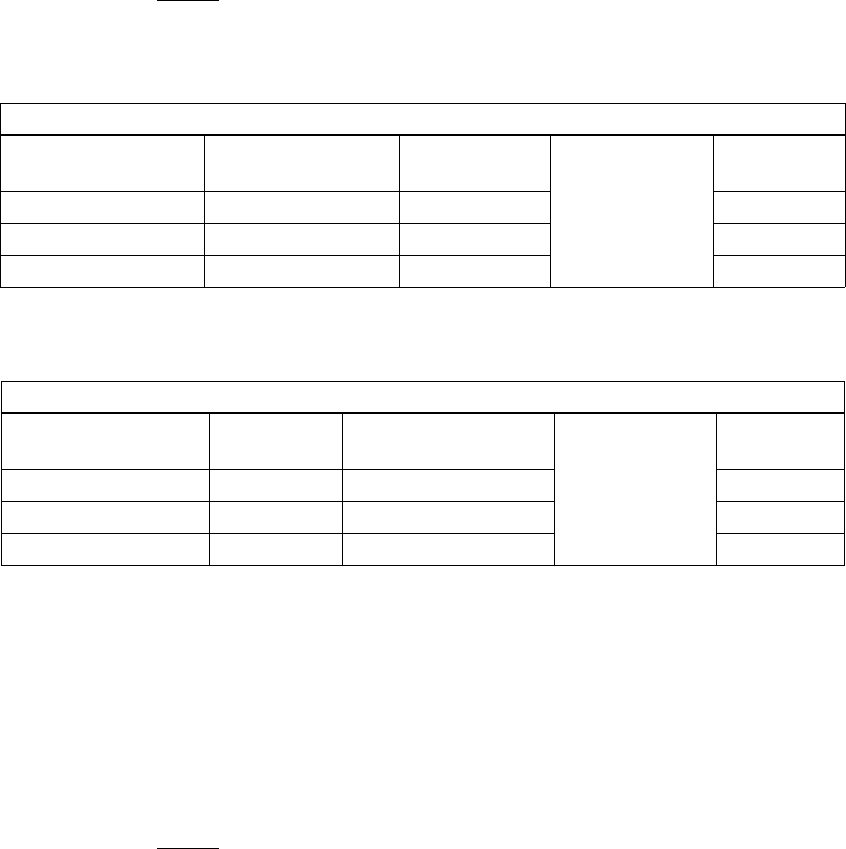
SYSTEM DESCRIPTION, INSTALLATION, AND MAINTENANCE MANUAL
eNfusion® HSD-440 Mark 2 Terminal
23-15-30 4-37
3 JUN 10
(2) Connection Requirements
This section describes specific cabling requirements needed to connect to and use
the HSD-440 Mark 2 Terminal MPU.
(a) Cabling Notes
The HSD-440 Mark 2 Terminals provide two options to connect to the HSD-440
Mark 2 Terminal maintenance port and MPU: direct connection and remote
connection.
Table 4-3, Table 4-4, Figure 4-1, and Figure 4-2 provide cabling details for the
HSD-440 Mark 2 Terminal for both direct and remote connection types. Select
one of these connection options to access the HSD-440 Mark 2 Terminal MPU.
NOTE: The direct and remote connection points to the HSD-440 Mark 2
Terminal maintenance port cannot be used simultaneously.
Table 4-3 Remote Connection Cabling
Remote Access
Pin Definition ARINC Connector
(Rear) Remote (DB9)
Cable
(See Figure 4-1)
Computer
(DB9P)
Maint Port SGND (MP1J) 5 5
Maint Port Rx (MP1H) 3 3
Maint Port Tx (MP1G) 2 2
Table 4-4 Direct Connection Cabling
Direct Connection
Pin Definition Front Panel Maintenance Cable
Connector (DB25P) Cable
(See Figure 4-2)
Computer
(DB9P)
Maint Port SGND 10 10 5
Maint Port Rx 12 12 3
Maint Port Tx 11 11 2
(b) Maintenance Port Cable Assembly
HSD-440 Mark 2 Terminal maintenance cable connections may vary in length,
type of connection used, and connector pin call outs, depending on the access
point used.
The cable assembly for the HSD-440 Mark 2 Terminal assumes that the
computer's COM port interface is a 9-Pin, D-Sub connector (DB9). Cable
assembly details for HSD-440 Mark 2 Terminals are presented in Figure 4-1 and
Figure 4-2.
NOTE: The maximum cable length, shown in Figure 4-1 and Figure 4-2,
assumes that the length is measured from the ARINC 600 connector to
the DB9 breakout connector.

SYSTEM DESCRIPTION, INSTALLATION, AND MAINTENANCE MANUAL
eNfusion® HSD-440 Mark 2 Terminal
23-15-30 4-38
3 JUN 10
Figure 4-1 Remote Connection, Maintenance Cable
Figure 4-2 Direct Connection, Maintenance Cable
(c) Interface Requirements
A standard VT-100 compatible terminal running an emulator program (such as
HyperTerminal, ProComm Plus, or similar) provides the user interface to the
HSD-440 Mark 2 Terminal MPU. The RS-232 terminal connection settings for
HSD-440 Mark 2 Terminal maintenance ports are listed in Table 4-5.

Table 4-5 Terminal Connection Settings
Parameter Setting
Character Format ASCII
Baud Rate 19200 bps
No. of bits 8
Parity None
Stop bits 1
Flow Control None
SYSTEM DESCRIPTION, INSTALLATION, AND MAINTENANCE MANUAL
eNfusion® HSD-440 Mark 2 Terminal
23-15-30 4-39
3 JUN 10
(3) Accessing the MPU
There are various levels of access to the MPU. Each level is protected by a different
password.
This document describes End User and Field Representative access levels. These
levels provide access and tools for operational testing and verification, software
updates, and the basic system monitoring and troubleshooting procedures provided
in this manual.
(a) Level 1 Access
This limited-access level is for anyone without technical training on the product.
It provides read-only access to help users diagnose problems with the assistance
of product support personnel.
The password for access to this level is menu.
(b) Level 2 Access
This level is for trained original equipment manufacturer (OEM) installers and
product support personnel. This access level supports read and limited write
capabilities. Users can disable, mask, or clear faults, change satellite or
LES/GES preferences, view and modify certain EEPROM parameters, and
maintain and upgrade the HSD-440 Mark 2 Terminal.
The password for this level is maint.
(4) Using the Terminal MPU
This section describes the basic procedures for using and navigating the HSD-440
Mark 2 Terminal MPU.
(a) Entering Passwords
You can enter the password any time after the HSD-440 Mark 2 Terminal boots.
• To access Level 1 functions, type menu.
• To access Level 2 functions, type maint.
NOTE: The password does not appear on the screen when you type it.

SYSTEM DESCRIPTION, INSTALLATION, AND MAINTENANCE MANUAL
eNfusion® HSD-440 Mark 2 Terminal
23-15-30 4-40
3 JUN 10
(b) Navigating the Terminal MPU
• To scroll through the available menus, press CTRL+N.
• To go to the previous menu, press CTRL+O.
• To refresh the menu screen or exit from a Reports Menu, press ESC.
(c) Selecting Menu Items
To enable test or data entry functions, press the letter associated with the menu
items.
(d) Selecting Reports
The reports available through the MPU enable users to view information about
the configuration and status of the HSD-440 Mark 2 Terminal. This information is
used to troubleshoot the communication system on the aircraft.
"Report Descriptions" on page 4-53 provides more information about reports.
To access reports:
1. In the MPU, press EQUAL SIGN.
A list of reports appears. Active reports show as toggled on. Inactive reports
show as toggled off.
2. To activate a report, type the report number, and then press ENTER.
NOTE: Multiple reports can be activated at the same time; type and enter
each report number separately.
3. To turn off individual, active reports, type the report number you want to toggle
off, and then press ENTER.
4. To turn off all active reports, press EQUAL SIGN, and then press X.
(5) Menu Item Descriptions
This section provides a brief description of the Level 2, MPU menu items used for test
and fault isolation procedures.
Although this section only provides illustrations and descriptions for Level 2 access,
all Level 1 access menu items are covered. (All Level 1 menus are included in Level
2 Menus.)
In active HSD-440 Mark 2 Terminals, menu screens display the firmware version.
NOTE: Depending on the version of software installed and the system configuration,
the menu and reports available to users may differ slightly from the
illustrations shown and described in this document.
(a) Menu 1
Figure shows an example Menu 1 screen display. Table 4-6 describes the items
available in Menu 1.
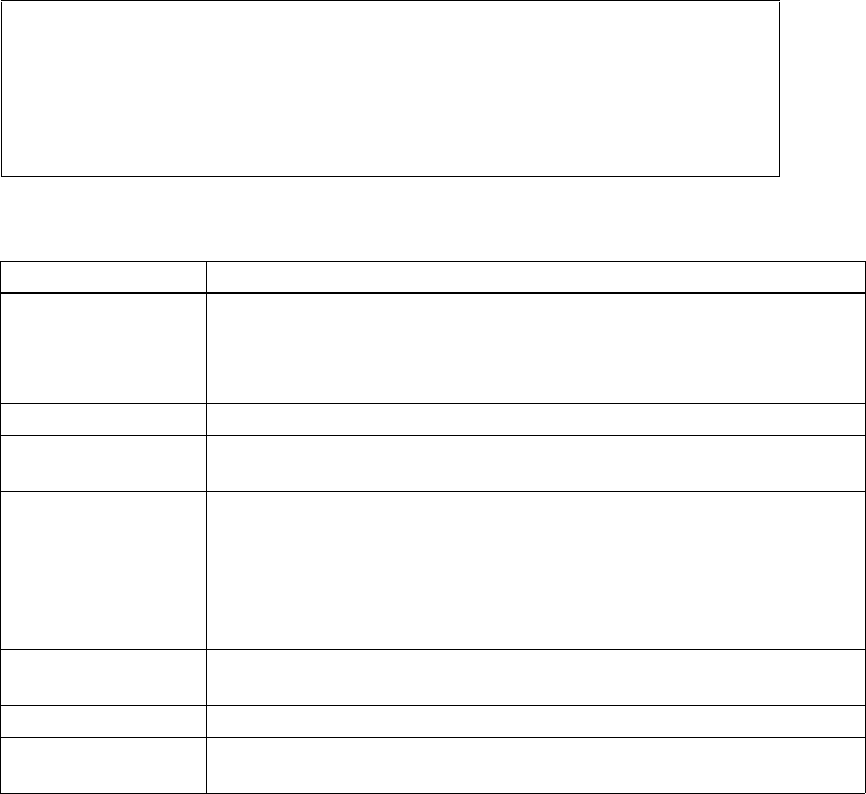
SYSTEM DESCRIPTION, INSTALLATION, AND MAINTENANCE MANUAL
eNfusion® HSD-440 Mark 2 Terminal
23-15-30 4-41
3 JUN 10
Menu 1 Screen Display
Table 4-6 Menu 1 Item Descriptions
Menu Item Description
X: override forward
id/ICAO address Used in testing and fault isolation.
Enter a test or alternate FWD ID or ICAO ID to use during fault isolation
procedures. Resetting the HSD-440 Mark 2 Terminal or cycling the power
cancels this function.
Y: explain error status Reports error status when failure LED is illuminated.
F: print equipment
stats Prints a list of the current equipment statistics.
N: permit TFTP
software loads Upgrade or load HSD software using the EMS serial data loader connected
to the HSD terminal maintenance port and using TFTP over the front panel
Ethernet port.
Note: When this option is enabled, software loads start within the next 10
minutes. To enable this option, the aircraft air/ground status must be
on-ground.
L: test LEDs Toggles the Power On (LED 1) and Fault (LED 2) LEDs on (A) and off (D)
or returns them to software control (X).
U: list event log Lists the current event log.
M: clear equipment
stats Resets the equipment statistics. (See Item F.)
MENU 1 FIRMWARE Vx.x GND
X override forward id/ICAO address L test LEDs
Y explain error status U list event log (hex)
F print equipment stats M clear equipment stats
N permit TFTP software loads
<CTRL> N next menu <CTRL> O previous menu = select reports
(b) Menu 2
Figure 4-3 shows an example MPU Menu 2 screen display. Table 4-7 describes
the items available in Menu 2.

MENU 2 FIRMWARE Vx.x GND
A set veh-relative azimuth E set veh-relative elevation
K desired az veh-rel velocity R resume automatic steering
T enter time of day N annotate log file
L re-enter logon password V get firmware versions
Z reset 1252-A-3800-01 S set satellite longitude
G manual antenna steering
<CTRL> N next menu <CTRL> O previous menu = select reports
SYSTEM DESCRIPTION, INSTALLATION, AND MAINTENANCE MANUAL
eNfusion® HSD-440 Mark 2 Terminal
23-15-30 4-42
3 JUN 10
Figure 4-3 Menu 2 Screen Display
Table 4-7 Menu 2 Item Descriptions
Menu Item Description
NOTE: Menu 2 selections A and E are used to manually input navigational data to point the antenna
to a preferred satellite location and/or peak for maximum signal reception. These
commands are typically used where no IRS data is available.
A: set veh-relative
azimuth Antenna azimuth pointing offset with reference to the front centerline of
the aircraft.
Offset value entered in degrees from 0 to 180, where a positive entry is
clockwise (cw) and a negative entry is counterclockwise (ccw).
K: desired az veh-rel
velocity Activates continuous antenna azimuth sweep at a set elevation, as
entered with menu item E.
Azimuth sweep velocity entered as deg/sec value.
NOTE: When combined with a signal-monitoring reports selection,
sweep the antenna for maximum signal strength to determine
optimum location coordinates.
T: enter time of day Permits the entry of date and time for initial one-time setting of the Real
Time Clock.
L: re-enter logon
passwordPermits a user to enter a new access level password: menu or maint.
Z: reset terminal Enables a complete, soft reset of the LRU; once reset, the menu access
password must be re-entered.
G: manual antenna
steering Set manual antenna-steering in both azimuth and elevation.
Four options:
• I increases elevation 0.5 deg
• M decreases elevation 0.5 deg
• L increases azimuth 0.5 deg
• J decreases azimuth 0.5 deg
E: set veh-relative
elevation Antenna elevation pointing offset with respect to the aircraft horizontal
rest position; i.e., assumed to have no pitch or roll offset.
Offset value entered in degrees from 0 to 90.

SYSTEM DESCRIPTION, INSTALLATION, AND MAINTENANCE MANUAL
eNfusion® HSD-440 Mark 2 Terminal
23-15-30 4-43
3 JUN 10
(c) Menu 3
Table 4-7Figure 4-4 shows the menu 3 screen display. Table 4-8 describes the
items available in Menu 3.
MENU 3 FIRMWARE Vx.x
L list EEPROM S list event log
C clear event log M misc. EEPROM parameter
F list call log G clear call log
O list ORT P ocean region parameter
I set all LES id's H list SCM/CP ORT
K set CP ORT parameter R copy CP ORT to SCM
T write defaults to CP ORT U clear SCM ORT
D output binary ORT V bulletin board satellite data
B list channel card event log
<CTRL> N next menu <CTRL> O previous menu = select reports
Figure 4-4 Menu 3 Screen Display
R: resume automatic
steering Re-activates programmed automatic antenna-steering in both azimuth
and elevation.
N: annotate log file Allows for input of text into a log file.
This feature can be used to document information such as test conditions,
system or aircraft identification, or any pertinent information for later
review.
V: get firmware versions Displays the system Kernel and Application software versions, and the
channel card(s) and HPA firmware revisions.
S: set satellite longitude Sets the satellite longitude.
Table 4-7 Menu 2 Item Descriptions (Continued)
Menu Item Description
Table 4-8 Menu 3 Item Descriptions
Menu Item Description
L: list EEPROM Displays a list of all system EEPROM parameters and their
corresponding values (this function is READ only).
Certain parameters are set using Menu 3, item M selection.
C: clear event log Clears all events stored in non-volatile RAM.
F: list call log Displays call log files for HSD-440 Mark 2 Terminal. When selected,
three options are available:
• To display complete list of all log files, press F.
• To list extended EIRP trace data, press X.
• To list all remaining entries, press PERIOD.

SYSTEM DESCRIPTION, INSTALLATION, AND MAINTENANCE MANUAL
eNfusion® HSD-440 Mark 2 Terminal
23-15-30 4-44
3 JUN 10
For more information about ORT parameters, see "Configuring the Owners
Requirements Table (ORT)" on page 6-1.
Figure 4-5 shows an example Menu 3, Item M: Miscellaneous EEPROM
parametersscreen display for the HSD-440 Mark 2 Terminal.
Table 4-9 describes the items available in Menu 3, Item M.
O: list ORT Displays all EEPROM parameters, including all cable losses and
LES/GES configurations.
I: set all LES id's Displays all ORT parameters to the same LES/GES access code and
service provider (including primary and secondary service providers).
Certain parameters are set using Menu 3, set CP ORT parameter.
K: set CP ORT parameter Use the ORT parameters to configure parameters for the HSD-440
Mark 2 Terminal.
T: write defaults to CP ORT Each SDU stores a copy of the User, Secure, and Manufacturer
Specific ORT parameter defaults in its software load.
V: bulletin board satellite
data The HSD-440 Mark 2 Terminal stores the updated satellite longitude
from the bulletin board.
S: list event log Lists all events and system fault codes stored in non-volatile RAM.
When selected, several options are available:
• 0 displays the most recent saved entry.
• S displays next most recent entry saved.
• PERIOD displays all remaining logged entries.
• 1 displays special events (does not include ORR entries).
M: misc. EEPROM
parameter Enables entry or entry changes to some of the EEPROM parameters
listed in function L.
G: clear call log Clears call log files for HSD-440 Mark 2 Terminal.
P: ocean region parameter Configures LES access codes (primary and secondary service
providers) for individual ORs.
H: list SCM/CP ORT Lists the values contained in both SCM and the CP ORT.
R: copy CP ORT to SCM Copies values stored in the CP ORT to the SCM. This may take
several minutes. To indicate progress, the HSD-440 Mark 2 Terminal
displays the number of bytes remaining to transfer.
U: clear SCM ORT Clear the ORT parameter from the SCM.
B: list channel card event log Lists the event log for individual channel cards.
Table 4-8 Menu 3 Item Descriptions (Continued)
Menu Item Description

MISCELLANEOUS PARAMETERS
1 HPA-TO-ANTENNA TOTAL LOSS 21 CARD 2 IP ADDRESS
2 FORWARD ID 22 TRANSMIT IF WEIGHT-ON-WHEELS
3 GPS PROTECTION ALGORITHMS 29 DEFAULT LATTITUDE
11 FRONT PANEL LEDS ENABLED 30 DEFAULT LONGITUDE
14 MAINTENANCE PORT INVERSE VIDEO 31 OBEY OXCO STATUS
15 MAINTENANCE PORT DEGREES SYMBOL 63 CARD 1 SUBNET MASK
16 TERMINAL CATEGORY 64 CARD 2 SUBNET MASK
20 CARD 1 IP ADDRESS 65 AIR/GROUND BEHAVIOUR
WHICH PARAMETER # <CTRL> N for next page ?
73 CP AUTO ATTACH 90 BGAN/SWIFT64 CONGESTION THRESHOLD
74 CC SBB CIPER PARAMETER 91 BGAN/SWIFT64 AUTO HANDOVER
83 IP HEADER COMPRESSION 95 OVER-POWER MARGIN
84 SW64 POSITION REPORTING 97 CHANNEL CARD CONFIGURATION
85 APAC TEST BEARER LONGITUDE 100 MIN SAT LOOK ANGLE
86 EMEA TEST BEARER LONGITUDE 101 PREEMPTABLE CALLS
87 AMERICAS TEST BEARER LONGITUDE 102 BGAN/SWIFT64 HYSTERESIS TIMEOUT
89 BGAN/SWIFT64 CONGESTION TIMEOUT 103 ANTENNA MOUNTING ANGLE (ROLL)
WHICH PARAMETER # <CTRL> N for next page ?
104 ANTENNA MOUNTING ANGLE (PITCH) 114 MAX ORDER FOR INTERMOD CHECK
105 ANTENNA MOUNTING ANGLE (ROTATION) 115 ENABLE PAP
106 RT-CHANNEL RESERVED POWER 116 PAP USER NAME
108 USWR ERROR THRESHOLD 117 PAP PASSWORD
109 IRS1 TYPE 118 VOICE PROCESSOR IP ADDRESS
110 IRS2 TYPE 119 LNA TO SDU RX THRESHOLD
113 MAXIMUM IGA POWER
SYSTEM DESCRIPTION, INSTALLATION, AND MAINTENANCE MANUAL
eNfusion® HSD-440 Mark 2 Terminal
23-15-30 4-45
3 JUN 10
Figure 4-5 Menu 3 - Item M: Miscellaneous EEPROM Parameters
Table 4-9 Menu 3, Item M EEPROM Parameter Descriptions
Parameter
Number Parameter Name Description
1HPA-to-antenna total
loss Defines transmit coaxial cable loss from the HSD-440 Mark
2 Terminal at MPC1 to the antenna, including the DLNA
loss—maximum is 2.5 dB (includes DLNA loss of 0.8 dB).
2Forward ID The Forward ID is not strapped, therefore you must enter
it using this parameter.
3GPS protection
algorithms Disables the GPS algorithms the HSD-440 Mark 2
Terminal uses to prevent calls from interfering with the GPS
navigational system on the aircraft.
10 Number of channel
cards Selects the number of channel cards for which the system
is configured. Default is 2.
11 Front panel LEDs
enabled Future consideration is provided for additional LEDs,
beyond the two currently activated—default is 2.

SYSTEM DESCRIPTION, INSTALLATION, AND MAINTENANCE MANUAL
eNfusion® HSD-440 Mark 2 Terminal
23-15-30 4-46
3 JUN 10
14 Maintenance port
inverse video Enables a selected report to be highlighted in Inverse Video
when it is activated—default is 1 (activated).
15 Maintenance port
degrees symbol Offers a choice of displaying the letter D or the degree
symbol ° when viewing the lat/long information displayed
in the Reports output:
• Select 0 to use the letter D; e.g., 180.0 D.
• Select 1 to use a degree symbol °; e.g., 180.0°.
16 Terminal category Configure the LRU type. Default is 2 (HW Strapping) —
hardware is read on power-up.
20 Card 1 IP address IP address of channel card 1.
21 Card 2 IP address IP address of channel card 2.
22 Transmit if
Weight-on-Wheels Allows the system to transmit when it is on the ground.
29 Default latitude Allows user to enter a default latitude value.
Reset the HSD-440 Mark 2 Terminal to activate revised
default values.
30 Default longitude Allows user to enter a default longitude value.
Reset the HSD-440 Mark 2 Terminal to activate revised
default values.
31 Obey OXCO status Prevents system operation until OCXO is warmed up
(unless overridden).
Use parameter setting to override warm-up during testing
procedures.
60 Ch card gateway
address Manufacturer-specific - do not modify.
61 IMEI number Manufacturer-specific - do not modify.
62 SDU-to-PA gain Manufacturer-specific - do not modify.
63 Card 1 subnet address Subnet address of channel card 1.
64 Card 2 subnet address Subnet address of channel card 2.
65 Air/ground behavior Determines the function of WOW strapping.
66 #2 IMEI number Manufacturer-specific - do not modify.
67 #3 IMEI number Manufacturer-specific - do not modify.
68 #4 IMEI number Manufacturer-specific - do not modify.
73 CP auto attach To ensure that the terminal registers on the
SwiftBroadband Circuit-Switched and Packet-Switched
core network, set this option to CS PS. Network
Registration is essential to access network resources to
make calls.
74 CC SBB cipher
parameter Ciphers the messages between the terminal and the core
network.
Table 4-9 Menu 3, Item M EEPROM Parameter Descriptions (Continued)
Parameter
Number Parameter Name Description

SYSTEM DESCRIPTION, INSTALLATION, AND MAINTENANCE MANUAL
eNfusion® HSD-440 Mark 2 Terminal
23-15-30 4-47
3 JUN 10
(d) Menu 4
Figure 4-6 shows an example MPU Menu 4 screen display for an HSD-440 Mark
2 Terminal. Table 4-10 describes the items available in Menu 4.
83 IP Header Compression Turns on IP header compression. Valid values: C (channel
card default = Off), 0 (Off), and 4 through 9 (On)
95 Over Power Margin Do not change.2
97 Channel Card
Configuration Configures channel cards for Swift64, SBB, or classic
service.2
101 Preemptable Calls Configures which calls can be preempted when performing
a satellite handover.
102 BGAN/SWIFT64
Hysteresis Timeout Configures the time it will take to perform a satellite
handover once a new satellite is visible.2
Default is 120.0 SEC.
103 Antenna Mounting Angle
(Roll) Configures the physical antenna mounting angle (Roll).2
104 Antenna Mounting Angle
(Pitch) Configures the physical antenna mounting angle (Pitch).2
105 Antenna Mounting Angle
(Rotation)
Configures the physical antenna mounting angle
(Rotation).2
106 RT Channel Reserved
Power Do not change.2
108 VSWR Error Threshold Do not change.2
109 IRS1 Type Configures the navigation data type for the ARINC 429 IRS
receiver 1.2
110 IRS2 Type Configures the navigation data type for the ARINC 429 IRS
receiver 2.2
113 Maximum IGA Power Do not change.2
115 Enable PAP Enables PAP authentication. For configuration instructions,
refer to the HSD Terminal Developer’s Guide,
MN-1252-13005.2
116 PAP User Name Configures PAP authentication username. Refer to the
HSD Terminal Developer’s Guide, MN-1252-13005.2
117 PAP Password Configures PAP authentication password. Refer to the HSD
Terminal Developer’s Guide, MN-1252-13005.2
118 Voice Processor IP
Address
Do not change.2
119 LNA to SDU RX
Threshold
Do not change.2
Table 4-9 Menu 3, Item M EEPROM Parameter Descriptions (Continued)
Parameter
Number Parameter Name Description
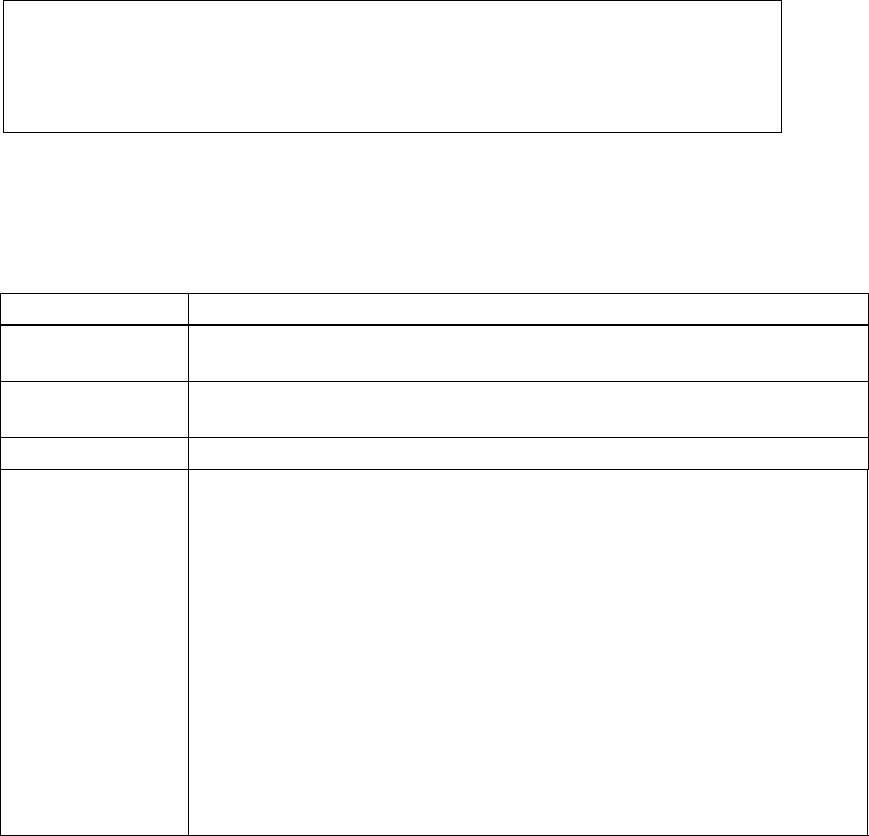
MENU 4 1252-A-3800-01 FIRMWARE Vx.x
Q channel card forward ID's O set Ocean Region
S change spot beam J toggle ISDN connection
M report MUX stats
<CTRL> N next menu <CTRL> O previous menu = select reports
SYSTEM DESCRIPTION, INSTALLATION, AND MAINTENANCE MANUAL
eNfusion® HSD-440 Mark 2 Terminal
23-15-30 4-48
3 JUN 10
Figure 4-6 Menu 4 Screen Display
Table 4-10 Menu 4 Item Descriptions
Menu Item Item Description
Q: channel card
forward IDs Enables viewing of ISDN channels 1 and 2 FWD IDs in Swift64 mode, IMSI
in SBB mode, and ICAO for the classic channel card.
S: change spot
beam Enables manual selection of specific spot beams independently assigned for
each ISDN channel.
M: report MUX stats Not applicable: Used for engineering debugging purposes only.
O: set Ocean
Region Allows for manual selection of satellite ORs:
AORW: 0
AORE: 1
POR: 2
IOR: 3
MTSAT: 4
APAC: 5
EMEA: 6
AMERICAS: 7
To revert to programmed selection, type -1, and then press ENTER for AUTO
selection.
(e) Menu 10
Menu 10 items are used to manually enter INS or IRS parameters to simulate
the data required for HSD-440 Mark 2 Terminal operation when INS or IRS data
is unavailable. Figure 4-7 shows an example HSD-440 Mark 2 Terminal MPU
Menu 10 screen.

MENU 10 1252-A-3800-01 FIRMWARE Vx.x
A activate IRS simul words X deactivate IRS simul words
F IRS bus #1 L simul IRS lat
G simul IRS long H simul IRS heading
T simul IRS true track P simul IRS pitch
R simul IRS roll S simul IRS speed
Q simul IRS altitude C port ACU status
B sb ACU status M activate antenna status words
N deactivate antenna status words D toggle active antenna
<CTRL> N next menu <CTRL> O previous menu = select reports
SYSTEM DESCRIPTION, INSTALLATION, AND MAINTENANCE MANUAL
eNfusion® HSD-440 Mark 2 Terminal
23-15-30 4-49
3 JUN 10
Figure 4-7 Menu 10 Screen Display
Table 4-11 describes the items available in Menu 10.
Table 4-11 Menu 10 Item Descriptions
Menu Item Description
L: simul INS lat Simulates a latitude by overriding the data received from the aircraft INS.
H: simul INS heading Simulates aircraft heading by overriding the data received from the aircraft
INS.
P: simul INS pitch Simulates aircraft pitch by overriding the data received from the aircraft INS.
S: simul INS speed Simulates aircraft speed by overriding the data received from the aircraft
INS.
A: activate INS simul
words Activates all input simulate parameters, overriding the INS data received
from the aircraft.
Lat and Long values from the EEPROM values set in Menu 3.
B: simul sb ACU
status Enter the starboard antenna gain in dB and the message rate in Hz.
N: deactivate
antenna status
words
De-activates all set antenna status words.
X: deactivate INS
simul words De-activates all simulated parameters reverting the HSD-440 Mark 2
Terminal back to using the INS data received from the aircraft.
G: simul INS/IRS
long Simulates aircraft longitude by overriding the data received from the aircraft
INS.
T: simul INS/IRS true
trackSimulates true track by overriding the data received from the aircraft INS.
R: simul INS roll Simulates aircraft roll by overriding the data received from the aircraft INS.
Q: simul INS altitude Simulates aircraft altitude by overriding the data received from the aircraft
INS.
C: simul port ACU
status Enter both the port antenna gain in dB and the message rate in Hz.
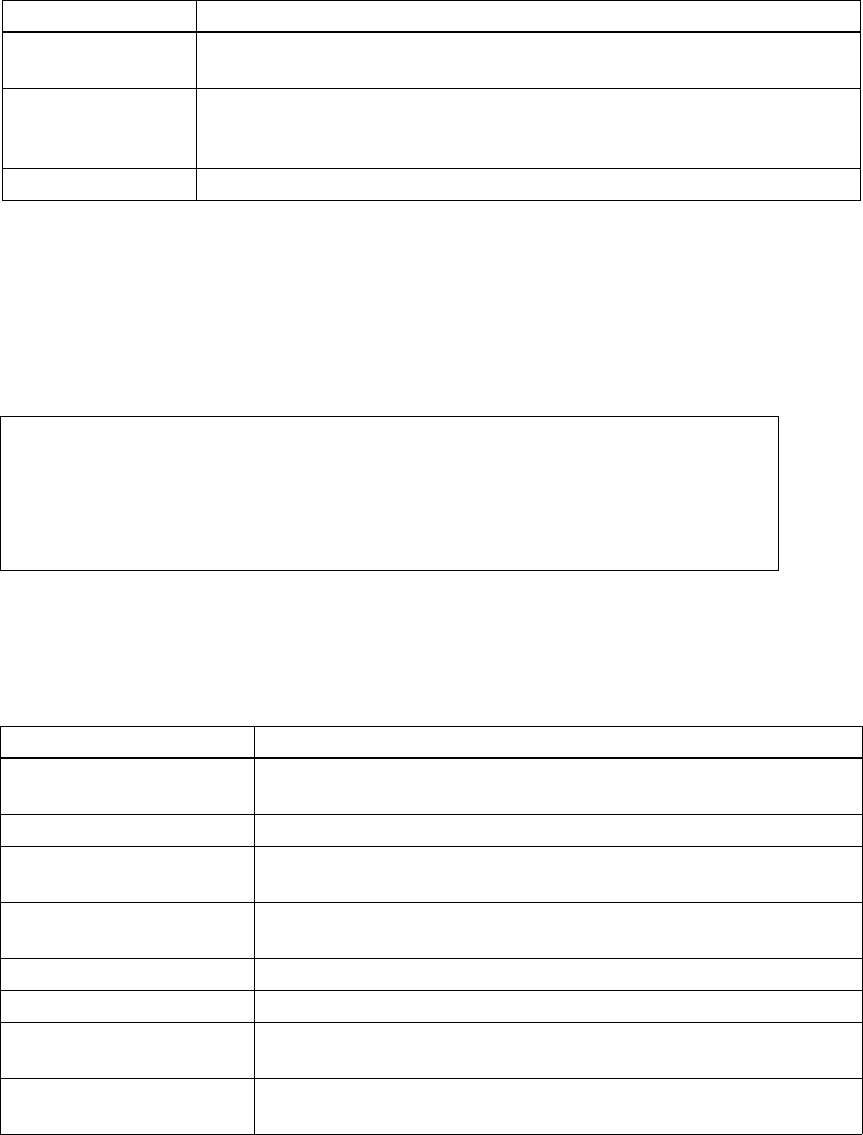
SYSTEM DESCRIPTION, INSTALLATION, AND MAINTENANCE MANUAL
eNfusion® HSD-440 Mark 2 Terminal
23-15-30 4-50
3 JUN 10
(f) Menu 13
Menu 13 items are used to query and debug the data I/O card.
Figure 4-8 shows an example Menu 13 screen display. Table 4-12 describes the
items available in Menu 13.
MENU 13 1252-A-3800-01 FIRMWARE Vx.x
T query DATA IO elapsed time V query DATA IO version
S query DATA IO services D DATA IO test
F DATA IO fault logging level X DATA IO console mode
G print DATA IO call database Y disable output to DATA I/O
<CTRL> N next menu <CTRL> O previous menu = select reports
Figure 4-8 Menu 13 Screen Display
Table 4-12 Menu 13 Item Descriptions
Menu Item Description
T: query DATA IO elapsed
time Displays the time (in seconds) since the last data I/O reset.
S: query DATA IO services Displays active interfaces.
F: DATA IO fault logging
level Sets the level of minimum severity of events that are reported to the
data I/O card.
G: print DATA IO call
database Displays the calls made and recorded in the data I/O database.
V: query DATA IO version Displays the firmware version of the data I/O card.
D: DATA IO test Tests individual interfaces of the data I/O.
X: DATA IO console mode Opens a virtual TTY session to the data I/O maintenance port on the
HSD-440 Mark 2 Terminal.
Y: disable output to DATA
I/ODisables output to data I/O from control processor.
M: activate antenna
status words Activates all set antenna status words.
D: toggle active
antenna Changes the current simulated active antenna. Choose starboard, port, or
automatic. Note that this change will only take effect if antenna status words
are activated using menu item M.
F: IRS bus #1 Do not change
Table 4-11 Menu 10 Item Descriptions (Continued)
Menu Item Description
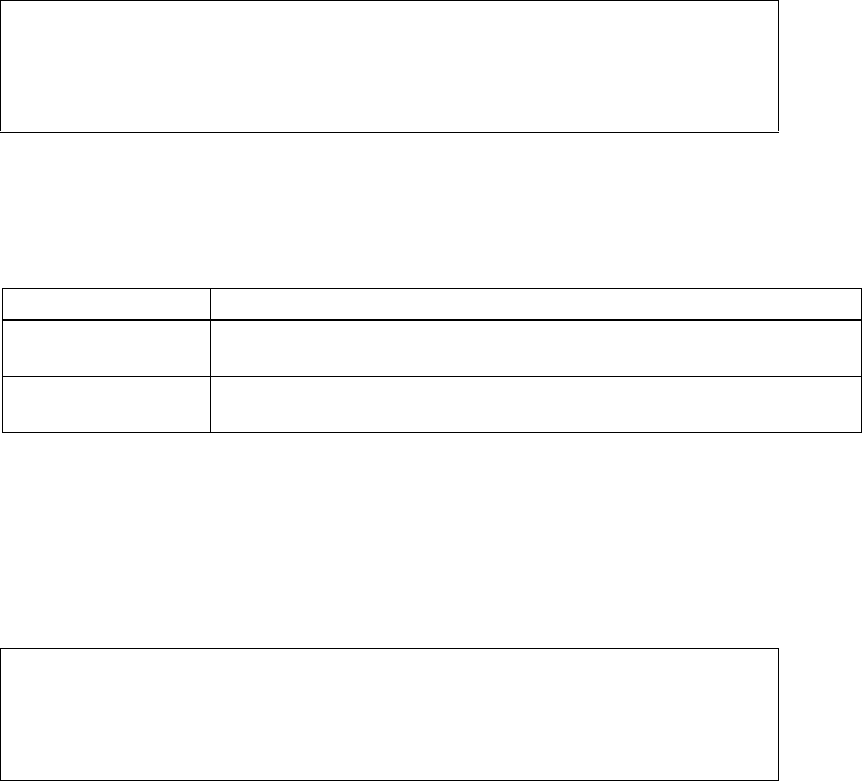
SYSTEM DESCRIPTION, INSTALLATION, AND MAINTENANCE MANUAL
eNfusion® HSD-440 Mark 2 Terminal
23-15-30 4-51
3 JUN 10
(g) Menu 14
Menu 14 items are used only by professional installers for debugging and
clarifying call routing issues.
Figure 4-9 shows an example HSD-440 Mark 2 Terminal MPU Menu 14 screen
display. Table 4-13 describes some of the items available in Menu 14.
MENU 14 1252-A-3800-01 FIRMWARE Vx.x
N num entries in call table L list call table
T get call table E list eeprom call mapping edits
G modify eeprom call mapping edits
<CTRL> N next menu <CTRL> O previous menu = select reports
Figure 4-9 Menu 14 Screen Display
(h) Menu 15
Figure 4-10 shows an example HSD-440 Mark 2 Terminal MPU Menu 15 screen
display.
Table 4-14 describes the items available in Menu 15.
MENU 15 1252-A-3800-01 FIRMWARE Vx.x
V request channel card versions D channel card serial number
B channel card RSSI mode G A_TI query
W request burst counter
<CTRL> N next menu <CTRL> O previous menu = select reports
Figure 4-10 Menu 15 Screen Display
Table 4-13 Menu 14 Item Descriptions
Menu Item Item Description
G: modify eeprom call
mapping edits Do not change.
E: list eeprom call
mapping edits Do not change.
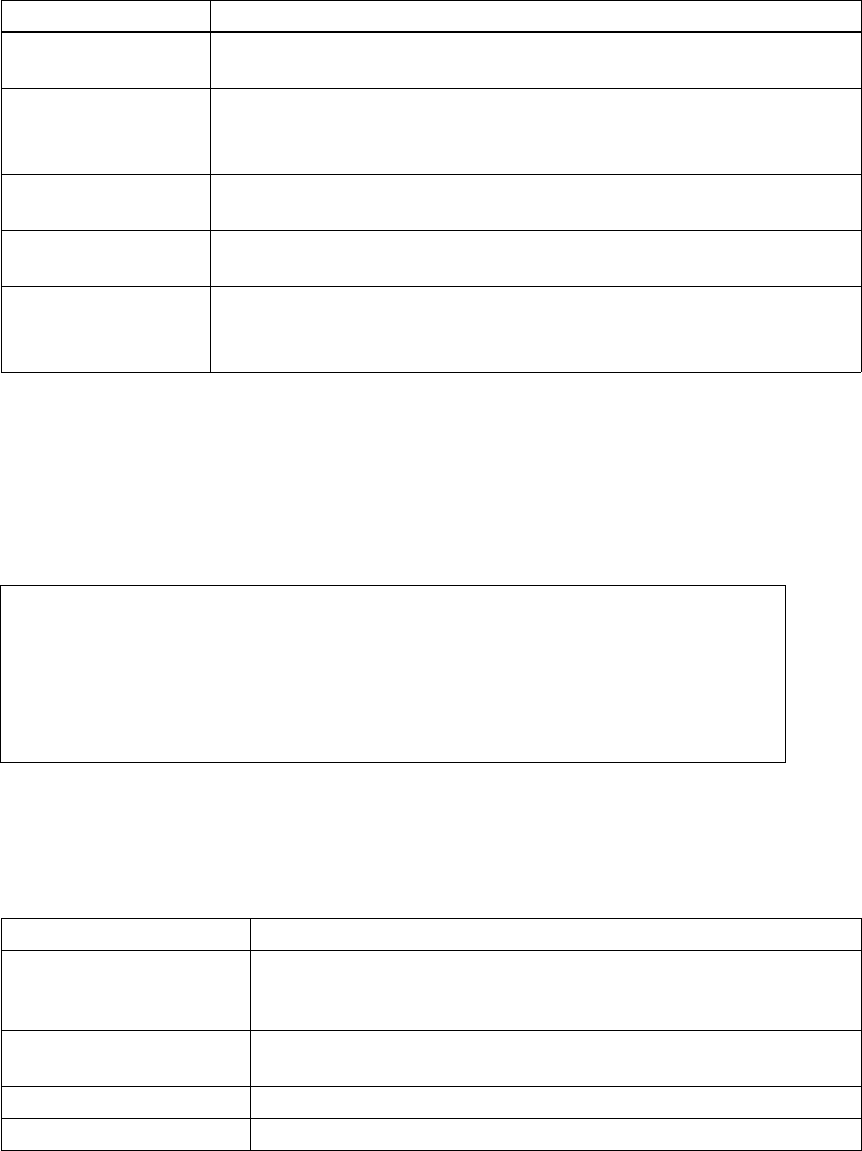
Table 4-14 Menu 15 Item Descriptions
Menu Item Item Description
V: request channel
card versions Displays software versions for a selected channel card.
B: channel card RSSI
modePlaces the channel card in Received Signal Strength Indicator mode.
As requested, enter the channel number, the OR, the channel type, and
the RSSI period in milliseconds.
W: request burst
counter Displays the burst counter information.
D: channel card serial
number Displays the serial number of the selected channel card.
G: A_TI query Manually sends an A_TI query to the requested channel card to check on
the alive/dead status of the channel card processors.
As requested, enter a channel card number and service type to query.
SYSTEM DESCRIPTION, INSTALLATION, AND MAINTENANCE MANUAL
eNfusion® HSD-440 Mark 2 Terminal
23-15-30 4-52
3 JUN 10
(i) Menu 21
Figure 4-11 shows an example Menu 21 screen display.
Table 4-15 describes some of the items available in Menu 21.
MENU 21 1252-A-3800-01 FIRMWARE Vx.x
P get channel card ethernet parms I get channel card IMEI number
B request SBB configuration L list spotbeam table
G logoff SBB spotbeam N GPS-assisted IRS data
Q query channel card flashprom Y activate ZB burst status
J inquire for spot beam map
<CTRL> N next menu <CTRL> O previous menu = select reports
Figure 4-11 Menu 21 Screen Display
Table 4-15 Menu 21 Item Descriptions
Menu Item Item Description
P: get channel card
ethernet parms Displays the Ethernet parameters of the channel card, including the
MAC address, the IP address, the gateway IP address, the host name,
the DHCP status, and the DHCP server IP address.
B: request SBB
configuration Displays the SwiftBroadband configuration.
I: get channel card IMEI key Displays the IMEI key of the channel card.
N: GPS-assisted IRS data Displays the GPS-assisted precision configuration for SBB.
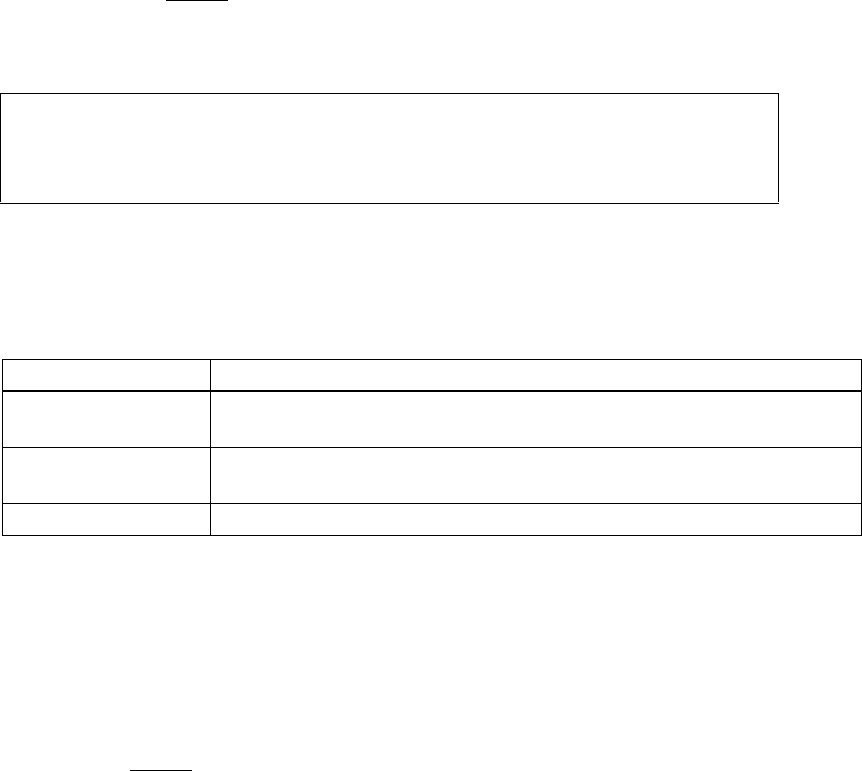
SYSTEM DESCRIPTION, INSTALLATION, AND MAINTENANCE MANUAL
eNfusion® HSD-440 Mark 2 Terminal
23-15-30 4-53
3 JUN 10
(j) Menu 30
Figure 4-12 shows an example HSD-440 Mark 2 Terminal MPU Menu 30 screen
display.
Table 4-16 describes some of the items available in Menu 30.
NOTE: For more information about PIM testing, refer to "Passive
Intermodulation (PIM) Test" on page 3-16.
MENU 30 FIRMWARE Vx.x GND
L list PIMBIT parameters M initiate manual PIMBIT
F fakeout PIMBIT parameters P initiate/stop PIMBIT
<CTRL> N next menu <CTRL> O previous menu = select reports
Figure 4-12 Menu 30 Screen Display
(6) Report Descriptions
When testing or troubleshooting the HSD-440 Mark 2 Terminal, monitoring real-time
system data is sometimes required. Figure 4-13 shows all the reports potentially
available to a Level 2 user.
Most reports are used for factory debugging purposes only. This document describes
only the reports typically used in the field for operational and fault isolation testing.
NOTE: Depending on the version of software installed, the MPU reports that appear
may differ from those shown as an example in Figure 4-13.
Table 4-16 Menu 30 Item Descriptions
Menu Item Item Description
L: list PIMBIT
parameters List the parameters used during PIM testing including transmit and receive
channel frequencies.
M: initiate manual
PIMBIT Start the manual PIM test. Do not use.
N: initiate/stop PIMBIT Start the automatic PIM test.

SYSTEM DESCRIPTION, INSTALLATION, AND MAINTENANCE MANUAL
eNfusion® HSD-440 Mark 2 Terminal
23-15-30 4-54
3 JUN 10
1 OFF OFF messages to card #1 13 OFF messages to card #2
2 OFF OFF hex output to card #1 14 OFF hex output to card #2
3 OFF OFF responses from card #1 15 OFF responses from card #2
4 OFF OFF hex input from card #1 16 OFF hex input from card #2
5 OFF OFF card #1 misc info 17 OFF card #2 misc info
6 OFF sb antenna arinc input 18 OFF port antenna arinc input
7 OFF sb antenna maintenance word 19 OFF port antenna maintenance word
8 OFF sb antenna status word 20 OFF port antenna status word
9 OFF channel card call status 21 OFF call codes
10 OFF channel card THA codes 22 OFF spot beam selection
11 OFF channel card errors 23 OFF standard output
12 OFF IRS input 24 OFF doppler, antenna az/el
Enter 1 thru 203 to toggle report on/off
X turn off all reports <CTRL> N show next page S save to EEPROM
ESC return to PREVIOUS MENU
25 OFF HPA arinc i/o 39 OFF combined-mode debugging
27 OFF HPA/channel card backoffs 40 OFF enthusiastic combined-mode debug
28 OFF miscellaneous digital inputs 41 OFF delta combined-mode debugging
29 OFF channel card A_AM msgs 43 OFF sdu path cable calibration
30 OFF multi-control arinc bus 44 OFF hpa calibration (gain droop)
31 OFF ocean region info 45 OFF combined mode ocean region debug
32 OFF hex input from data i/o 46 OFF hpa resets
33 OFF hex output to data i/o 47 OFF channel card temperature
34 OFF input from data i/o 48 OFF hexadecimal IRS input
35 OFF changes in multi-control bus 49 OFF main loop latency
36 OFF unit test call setup 50 OFF main loop timing
38 OFF combined-mode power allotment 51 OFF one second tick
Enter 1 thru 203 to toggle report on/off
X turn off all reports <CTRL> N show next page S save to EEPROM
ESC return to PREVIOUS MENU
52 OFF extended call codes 76 OFF HSD-X arinc messages
54 OFF multi-control time and date 77 OFF HSD-X net configuration
60 OFF OFF debug channel card power 78 OFF vt100 eirp/power
61 OFF non-zero channel card power 79 OFF dialtone debugging
62 OFF m4 availability status 86 OFF Channel card rx attenuation
64 OFF channel card frequencies 87 OFF interworking report
65 OFF enthusiastic messages from HPA 89 OFF debug call teardown
66 OFF channel card boot sequence 91 OFF HSD frequencies
67 OFF debug honeywell combined mode 92 OFF intermod debugging
68 OFF CFDS debugging 93 OFF spot beam debugging
69 OFF vt100 scenario 94 OFF vt100 channel card info
72 OFF DATA I/O events 95 OFF vt100 debugging
Enter 1 thru 203 to toggle report on/off
X turn off all reports <CTRL> N show next page S save to EEPROM
ESC return to PREVIOUS MENU

SYSTEM DESCRIPTION, INSTALLATION, AND MAINTENANCE MANUAL
eNfusion® HSD-440 Mark 2 Terminal
23-15-30 4-55
3 JUN 10
96 OFF IRS data rate 118 OFF channel card rf loopback
107 OFF unusual channel card msgs 119 OFF I2C controller i/o
108 OFF channel card rf pwr detect 120 OFF I2C controller hex i/o
109 OFF channel card power SU's 121 OFF I2C slave status
110 OFF underdraft debugging 122 OFF I2C miscellaneous input
111 OFF miscellaneous digital outputs 123 OFF enthusiastic backoff
112 OFF arinc labels 124 OFF PA mute debugging
113 OFF channel card sw loads 125 OFF PA BITE status
114 OFF all channel card THA codes 126 OFF calibrated power detectors
115 OFF OCXO state toggles 127 OFF power supply dc current
116 OFF DATA I/O passthrough mode 128 OFF VSWR monitoring
117 OFF output to data i/o (ascii) 129 OFF I2C output to PA
Enter 1 thru 203 to toggle report on/off
X turn off all reports <CTRL> N show next page S save to EEPROM
ESC return to PREVIOUS MENU
130 OFF misc temperatures 143 OFF next W'burg LDU
131 OFF duart channel hex input 144 OFF W'burg state changes
133 OFF LES access codes 145 OFF all input from CMU (hex)
134 OFF MCDU/WSC #1 arinc input 146 OFF periodic messages from CMU
135 OFF MCDU/WSC #2 arinc input 147 OFF arinc hex output to CMU
136 OFF arinc output to MCDU/WSC 148 OFF USIM heater control
137 OFF MCDU/WSC state machine 149 OFF AERO logging text -- no SU
138 OFF ascii digital inputs 150 OFF ACARS P-channel RX data
139 OFF W'burg messages to CMU 151 OFF all AERO SUs
140 OFF W'burg messages from CMU (hex) 152 OFF AERO msg acks
141 OFF W'burg messages from CMU 154 OFF non-periodic msgs to aero card
142 OFF lo-level W'burg labels from CMU 155 OFF AES status table queries
Enter 1 thru 203 to toggle report on/off
X turn off all reports <CTRL> N show next page S save to EEPROM
ESC return to PREVIOUS MENU
156 OFF MCDU driver errors 168 OFF channel card reset cycles
157 OFF ADC raw values 169 OFF CMC arinc in
158 OFF classic AERO call progress 170 OFF CMC arinc out
159 OFF AES status 171 OFF WSC data structs
160 OFF AERO SUs for this terminal 172 OFF CMC data structs
161 OFF 1252-A-3400 status 173 OFF vt100 CUG info
162 OFF vt100 mcdu 174 OFF BGAN registrations
163 OFF periodic messages to CMU 175 OFF Alt Discrete status
164 OFF enthusiastic digital inputs 176 OFF CP/SCM ORT I/O
165 OFF 615 data loader upgrades 178 OFF power bursts
166 OFF 615 data loader debugging 179 OFF channel card burst stats
167 OFF max 615 debugging 180 OFF channel card burst trace

Enter 1 thru 203 to toggle report on/off
X turn off all reports <CTRL> N show next page S save to EEPROM
ESC return to PREVIOUS MENU
181 OFF data i/o call reports 194 OFF PA reset cycles
182 OFF recovery after BGAN inert 195 OFF sys table protection algorithm
183 OFF debug CC#1 rx parser 199 OFF classic AERO call status
184 OFF debug CC#2 rx parser 202 OFF CFDS pages sent to CMC
185 OFF dio / cc call matchup 203 OFF generic HD710 faults
187 OFF antenna steering OLS labels
188 OFF over-power protection algorithm 1 OFF OFF messages to card #1
189 OFF expanded IRS input 2 OFF OFF hex output to card #1
190 OFF miscellaneous debugging 3 OFF OFF responses from card #1
191 OFF WSCI telephony 4 OFF OFF hex input from card #1
192 OFF CMU status words 5 OFF OFF card #1 misc info
193 OFF output to antenna controller 6 OFF sb antenna arinc input
SYSTEM DESCRIPTION, INSTALLATION, AND MAINTENANCE MANUAL
eNfusion® HSD-440 Mark 2 Terminal
23-15-30 4-56
3 JUN 10
Figure 4-13 HSD-440 Mark 2 Terminal MPU Reports
(7) Activating Maintenance Reports
To automatically generate report 23 (standard output) in Level 1 menu access, press
the EQUAL SIGN. The report data output is repeated on the computer display at
one-second intervals.
Level 2 maintenance access provides more flexibility in the use of the reports
function. This access level permits the activation or deactivation of any one of the
reports (toggle on and off).
(a) Reports General Guidelines
• To open the report menu, press EQUAL SIGN.
• To activate a report, type the number of the report needed, and then press
ENTER. This toggles on the report number entered. To toggle the report off,
type the report number again, and then press ENTER.
• To disable all reports (toggles all reports off), press X.
• To display the next group of reports, press CTRL+N.
• To save all selected reports to EEPROM, press S. The selected reports will
then be output automatically when the maintenance port is accessed. If the
items selected are not saved, they are de-activated when the system is reset
or power is cycled to the terminal.
• To start the scrolling report display, press ESC (in Level 2 access only). To
return to the menu selection screen, press ESC again.
(b) Report Descriptions
Not all the reports are used in the testing or troubleshooting of the system. This
section describes only the more commonly used reports.
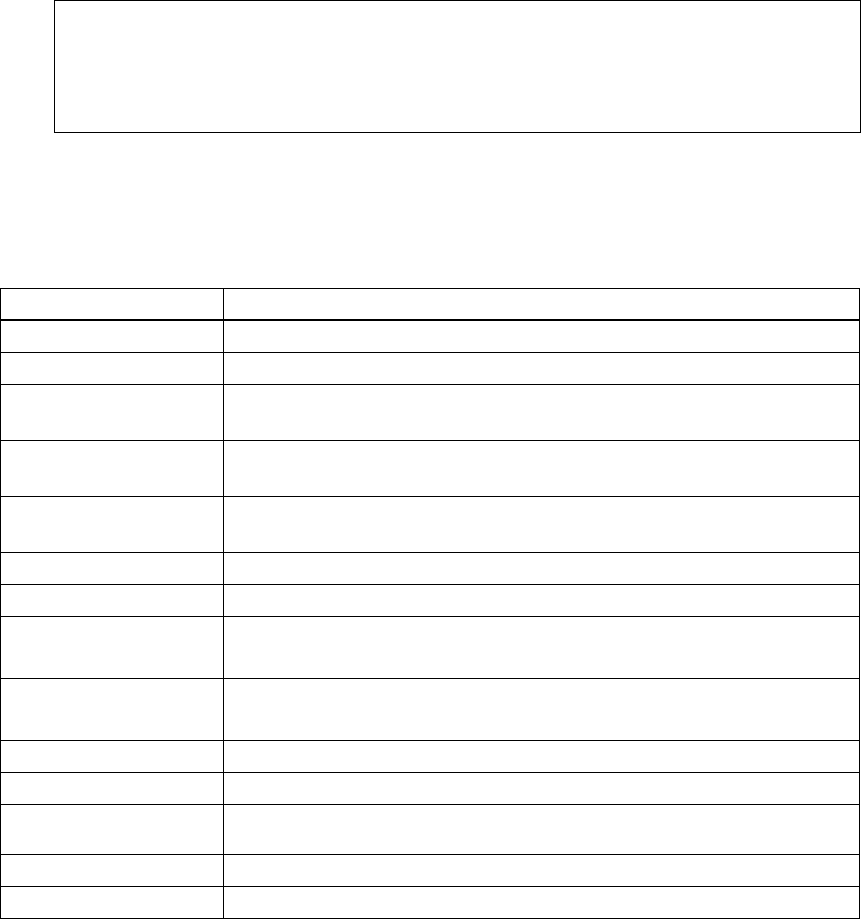
SYSTEM DESCRIPTION, INSTALLATION, AND MAINTENANCE MANUAL
eNfusion® HSD-440 Mark 2 Terminal
23-15-30 4-57
3 JUN 10
1. Reports 23 and 94
Report 23 is the most comprehensive report, giving a general impression of
the HSD-440 Mark 2 Terminal health. An example of the contents of report
23 is shown in Figure 4-14. Table 4-17 provides an example and a brief
description of the parameters. Each distinct parameter is numbered for
description purposes.
The output of report 23 scrolls continuously on screen and disrupts other
items on screen. Report 94 provides identical information that does not
disrupt other items on screen.
18:42:31 dop **** az 0.0 deg el 45.0 deg ant gain 12.0 (p/t)
CHAN #1: C/No=40.6 dB Hz sig=-42.4 dB 39.0 C no dial beam=255
CHAN #2: C/No=40.7 dB Hz sig=-41.4 dB 39.0 C no dial beam=255
CHAN #3: C/No= 0.0 dB Hz sig= 0.0 dB 38.0 C log off beam=0
CHAN #4: C/No= 0.0 dB Hz sig= -0.0 dB 39.0 C no call beam=0
44D0'0.3"N 74D51'8.8"W PT 0.0D RL 0.0D HD 83.9D TK 0.0D 0 knots ********
Figure 4-14 Example Report 23 Output
Table 4-17 Report 23 Item Descriptions
Report 23 Text Description
18:42:31 Time based on the system real time clock
dop **** Doppler frequency offset; increases with velocity (see note below)
az 0.0 deg Antenna azimuth pointing to the satellite, with respect to the nose of the
aircraft
el 45.0 deg Antenna elevation angle to the satellite, with respect to the horizontal
position of the aircraft
ant gain 12.0 (p/t) Reported antenna gain for the selected antenna: starboard (sbd) or port
(p/t)
CHAN #1: Indicates the channel card for which results 14 to 17 relate
C/No=40.6 dB Hz RF input Carrier-to-Noise (C/No) level; typically 50.0 to 55.0
sig=-42.4 dB RF input signal level; not to exceed 0 when in-call
Note: The signal level for channels 1, 2, 3,4, and 5 may be different.
39.0 C HSD-440 Mark 2 Terminal internal LRU temperature
Note: Operating the terminal above 55C is not recommended.
no dial System call status
beam=255 Satellite beam on which the card is registered
44D0'0.3"N
74D51'8.8"W IRS lat/long as interpreted by the HSD-440 Mark 2 Terminal
PT 0.0D Aircraft pitch angle, where UP is positive
RL 0.0D Aircraft roll angle, where clockwise is positive
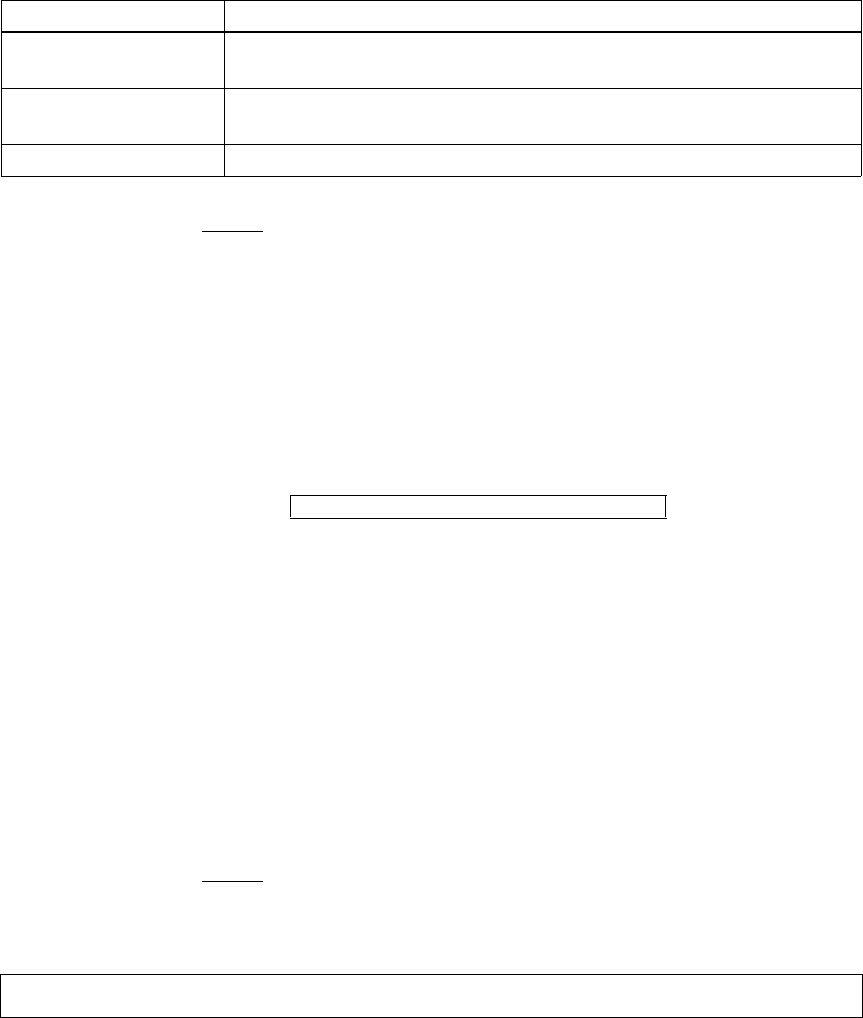
SYSTEM DESCRIPTION, INSTALLATION, AND MAINTENANCE MANUAL
eNfusion® HSD-440 Mark 2 Terminal
23-15-30 4-58
3 JUN 10
NOTE: When the aircraft is stationary, the field may appear as a series of
asterisks (*).
2. Reports 5 and 17
Report 5 displays information for channel card 1, and report 17 displays
information for channel card 2.
These reports are commonly used for testing and troubleshooting the system
and are only available to Level 2, maintenance access users.
You are prompted to select the channel(s) for which to generate a report:
Figure 4-15 Prompt to Select Channel for Report Generation
The options are:
• 1 for channel 1
• 2 for channel 2
• B for both channels
• X to deselect all channels
In report 17 for channel card 2, you can select channel 3, channel 4, both
channels, or deselect all channels.
NOTE: Depending on the version of software installed and the user's
selection of reports, the MPU reports displayed may differ from those
shown in the example in Figure 4-16.
CHAN #3: C/No= 0.0 dB Hz sig= 0.0 dB log off beam=0 bt=OK oc=NA
tx 0 Hz burst 0 38.0 C int=8080
Figure 4-16 Example of Report 17, Channel Card 2, Channel 3
3. Reports 8 and 20
Report 8 displays the status of the starboard antenna, and report 20 displays
the status of the port antenna.
HD 83.9D Aircraft true heading; where the nose of the aircraft is pointing, based on
yaw offset
TK 0.0D Aircraft true track; direction the aircraft is flying—not necessarily the
direction it is pointing (see note below)
0 knots Aircraft velocity
5 WHICH GAN CHANNEL (1,2,B,X) ?
Table 4-17 Report 23 Item Descriptions (Continued)
Report 23 Text Description
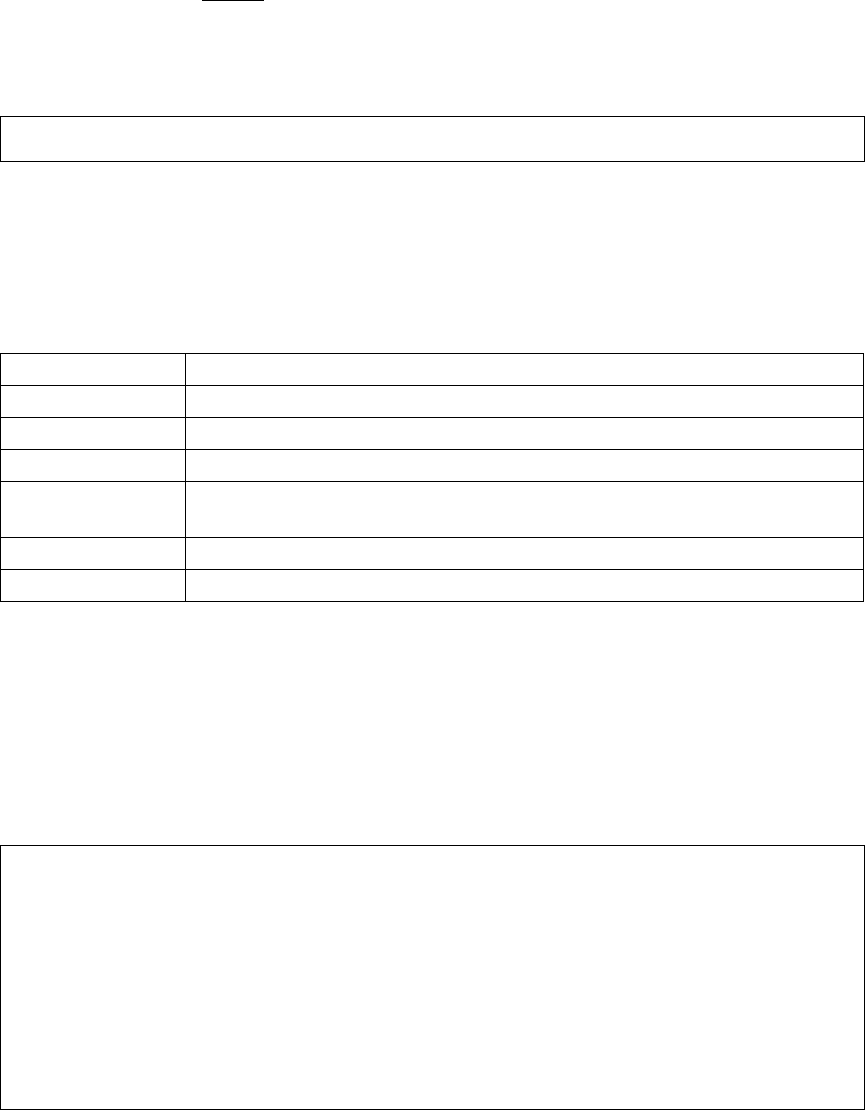
SYSTEM DESCRIPTION, INSTALLATION, AND MAINTENANCE MANUAL
eNfusion® HSD-440 Mark 2 Terminal
23-15-30 4-59
3 JUN 10
These reports are commonly used for testing and troubleshooting the system
and are only available to Level 2, maint access users.
NOTE: Depending on the version of software installed and the user's
selection of reports, the MPU reports displayed may differ from those
shown in the example in Figure 4-17.
port status $608033 SDI: ACU SSM: NORMAL gain=12.0
OMNIDIRECTIONAL MODE open loop tracking port/top active HGA LNA=on
Figure 4-17 Example of Report 20
Table 4-18 shows descriptions of the items in reports 8 and 20.
Table 4-18 Reports 8 and 20 Item Descriptions
Report 8 and 20 Starboard and Port Antenna Status
(Hex code) - Raw hex code of the 32-bit ARINC word—decoded message follows code
(SDI) - Antenna being used (for mechanically steered, only Port data is valid)
(SSM) - Antenna serviceability
(Gain) - Reported antenna gain (may vary with increased blockage or keyhole
pointing)
(Mode) - Reports tracking status, antenna selection, and high gain mode
(LNA) - Power-on status
4. Report 21
Report 21 displays the call code information for the HSD-440 Mark 2
Terminal.
Figure 4-18 shows an example of report 21. Table 4-19 describes the items
in report 21.
23:48:36 #1 123ABC E4 start 400110 14.00 dBW CT SP ocean region registration
41.5 C 51 dB Hz
23:48:39 #1 123ABC E4 stop 8301 ACSE successful ORR 41.5 C 51 dB Hz
23:49:20 #2 456DEF E5 start 400110 14.00 dBW CT SP ocean region registration
41.5 C 52 dB Hz
23:49:24 #2 456DEF E5 stop 8306 ACSE failed retry ORR 41.5 C 51 dB Hz
23:49:27 #2 456DEF E5 start 400110 14.00 dBW CT SP ocean region registration
41.5 C 52 dB Hz
23:49:32 #2 456DEF E5 stop 8306 ACSE failed retry ORR 41.5 C 51 dB Hz
23:49:36 #2 456DEF E5 start 400110 14.00 dBW CT SP ocean region registration
41.5 C 51 dB Hz
23:49:40 #2 456DEF E5 stop 8301 ACSE successful ORR 41.5 C 52 dB Hz
Figure 4-18 Example Report 21
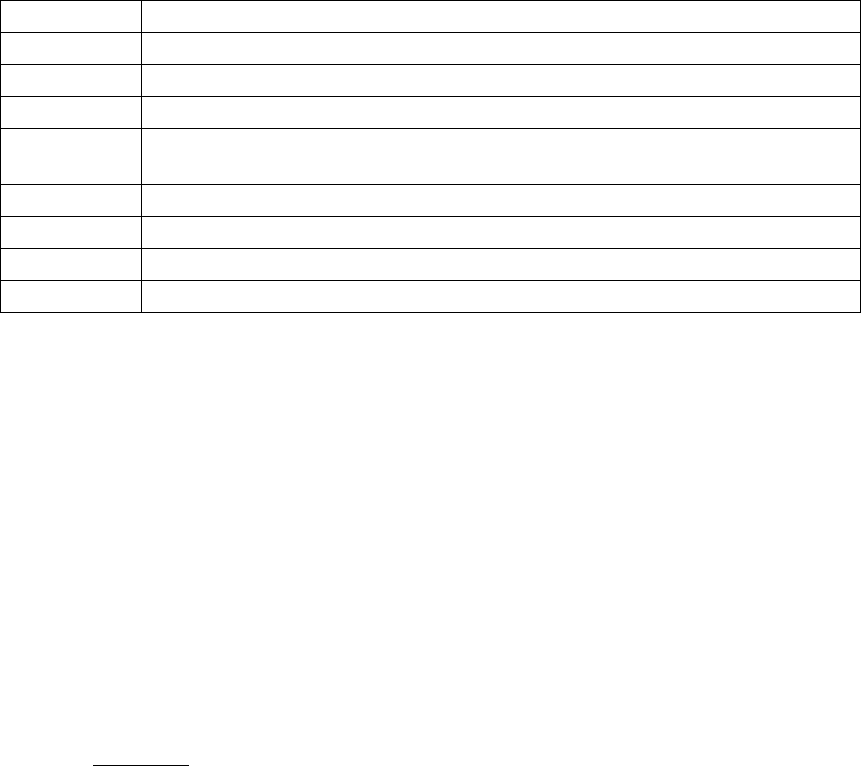
Table 4-19 Report 21 Item Descriptions
Report 21 Call Codes
(Time) - Time based on the system real time clock
(Fwd Addr) - Forward address ID assigned to the system channel cards
(Alpha/no.) - OR and beam the card is logged on to
(Call) - Call real-time status, service type code, and Inmarsat Cause Code (see Appendix
H: Inmarsat Cause Codes on page H-1)
(RF power) - LES/GES requested HPA power in dBW
(OR status) - OR registration status
(Call orig) Call originating from MES or from a fixed location
(Call type) Call types (for example, speech)
SYSTEM DESCRIPTION, INSTALLATION, AND MAINTENANCE MANUAL
eNfusion® HSD-440 Mark 2 Terminal
23-15-30 4-60
3 JUN 10
D. Inmarsat Cause Codes
The fault definitions that appear in the HSD-440 Mark 2 Terminal maintenance menu
logs are based directly on the cause code definitions provided by Inmarsat. Appendix H:
Inmarsat Cause Codes on page H-1 defines the maintenance port menu fault codes of
the HSD-440 Mark 2 Terminal.
E. Operational and Diagnostic Test Procedures
You can perform all test procedures presented in this section to test the total operational
status of the HSD-440 Mark 2 Terminal. You can conduct these operational tests for all
terminals returned to service after repair.
The procedures assume that the technical personnel are familiar with the test equipment
used and can operate the equipment to produce the required inputs and obtain the
required results (indications). Refer to the detailed operating procedures and descriptions
of the HSD-440 Mark 2 Terminal MPU included in this section.
CAUTION: ONLY AUTHORIZED TECHNICAL PERSONNEL WHO ARE TRAINED IN
GENERAL AVIATION WORKMANSHIP AND HAVE A BASIC
UNDERSTANDING OF SATCOM SYSTEMS SHOULD PERFORM THE
OPERATIONAL AND DIAGNOSTIC TEST PROCEDURES IN THIS
MANUAL.
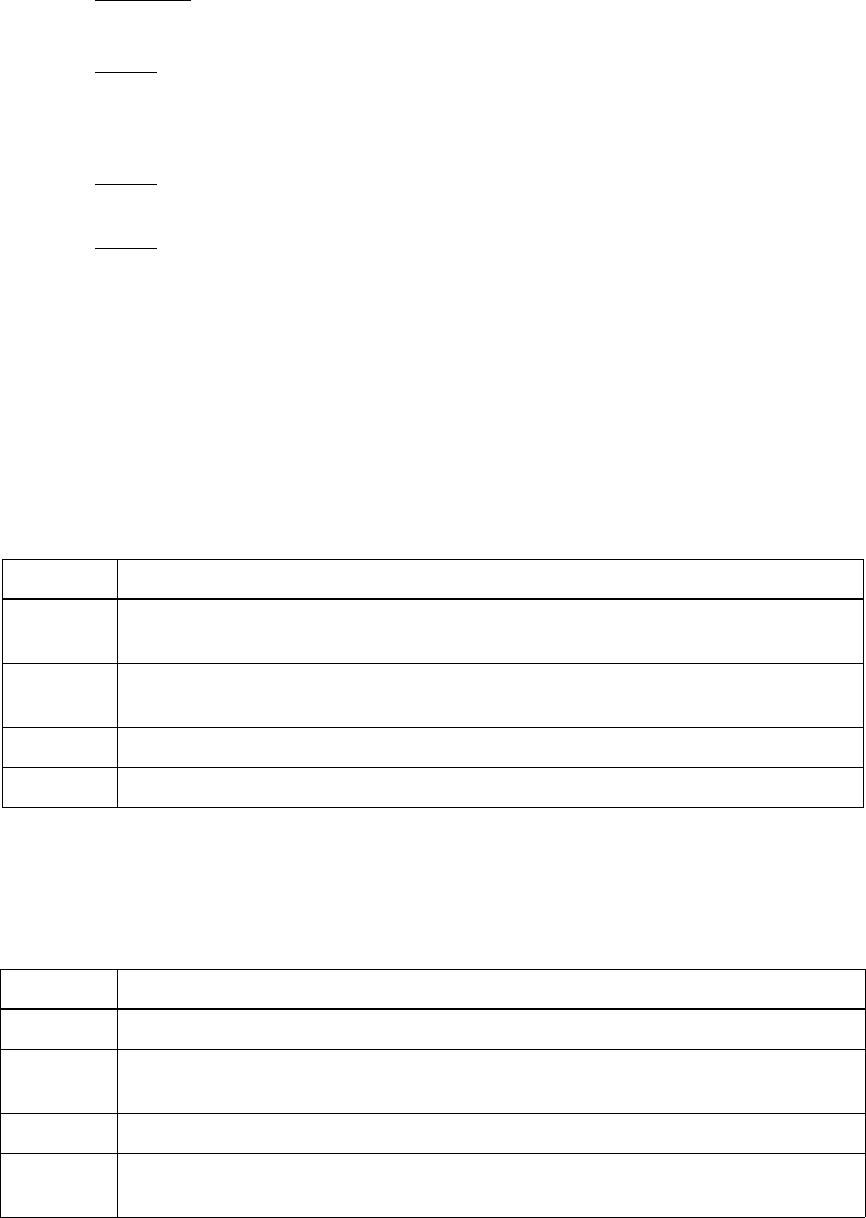
SYSTEM DESCRIPTION, INSTALLATION, AND MAINTENANCE MANUAL
eNfusion® HSD-440 Mark 2 Terminal
23-15-30 4-61
3 JUN 10
CAUTION: CHANGES TO DEFAULT VALUES FOR SOME MENU FUNCTIONS MAY
SERIOUSLY DEGRADE SYSTEM OPERATION.
NOTE: This manual describes the basic MPU functions, menus, and reports required
for the testing and fault isolation procedures presented in this section. Please
consult Honeywell Product Support before entering any unfamiliar menu
selections not described in this manual.
NOTE: Using a terminal emulation program, open a log file and save all test results for
future reference and test records.
NOTE: The procedures presented in this section aid technical personnel in upgrading,
maintaining, or troubleshooting an HSD-440 Mark 2 Terminal. Maintenance
does not imply lubrication or adjustment activities.
Refer to the Outline and Installation diagrams and the Interconnection and Contact
Assignment drawings presented in "Installation" on page 3-1 for additional information.
(1) Test Setup Procedure
The test setup procedure is presented in Table 4-20. For detailed connection of test
equipment and operating instructions for the HSD-440 Mark 2 Terminal MPU, see
"Terminal Maintenance Port Utility" on page 4-36
Table 4-20 Test Setup Procedure
Step Action
1.0 Make sure that the HSD-440 Mark 2 Terminal is powered down and disconnected
from the power source.
2.0 Connect a maintenance cable to the HSD-440 Mark 2 Terminal front-panel or remote
maintenance port connector.
3.0 Connect the other end of the cable to the serial port of the computer.
4.0 Open a log file to capture all test data.
(2) Post Test
When testing is completed, follow the steps in Table 4-21.
Table 4-21 Post Test Procedure
Step Action
1.0 Save the log file of the test results (or data) for future reference.
2.0 Remove power from the HSD-440 Mark 2 Terminal that was tested and from all
other test equipment.
3.0 Disconnect test equipment from the HSD-440 Mark 2 Terminal.
4.0 Replace the maintenance-port connector cover (if it was removed during the test
setup).
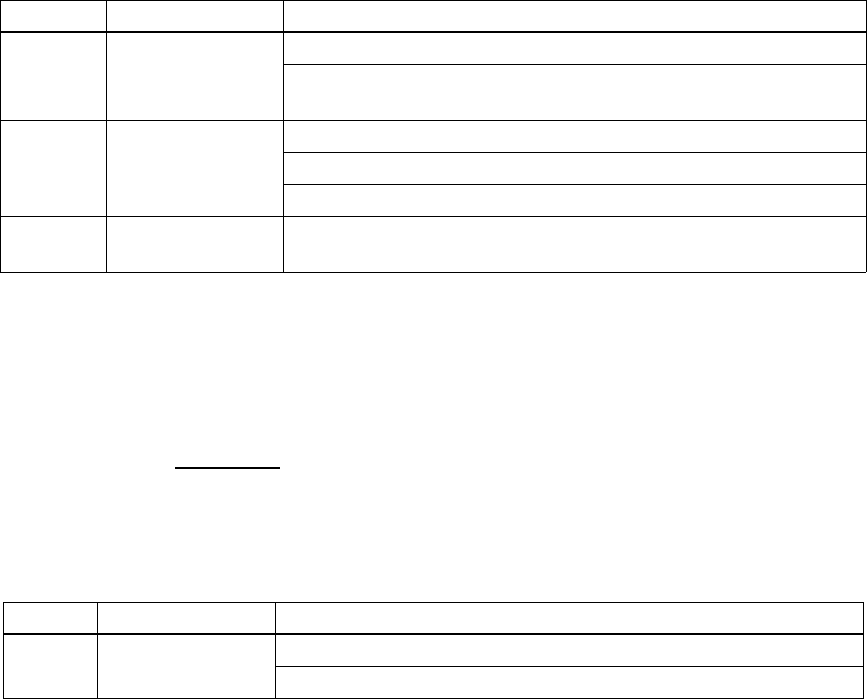
SYSTEM DESCRIPTION, INSTALLATION, AND MAINTENANCE MANUAL
eNfusion® HSD-440 Mark 2 Terminal
23-15-30 4-62
3 JUN 10
(3) Installation and Operational Verification Tests
The test procedures assume that an approved ARINC 741 compatible antenna
subsystem has been completely installed and tested as per the manufacturer's
instructions.
To facilitate and document the installation of the equipment, refer to "Installation
Checklist" on page E-1.
(a) Pre Power-up Checks
Carry out all mechanical and electrical verification tests in the systematic order
presented in this document.
(b) Mechanical Verification
Refer to "Installation" on page 3-1 for detailed mechanical information.
Table 4-22 itemizes recommended mechanical checks.
Table 4-22 HSD-440 Mark 2 Terminal Mechanical Verification
STEP Item Checked Verification Description
1. 0 Mounting tray
Physical
placement
Make sure that service/maintenance ports are accessible.
Check that environmental characteristics and specifications are
met, including cooling, air-flow, and pressure
2. 0 Fan tray Confirm plug configuration is correct.
Check chassis bonding.
Make sure that fan rotation is unobstructed and rotates freely.
3. 0 ARINC 600
connector Check polarized pins.
(c) Electrical Verification
Refer to "Installation" on page 3-1 for detailed electrical information. Table 4-23
itemizes the recommended electrical checks.
When conducting the following tests, do not rack the HSD-440 Mark 2 Terminal.
WARNING: TO AVOID PERSONAL INJURY AND/OR EQUIPMENT
DAMAGE, USE EXTREME CAUTION DURING THE VOLTAGE
LEVEL MEASUREMENTS.
Table 4-23 HSD-440 Mark 2 Terminal Electrical Verification Checklist
STEP Item Checked Verification Description
1.0 Power connections 28 V dc polarity or 115 V ac polarity
Chassis ground @ BP8—resistance measurement
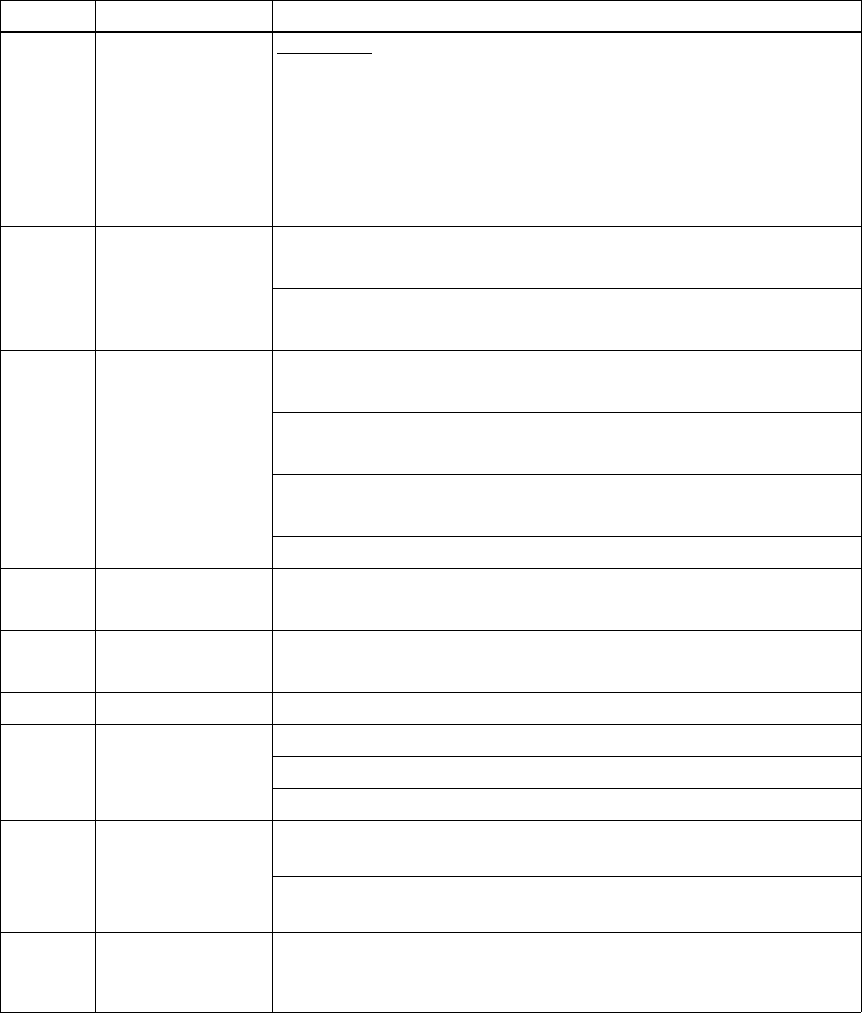
SYSTEM DESCRIPTION, INSTALLATION, AND MAINTENANCE MANUAL
eNfusion® HSD-440 Mark 2 Terminal
23-15-30 4-63
3 JUN 10
(4) Configuration Parameters Verification
You can verify the system configuration parameters. For additional connection and
access information, see "Connection Requirements" on page 4-37. Verify and
document the parameters using the lists in "Installation Checklist" on page E-1.
2.0 Voltage levels CAUTION: WHEN POWER IS APPLIED TO THE RACK, THE
FAN ENERGIZES.
Check voltage levels:
28 V dc: between BP2 (positive) and BP3 (return)
or
115 V ac: between BPI (115-H) and BP7 (115-C)
3.0 IRS Input IRS wiring:
Inertial system wired to TP4J (A) and TP4K (B)
IRS format:
ARINC 429 Interface
4.0 Configuration
Strap Pins SDI:
Strapped for HGA, Pin TP5B to TP5D
System configuration:
Figure 3-9 and Figure 3-10
ICAO ID:
User specific address obtained from the aircraft registration
WOW: optional
5.0 Ethernet 1 and 2 Wired or strapped to RJ45 distribution points
Optional—other service may be preferred
6.0 ISDN 1 Wired or strapped to RJ45 distribution points
Optional—other service may be preferred
7.0 CEPT-E1 Wired to CTU - optional
8.0 Remotes
(optional but
recommended)
Remote reset switch
Maintenance port, remote access
Power and fault indicators
9.0 RF coaxial Rx input cable loss from DLNA J2 to HSD-440 Mark 2 Terminal at
BP12
Tx output cable loss from HSD-440 Mark 2 Terminal at MPC1 to
DLNA J3
10.0 Multi-control and
BITE from antenna
subsystem
Antenna manufacturer and model
Multi-Control loopbacks installed at TP3E and TP3F
Table 4-23 HSD-440 Mark 2 Terminal Electrical Verification Checklist (Continued)
STEP Item Checked Verification Description
SYSTEM DESCRIPTION, INSTALLATION, AND MAINTENANCE MANUAL
eNfusion® HSD-440 Mark 2 Terminal
23-15-30 4-64
3 JUN 10
(a) Parameter Verification Procedure
• From Menu 3, press H (list SCM/CP ORT), and then press 1 (CP EEPROM
ORT).
The ORT listing appears on the screen, as shown in Figure 4-19. Verify that the
correct system configuration parameters are listed in the ORT.

SYSTEM DESCRIPTION, INSTALLATION, AND MAINTENANCE MANUAL
eNfusion® HSD-440 Mark 2 Terminal
23-15-30 4-65
3 JUN 10
0 lists SCM ORT -- 1 lists CP EEPROM ORT -- 2 lists CP ORT OPTIONS ?
CP EEPROM ORT: ID A8E09293 VERSION 30026
4-WIRE #1 NOISE LEVEL: -50 SET BY MCDU
4-WIRE #1 SPEAKER LEVEL: 50 SET BY MAINT PORT
4-WIRE #1 MIC LEVEL: 70 SET BY MAINT PORT
4-WIRE #1 SIDETONE LEVEL: 50 SET BY MCDU
4-WIRE #2 NOISE LEVEL: -50 SET BY MAINT PORT
4-WIRE #2 SPEAKER LEVEL: 50 SET BY MAINT PORT
4-WIRE #2 MIC LEVEL: 70 SET BY MAINT PORT
4-WIRE #2 SIDETONE LEVEL: 50 SET BY MAINT PORT
MCDU TYPE: HONEYWELL NOT DEFAULT SET BY MAINT PORT
HSD SAL: 307 SET BY MAINT PORT
LOG-ON/HANDOVER POLICY: MANUAL NOT DEFAULT SET BY MAINT PORT
HIGH RATE R/T IN GLOBAL BEAM: DISABLED SET BY MAINT PORT
RESPONSE TO LOG-ON INTERROGATION: DISABLED SET BY MAINT PORT
CMU INPUTS SPEED SELECT: LOW RATE SET BY MAINT PORT
FORWARD ID: 123ABC NOT DEFAULT SET BY MAINT PORT
AIR/GROUND STATUS RESTRICTIONS: DISABLED SET BY MAINT PORT
HSD (HPA) - ANTENNA LOSS: 2.5 dB SET BY MAINT PORT
HIT 'H' for MORE
MAINT CMD EXECUTION IN AIR: DISABLED SET BY MAINT PORT
TRANSMIT ON GROUND: DISABLED SET BY MAINT PORT
MCDU/WSCI #1 WIRED: YES SET BY MAINT PORT
MCDU/WSCI #2 WIRED: YES SET BY MAINT PORT
MCDU/WSCI #3 WIRED: NO SET BY MAINT PORT
CMU #1 WIRED: YES SET BY MAINT PORT
CMU #2 WIRED: NO NOT DEFAULT SET BY MAINT PORT
A/C GNSS EQUIPMENT: GPS SET BY MAINT PORT
PRIMARY IRS TYPE: INERTIAL SET BY MAINT PORT
SECONDARY IRS TYPE: AES ID NOT DEFAULT SET BY MAINT PORT
CMC TYPE: BOEING SET BY MAINT PORT
MCDU/WSCI CONTROLLER TYPE: MCDU SET BY MAINT PORT
MCDU/WSCI INPUT SPEED: LOW RATE SET BY MAINT PORT
MCDU/WSCI OUTPUT SPEED: LOW RATE NOT DEFAULT SET BY MAINT PORT
SECONDARY IRS INPUT SPEED SELECT: HIGH RATE SET BY MAINT PORT
COCKPIT CALL SIGNALLING MODE: CD1/CD2 DISCRETE NOT DEFAULT SET BY MAINT PORT
INSTALLED DIPLEXER TYPE: TYPE F SET BY MAINT PORT
HIT 'H' for MORE
ANTENNA TYPE: ARINC 741 HGA, TOP MOUNT SET BY MAINT PORT
ALLOW MANUAL DIAL: ENABLED SET BY MAINT PORT
SELF-TEST IN AIR: ENABLED NOT DEFAULT SET BY MAINT PORT
ANTENNA MOUNTING ROTATION ANGLE: 0.0 deg SET BY MAINT PORT
ANTENNA MOUNTING PITCH ANGLE: 0.0 deg SET BY MAINT PORT
ANTENNA MOUNTING ROLL ANGLE: 0.0 deg SET BY MAINT PORT
CMU-SDU HARD CODED SAL: NO NOT DEFAULT SET BY MAINT PORT
MCDU PAST: ENABLED SET BY MAINT PORT
CMU-SDU JOIN/LEAVE WORD TRANSMISSION: PERIODIC SET BY MAINT PORT
NUMBER CG-710 INSTALLED: 0 SET BY MAINT PORT
NUMBER CR-710 INSTALLED: 0 SET BY MAINT PORT
CARD #1 SBB/S64 PRIORITY: "SWIFTBROADBAND CLASS 6 REVERTING TO SWIFT64" SET BY MAINT PORT
SWIFTBROADBAND TIMING MODE: NOT ASSISTED SET BY MAINT PORT
SW FIELD LOADABLE: ENABLED NOT DEFAULT SET BY MAINT PORT
SERVICE TYPE PRIORITY: PUBLIC CORRESPONDENCE SET BY MAINT PORT
CEPT E1 WIRED: YES SET BY MAINT PORT
CMC WIRED: YES NOT DEFAULT SET BY MAINT PORT
HIT 'H' for MORE
CMC MASK FAULT: DISABLED SET BY MAINT PORT
MASK POSITION IN LOGS: DISABLED SET BY MAINT PORT
ICAO CODE SOURCE: STRAP SET BY MAINT PORT
CMU OUTPUT SPEED SELECT: LOW RATE SET BY MAINT PORT
POTS SERVICE: ENABLED SET BY MAINT PORT
CEPT E1 INTERFACE TYPE: ARINC 746 SET BY MAINT PORT
GROUND TO COCKPIT CALL ROUTING PREFERENCE: 4-WIRE #2 NOT DEFAULT SET BY MAINT PORT
GROUND PUBLIC ROUTING PREFERENCE: COCKPIT NOT DEFAULT SET BY MAINT PORT
4-WIRE #2 WIRED: YES NOT DEFAULT SET BY MAINT PORT
ETHERNET #1 WIRED: NO NOT DEFAULT SET BY MAINT PORT
ETHERNET #2 WIRED: YES SET BY MAINT PORT

SYSTEM DESCRIPTION, INSTALLATION, AND MAINTENANCE MANUAL
eNfusion® HSD-440 Mark 2 Terminal
23-15-30 4-66
3 JUN 10
MCDU FONT COLOUR: ENABLED NOT DEFAULT SET BY MAINT PORT
COCKPIT OUTGOING CALL SIGNALING: DISABLED SET BY MAINT PORT
COCKPIT OUTGOING CALL PRE-SELECT: ENABLED SET BY MAINT PORT
PIMBIT AZIMUTH OFFSET ANGLES: SET BY MAINT PORT
HGA = 11.0 DEG NOT DEFAULT
IGA = 15.0 DEG NOT DEFAULT
PIMBIT IGA ELEVATION ANGLES: SET BY MAINT PORT
ANGLE 1 = 18.0 DEG NOT DEFAULT
ANGLE 2 = 12.5 DEG NOT DEFAULT
PIMBIT HGA ELEVATION ANGLES: SET BY MAINT PORT
ANGLE 1 = 27.6 DEG NOT DEFAULT
ANGLE 2 = 12.5 DEG NOT DEFAULT
HIT 'H' for MORE
PIMBIT TEST CRITERIA: SET BY MAINT PORT
MEASUREMENT DISCARD RATIO = 25.5% NOT DEFAULT
FAILURE THRESHOLD = 25.5 dB NOT DEFAULT
POINTING FAILURE THRESHOLD = 255 NOT DEFAULT
HIT 'H' for MORE
DIO BLOCK: 86 BYTES -- TYPE 1 CRC D3CD
de 8e 6a 67 00 50 de 96 e9 74 00 39 1c b6 5b b5 ..jg.P...t.9..[.
0c 8f 09 6e 1c d2 5b 2e de 92 88 f0 00 09 0c 96 ...n..[.........
e8 62 87 a2 fc f4 79 de ce eb 70 00 0e ac d3 2c .b....y...p....,
29 c0 a8 00 05 9b d3 2c 30 00 a1 de 82 6d 30 00 )......,0....m0.
04 1c d2 69 6e de c3 0b e5 00 0b c7 86 3b ad 06 ...in........;..
44 61 74 61 49 4f DataIO
ETHERNET 1 ADDRESS 192.168.0.1
ETHERNET 1 MASK 255.255.255.0
ETHERNET 2 ADDRESS 0.0.0.0
ETHERNET 2 MASK 255.255.255.0
DHCP CLIENT DISABLED
HOST NAME DataIO
DHCP SERVER DISABLED
START OF MANAGED RANGE 192.168.0.100
SNMP SERVER ENABLED
SNMP COMMUNITY STRING public
NUMBER OF MANAGED ADDRESSES 50
TFTP SERVER DISABLED
ETHERNET DUPLEX MODE 0
TELNET ACCESS ENABLED
ALLOW SCPC SESSIONS TRUE
ALLOW MPDS SESSIONS TRUE
ALLOW BGAN SESSIONS TRUE
ACCESS CONCENTRATOR NAME DataIO
DEFAULT PPPOE SERVICE PacketData
ACCESS POINT NAME
AT WELCOME MESSAGE
HIT 'H' for MORE
VP BLOCK: MISSING
TOOL VERSION = XXXX
TOOL NAME = EMBEDDED ORT TOOL
TOOL PART NUMBER = jaytool
SECURE ORT PART NUMBER = sss123
USER ORT PART NUMBER = uuu456
SATELLITE TABLE:
REGION 0: AORW (W) 52.0W CLASSIC AERO SWIFT64
REGION 1: AORE (E) 15.5W CLASSIC AERO SWIFT64
REGION 2: POR (P) 178.0E CLASSIC AERO SWIFT64
REGION 3: IOR (I) 64.0E CLASSIC AERO SWIFT64
REGION 4: MTSAT (4) 142.5E CLASSIC AERO
REGION 5: APAC (5) 143.5E CLASSIC AERO BGAN
REGION 6: EMEA (6) 25.0E CLASSIC AERO BGAN
REGION 7: AMERICAS (7) 98.0W CLASSIC AERO BGAN

SYSTEM DESCRIPTION, INSTALLATION, AND MAINTENANCE MANUAL
eNfusion® HSD-440 Mark 2 Terminal
23-15-30 4-67
3 JUN 10
Figure 4-19 HSD-440 Mark 2 Terminal ORT Display Example
LES INFORMATION:
AORW: LES 2 NETWORK ID 0 LES 2
AORE: LES 2 NETWORK ID 0 NO NAME
POR: LES 2 NETWORK ID 0 NO NAME
IOR: LES 2 NETWORK ID 0 NO NAME
SATELLITE FREQUENCY TABLE:
REGION 0: GLOBAL BEAM FREQS: $FFFF,$FFFF AERO PSID FREQS: $3702,$6B8 NCS FREQS: $24EC,$4EC
REGION 1: GLOBAL BEAM FREQS: $FFFF,$FFFF AERO PSID FREQS: $36FE,$6B6 NCS FREQS: $2504,$B60
REGION 2: GLOBAL BEAM FREQS: $FFFF,$FFFF AERO PSID FREQS: $36B4,$700 NCS FREQS: $FFFF,$FFFF
REGION 3: GLOBAL BEAM FREQS: $FFFF,$FFFF AERO PSID FREQS: $36B2,$6FC NCS FREQS: $FFFF,$FFFF
REGION 4: GLOBAL BEAM FREQS: $FFFF,$FFFF AERO PSID FREQS: $38F7,$8F7 NCS FREQS: $FFFF,$FFFF
REGION 5: GLOBAL BEAM FREQS: $2AF2,$2A AERO PSID FREQS: $36DA,$6DA NCS FREQS: $FFFF,$FFFF REGION 6:
GLOBAL BEAM FREQS: $2BA0,$9E AERO PSID FREQS: $36DE,$6DE NCS FREQS: $FFFF,$FFFF
REGION 7: GLOBAL BEAM FREQS: $2A4C,$4 AERO PSID FREQS: $36DC,$6DC NCS FREQS: $FFFF,$FFFF
HIT 'H' for MORE
GES PRIORITY TABLE:
ENTRY #1 AORW Aussaguel (GES 5) PRIORITY 5
ENTRY #2 AORW Eik (GES 2) PRIORITY 5
ENTRY #3 AORE Aussaguel (GES 103) PRIORITY 5
ENTRY #4 AORE Eik (GES 104) PRIORITY 5
ENTRY #5 POR Perth (GES 205) PRIORITY 5
ENTRY #6 POR Santa Paula (GES 202) PRIORITY 5
ENTRY #7 IOR Perth (GES 305) PRIORITY 5
ENTRY #8 IOR Eik (GES 301) PRIORITY 5
ENTRY #9 APAC Hawaii (GES 120) PRIORITY 5
ENTRY #10 EMEA Fucino (GES 220) PRIORITY 5
ENTRY #11 AMERICAS Hawaii (GES 320) PRIORITY 5
ENTRY #12 MTSAT Kobe (GES 161) PRIORITY 5
PHONE BOOK CATEGORY 1 (CATEGORY01):
95 AAAAB 0016135919208 OP-LO
96 JJJJJJ 666666 OP-LO
97 CCCC 5555 OP-LO
98 QQQQQQ 55555555 NON-OP
99 ALPHATEXT 999999 OP-LO
100 DDDDD 99999 OP-LO
PHONE BOOK CATEGORY 2 (CATEGORY02):
91 HHHHH 22222 OP-LO
92 KKKKKK 11111 OP-LO
94 BBBA 22222 OP-LO
95 CCCC 9999 OP-LO
96 AAAAB 11111 OP-LO
97 LLLLL 33333 OP-LO
98 AAAAA 22222 OP-LO
99 AAAA 66666 OP-LO
100 01-NUM IN CAT2 0116135601122 OP-HI
PHONE BOOK CATEGORY 3 (CATEGORY03):
96 BBBBB 88888 OP-LO
97 AAAAC 2222 OP-LO
98 BBBBA 22222 OP-LO
99 AAAAA 22222 OP-LO
100 01-NUM IN CAT3 0116135601123 OP-LO
PHONE BOOK CATEGORY 4 (CATEGORY04):
95 AAAAAB 77777 OP-LO
96 CCCCC 11114 OP-LO
97 AAAAC 33333 OP-LO
99 AAAA 5555 OP-LO
100 01-NUM IN CAT4 0116135601124 NON-OP
DONE

SYSTEM DESCRIPTION, INSTALLATION, AND MAINTENANCE MANUAL
eNfusion® HSD-440 Mark 2 Terminal
23-15-30 4-68
3 JUN 10
(5) System Power-up Checks
NOTE: Before proceeding, make sure that all pre power-up, mechanical, and
electrical verifications have been successfully performed and documented
using "Installation Checklist" on page E-1.
(a) Preparation
The following tests serve primarily to confirm proper system power-up; therefore,
they can be performed while the aircraft is still in the hangar. Make sure that a
computer is available for testing.
(b) Initial Visual LED Verification
The system's Power On and Fault LEDs provide a visual status indication on the
HSD-440 Mark 2 Terminal front panel and on the optional remote panel.
To visually verify LEDs:
1. Verify that the LED indicators (at both locations) repeatedly cycle on/off when
power is applied.
2. Once the cycle has completed (~5 seconds), verify that the LED power
indicator remains illuminated.
(c) Initial Computer Power up Display
With the computer connected and configured to accept maintenance port data,
power-up the HSD-440 Mark 2 Terminal, and verify the initial power-up screen
displays, as shown in Figure 4-20.

SYSTEM DESCRIPTION, INSTALLATION, AND MAINTENANCE MANUAL
eNfusion® HSD-440 Mark 2 Terminal
23-15-30 4-69
3 JUN 10
KERNEL V1.7 -- Wed Mar 24 13:09:23 2010
TESTING RAM ......RAM OK.
CONFIDENTIAL PROPERTY OF EMS TECHNOLOGIES CANADA, LTD.
USE AND DISTRIBUTION LIMITED SOLELY TO AUTHORIZED PERSONNEL.
The use, disclosure, reproduction, modification, transfer or transmittal of
this work for any purpose, in any form, or by any means without the written
permission of EMS Technologies Canada, Ltd. is strictly prohibited.
Copyright 2010 EMS Technologies Canada, Ltd. All Rights Reserved
HSD APPLICATION V22.006 -- Wed Apr 07 10:01:30 2010
CMC INTERFACE: SUPPORTED WSC INTERFACE: SUPPORTED
VALIDATING DETECTOR CALIBRATION TABLES.... OK
VALIDATING ATTENUATOR CALIBRATION TABLE AT $608000.... OK
RAM RUN-TIME DATABASE
OCEAN REGION SAT LONG LES ID TNID SERVICES
**W AORW (region #0) 54.0W 2 0 SW64/AERO
**E AORE (region #1) 15.0W 2 0 SW64/AERO
**P POR (region #2) 178.5E 2 0 SW64/AERO
**I IOR (region #3) 64.5E 2 0 SW64/AERO
**4 MTSAT (region #4) 142.5E AERO
**5 APAC (region #5) 144.0E AERO/SBB
**6 EMEA (region #6) 25.5E AERO/SBB
**7 AMERICAS (region #7) 97.5W AERO/SBB
** LONGITUDE UPDATED FROM AERO BULLETIN BOARDS
REAL TIME CLOCK PRESENT: 12:50:18 Wed Jan 2, 2001
FORWARD ID TABLE -- VERSION 1
CHANNEL #1 FORWARD ID 442BF5
4.7 SECONDS: STAND-ALONE MODE
FIRMWARE VERSIONS:
KERNEL: V1.7 -- Wed Mar 24 13:09:23 2010
APPLICATION: V22.006 -- Wed Apr 07 10:01:30 2010
CHANNEL CARD #1: 4.9.G.0 -- 1.0.2.0 -- 2.1.0.0 -- 4.2.3.0
CHANNEL CARD #2: 31.5.0.1 --
DATA I/O CARD: Version 1.87.0.0 built on Mar 16 2010 12:15:16
VOICE PROCESSOR: Version 1.2.3.DEV built on Mar 31 2010 at 23:27:20
VP BOOT LOADER: Version 1.2.1 built on Wednesday October 21 2009 at 14:04:24
SPOTBEAM TABLE: PROVIDED BY SATELLITE
CHANNEL CARD STATISTICS
CARD #1 BGAN 6X (SERIAL 6203):
3036.1 hrs powered 266.6 hrs in call since 10:40:26 Feb 12, 2009
CARD #2 CLASSIC AERO (SERIAL 36500):
2635.1 hrs powered 1507.3 hrs in call since 10:17:37 Feb 27, 2001
BGAN INTERFACE IMEI SVN IMSI
CARD #1 12345678912345 01 987654321123456
CHECKING FLASHPROM CONFIGURATION .............
HARDWARE:
PART NUMBER REVISION
EMS: 1252-A-3800-01 A01

SYSTEM DESCRIPTION, INSTALLATION, AND MAINTENANCE MANUAL
eNfusion® HSD-440 Mark 2 Terminal
23-15-30 4-70
3 JUN 10
Figure 4-20 HSD-440 Mark 2 Terminal Power-Up Display Example
(6) System On-Air Checks
Conduct system on-air checks to confirm voice and data call capabilities through the
satellite and ground station network. Additional testing confirms that proper signal
level parameters are obtained through the antenna subsystem.
(a) Preparation
Before attempting on-air testing procedures:
1. Complete and confirm all service provider registration and activation.
2. Complete and document all pre power-up and power-up checks.
3. Position the aircraft outside, away from all obstructions in the line-of-sight to
the satellite.
4. Apply the aircraft power source.
5. Power on and wait for the IRS to align.
6. Connect a computer (with a terminal emulation program) to the HSD-440
Mark 2 Terminal maintenance port.
NOTE: Several system parameters, such as IRS data, RF signal quality,
and logon messaging, appear on the maintenance port display.
Capture and save this maintenance port information to a file for later
review or to serve as a historical test record.
(b) On-Air Power up and Logon Procedure
For this test procedure, use the Level 2 password to access the HSD-440 Mark
2 Terminal MPU. For information on how to connect to, access, and use the
HSD-440 Mark 2 Terminal MPU, see "Connection Requirements" on page 4-37.
To perform an on-air power up and logon:
1. With the computer connected, powered up, and ready to accept maintenance
port data, power up the HSD-440 Mark 2 Terminal.
2. Once the power up messages appear, type the Level 2 password maint.
SOFTWARE:
PART NUMBER REVISION
EMS: LI-1252-38015 XXX
BOOT CRC: 5249CAFF
APP. CRC: A3A3D6B7
CC #1 CRC: CBA1
CC #2 CRC: 9F4E
SECURE ORT: sss123 ** MODIFIED **
USER ORT: uuu456 ** MODIFIED **
Type "menu" to activate the maintenance port menus.
Other passwords provide different levels of authorization.
time 21.5 seconds: powering on channel card 2
time 23.1 seconds: powering on channel card 1

SYSTEM DESCRIPTION, INSTALLATION, AND MAINTENANCE MANUAL
eNfusion® HSD-440 Mark 2 Terminal
23-15-30 4-71
3 JUN 10
3. To access the reports menu, press EQUAL SIGN, and then activate reports
21 (call codes) and 23 (standard output).
Remember to save these selected items by pressing S (save to EEPROM).
4. To reset the HSD-440 Mark 2 Terminal, in Menu 2, press Z, and then
immediately type the password maint when the reset messages appear.
The data from the previously selected reports 21 and 23 appears. This data
refreshes on-screen every second. You can capture this information in a log
file for later review or pause the display by pressing SCROLL LOCK or
highlighting part of the viewed data.
5. Compare the output data to the sample shown in Figure 4-21.
You can review and document several parameters for operational verification
purposes. Refer to "Installation Checklist" on page E-1 for a detailed list of
parameters.
6. Verify that the following system information, as shown on the System
Initialization Display during the test, is accurate for the HSD-440 Mark 2
Terminal under test.
• FWD ID
• Installation mode
• Number of channel cards
• All channel cards trigger OR registration
(c) On-Air Voice/Data Call Verification
Once the system has logged on, place a test voice and/or data call. Refer to
"System Operation" on page 2-1 for detailed call procedures. Verification of all
aircraft communication functions is recommended. Record the test call result on
"Installation Checklist" on page E-1.
NOTE: For the purposes of providing a sample display, an ISDN voice call is
documented.
(d) On-Air Voice/Data Call Verification Procedure
To place an on-air voice or data call:
1. Make sure that the maintenance port reports 21 and 23 are activated.
2. Place a test call.
3. Observe the maintenance port messages, and verify that they are similar to
the sample provided in Figure 4-21.

45D0'0.0"N 75D0'0.2"W PT 0.0D RL 0.0D HD 0.0D TK 0.0D 0 knots 0 ft
17:12:39 dop 0 ppb az 112.2 deg el 12.2 deg AORE ant gain 12.0 (sbd)
CHAN #1: C/No=51.4 dB Hz sig=-31.4 dB 41.5 C no call beam=4
CHAN #2: C/No=51.5 dB Hz sig=-32.6 dB 41.5 C no call beam=5
CHAN #3: C/No=48.9 dB Hz sig=-26.1 dB 40.0 C log on beam=4
CHAN #4: C/No= 0.0 dB Hz sig= -0.0 dB 40.5 C no call beam=4
45D0'0.0"N 75D0'0.2"W PT 0.0D RL 0.0D HD 0.0D TK 0.0D 0 knots 0 ft
17:12:40 #1 ABC123 E4 start 800124 14.00 dBW mobile aero 64k speech 41.5 C 52 dB Hz
17:12:40 dop 0 ppb az 112.2 deg el 12.2 deg AORE ant gain 12.0 (sbd)
CHAN #1: C/No=51.5 dB Hz sig=-32.2 dB 41.5 C speech beam=4
CHAN #2: C/No=51.6 dB Hz sig=-32.9 dB 41.5 C no call beam=5
CHAN #3: C/No=49.3 dB Hz sig=-26.2 dB 40.0 C log on beam=4
CHAN #4: C/No= 0.0 dB Hz sig= -0.0 dB 40.5 C no call beam=4
45D0'0.0"N 75D0'0.2"W PT 0.0D RL 0.0D HD 0.0D TK 0.0D 0 knots 0 ft
17:12:42 #1 ABC123 E4 start 800124 22.50 dBW mobile aero 64k speech 41.5 C 52 dB Hz
17:12:42 dop 0 ppb az 112.2 deg el 12.2 deg AORE ant gain 12.0 (sbd)
CHAN #1: C/No= 0.0 dB Hz sig=-1000 dB 41.5 C speech beam=4
CHAN #2: C/No=51.6 dB Hz sig=-33.7 dB 41.5 C no call beam=5
CHAN #3: C/No=49.3 dB Hz sig=-26.2 dB 40.0 C log on beam=4
CHAN #4: C/No= 0.0 dB Hz sig= -0.0 dB 40.5 C no call beam=4
45D0'0.0"N 75D0'0.2"W PT 0.0D RL 0.0D HD 0.0D TK 0.0D 0 knots 0 ft
17:12:44 dop 0 ppb az 112.2 deg el 12.2 deg AORE ant gain 12.0 (sbd)
CHAN #1: C/No= 0.0 dB Hz sig=-19.6 dB 41.5 C speech beam=4
CHAN #2: C/No=51.6 dB Hz sig=-32.7 dB 41.5 C no call beam=5
CHAN #3: C/No=48.9 dB Hz sig=-25.8 dB 40.0 C log on beam=4
CHAN #4: C/No= 0.0 dB Hz sig= -0.0 dB 40.5 C no call beam=4
45D0'0.0"N 75D0'0.2"W PT 0.0D RL 0.0D HD 0.0D TK 0.0D 0 knots 0 ft
17:12:49 dop 0 ppb az 112.2 deg el 12.2 deg AORE ant gain 12.0 (sbd)
CHAN #1: C/No=62.2 dB Hz sig=-19.9 dB 41.5 C speech beam=4
CHAN #2: C/No=51.8 dB Hz sig=-32.6 dB 41.5 C no call beam=5
CHAN #3: C/No=48.9 dB Hz sig=-25.9 dB 40.0 C log on beam=4
CHAN #4: C/No= 0.0 dB Hz sig= -0.0 dB 40.5 C no call beam=4
45D0'0.0"N 75D0'0.2"W PT 0.0D RL 0.0D HD 0.0D TK 0.0D 0 knots 0 ft
17:12:51 dop 0 ppb az 112.2 deg el 12.2 deg AORE ant gain 12.0 (sbd)
CHAN #1: C/No=61.8 dB Hz sig=-19.8 dB 41.5 C speech beam=4
CHAN #2: C/No=51.7 dB Hz sig=-32.9 dB 41.5 C no call beam=5
CHAN #3: C/No=48.9 dB Hz sig=-25.9 dB 40.0 C log on beam=4
CHAN #4: C/No= 0.0 dB Hz sig= -0.0 dB 40.5 C no call beam=4
45D0'0.0"N 75D0'0.2"W PT 0.0D RL 0.0D HD 0.0D TK 0.0D 0 knots 0 ft
17:12:52 #1 ABC123 E4 stop 1001 call cleared by MES terminal 41.5 C 0 dB Hz
17:12:52 dop 0 ppb az 112.2 deg el 12.2 deg AORE ant gain 12.0 (sbd)
CHAN #1: C/No= 0.0 dB Hz sig=-1000 dB 41.5 C no call beam=4
CHAN #2: C/No=51.8 dB Hz sig=-32.6 dB 41.5 C no call beam=5
CHAN #3: C/No=48.8 dB Hz sig=-26.1 dB 40.0 C log on beam=4
CHAN #4: C/No= 0.0 dB Hz sig= -0.0 dB 40.5 C no call beam=4
45D0'0.0"N 75D0'0.2"W PT 0.0D RL 0.0D HD 0.0D TK 0.0D 0 knots 0 ft
SYSTEM DESCRIPTION, INSTALLATION, AND MAINTENANCE MANUAL
eNfusion® HSD-440 Mark 2 Terminal
23-15-30 4-72
3 JUN 10
Figure 4-21 HSD-440 Mark 2 Terminal Call Display Example
(7) Antenna Tracking Checks
As a final ground-based system check, verify the antenna tracking. This confirms
proper signal reception and transmission for all aircraft headings.

SYSTEM DESCRIPTION, INSTALLATION, AND MAINTENANCE MANUAL
eNfusion® HSD-440 Mark 2 Terminal
23-15-30 4-73
3 JUN 10
(a) Preparation
• Perform all previous tests and document the results before proceeding.
• As directed in previous tests, connect a computer to the maintenance port
and use the Level 2 password to access the HSD-440 Mark 2 Terminal MPU.
• Power up all avionics and align the IRS.
• Taxi or tow the aircraft to an unobstructed, line-of-sight location where a
complete 360° rotation is possible.
(b) Antenna Tracking Verification Procedure
To verify antenna tracking:
NOTE: Report 8 (starboard antenna status word) is only required where
conformal antennas are installed.
1. From the reports menu, toggle on reports 8, 20, and 23.
2. Position the aircraft at a baseline, start-of-test heading (0 degrees true
heading is recommended).
3. Confirm that the baseline heading, as reported by the aircraft IRS, is similar
to that reported from the "HD" entry in report 23.
4. Record the following data on the "Installation Checklist" on page E-1:
• Antenna selected—port or starboard (conformal only)
• Antenna gain and azimuth angle
• Heading
• Channel card C/No and signal levels
5. Rotate the aircraft through a full 360° circle while stopping to record data at
the following heading intervals:
• For conformal or phased arrays: every 15°
• For mechanically steered antenna: every 30°
(8) Optional System Checks
The following procedures are recommended but not essential. However, they serve
to confirm successful completion of all previous tests.
(a) Preparation
Activate reports 21 and 23 for the following checks.
(b) Optional Voice/Data Calls Procedure
NOTE: As in previous tests, open a log file to capture all maintenance port
activity during aircraft taxiing, flight, and landing segments.
• Voice/data calls—ground segment:
Place any combination of voice and/or data calls while the aircraft is taxied
in a full circle and/or a figure 8 pattern. Note any voice or data anomalies.

SYSTEM DESCRIPTION, INSTALLATION, AND MAINTENANCE MANUAL
eNfusion® HSD-440 Mark 2 Terminal
23-15-30 4-74
3 JUN 10
• Voice/data calls—in flight:
Place any combination of voice and/or data calls during flight. The flight
pattern may include "standard rate of turn," figure 8, or circles. Note any
voice or data anomalies.
2. Troubleshooting and Fault Isolation
This section provides troubleshooting procedures for HSD-440 Mark 2 Terminals experiencing
faults during the commissioning process or previously operational terminals now considered as
not working.
Troubleshooting procedures require data obtained using the MPU of the HSD-440 Mark 2
Terminals. For specific instructions on how to access and use the maintenance port and MPU,
refer to "Connection Requirements" on page 4-37.
A. Troubleshooting Practices
Troubleshooting practices for the HSD-440 Mark 2 Terminal fall into two categories:
non-specific and specific complaints.
(1) Non-specific Complaints
When troubleshooting terminals with non-specific complaints, complete all system
verification and functional tests starting on page 4–60. Document whether the
terminal passes or fails each test.
If the terminal passes all tests and no fault is discovered, all associated equipment
and aircraft wiring should be tested.
If the terminal fails a specific test, isolate the actual fault or faults by performing the
troubleshooting procedures provided in this section.
(2) Specific Complaints
When troubleshooting terminals with specific complaints, you can proceed directly
to the applicable troubleshooting and fault isolation procedure provided in this
section.
B. Equipment Required
The equipment required for troubleshooting and fault isolation is the same as the
equipment required for test purposes, as listed in "Test and Fault Isolation Equipment
Requirements" on page 4-35.
C. Troubleshooting Aids
This section presents examples of maintenance screens and troubleshooting tables to
assist in troubleshooting and fault isolation activities. The exact screen display may vary
depending on the version of the terminal's operational software and installation
configuration mode.
NOTE: The screens used in the figures presented in this section may have been edited
for clarity and illustrative purposes.

SYSTEM DESCRIPTION, INSTALLATION, AND MAINTENANCE MANUAL
eNfusion® HSD-440 Mark 2 Terminal
23-15-30 4-75
3 JUN 10
(1) Fault Isolation Screen Displays
Figure 4-22 to Figure 4-31 provide example maintenance screens for reference and
illustration purposes.
time 8.6 seconds: powering on channel card #2
card is already on
SENDING FIRST OC_RESTART COMMAND
time 22.1 seconds CHAN #2 CONTROL PROCESSOR TRIGGERING ORR IN AORE!!
SENDING FIRST OC_RESTART COMMAND
time 22.5 seconds CHAN #1 CONTROL PROCESSOR TRIGGERING ORR IN AORE!!
10:45:14 #1 ABC123 E5 start 400110 14.00 dBW CT SP ocean region registration
32.0 C 54 dB Hz
10:45:15 #2 ABC456 E5 start 400110 14.00 dBW CT SP ocean region registration
32.0 C 55 dB Hz
10:45:18 #2 ABC456 E5 stop 8301 ACSE successful ORR 32.0 C 54 dB Hz
10:45:19 #1 ABC123 E5 stop 8306 ACSE successful ORR 32.0 C 54 dB Hz
Figure 4-22 Successful OR Registration (report 21 activated)
10:45:14 #1 ABC123 E5 start 400110 14.00 dBW CT SP ocean region registration
32.0 C 54 dB Hz
10:45:15 #2 ABC456 E5 start 400110 14.00 dBW CT SP ocean region registration
32.0 C 55 dB Hz
10:45:18 #2 ABC456 E5 stop 8301 ACSE failed retry ORR 32.0 C 54 dB Hz
10:45:19 #1 ABC123 E5 stop 8306 ACSE failed retry ORR 32.0 C 54 dB Hz
Figure 4-23 Failed OR Registration
15:14:08 dop 0 ppb az 112.2 deg el 12.2 deg AORE ant gain 12.0 (p/t)
CHAN #1: C/No=51.8 dB Hz sig=-32.2 dB 42.5 C no call beam=4
CHAN #2: C/No=51.5 dB Hz sig=-32.6 dB 42.5 C no call beam=4
CHAN #3: C/No=48.9 dB Hz sig=-24.2 dB 41.0 C log on beam=4
CHAN #4: C/No= 0.0 dB Hz sig= -0.0 dB 41.5 C no call beam=4
45D0'0.0"N 75D0'0.2"W PT 0.0D RL 0.0D HD 0.0D TK 0.0D 0 knots 0 ft
Figure 4-24 No Call (report 23)
15:15:04 #1 442BF5 E4 start 800124 14.00 dBW mobile aero 64k speech 42.5 C 52 dB Hz
15:15:03 dop 0 ppb az 112.2 deg el 12.2 deg AORE ant gain 12.0 (p/t)
CHAN #1: C/No=51.8 dB Hz sig=-32.6 dB 42.5 C speech beam=4
CHAN #2: C/No=51.6 dB Hz sig=-33.4 dB 42.5 C no call beam=4
CHAN #3: C/No=48.9 dB Hz sig=-24.5 dB 41.0 C log on beam=4
CHAN #4: C/No= 0.0 dB Hz sig= -0.0 dB 41.0 C no call beam=4
45D0'0.0"N 75D0'0.2"W PT 0.0D RL 0.0D HD 0.0D TK 0.0D 0 knots 0 ft
Figure 4-25 In Call—Swift 64 Voice Call on Channel 1 (reports 21 and 23)

12:43:55 dop**** az 285.4 deg el 15.3 deg AOR EAST ant gain 12 (p/t)
CARD #1: C/No=52.9 dB/Hz sig=-33.9 dB 27 C no call beam=4
CARD #2: C/No=52.9 dB/Hz sig=-34.2 dB 27 C no call beam=4
************ *********** ********* ******** ********* ******* *******
CARD #1: C/No=52.4.0 dB/Hz sig=-33.6 dB 27 C in call beam=4
CARD #2: C/No=52.4 dB/Hz sig=-34.5 dB 27 C no call beam=4
************ *********** ********* ******** ********* ******* *******
SYSTEM DESCRIPTION, INSTALLATION, AND MAINTENANCE MANUAL
eNfusion® HSD-440 Mark 2 Terminal
23-15-30 4-76
3 JUN 10
Figure 4-26 No IRS Data (report 23 activated)
FORWARD ID TABLE -- VERSION 1
**** strapping identifies forward id ffffff -- not in table ****
**** eeprom forward id 000000 not in table *****
7.6 SECONDS: EEPROM FORCES STAND-ALONE MODE
time 18.0 seconds: powering on channel card #1
time 18.0 seconds: powering on channel card #2
** ** ** ** ** ** ** ** ** ** ** ** WARNINGS ** ** ** ** ** ** ** ** ** ** ** *
CHANNEL CARD FORWARD ID IS ZERO
** ** ** ** ** ** ** ** ** ** ** ** ** ** ** ** ** ** ** ** ** ** ** **
\
Figure 4-27 FWD ID Not Strapped (no reports activated)

MENU 3 FIRMWARE Vx.x
L list EEPROM S list event log
C clear event log M misc. EEPROM parameter
F list call log G clear call log
O list ORT P ocean region parameter
I set all LES id's
<CTRL> N next menu <CTRL> O previous menu = select reports
G clear call log
<CTRL> N next menu <CTRL> O previous menu = select reports
HPA ERROR CODE 1800
hit '0' for complete log '1' for 'special' events '-' for specific entry
FAULT (ENTRY #1428): address ABC123: 30 seconds after powerup
powerup #204 389 hours operation Jan 01 14:19:39 2006
ERROR CODE 40
HPA FAULT -- 0x1800
HPA MAINTENANCE WORD NOT REPORTING HGA ANTENNA
HPA STATUS WORD NOT REPORTING HGA ANTENNA
Continuous Power Requests From LES, Report 21 activated:
10:51:26 #2 ABC456 E5 start 400110 14.00 dBW CT SP ocean region registration 30
C 54 dB/Hz
10:51:26 #1 ABC123 E5 start 400110 14.00 dBW CT SP ocean region registration 29
C 54 dB/Hz
10:51:27 #2 ABC456 E5 start 400110 14.00 dBW CT SP ocean region registration 30 C
10:51:27 #1 ABC123 E5 start 400110 14.00 dBW CT SP ocean region registration 29 C
10:51:27 #1 ABC123 E5 start 400110 14.00 dBW CT SP ocean region registration 29
C 0 dB/Hz
10:51:27 #2 ABC456 E5 start 400110 14.00 dBW CT SP ocean region registration 30
C 0 dB/Hz
10:51:29 #1 ABC123 E5 start 400110 14.00 dBW CT SP ocean region registration 29
C 54 dB/Hz
10:51:29 #2 ABC456 E5 start 400110 14.00 dBW CT SP ocean region registration 30
C 54 dB/Hz
10:51:29 #2 ABC456 E5 start 400110 14.00 dBW CT SP ocean region registration 30 C
SYSTEM DESCRIPTION, INSTALLATION, AND MAINTENANCE MANUAL
eNfusion® HSD-440 Mark 2 Terminal
23-15-30 4-77
3 JUN 10
Figure 4-28 No Strap on SDI Lines, Open (no reports activated)

Log-on password entered: "Maint"
MENU 1 FIRMWARE Vx.x
X override forward id L test LEDs
Y explain error status U list event log (hex)
F print equipment stats M clear equipment stats
<CTRL> N next menu <CTRL> O previous menu = select reports
HPA UNCONTROLLED
Y command entered:
HPA MAINTENANCE WORD REPORTING ARINC ERROR
HPA MAINTENANCE WORD NOT REPORTING HGA ANTENNA
HPA STATUS WORD REPORTING INVALID SSM 1 (NO COMPUTED DATA)
HPA STATUS WORD NOT REPORTING HGA ANTENNA
Event log messages:
MENU 3 FIRMWARE Vx.x
L list EEPROM S list event log
C clear event log M misc. EEPROM parameter
F list call log G clear call log
O list ORT P ocean region parameter
I set all LES id's
<CTRL> N next menu <CTRL> O previous menu = select reports
FAULT (ENTRY #1422): address ABC123: 30 seconds after powerup
powerup #203 389 hours operation Jun 03 11:15:07 2003
ERROR CODE 40
HPA FAULT -- 0x1c80
HPA MAINTENANCE WORD REPORTING ARINC ERROR
HPA MAINTENANCE WORD NOT REPORTING HGA ANTENNA
HPA STATUS WORD REPORTING INVALID SSM 1 (NO COMPUTED DATA)
HPA STATUS WORD NOT REPORTING HGA ANTENNA
SYSTEM DESCRIPTION, INSTALLATION, AND MAINTENANCE MANUAL
eNfusion® HSD-440 Mark 2 Terminal
23-15-30 4-78
3 JUN 10
Figure 4-29 Wrong Strap on SDI Lines (TP5A to GND)
11:47:43 #2 ABC456 E4 stop 8301 ACSE successful ORR 30 C 50 dB/Hz
11:47:46 #1 ABC123 E5 stop 8301 ACSE successful ORR 28 C 50 dB/Hz
11:47:55 #1 ABC123 E5 start 800124 14.00 dBW mobile aero 64k speech 29 C 47 dB/Hz
11:47:57 #1 ABC123 E5 start 800124 22.50 dBW mobile aero 64k speech 28 C 47 dB/Hz
calling 0116135919064#
11:48:10 #1 ABC123 E5 stop 11d2 call failed, insufficient digits in service address
28 C 0
calling 0116135919064#
Figure 4-30 Incorrect Dialing Format (report 52 enabled)

OMNIDIRECTIONAL MODE open loop tracking port/top active HGA LNA on
port maintenance 0x00600003
port ant: status 608033 SDI=ACU gain 12 maint 600003 SDI=ACU
port ant: status 608033 SDI=ACU gain 12 maint 600003 SDI=ACU
port ant: status 608033 SDI=ACU gain 12 maint 600003 SDI=ACU
port ant: status 608033 SDI=ACU gain 12 maint 600003 SDI=ACU
port ant: status 608033 SDI=ACU gain 12 maint 600003 SDI=ACU
port status: 0x608033 SDI: ACU SSM: NORMAL OPERATION gain: 12
OMNIDIRECTIONAL MODE open loop tracking port/top active HGA LNA on
port maintenance 0x00600003
port ant: status 608033 SDI=ACU gain 12 maint 600003 SDI=ACU
port ant: status 608033 SDI=ACU gain 12 maint 600003 SDI=ACU
port ant: status 608033 SDI=ACU gain 12 maint 600003 SDI=ACU
port ant: status 608033 SDI=ACU gain 12 maint 600003 SDI=ACU
SYSTEM DESCRIPTION, INSTALLATION, AND MAINTENANCE MANUAL
eNfusion® HSD-440 Mark 2 Terminal
23-15-30 4-79
3 JUN 10
Figure 4-31 Top/Port Antenna Status (reports 18, 19, and 20 activated)
(2) Troubleshooting Table
Table 4-24 provides troubleshooting procedures for basic HSD-440 Mark 2 Terminal
faults. Before starting a troubleshooting procedure, access the HSD-440 Mark 2
Terminal MPU using the maint password. For detailed connection and user
instructions, see "Connection Requirements" on page 4-37.

SYSTEM DESCRIPTION, INSTALLATION, AND MAINTENANCE MANUAL
eNfusion® HSD-440 Mark 2 Terminal
23-15-30 4-80
3 JUN 10
Table 4-24 Troubleshooting and Fault Isolation
Fault Description Maintenance
Report Check
Red LED
remains on
after power-up
• HPA uncontrolled
• HPA fault
View power-up
display of the
MPU
• Verify that the multicontrol,
loopback is wired (out to in).
HPA error
status • reporting invalid SSM
• HPA not reporting status word
143
• HPA not reporting maintenance
word 350
• HPA maintenance word
reporting ARINC error
• HPA maintenance word not
reporting HGA antenna
• HPA maintenance word
reporting VSWR error
• HPA maintenance word
reporting RAM error
• HPA reporting ROM error
• HPA maintenance word
reporting power supply error
• HPA maintenance word
reporting temperature error
To obtain an
explanation of
the HPA error
status, in Menu
1, press Y
• Check that the external power
source is properly connected and
meets installation requirements.
• Check that the transmit path from
HSD-440 Mark 2 Terminal output
(MPC1) to the antenna subsystem
(e.g., coaxial cables, splitters, and
relays).
• Check that the installation location
meets the RTCA/DO-160E
environmental specifications.
• Check for proper fan-tray
operation and air-cooling.
• Verify the fan-tray plug distribution
is as per the installation
requirements.

SYSTEM DESCRIPTION, INSTALLATION, AND MAINTENANCE MANUAL
eNfusion® HSD-440 Mark 2 Terminal
23-15-30 4-81
3 JUN 10
Call failure IRS information not available Activate
maintenance
reports 21 and
23
• Check that the IRS systems are
powered on and aligned.
• Check that connections to the IRS
systems are secured.
• Check the polarity of IRS input
lines.
• If no IRS data is available, use
Menu 10 to manually input
navigational data to point the
antenna to a preferred satellite
location and try the call again.
System does not log on to the
global beam Activate
maintenance
reports 21 and
23
• Check that the IRS data is
received and valid.
• Make sure that a valid FWD ID is
read.
• Verify that the antenna is pointing
in the correct direction.
• Make sure that LES/GES access
codes are configured correctly.
• Verify all coaxial connections.
System does not log on to the
correct OR Activate
maintenance
reports 21 and
23
• Check that the IRS data is
received and valid.
• Check for antenna line-of-sight
interference.
Terminal is not transmitting Activate
maintenance
reports 21 and
23
• Check for a defective or loose RF
cable.
• Verify that the Rx RF level is
acceptable.
• Check RF power level displayed
in maintenance port menu report
21; the EIRP should be requested
at 14.00 dBW, but when in call,
power level should increase to
22.5 dBW and then level off to
approximately 16 dBW.
• Make sure that the HSD-440
Mark 2 Terminal is secured
properly to the ARINC connector
in the tray.
Table 4-24 Troubleshooting and Fault Isolation (Continued)
Fault Description Maintenance
Report Check

SYSTEM DESCRIPTION, INSTALLATION, AND MAINTENANCE MANUAL
eNfusion® HSD-440 Mark 2 Terminal
23-15-30 4-82
3 JUN 10
Call failure
(cont’d) ICAO is invalid or strapped
incorrectly Activate
maintenance
report 21
To check ICAO,
in Menu 4, press
Q
• The account registration process
has not been completed. Check
your account status with your
service provider to make sure that
the account registration has been
processed into the LES/GES
databases and your account is
valid.
• If the message, Channel card
stuck in boot state appears in
the event log, check that the
assigned ICAO is strapped
correctly.
Terminal is strapped to an
incorrect system mode of
installation
In Menu 3, press
L (List
EEPROM)
• Verify the system mode strapping
is correct.
• Reset the system and observe the
initialization display; it shows that
the HSD-440 Mark 2 Terminal is
powering up and displays the
terminal’s self-test results. The
Initialization display lists the
installation mode configuration for
the terminal.
• If the mode displayed is not
strapped or is incorrectly
strapped, a temporary setting may
be used. In Menu 3, press M
(misc. EEPROM parameters),
then type 16 (channel card
category) and configure the
HSD-440 Mark 2 Terminal to the
correct mode. Reset the terminal
and try the call again.
SBB IMSI not registered • Call service provider
Dialing sequence was incomplete
or incorrect Activate reports
21 and 52 • Verify the number you are calling
and try the number again.
• Make sure that you end the dialing
sequence by pressing POUND
KEY. Pressing POUND KEY at the
end of the dialing string signals the
system to send the call.
Table 4-24 Troubleshooting and Fault Isolation (Continued)
Fault Description Maintenance
Report Check

SYSTEM DESCRIPTION, INSTALLATION, AND MAINTENANCE MANUAL
eNfusion® HSD-440 Mark 2 Terminal
23-15-30 4-83
3 JUN 10
Logon request
fails Terminal is not transmitting Activate
maintenance
reports 21 and
23
• Check for defective or loose
cables.
• Check for antenna line-of-sight
interference.
• Check for HPA fault.
• Make sure that the HSD-440
Mark 2 Terminal is secured
properly to the ARINC connector
in the tray.
• Make sure that your account is
current and active.
Terminal is not receiving Activate
maintenance
reports 21 and
23
• Check for defective or loose
cables.
• Make sure that the antenna
subsystem DLNA is powered.
• Check for antenna line-of-sight
interference.
• Verify that the ICAO is valid,
activated, and strapped correctly.
• Make sure that your account is
current and active.
• Make sure that the HSD-440
Mark 2 Terminal is secured
properly to the ARINC connector
in the tray.
Incoming call
failure Incoming call shows as a
successful connection in report 23,
but call does not ring through to the
external device (telephone,
computer, fax).
Activate reports
21 and 23 • Check the connection between
the HSD-440 Mark 2 Terminal
and the external device.
• Check configuration of external
devices is correct. MSN must be
configured correctly for each
device connected to the system.
• If MSNs are not programmed in
the user devices, incoming calls
will ring all devices.
NOTE: Zero is an invalid entry.
Table 4-24 Troubleshooting and Fault Isolation (Continued)
Fault Description Maintenance
Report Check

SYSTEM DESCRIPTION, INSTALLATION, AND MAINTENANCE MANUAL
eNfusion® HSD-440 Mark 2 Terminal
23-15-30 4-84
3 JUN 10
Logon
successful, but
fails to
complete call
Authorization error (fault code
12C4) Activate reports
21 and 23 • Contact your service provider to
verify that the ICAO, FWD ID, and
IMSI are activated.
• Check that the ICAO is strapped
correctly.
• Check that IRS data is available
and correct.
• Check that the Veh Rel Az/EL to
Satellite is correct.
• Check that all coaxial cable
connections are secure.
• Check that the Rx C/No value is
greater than 50 dB/Hz.
• Check that the antenna is
functioning.
• Check that the primary and
secondary LES/GES access
codes are valid.
• Contact your service provider and
verify that they can "see" your Tx
signal. To contact the LES/GES
operator, dial 33, POUND KEY.
• Contact service provider and
request that they place an
incoming call to the terminal.
• Check the reported HPA back-off
in report 21. The S64 signal
should initialize at 14 dBW and
increase after handshake to
approximately 22.5 dBW, then
slowly decrease (typically to
between 16.5 dBW and 21.5 dBW
with a lower limit of 14.5 dBW).
Table 4-24 Troubleshooting and Fault Isolation (Continued)
Fault Description Maintenance
Report Check

SYSTEM DESCRIPTION, INSTALLATION, AND MAINTENANCE MANUAL
eNfusion® HSD-440 Mark 2 Terminal
23-15-30 4-85
3 JUN 10
HSD-440 Mark
2 Terminal is
operating
outside the
normal
environmental
specifications
Channel card temperature fault Activate report
21 or 23 • Check channel card temperature;
temperatures over 50° C may
cause the HSD-440 Mark 2
Terminal to shut down.
• Check that the fan tray is
operational.
• Verify that the tray plug
distribution is the same as
presented in the installation
requirements.
Calls do not
complete and
connection is
not established
Channel Congestion (fault code
2024) Note: applies to Swift 64
only.
Activate reports
21 and 23 • Wait five minutes and try the call
again.
• Contact the LES/GES to verify
congestion. To contact the
LES/GES operator, dial 33,
POUND KEY.
No call request sent Activate report
52 • Verify that the call dial string is
correct; pressing POUND KEY at
the end of the dialing string signals
the system to send the call.
• Check that the HSD-440 Mark 2
Terminal is transmitting by
ensuring the LED power indicator
flashes on and off (1 Hz) during a
call request.
• Check that the ISDN, Ethernet, or
POTS cable is connected
correctly and securely.
No dial tone
heard in
handset
Activate report
21 • Confirm that ISDN lines are wired
correctly.
• Verify that handset connection is
secure.
• Wait a few minutes for the system
to warm up, then log on and try
your call again.
• Check that IRS data is available.
• Verify that the terminal has
completed beam registration.
Table 4-24 Troubleshooting and Fault Isolation (Continued)
Fault Description Maintenance
Report Check

SYSTEM DESCRIPTION, INSTALLATION, AND MAINTENANCE MANUAL
eNfusion® HSD-440 Mark 2 Terminal
23-15-30 4-86
3 JUN 10
D. Fault Isolation and Diagnostic Procedures
This section provides basic information required for technical personnel to isolate faults
in HSD-440 Mark 2 Terminals. Where needed, refer to other sections of this manual
(which contain important information to aid in understanding the function of the terminal)
for additional information.
Fault isolation procedures are usually conducted on equipment that falls within one of
the following categories:
• Terminals that have failed to pass operational and installation verification procedures
• Terminals that have failed during service
• Terminals repaired and returned to service
CAUTION: BEFORE PROCEEDING WITH FAULT ISOLATION PROCEDURES,
REFER TO THE "SAFETY ADVISORIES" ON PAGE INTRO-6.
(1) General
When performing fault isolation and diagnostic procedures, record and document all
test results, including LED functions and maintenance port data outputs (reports 21
and 23).
Enable reports 18, 19, and 20 (port), or items 6, 7, and 8 (starboard) to record
antenna, ACU, and DLNA related faults. Enable other reports as required.
(2) Saving a Diagnostic Reports File
Maintenance reports are helpful in troubleshooting the HSD-440 Mark 2 Terminal.
Capturing maintenance port information from the HSD-440 Mark 2 Terminal and
forwarding the file to Honeywell technical support staff will assist in troubleshooting
suspected HSD-440 Mark 2 Terminal problems.
Call drops after
successful
connection
If the RF signal fades significantly
(during a call), the connection may
drop.
NOTE: A sudden, severe aircraft
banking angle may
obstruct the signal long
enough (>15 sec.) to drop
a call.
Activate reports
21 and 23 • Check signal strength.
For Swift 64, C/No greater than or
equal to 53.2 dB.
• Make sure that there is a clear,
unobstructed, line of sight to the
satellite.
• Select an alternate satellite or
beam and try your call again.
NOTE: This troubleshooting
procedure works if you are
located where more than
one beam overlaps or
satellite is in view.
Table 4-24 Troubleshooting and Fault Isolation (Continued)
Fault Description Maintenance
Report Check

SYSTEM DESCRIPTION, INSTALLATION, AND MAINTENANCE MANUAL
eNfusion® HSD-440 Mark 2 Terminal
23-15-30 4-87
3 JUN 10
To save a diagnostics reports file:
1. Open a log file on the maintenance port, terminal program. (If you are using
HyperTerminal, use the "Transfer, capture text" function.)
2. Power the system on or if applicable reset the system.
3. Enter maintenance mode on the maintenance port using maint as the password.
4. To activate reports 21 and 23 and toggle off all other reports, press EQUAL SIGN.
5. To save these reports as default, press S. This enables the user to view these
reports on subsequent HSD-440 Mark 2 Terminal power-ups or Reset entries.
6. Reset the system by cycling the power to the terminal; pressing the reset button
on the HSD-440 Mark 2 Terminal front panel; or, in Menu 2, pressing Z.
NOTE: The HSD-440 Mark 2 Terminal must be logged on to the Aero H+
service.
7. Log on to the maintenance port using the password: maint
The system restarts and ocean registration takes place (approximately two
minutes).
8. To display Menu 2, press CTRL+N.
9. To display the software versions of the system, press V.
10.Make a call from the system or execute the procedure or sequence that causes
the call failure. Make a note of the call progress. For example: Did you get a dial
tone? Was the call successful?
11. If applicable, attempt calls from the remaining three channels.
12.To display the current reports profile of the system (as noted in step 4), press
EQUAL SIGN.
13.To save an alternate reports configuration, activate the required items, and then,
to save to EEPROM, press S in the reports menu.
14.To display the ORT List, press CTRL+N until Menu 3 appears, and then press
O. (The ORT list displays one terminal screen of information at a time. To display
the next screen, press O.)
15. To list the complete event log, in Menu 3:
• press S (list event log)
• press 0 (list complete log)
• press PERIOD (list all remaining entries)
16.To list the complete call log, in Menu 3:
• press F (list call log)
• press F again (list complete log)
• press PERIOD (list all remaining entries)
• for extended information, press X
17.Close the log file on the terminal program.
SYSTEM DESCRIPTION, INSTALLATION, AND MAINTENANCE MANUAL
eNfusion® HSD-440 Mark 2 Terminal
23-15-30 4-88
3 JUN 10
18.The log file is in text format (.txt file). Open the file and add notes to the beginning
of the file indicating:
• System serial number (from the label on the front of the terminal)
• Aircraft ID and customer name
• Any notes about the problems encountered
• Contact name, telephone number, and e-mail address
• Any system anomalies or unique operating environments that may in any
way affect the system’s function (e.g., physical location of aircraft or terminal,
LES being used, list of connected devices)
19.Save the file with the date of the report in the file name.
20.E-mail the log file to Honeywell technical support.
3. Adjustment/Alignment Procedures
There are no adjustment/alignment procedures required for HSD-440 Mark 2 Terminals.
4. Modification History
The HSD-440 Mark 2 Terminal currently has no history of modifications.
SYSTEM DESCRIPTION, INSTALLATION, AND MAINTENANCE MANUAL
eNfusion® HSD-440 Mark 2 Terminal
23-15-30 5-1
3 JUN 10
MAINTENANCE AND REPAIR
This section provides maintenance and repair information for the HSD-440 Mark 2 Terminal,
including the following sections:
• Maintenance
• Repair
• Instructions for Continued Airworthiness
1. Maintenance
The HSD-440 Mark 2 Terminal does not require routine maintenance.
2. Repair
All repair procedures must be completed by Honeywell-approved repair facilities.
A. Repair Tools and Supplies
No special supplies are required to repair this equipment.
HSD-440 Mark 2 Terminals that require service must be returned to Honeywell or to an
Honeywell-approved service center. Refer to "Test and Fault Isolation" on page 4-35 for
terminal testing requirements and procedures.
B. Repair Procedures
This equipment does not require any special repair procedures.
C. Battery Replacement
The internal battery of the HSD-440 terminal cannot be replaced in the field. The unit
must be returned to factory to have the internal battery replaced.
D. Removal Procedures
If an HSD-440 Mark 2 Terminal must be removed from service for repair, remove power,
disconnect all equipment from the terminal and then remove it from the ARINC
tray.Remove the SCM from the terminal before returning the terminal for repair. You can
insert the SCM into the repaired terminal before installing it in the aircraft.
E. Repair Facility Approvals
EMS Aviation, located at 400 Maple Grove Road in Ottawa, Ontario, Canada, is a
Transport Canada Approved Maintenance Organization (AMO). In accordance with the
Technical Arrangement on Maintenance between Canada and the European aviation
authority JAA, and due to the Bilateral Agreement between Canada and the United States
aviation authority FAA, EMS Aviation conforms to the maintenance requirements of JAR
145 and FAR 145 respectively.
SYSTEM DESCRIPTION, INSTALLATION, AND MAINTENANCE MANUAL
eNfusion® HSD-440 Mark 2 Terminal
23-15-30 5-2
3 JUN 10
F. Return for Repair Information
Contact Honeywell International about return for repair instructions.
3. Instructions for Continued Airworthiness
This section presents the instructions for continued airworthiness, as per FAR 25.1529, of the
HSD-440 Mark 2 Terminal.
Installation of the HSD-440 Mark 2 Terminal on an aircraft by supplemental type certificate
(STC) or Form 337 obligates the aircraft operator to include the maintenance information
supplied by this manual in the operator's Aircraft Maintenance manual and the operator's Aircraft
Scheduled Maintenance Program.
The following paragraphs describe all maintenance requirements and instructions for continued
airworthiness of the HSD-440 Mark 2 Terminal.
• Add the LRU part numbers and other necessary part numbers contained in this manual to
the aircraft operator's appropriate, aircraft illustrated parts catalog (IPC).
• Add all wiring diagram information contained in this manual to the aircraft operator's
appropriate aircraft Wiring Diagram Manuals.
• HSD-440 Mark 2 Terminals are considered on-condition units. No additional or routine
maintenance is required.
• If an HSD-440 Mark 2 Terminal is not operating, remove the terminal, secure cables and
wiring, collar applicable switches and circuit breakers, and placard them as inoperative.
Before flight, revise the equipment list and weight and balance data as applicable and record
the removal of the terminal in the log book. Refer to section 91.213 of the FAR or the aircraft's
minimum equipment list (MEL).
• HSD-440 Mark 2 Terminals can not be repaired in the field. All terminals must be returned
to the Honeywell factory or authorized repair centers for repair.
• Repaired terminals must be re-installed on the aircraft in accordance with the instructions
provided in this manual. The operation of all repaired terminals must be verified using the
operational verification tests and procedures provided in this manual before being approved
for return to service. All special tools required to test the terminal for approval for return to
service are listed and described in "Test and Fault Isolation" on page 4-35. Approval for
return to service must be entered in the logbook as required by section 43.9 of the FAR.
• The following scheduled maintenance tasks must be added to the aircraft operator's
appropriate aircraft maintenance program:
• Recommended periodic scheduled servicing tasks: None required.
• Recommended periodic inspections: None required.
• Recommended periodic scheduled preventative maintenance tests (tests to
determine system condition and/or latent failures): None required.
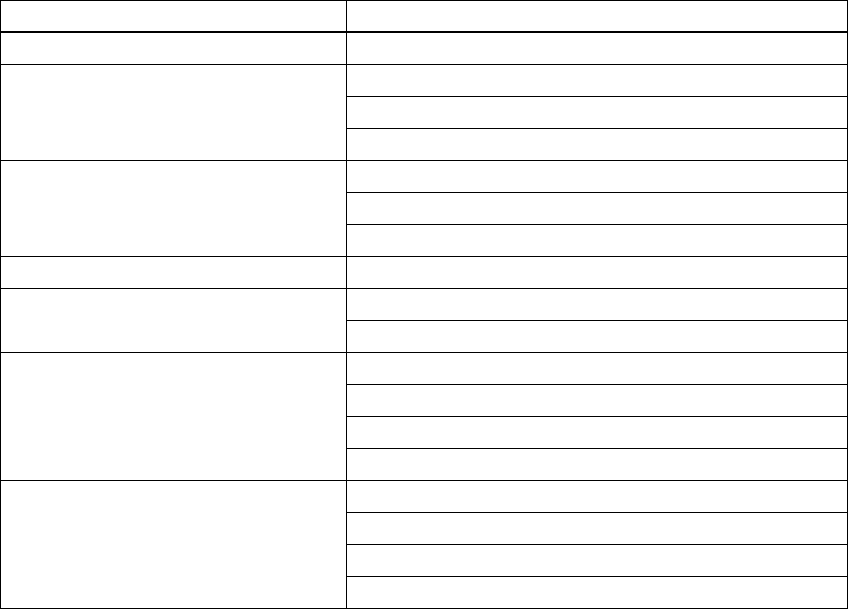
SYSTEM DESCRIPTION, INSTALLATION, AND MAINTENANCE MANUAL
eNfusion® HSD-440 Mark 2 Terminal
23-15-30 6-1
3 JUN 10
CONFIGURING THE OWNERS REQUIREMENTS TABLE
(ORT)
There are two methods of configuring ORT parameters:
• Configuring ORT Parameters Using the MPU
• Configuring ORT Parameters Using the EMS ORT Application
When your computer is connected to the HSD-440 Mark 2 Terminal through the serial maintenance
connection, you can set ORT parameters one at a time.
Using the EMS ORT Application, you can edit various ORT parameters in one session, save and
export an ORT file, and then load the file into the HSD-440 Mark 2 Terminal.
1. Configuring ORT Parameters Using the MPU
For information on creating ORTs using the MPU , see "Creating ORTs with the Maintenance Port
Utility (MPU)" on page 2-4.
This section lists the parameters you can configure in both the secure partition and the user partition
of the ORT. See the individual procedure for more information.
You can use the MPU to configure the secure parameters described in Table 6-1:
Table 6-1 Configuring Secure ORT Parameters
Category Section
ORT Part Number Configuring the ORT Part Number (secure)
Cockpit Communications Configuring the Call Signaling Mode
Configuring Outgoing Call Signaling
Configuring Ground Public Routing
4-wire Configuring 4-wire Wiring
Configuring Ground-to-Cockpit Call Routing
Configuring 4-wire Parameters
POTS Configuring POTS Parameters
CEPT-E1 Configuring CEPT-E1 Interface
Configuring the CEPT-E1 Interface Type
High Speed Data Services Configuring the Default PPPoE Service
Configuring SCPC High Speed Service
Configuring MPDS High Speed Service
Configuring SBB High Speed Service
Ethernet Configuring Ethernet Wiring
Configuring Ethernet Duplex Mode
Configuring the Ethernet Port Address
Configuring the Ethernet Mask

SYSTEM DESCRIPTION, INSTALLATION, AND MAINTENANCE MANUAL
eNfusion® HSD-440 Mark 2 Terminal
23-15-30 6-2
3 JUN 10
Networking Parameters for Ethernet 1
and Ethernet 2 Configuring the Host Name
Configuring the Access Concentrator Name
Configuring the SNMP Server
Configuring the SNMP Community String
Configuring the TFTP Server
Configuring the DHCP Client
Configuring the DHCP Server
Configuring Telnet Access
Configuring the Managed Range
Configuring the Number of Managed Addresses
Configuring the Access Point Name
Avionics Configuring the Primary Inertial Reference System (IRS)
Configuring the Secondary IRS
Configuring the Secondary IRS Input Speed
Configuring GNSS Equipment
Configuring the ICAO Code Source
Satellite Service Configuring the Forward ID
Configuring Satellite Information
Configuring GES Service Provider Information
Configuring the Frequency Table
Configuring LES Service Provider Information
Configuring the SwiftBroadband Timing Mode
Configuring the Priority Service for Channel Card One
Configuring the Service Type Priority
Antenna Configuring the Antenna Type
Configuring the Antenna Mounting Rotation Angle
Configuring the Antenna Mounting Pitch Angle
Configuring the Antenna Mounting Roll Angle
Configuring the HPA to Antenna Loss
Configuring the Diplexer
Table 6-1 Configuring Secure ORT Parameters (Continued)
Category Section

SYSTEM DESCRIPTION, INSTALLATION, AND MAINTENANCE MANUAL
eNfusion® HSD-440 Mark 2 Terminal
23-15-30 6-3
3 JUN 10
You can use the MPU to configure the user parameters described in Table 6-2:
MCDU Configuring MCDU Wiring
Configuring the MCDU Input Speed
Configuring the MCDU Output Speed
Configuring the MCDU Controller Type
Configuring the MCDU Type
Configuring the MCDU Font Colour
Configuring Manual Dialing
Configuring Outgoing Call Pre-Selection
Configuring the Address Book Categories
CMU Configuring CMU Wiring
Configuring the CMU Input Speed
Configuring the CMU Output Speed
Configuring the CMU-SDU Join/Leave Word
Configuring Hardcoded SAL
Terminal Operation Configuring Air/Ground Status Restrictions
Configuring Transmit on Ground
Configuring Self-test in Air
Configuring Maintenance Command Execution in Air
Configuring MCDU PAST
Configuring Field Loadable Software
Configuring the Logon/Handover Policy
Configuring Logon Interrogation
Configuring High-rate R/T in Global Beam
Masking Position in Logs
Configuring HSD SAL
Passive Intermodulation (PIM) Configuring PIMBIT HGA Azimuth Offset Angle
Configuring PIMBIT IGA Azimuth Offset Angle
Configuring PIMBIT IGA Elevation Offset Angle1
Configuring PIMBIT IGA Elevation Offset Angle2
Configuring PIMBIT HGA Elevation Offset Angle1
Configuring PIMBIT HGA Elevation Offset Angle2
Configuring PIMBIT Measurement Discard Ratio
Configuring PIMBIT Failure Threshold
Configuring PIMBIT Pointing Failure Threshold
Table 6-1 Configuring Secure ORT Parameters (Continued)
Category Section
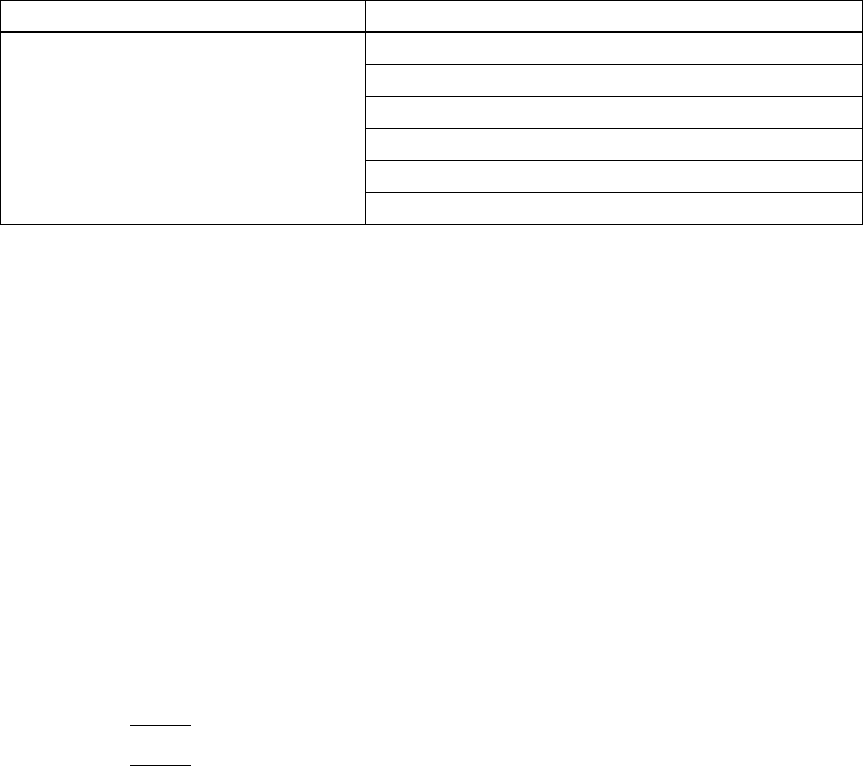
Table 6-2 User ORT Parameters
Category User ORT Parameter
User Parameters Configuring the ORT Part Number (user)
Configuring the Service Type Priority
Configuring the Logon/Handover Policy
Configuring Logon Interrogation
Configuring High-rate R/T in Global Beam
Masking Position in Logs
SYSTEM DESCRIPTION, INSTALLATION, AND MAINTENANCE MANUAL
eNfusion® HSD-440 Mark 2 Terminal
23-15-30 6-4
3 JUN 10
A. Connecting to the MPU
You can configure ORT parameters manually or using the EMS ORT Application through
the HSD-440 terminal MPU.
To connect to the MPU:
1. Connect your computer to the maintenance port of the HSD-440 Mark 2 Terminal
with a maintenance cable.
2. Start a terminal emulator session with the following parameters:
• Baud rate—19200
• No. of bits—8
• Parity—None
• Stop bits—1
• Flow control—None
3. When the HSD-440 Mark 2 Terminal boots, type the password maint.
NOTE: The password does not appear on the screen.
NOTE: You can configure secure and user ORT parameters using
maintenance-level access. The user-level access password, user, allows
you to see all the ORT parameters but you can only configure the user-level
parameters.
Menu 1 of the MPU appears. You can navigate the menus to configure ORT
parameters.
4. To navigate to Menu 3, press CTRL + N.
5. In Menu 3, type the number next to set CP ORT parameter, and then press ENTER.
A list of ORT parameters appears.
B. Configuring the ORT Part Number
You can configure a part number for the secure and user ORT. The HSD-440 Mark 2
Terminal displays the part number when it boots up.
SYSTEM DESCRIPTION, INSTALLATION, AND MAINTENANCE MANUAL
eNfusion® HSD-440 Mark 2 Terminal
23-15-30 6-5
3 JUN 10
When you configure the parameter for the part number, the HSD-440 Mark 2 Terminal
calculates a CRC value for the overall ORT. The HSD-440 Mark 2 Terminal uses the
CRC value to indicate when the ORT has changed.
To configure the secure ORT part number or the user ORT part number:
1. In the list of ORT parameters, type the number next to the SECURE ORT P/N
parameter, or the USER ORT P/N parameter, and then press ENTER.
2. At the SECURE ORT P/N or the USER ORT P/N prompt, type in the part number,
and then press ENTER.
You can type up to 20 characters. The default is blank.
C. Configuring Cockpit Communication Parameters
(1) Configuring the Call Signaling Mode
The HSD-440 Mark 2 Terminal can announce an incoming call in the aircraft cabin
with a chime and light of ARINC 741—the default setting, or with the CD1/CD2
discretes. The call signaling parameter is in the secure ORT.
To configure the call signaling mode:
1. In the list of ORT parameters, type the number next to the COCKPIT CALL
SIGNALING MODE parameter, and then press ENTER.
2. To use chime and light signaling, type 0, or to use CD1/CD2 discrete signaling,
type 1, and then press ENTER.
The default is CHIME/LIGHT.
(2) Configuring Outgoing Call Signaling
The HSD-440 Mark 2 Terminal can signal an outgoing call with a chime and a flashing
light. The outgoing call signaling parameter enables and disables these signals. This
parameter is in the secure ORT.
To configure outgoing call signaling:
1. In the list of ORT parameters, type the number next to the COCKPIT OUTGOING
CALL SIGNALING parameter, and then press ENTER.
2. To announce outgoing air to ground calls with a chime and light, type 1, or to
disable the chime and light, type 0, and then press ENTER.
The default is DISABLED.
(3) Configuring Ground Public Routing
The HSD-440 Mark 2 Terminal can route public calls from the ground to the cockpit,
to the CEPT-E1 interface, or not route the call (disallowed). The ground public routing
preference parameter is in the secure ORT.

SYSTEM DESCRIPTION, INSTALLATION, AND MAINTENANCE MANUAL
eNfusion® HSD-440 Mark 2 Terminal
23-15-30 6-6
3 JUN 10
To configure ground public routing preferences:
1. In the list of ORT parameters, type the number next to the GROUND PUBLIC
ROUTING PREFERENCE parameter, and then press ENTER.
2. To disallow all incoming public calls, type 1, or to route public calls to the cockpit,
type 2, or to route public calls to the CEPT-E1, type 3, and then press ENTER.
The default is DISALLOWED.
D. Configuring 4-wire Parameters
(1) Configuring 4-wire Wiring
The 4-wire #2 wired ORT parameter defines whether the second 4-wire equipment
is installed. The 4-wire #2 wired parameter is in the secure ORT.
NOTE: If the '4-WIRE #2 WIRED' ORT parameter is set to NO then the GROUND TO
COCKPIT ROUTING PREF parameter is automatically set to 4-WIRE #1.
To configure 4-wire #2 wiring:
1. In the list of ORT parameters, type the number next to the 4-Wire #2 Wired
parameter, and then press ENTER.
2. To set the preference to NO, type 0, or to set the preference to YES, type 1, and
then press ENTER.
The default is NO.
(2) Configuring Ground-to-Cockpit Call Routing
The HSD-440 Mark 2 Terminal can route calls from the ground to the cockpit through
either of the two supported 4-wire phones. The call routing parameter is in the secure
ORT.
To configure ground-to-cockpit call routing:
1. In the list of ORT parameters, type the number next to the GROUND TO
COCKPIT CALL ROUTING PREF parameter, and then press ENTER.
2. To route the calls to 4-WIRE #1, type 1, or to route the calls to 4-WIRE #2 (if
wired) type 2, and then press ENTER.
The default is 4-WIRE #1.
(3) Configuring 4-wire Parameters
You can configure the noise, speaker, microphone, and sidetone level settings of the
4-wire phones. These 4-wire parameters are in the user ORT.
NOTE: To configure the 4-wire #2 parameters, repeat the following four procedures.
SYSTEM DESCRIPTION, INSTALLATION, AND MAINTENANCE MANUAL
eNfusion® HSD-440 Mark 2 Terminal
23-15-30 6-7
3 JUN 10
To configure the 4-wire noise level:
1. In the list of ORT parameters, type the number next to the 4-WIRE #1 NOISE
LEVEL parameter, and then press ENTER.
2. At the prompt, define the default setting for the 4-wire #1 comfort noise insertion
level by typing one of the following values: 0, -40, -50, or -60, and then press
ENTER.
The default level is -50.
To configure the 4-wire speaker level:
1. In the list of ORT parameters, type the number next to the 4-WIRE #1 SPEAKER
LEVEL parameter, and then press ENTER.
2. At the prompt, define the 4-wire #1 speaker volume, by typing a value between
0 and 100, and then press ENTER.
The default level is 50, which equals a 2.5 mW output.
To configure the 4-wire microphone level:
1. In the list of ORT parameters, type the number next to the 4-WIRE #1 MIC LEVEL
parameter, and then press ENTER.
2. At the prompt, type in a value between 1 and 100, and then press ENTER.
The default level is 70.
To configure the 4-wire sidetone level:
1. In the list of ORT parameters, type the number next to the 4-WIRE #1 SIDETONE
LEVEL parameter, and then press ENTER.
2. At the prompt, define the default setting for the 4-wire #1 sidetone level by typing
a value between 1 and 100, and then press ENTER.
The default level is 50.
E. Configuring POTS Parameters
(1) Configuring POTS
You can enable and disable POTS with the POTS service parameter. The POTS
service parameter is in the secure ORT.
To configure POTS:
1. In the list of ORT parameters, type the number next to the POTS SERVICE
parameter, and then press ENTER.
2. To enable POTS, type 1, or to disable POTS, type 0, and then press ENTER.
The default is ENABLED.
F. Configuring CEPT-E1 Parameters
You can enable the CEPT-E1 interface with the MPU.
SYSTEM DESCRIPTION, INSTALLATION, AND MAINTENANCE MANUAL
eNfusion® HSD-440 Mark 2 Terminal
23-15-30 6-8
3 JUN 10
(1) Configuring CEPT-E1 Interface
The CEPT-E1 wiring parameter indicates whether the CEPT-E1 interface is wired.
The CEPT-E1 wiring parameter is in the secure ORT.
To configure CEPT-E1 wiring:
1. In the list of ORT interface parameters, type the number next to the CEPT E1
WIRED parameter, and then press ENTER.
2. To indicate the CEPT-E1 interface is wired, type 1, or to indicate the CEPT-E1
interface is not wired, type 0, and then press ENTER.
The default is YES.
(2) Configuring the CEPT-E1 Interface Type
The CEPT-E1 interface can connect to a variety of equipment. The available options
are:
• Not installed
•ARINC 746
•ITU
The CEPT-E1 interface type parameter is in the secure ORT.
To configure the CEPT-E1 interface type:
1. In the list of ORT parameters, type the number next to the CEPT E1 INTERFACE
TYPE parameter, and then press ENTER.
2. To indicate that the CEPT-E1 interface type is not installed, type 0, or to indicate
the CEPT-E1 interface type is ARINC 746, type 1, or to indicate the CEPT-E1
interface type is ITU, type 2, and then press ENTER.
The default is ARINC 746.
G. Configuring High Speed Data Services
(1) Configuring the Default PPPoE Service
The HSD-440 Mark 2 Terminal can use a default PPPoE service name if the client
does not provide the service name. The default PPPoE service parameter is in the
secure ORT.
To configure the default PPPoE service:
1. In the list of ORT parameters, type the number next to the DEFAULT PPPOE
SERVICE parameter, and then press ENTER.
2. Type a default service name, up to 60-characters in length, and then press
ENTER.
The default PPPoE service name is PacketData.
(2) Configuring SCPC High Speed Service
The HSD-440 Mark 2 Terminal can provide access to Swift 64 SCPC service through
Ethernet. The parameter to allow SCPC sessions is in the secure ORT.
SYSTEM DESCRIPTION, INSTALLATION, AND MAINTENANCE MANUAL
eNfusion® HSD-440 Mark 2 Terminal
23-15-30 6-9
3 JUN 10
To configure SCPC high speed service:
1. In the list of ORT parameters, type the number next to the ALLOW SCPC
SESSIONS parameter, and then press ENTER.
2. To enable SCPC services, type 1, or to disable SCPC services, type 0, and then
press ENTER.
The default is YES.
(3) Configuring MPDS High Speed Service
The HSD-440 Mark 2 Terminal can provide access to Swift 64 MPDS service through
Ethernet. The parameter to allow MPDS sessions is in the secure ORT.
To configure MPDS high speed service:
1. In the list of ORT parameters, type the number next to the ALLOW MPDS
SESSIONS parameter, and then press ENTER.
2. To enable MPDS high speed service, type 1, or to disable MPDS high speed
service, type 0, and then press ENTER.
The default is YES.
(4) Configuring SBB High Speed Service
The HSD-440 Mark 2 Terminal can provide access to SBB service through Ethernet.
The parameter to allow SBB sessions is in the secure ORT.
To configure SBB high speed service:
1. In the list of ORT parameters, type the number next to the ALLOW BGAN
SESSIONS parameter, and then press ENTER.
2. To enable SBB high speed service, type 1, or to disable SBB high speed service,
type 0, and then press ENTER.
The default is YES.
H. Configuring Ethernet Parameters
(1) Configuring Ethernet Wiring
The HSD-440 Mark 2 Terminal uses the parameters for Ethernet #1 and #2 wiring
in conjunction with the Ethernet link status to determine whether to raise and transmit
Ethernet faults to the CMU. If the Ethernet wiring parameters are set to NO, the
parameters for the Ethernet address and Ethernet mask have no effect.
The Ethernet wiring parameter is in the secure ORT.
To configure Ethernet wiring:
1. In the list of ORT parameters, type the number next to the ETHERNET #1 WIRED
parameter, and then press ENTER.
2. To specify that a device is wired to the Ethernet #1 port, type 1, or to specify that
no device is wired to the Ethernet #1 port, type 0, and then press ENTER.
The default is YES, wired.
3. Repeat steps 1 and 2 to configure the ETHERNET #2 WIRED parameter.
SYSTEM DESCRIPTION, INSTALLATION, AND MAINTENANCE MANUAL
eNfusion® HSD-440 Mark 2 Terminal
23-15-30 6-10
3 JUN 10
(2) Configuring Ethernet Duplex Mode
You can define the duplex mode for the Ethernet ports. The available options are:
• ETH1=HALF Duplex, ETH2=HALF Duplex
• ETH1=FULL Duplex, ETH2=HALF Duplex
• ETH1=HALF Duplex, ETH2=FULL Duplex
• ETH1=FULL Duplex, ETH2=FULL Duplex
The parameter for the Ethernet duplex mode is in the secure ORT.
To configure Ethernet duplex mode:
1. In the list of ORT parameters, type the number next to the ETHERNET DUPLEX
MODE parameter, and then press ENTER.
2. At the prompt, type 0, 1, 2, or 3, and then press ENTER, where:
• 0—half duplex for both ports
• 1—full duplex mode for Ethernet 1 only
• 2—full duplex mode for Ethernet 2 only
• 3—full duplex mode for both Ethernet 1 and Ethernet 2
The default is 0.
A message similar to the following appears:
PROCEEDING TO STORE DATA
(3) Configuring the Ethernet Port Address
You can configure the base IP address for each of the two Ethernet ports. The
parameters that define the Ethernet port addresses are in the secure ORT.
To configure the Ethernet port addresses:
1. In the list of ORT parameters, type the number next to the ETHERNET 1
ADDRESS parameter, and then press ENTER.
2. Type an IP address using decimals ranging from 0-255, in the format
xxx.xxx.xxx.xxx, and then press ENTER.
The default address for Ethernet 1 is 192.168.0.1. The default address for
Ethernet 2 is 0.0.0.0.
(4) Configuring the Ethernet Mask
You can configure the network mask for each of the two Ethernet ports. The
parameters that define the Ethernet port network masks are in the secure ORT.
To configure the Ethernet port masks:
1. In the list of ORT parameters, type the number next to the ETHERNET 1 MASK
parameter.
2. Type an IP address using decimals ranging from 0-255, in the format
xxx.xxx.xxx.xxx, and then press ENTER.
The default subnet mask for both Ethernet ports is 255.255.255.0.
SYSTEM DESCRIPTION, INSTALLATION, AND MAINTENANCE MANUAL
eNfusion® HSD-440 Mark 2 Terminal
23-15-30 6-11
3 JUN 10
I. Configuring Networking Parameters For Ethernet 1 and Ethernet 2
(1) Configuring the Host Name
You can configure the host name for the HSD-440 terminal with a string of up to 20
characters. The parameter for the host name is in the secure ORT.
To configure the host name:
1. In the list of ORT parameters, type the number next to the HOST NAME
parameter, and then press ENTER.
2. At the prompt, type the host name for the HSD-440 terminal using a maximum
of up to 20 characters, and then press ENTER.
The default is DataIO.
(2) Configuring the Access Concentrator Name
The HSD-440 Mark 2 Terminal uses the access concentrator name parameter to
differentiate between PPPoE devices. The access concentrator name can include
up to 20 characters. The access concentrator name parameter is in the secure ORT.
To configure the access concentrator name:
1. In the list of ORT parameters, type the number next to the ACCESS
CONCENTRATOR NAME parameter, and then press ENTER.
2. At the prompt, type a name of up to 20 characters, and then press ENTER.
A message indicating that the DATA I/O parameter block is updated appears.
The default is DataIO.
(3) Configuring the SNMP Server
The SNMP server parameter enables and disables the SNMP server. This parameter
is in the secure ORT.
To enable the SNMP server:
1. In the list of ORT parameters, type the number next to the SNMP SERVER
parameter, and the press ENTER.
2. At the prompt, type the number next to the enabled or disabled option, and then
press ENTER.
The default is ENABLED.
(4) Configuring the SNMP Community String
You can define an SNMP community string with up to 32 characters. This parameter
is in the secure ORT.
To configure the SNMP community string:
1. In the list of ORT parameters, type the number next to the SNMP COMMUNITY
STRING parameter, and then press ENTER.
2. At the prompt, type a name up to 32 characters in length, and then press ENTER.
The default is PUBLIC.
SYSTEM DESCRIPTION, INSTALLATION, AND MAINTENANCE MANUAL
eNfusion® HSD-440 Mark 2 Terminal
23-15-30 6-12
3 JUN 10
(5) Configuring the TFTP Server
You can enable and disable the TFTP server. The TFTP server parameter is in the
secure ORT.
To configure the TFTP server:
1. In the list of ORT parameters, type the number next to the TFTP SERVER
parameter, and then press ENTER.
2. To enable the TFTP server, at the prompt, type yes, or to disable the TFTP server,
type no, and then press ENTER.
The default is ENABLED.
(6) Configuring the DHCP Client
You can enable and disable the DHCP client on Ethernet port one. The DHCP client
parameter is in the secure ORT.
To configure the DHCP client:
1. In the list of ORT parameters, type the number next to the ENABLE DHCP
CLIENT parameter, and then press ENTER.
2. To enable the DHCP client, at the prompt, type yes, or to disable the DHCP
client, type no, and then press ENTER.
The default is DISABLED.
(7) Configuring the DHCP Server
You can enable and disable the DHCP server on Ethernet port one. The DHCP server
parameter is in the secure ORT.
To configure the DHCP server:
1. In the list of ORT parameters, type the number next to the ENABLE DHCP
SERVER parameter, and then press ENTER.
2. To enable the DHCP server, at the prompt, type yes, or to disable the DHCP
server, type no, and then press ENTER.
The default is DISABLED.
(8) Configuring Telnet Access
You can enable and disable the Telnet server. The Telnet server parameter is in the
secure ORT.
To configure Telnet access:
1. In the list of ORT parameters, type the number next to the TELNET ACCESS
parameter, and then press ENTER.
2. To enable the Telnet server, at the prompt, type yes, or to disable the Telnet
server, type no, and then press ENTER.
The default is ENABLED.
(9) Configuring the Managed Range
You can configure the starting IP address provided to DHCP clients if the DHCP
server is enabled. The managed range parameter is in the secure ORT.
SYSTEM DESCRIPTION, INSTALLATION, AND MAINTENANCE MANUAL
eNfusion® HSD-440 Mark 2 Terminal
23-15-30 6-13
3 JUN 10
To configure the managed range:
1. In the list of ORT parameters, type the number next to the START OF MANAGED
RANGE parameter, and then press ENTER.
2. At the prompt, type the starting address in the format xxx.xxx.xxx.xxx, and then
press ENTER.
The default is 192.168.0.100.
(10)Configuring the Number of Managed Addresses
You can configure the number of managed addresses provided to DHCP clients if
the DHCP server is enabled. The parameter for the number of managed addresses
is in the secure ORT.
1. In the list of ORT parameters, type the number next to the NUMBER OF
MANAGED ADDRESSES parameter, and then press ENTER.
2. At the prompt, type a value between 1 and 100, and then press ENTER.
The default value is 50.
(11)Configuring the Access Point Name
When configuring SBB services, you can configure the access point name in the
secure ORT.
1. In the list of ORT parameters, type the number next to the ACCESS POINT
NAME parameter, and then press ENTER.
2. At the prompt, type a name, and the press ENTER. An example name is
stratos.bgan.inmarsat.com.
The default value is null.
J. Configuring Avionics Parameters
(1) Configuring the Primary Inertial Reference System (IRS)
You can configure the type of equipment that provides input to the primary IRS (IRS
#1). The available options are:
• Inertial—default
•GNSS
•Hybrid
The primary IRS parameter is in the secure ORT.
To configure the primary IRS type:
1. In the list of ORT parameters, type the number next to the PRIMARY IRS TYPE
parameter, and then press ENTER.
2. At the prompt, type 0, 1, or 2, and then press ENTER, where:
• 0—INERTIAL (default)
• 1—GNSS
• 2—HYBRID
SYSTEM DESCRIPTION, INSTALLATION, AND MAINTENANCE MANUAL
eNfusion® HSD-440 Mark 2 Terminal
23-15-30 6-14
3 JUN 10
(2) Configuring the Secondary IRS
You can configure the type of equipment that provides input to the secondary IRS
(IRS #2). The available options are:
• Not installed—default
•Inertial
• AES ID
•GNSS
• Hybrid
The secondary IRS parameter is in the secure ORT.
To configure the secondary IRS type:
1. In the list of ORT parameters, type the number next to the SECONDARY IRS
TYPE parameter, and then press ENTER.
2. At the prompt, type 0, 1, 2, 3, or 4, and then press ENTER, where:
• 0—NOT INSTALLED (default)
• 1—INERTIAL
• 2—AES ID
•3—GNSS
• 4—HYBRID
The default is Not Installed.
(3) Configuring the Secondary IRS Input Speed
You can set the receive data rate for the secondary IRS ARINC 429 bus. This
parameter is in the secure ORT.
To set the secondary IRS input speed:
1. In the list of ORT parameters, type the number next to the SECONDARY IRS
INPUT SPEED SELECT parameter, and then press ENTER.
2. To set the IRS ARINC 429 bus data receive speed rate to high rate, type 1, or
to set the bus speed to low rate, type 0, and then press ENTER.
The default speed is high rate.
(4) Configuring GNSS Equipment
You can enable and disable the GPS protection algorithm depending on the
GPS/GLONASS equipment installed in the aircraft. The available options are:
•None
• GPS—default
• GPS Augmented by GLONASS
The parameter for GNSS equipment is in the secure ORT.

SYSTEM DESCRIPTION, INSTALLATION, AND MAINTENANCE MANUAL
eNfusion® HSD-440 Mark 2 Terminal
23-15-30 6-15
3 JUN 10
To configure GNSS equipment:
1. In the list of ORT parameters, type the number next to the A/C GNSS
EQUIPMENT parameter, and then press ENTER.
2. At the prompt, type 0, 1, or 2, and then press ENTER, where:
• 0—disables GPS protection on an aircraft that does not have GPS
augmented by GLONASS navigation equipment installed
• 1—enables GPS protection on an aircraft that has GPS navigation
equipment installed
• 2—enables GPS protection on an aircraft that has GPS augmented by
GLONASS navigation equipment installed
The default is GPS.
(5) Configuring the ICAO Code Source
You can provide the ICAO code by strapping or from the ARINC 429 source. You
can use the ARINC 429 source only if the Secondary IRS Type parameter is set to
AES ID.
The ICAO code source parameter is in the secure ORT.
To configure the ICAO code source:
1. In the list of ORT parameters, type the number next to the ICAO CODE SOURCE
parameter, and then press ENTER.
2. To configure A429 SOURCE as the source, type 1, or to configure STRAP inertial
as the source, type 0, and then press ENTER.
The default is STRAP.
K. Configuring Satellite Service ORT Parameters
(1) Configuring the Forward ID
You can configure the six-digit hexadecimal Forward ID required for Swift 64 services.
The Forward ID is in the secure ORT.
To configure the Forward ID:
1. In the list of ORT parameters, type the number next to the FORWARD ID
parameter, and then press ENTER.
2. To define the forward ID, type the forward ID, then press ENTER.
The default forward ID is 000000—this forward ID does not allow access to the
satellite network.
NOTE: Power cycle the HSD-440 Mark 2 Terminal to activate the new Forward
ID.
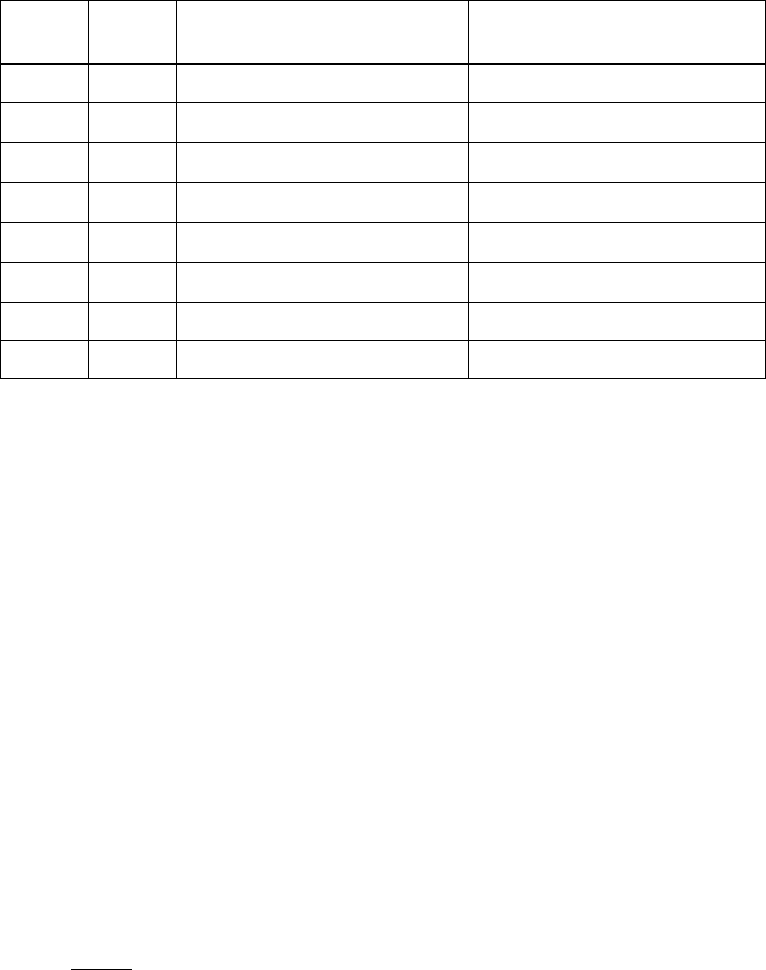
SYSTEM DESCRIPTION, INSTALLATION, AND MAINTENANCE MANUAL
eNfusion® HSD-440 Mark 2 Terminal
23-15-30 6-16
3 JUN 10
(2) Configuring Satellite Information
You can configure the name, location, and service available from up to eight
satellites. This does not allow access to the satellite network. Satellite information is
in the secure ORT. The default settings are:
Entry # Region Satellite Name and
Longitude Services
1 0 AORW (W) 53.0W CLASSIC AERO, SWIFT64
2 1 AORE (E) 15.5W CLASSIC AERO, SWIFT64
3 2 POR (P), 178.0E CLASSIC AERO, SWIFT64
4 3 IOR (I) 64.0E CLASSIC AERO, SWIFT64
5 4 MTSAT (4) 142.5E CLASSIC AERO
6 5 APAC (5), 144 E CLASSIC AERO, BGAN
7 6 EMEA (6), 25.0E CLASSIC AERO, BGAN
8 7 AMERICAS (7) 98.0 W CLASSIC AERO, BGAN
To configure satellite information:
1. In the list of ORT parameters, type the number next to the SATELLITE NAMES
parameter, and then press ENTER.
2. Type the number of the ENTRY you want to modify, and then press ENTER.
A prompt appears. For example:
EDITING ENTRY #1 REGION 0:
NAME [AORW] ?
3. At the NAME prompt, type the satellite name and then press ENTER.
4. At the ABBREVIATION prompt, type an abbreviation for the satellite name and
then press ENTER.
5. At the LONGITUDE prompt, type the longitude and then press ENTER.
6. At the SATELLITE SERVICES prompt, identify the service and then press
ENTER. You can specify one or more of the following:
•Type A for AERO
• Type S for SWIFT64
•Type B for SBB
NOTE: To specify more than one service, for example, classic AERO and Swift
64, type AS.
7. At the SAVE ENTRY prompt, to save the changes, type Y, or to cancel, type N.
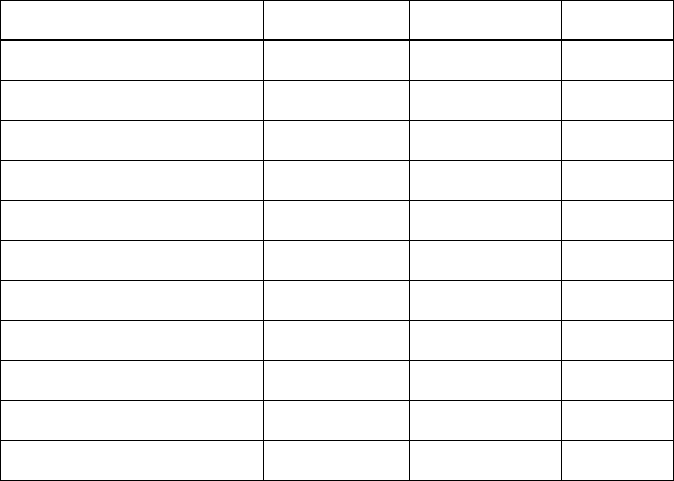
SYSTEM DESCRIPTION, INSTALLATION, AND MAINTENANCE MANUAL
eNfusion® HSD-440 Mark 2 Terminal
23-15-30 6-17
3 JUN 10
(3) Configuring GES Service Provider Information
You can configure the GES Name, satellite ID, GES ID, and priority for up to 33
GESs. GES information is in the secure ORT. Note the GES ID in the following table
is an Octal number. The default settings are:
GES Name Satellite ID GES ID Priority
Aussaguel 005 5
Eik 002 5
Aussaguel 1103 5
Eik 1104 5
Perth 2205 5
Santa Paula 2202 5
Perth 3305 5
Eik 3301 5
Hawaii 5120 5
Fucino 6220 5
Hawaii 7320 5
To configure GES service provider information:
1. In the list of ORT parameters, type the number next to the GES SERVICE
PROVIDER TABLE parameter, and then press ENTER.
A prompt appears. For example:
OTHER ENTRIES ARE EMPTY -- ENTER NUMBER OF ENTRY TO
EDIT (1,33) ?
2. At the ENTRY prompt, type the entry number to add or edit and then press
ENTER.
3. At the SATELLITE prompt, type the number of the satellite ID and then press
ENTER.
4. At the GES [octal]? prompt, type the number (in Octal) of the GES ID and then
press ENTER.
5. At the PRIORITY prompt, type a number between 1 and 10 and then press
ENTER.
6. At the GES NAME prompt, type in the GES name and then press ENTER.
7. At the SAVE ENTRY prompt, to save the changes, type Y, or to cancel, type N.
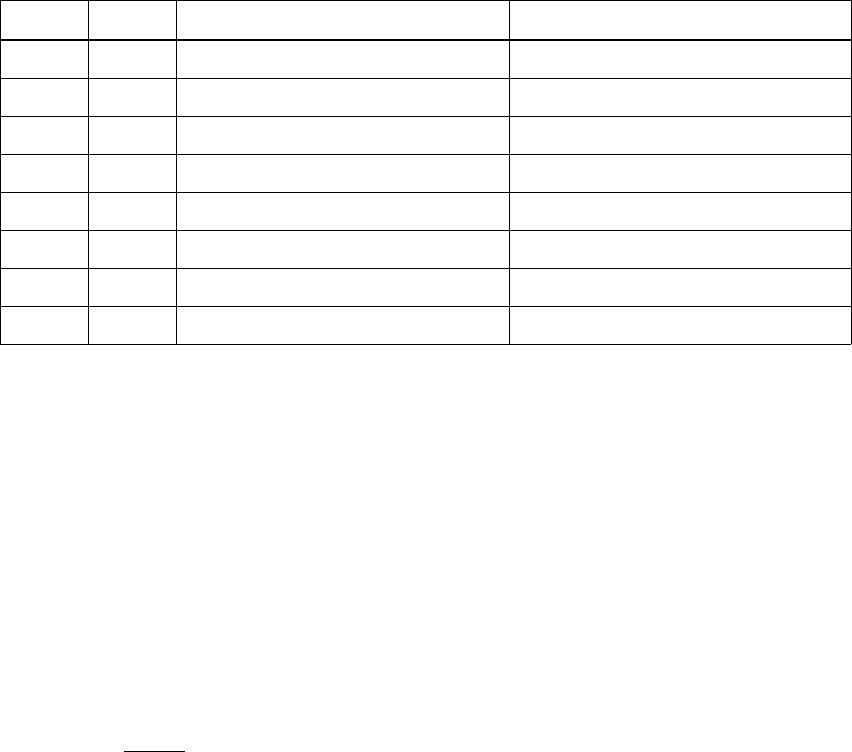
SYSTEM DESCRIPTION, INSTALLATION, AND MAINTENANCE MANUAL
eNfusion® HSD-440 Mark 2 Terminal
23-15-30 6-18
3 JUN 10
(4) Configuring the Frequency Table
The Frequency Table defines the Global Band (SBB) and PSID (Areo H/H+)
frequencies for up to eight satellites. You can configure two or more frequency pairs
and NCS (S64) for each service type. The Frequency Table is in the secure ORT.
The default settings are:
Entry # Region Service Type Frequencies Frequencies
1 0 AERO PSID FREQS: $3702, $36B8 NCS FREQS: $2AAC,$30E0
2 1 AERO PSID0 FREQS: $36FE, $36B6 NCS FREQS: $2AB0,$30E4
3 2 AERO PSID FREQS: $36B4, $3700
4 3 AERO PSID FREQS: $36B2, $36FC
5 4 AERO PSID FREQS: $38F7, $38F7
6 5 Global Beam FREQS: $2AF2, $302A AERO PSID FREQS: $36DA, $36DA
7 6 Global Beam FREQS: $2BA0, $309E AERO PSID FREQS: $36DE, $36DE
8 7 Global Beam FREQS:$2A4C, $3004 AERO PSID FREQS: $36DC,$36DC
To configure the Frequency Table:
1. In the list of ORT parameters, type the number next to the FREQUENCY TABLE
parameter, and then press ENTER.
2. Type the ENTRY number you want to edit and then press ENTER.
3. At the SBB GLOBAL BEAM FREQS prompt, type the frequency pair and then
press ENTER.
4. At the AERO PSID FREQS prompt, type the frequency pair and then press
ENTER.
5. At the SWIFT64 NCS FREQS prompt, type the frequency pair and then press
ENTER.
6. At the SAVE ENTRY prompt, to save the changes, type Y, or to cancel, type N.
NOTE: You must enter a minimum of two frequency pairs per service type for each
satellite up to a maximum of eight satellites. Frequency pairs are
hexadecimal, with values separated by a comma, for example,
$3702, $36B8.
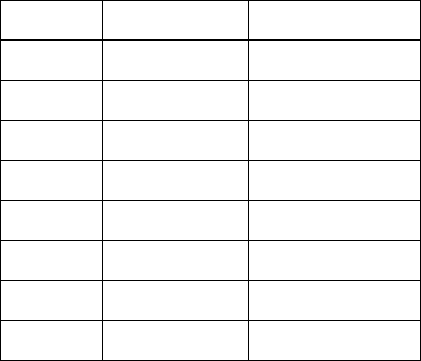
SYSTEM DESCRIPTION, INSTALLATION, AND MAINTENANCE MANUAL
eNfusion® HSD-440 Mark 2 Terminal
23-15-30 6-19
3 JUN 10
(5) Configuring LES Service Provider Information
The LES Service Provider Table can hold LES parameters for up to eight satellites.
The LES parameters are the satellite name and LES ID. The LES service provider
information is in the secure ORT. The default settings are:
Entry # Satellite LES ID
1 AORW LES 0
2AORE LES 0
3POR LES 0
4IOR LES 0
5MTSAT LES 0
6APAC LES 0
7EMEA LES 0
8AMERICAS LES 0
To configure LES service provider information:
1. In the list of ORT parameters, type the number next to the LES SERVICE
PROVIDER TABLE parameter, and then press ENTER.
2. Type the ENTRY number you want to edit and then press ENTER.
3. At the LES prompt, type the LES number and then press ENTER.
4. At the NETWORK ID prompt, type the network ID and then press ENTER.
5. At the LES NAME prompt, type the LES name and then press ENTER.
6. At the SAVE ENTRY prompt, to save the changes, type Y, or to cancel, type N.
(6) Configuring the SwiftBroadband Timing Mode
The SBB timing mode determines the timing precision used by the Radio Access
Network. The timing modes are: GPS Assisted, Not Assisted, and Auto
Determination. The default setting is Not Assisted. The SBB timing mode is in the
secure ORT.
To configure the SBB timing mode:
1. In the list of ORT parameters, type the number next to the SWIFTBROADBAND
TIMING MODE parameter, and then press ENTER.
2. At the prompt, type 0, 1, or 2, and then press ENTER, where:
• 0—Not Assisted—default
• 1—GPS Assisted
• 2—Auto Determination
The auto determination state uses a lookup of the primary IRS type and
secondary IRS type ORT parameters. If either specifies GNSS, or HYBRID type
labels, the SwiftBroadband timing mode is GPS assisted. If GNSS, or HYBRID
SYSTEM DESCRIPTION, INSTALLATION, AND MAINTENANCE MANUAL
eNfusion® HSD-440 Mark 2 Terminal
23-15-30 6-20
3 JUN 10
is not specified, is not assisted. If the timing mode is not assisted, the HSD-440
Mark 2 Terminal is set as Aeronautical Class without GPS BGAN terminal.
(7) Configuring the Priority Service for Channel Card One
Channel card one can access SBB and Swift 64 services. You can assign the priority
service with the following options:
• SWIFT64 ONLY
• SWIFTBROADBAND CLASS 6 REVERTING TO SWIFT64—default
• SWIFTBROADBAND CLASS 6 ONLY
• SWIFT64 REVERTING TO SWIFTBROADBAND CLASS 6
The priority service is in the secure ORT.
To configure the priority service for channel card one:
1. In the list of ORT parameters, type the number next to the CARD #1 SBB/S64
PRIORITY parameter, and then press ENTER.
2. At the prompt, type 0, 1, 2, or 3 and then press ENTER, where:
• 0—SWIFT64 only on CC1
• 1—SWIFTBROADBAND CLASS 6 REVERTING TO SWIFT64
• 2—SWIFTBROADBAND CLASS 6 ONLY
• 3—SWIFT64 REVERTING TO SWIFTBROADBAND CLASS 6
The default priority service is SWIFTBROADBAND CLASS 6 REVERTING TO
SWIFT64.
(8) Configuring the Service Type Priority
The service type priority parameter defines which service gets second priority for
power when the requirements for priority three and above Aero H calls are satisfied.
The service type priority parameter is in the secure ORT.
To configure the service type priority:
1. In the list of ORT parameters, type the number next to the SERVICE TYPE
PRIORITY parameter, and then press ENTER.
2. To configure PUBLIC CORRESPONDENCE, type 0, or to configure SBB/S64,
type 1, and then press ENTER.
The default is PUBLIC CORRESPONDENCE.
L. Configuring Antenna ORT Parameters
(1) Configuring the Antenna Type
The antenna type parameter defines the type of antenna installed on the aircraft. The
available options are:
• ARINC 781 HGA
• ARINC 781 IGA
• ARINC 741 HGA, Top Mount—default
SYSTEM DESCRIPTION, INSTALLATION, AND MAINTENANCE MANUAL
eNfusion® HSD-440 Mark 2 Terminal
23-15-30 6-21
3 JUN 10
• ARINC 741 HGA, Side Mount
If a third MCDU is installed, the HSD-440 Mark 2 Terminal cannot use the side-mount
antenna.
The antenna type parameter is in the secure ORT.
To configure the antenna type:
1. In the list of ORT parameters, type the number next to the ANTENNA TYPE
parameter, and then press ENTER.
2. At the prompt, type 2, 4, or 5 and then press ENTER, where:
• 2—ARINC 781 HGA
• 4—ARINC 741 HGA, TOP MOUNT
• 5—ARINC 741 HGA, SIDE MOUNT
The default is set to ARINC 741 HGA, TOP MOUNT.
(2) Configuring the Antenna Mounting Rotation Angle
The antenna mounting rotation angle defines the difference between the fore-aft axis
of the antenna reference plane and the fore-aft axis of the aircraft. The rotation is
measured counter-clockwise from the aircraft forward axis toward the antenna
forward axis (or the port side).
The antenna mounting rotation angle parameter is in the secure ORT.
To configure the antenna mounting rotation angle:
1. In the list of ORT parameters, type the number next to the ANTENNA
MOUNTING ROTATION ANGLE parameter, and then press ENTER.
2. Type a value between 0 and 360, to one decimal place, and then press ENTER.
The default is 0.0.
(3) Configuring the Antenna Mounting Pitch Angle
The antenna mounting pitch angle defines the difference between the fore-aft axis
of the antenna reference plane and the fore-aft axis of the aircraft. The pitch is
measured in the nose-up direction from the aircraft forward axis toward the antenna
forward axis.
The antenna mounting pitch angle parameter is in the secure ORT.
To configure the antenna mounting pitch angle:
1. In the list of ORT parameters, type the number next to the ANTENNA
MOUNTING PITCH ANGLE parameter, and then press ENTER.
2. Type a value between 0 and 360, to one decimal place, and then press ENTER.
The default is 0.0.
(4) Configuring the Antenna Mounting Roll Angle
The antenna mounting roll angle defines the difference between the port-starboard
axis of the antenna reference plane and the port-starboard axis of the aircraft. The
roll is measured in the starboard-up direction from the aircraft starboard axis toward
the antenna starboard axis.
SYSTEM DESCRIPTION, INSTALLATION, AND MAINTENANCE MANUAL
eNfusion® HSD-440 Mark 2 Terminal
23-15-30 6-22
3 JUN 10
The antenna mounting roll angle parameter is in the secure ORT.
To configure the antenna mounting roll angle:
1. In the list of ORT parameters, type the number next to the ANTENNA
MOUNTING ROLL ANGLE parameter, and then press ENTER.
2. Type a value between 0 and 360, to one decimal place, and then press ENTER.
The default is 0.0.
(5) Configuring the HPA to Antenna Loss
The HPA to antenna loss parameter defines the total loss (in dB) from the HSD-440
Mark 2 Terminal to the antenna input port, including the DLNA and DLNA to antenna
cable losses. The HPA to antenna loss parameter is in the secure ORT.
To configure the HPA to antenna loss:
1. In the list of ORT parameters, type the number next to the HSD (HPA)-
ANTENNA LOSS parameter, and then press ENTER.
2. Type a value between 0 and 5.0, to one decimal place, and then press ENTER.
The default is 2.5.
(6) Configuring the Diplexer
You can configure the type of diplexer installed in the aircraft. The available options
are:
•Type A
• Type A Modified
•Type D
• Type F—default
Type F diplexers support SBB service.
The diplexer parameter is in the secure ORT.
To configure the diplexer:
1. In the list of ORT parameters, type the number next to the INSTALLED
DIPLEXER TYPE parameter, and then press ENTER.
2. At the prompt, type 0, 1, 2, or 3 and then press ENTER, where:
• 0—diplexer TYPE A
• 1—diplexer TYPE A MODIFIED
• 2—diplexer TYPE D
• 3—diplexer TYPE F
The default is TYPE A.
SYSTEM DESCRIPTION, INSTALLATION, AND MAINTENANCE MANUAL
eNfusion® HSD-440 Mark 2 Terminal
23-15-30 6-23
3 JUN 10
M. Configuring MCDU ORT Parameters
(1) Configuring MCDU Wiring
The MCDU wiring parameter defines whether the MCDU can be wired or not wired.
There is a parameter for each of the devices. The MCDU wired parameters are in
the secure partition of the ORT.
To configure the MCDU interface on the HSD-440 Mark 2 Terminal:
1. In the list of ORT parameters, type the number next to the MCDU/WSCI #x
WIRED parameter, and then press ENTER.
The prompt: MCDU/WSCI #x WIRED where x equals 1 appears.
2. To indicate that the MCDU #1 device is wired, type 1, or to indicate that it is not
wired, type 0, and then press ENTER.
The default for the MCDU/WSCI #1 WIRED parameter is Yes.
(2) Configuring the MCDU Input Speed
You can configure the input bus speed to high or low. The input speed parameter is
in the secure ORT.
To configure MCDU input speed:
1. In the list of ORT parameters, type the number next to the MCDU/WSCI INPUT
SPEED parameter, and then press ENTER.
2. To set the input bus data speed to high rate, type 1, or to set the bus speed to
low rate, type 0, and then press ENTER.
The default speed is low rate.
(3) Configuring the MCDU Output Speed
You can configure the output bus speed to high or low. The output speed parameter
is in the secure ORT.
To configure MCDU output speed:
1. In the list of ORT parameters, type the number next to the MCDU/WSCI OUTPUT
SPEED parameter, and then press ENTER.
2. To set the output bus speed to high rate, type 1, or to set the output bus speed
to low, type 0, and then press ENTER.
The default output speed is set to high rate.
(4) Configuring the MCDU Controller Type
You can select the type of controller installed on the aircraft. The controller type
parameter is in the secure ORT.
To configure the MCDU controller type:
1. In the list of ORT parameters, type the number next to the MCDU/WSCI
CONTROLLER TYPE parameter, and then press ENTER.
2. To select the controller type MCDU, type 0, and then press ENTER.
The default is MCDU.
SYSTEM DESCRIPTION, INSTALLATION, AND MAINTENANCE MANUAL
eNfusion® HSD-440 Mark 2 Terminal
23-15-30 6-24
3 JUN 10
(5) Configuring the MCDU Type
You can select the type of MCDU installed in the aircraft. The MCDU type parameter
is in the secure partition of the ORT.
To configure the MCDU type:
1. In the list of ORT parameters, type the number next to the MCDU TYPE
parameter, and then press ENTER.
2. At the prompt, type 1, 2, 3, or 6 and then press ENTER, where:
• 1—UNILINK
•2—SMITHS
• 3—HONEYWELL
• 6—BOEING TECHSAT SIM
The default is UNILINK.
(6) Configuring the MCDU Font Colour
You can change the color of text on the MCDU screen. The MCDU font colour
parameter enables the MCDU to display colours other than white. The MCDU FONT
COLOUR is in the secure partition of the ORT.
To configure the MCDU font colour:
1. In the list of ORT parameters, type the number next to the MCDU FONT
COLOUR parameter, and then press ENTER.
2. To enable the MCDU font colour, type 1, or to disable the MCDU font colour, type
0, and then press ENTER.
The default is DISABLED.
(7) Configuring Manual Dialing
You can manually dial numbers using the MCDU keyboard. The manual dialing can
be enabled or disabled. The ALLOW MANUAL DIAL parameter is in the secure
partition of the ORT.
To configure manual dialing:
1. In the list of ORT parameters, type the number next to the ALLOW MANUAL
DIAL parameter, and then press ENTER.
2. To enable manual dialing, type 1, or to disable manual dialing, type 0, and then
press ENTER.
The default is ENABLED.
(8) Configuring Outgoing Call Pre-Selection
The COCKPIT OUTGOING CALL PRE-SELECT parameter enables users to
pre-select air-to-ground calls and then dial the number using the Mic-On input or
MAKE CALL button on the MCDU. When this parameter is disabled, the HSD-440
Mark 2 Terminal dials air-to-ground calls immediately.

SYSTEM DESCRIPTION, INSTALLATION, AND MAINTENANCE MANUAL
eNfusion® HSD-440 Mark 2 Terminal
23-15-30 6-25
3 JUN 10
To configure outgoing call pre-selection:
1. In the list of ORT parameters, type the number next to the COCKPIT OUTGOING
CALL PRE-SELECT parameter, and then press ENTER.
2. To enable pre-selection, type 1, or to disable pre-selection, type 0, and then press
ENTER.
The default is DISABLED.
(9) Configuring the Address Book Categories
The address book defines a table that can hold up to 400 telephone numbers in 4
categories of up to 100 entries. Each entry includes:
• A phone number (maximum of 18 digits).
• A name (maximum of 14 alphanumeric characters).
• A priority for the phone number. The priority can be EMG, OP-HI, OP-LO, and
NON-OP, which correspond to priority (Q) numbers 15, 12, 10, and 9.
• A parameter to indicate whether the entry can be edited via the MCDU.
• A parameter to indicate the phone book category to which the entry belongs.
You can define up to four phone book categories in the MCDU address book. The
category name can be up to ten characters in length. The category name parameters
are in the secure partition of the ORT.
NOTE: If the ORT entry is empty, CATEGORY #x appears, where x is the number
of the phone book category, between 1 and 4.
To configure the address book categories:
1. In the list of ORT parameters, type the number next to the PHONEBOOK CAT
NAME 1 parameter.
2. Type the category name and then press ENTER.
3. In the list of ORT parameters, type the number next to the PHONEBOOK CAT
NAME 2 parameter.
4. Type the category name and then press ENTER.
5. In the list of ORT parameters, type the number next to the PHONEBOOK CAT
NAME 3 parameter.
6. Type the category name and then press ENTER.
7. In the list of ORT parameters, type the number next to the PHONEBOOK CAT
NAME 4 parameter.
N. Configuring the CMU
(1) Configuring CMU Wiring
You can configure if either of the two available CMUs is wired. The CMU #x WIRED
parameter is in the secure partition of the ORT.

SYSTEM DESCRIPTION, INSTALLATION, AND MAINTENANCE MANUAL
eNfusion® HSD-440 Mark 2 Terminal
23-15-30 6-26
3 JUN 10
To configure the CMU wiring:
1. In the list of ORT parameters, type the number next to the CMU #x WIRED
parameter, and then press ENTER.
The prompt: CMU #x WIRED? where x equals 1 or 2 appears.
2. To indicate that the CMU #1 or CMU #2 can be wired, type 1, or to indicate that
the CMU #1 or CMU #2 cannot be wired, type 0, and then press ENTER.
The default for the CMU #1 WIRED parameter is YES (wired) and for the CMU
#2 WIRED parameter is NO (not wired).
(2) Configuring the CMU Input Speed
You can configure the input bus speed to high rate or low rate. The input speed
parameter is in the secure partition of the ORT.
To configure CMU input speed:
1. In the list of ORT parameters, type the number next to the CMU INPUT SPEED
SELECT parameter, and then press ENTER.
2. To set the CMU input bus speed to a high rate, type 1, or to set the CMU input
bus speed to a low rate, type 0, and then press ENTER.
The default is low rate.
(3) Configuring the CMU Output Speed
You can configure the output bus speed to high rate or low rate. The output speed
parameter is in the secure partition of the ORT.
To configure CMU output speed:
1. In the list of ORT parameters, type the number next to the CMU OUTPUT SPEED
SELECT parameter, and then press ENTER.
2. To set the CMU output bus speed to a high rate, type 1, or to set the CMU output
bus speed to a low rate, type 0, and then press ENTER.
The default is low rate.
(4) Configuring the CMU-SDU Join/Leave Word
The HSD-440 Mark 2 Terminal can send join/leave words periodically or only on
logon and logoff events. The CMU-SDU join/leave word parameter is in the secure
partition of the ORT.
NOTE: This parameter supports Universal brand CMU that reports a SAL that is
different than the one it accepts when using a Williamsburg protocol.
To configure the CMU-SDU join/leave word:
1. In the list of ORT parameters, type the number next to the CMU-SDU
JOIN/LEAVE WORD TRANSMISSION parameter, and then press ENTER.
2. To transmit join/leave words periodically, type 1, or to transmit join/leave words
on events, type 0, and then press ENTER.
The default is PERIODIC.
SYSTEM DESCRIPTION, INSTALLATION, AND MAINTENANCE MANUAL
eNfusion® HSD-440 Mark 2 Terminal
23-15-30 6-27
3 JUN 10
(5) Configuring Hardcoded SAL
The CMU-SDU hardcoded SAL parameter determines the SAL used in SDU to CMU
Williamsburg messages. If this parameter is set to YES, a SAL of 304 is used
regardless of the SAL reported to the CMU. If this parameter is set to NO, the SDU
uses the SAL reported by the CMU. If a SAL is not present on the bus after one
minute, the CMU uses a SAL of 304.The CMU-SDU HARD CODED SAL parameter
is in the secure partition of the ORT.
To configure the hardcoded SAL:
1. In the list of ORT parameters, type the number next to the CMU-SDU HARD
CODED SAL parameter, and then press ENTER.
2. To enable hardcoded SAL, type 1, or to disable hardcoded SAL, type 0, and then
press ENTER.
The default is ENABLED.
O. Configuring Terminal Operation
(1) Configuring Air/Ground Status Restrictions
Restrictions to the HSD-440 Mark 2 Terminal operation are based on whether the
terminal is on the ground or in the air. This parameter enables or disables those
restrictions. The parameter for air/ground status restrictions is in the secure partition
of the ORT.
When the air/ground status restriction parameter is enabled, the parameters for
self-test in air and transmit on ground behave normally. If the air/ground status
restriction parameter is disabled, the parameters for self-test in air and transmit on
ground act as if they are enabled.
To configure air/ground status restrictions:
1. In the list of ORT parameters, type the number next to the AIR/GROUND
STATUS RESTRICTIONS parameter, and then press ENTER.
2. To enable the air/ground status restrictions, type 1, or to disable the air/ground
status restrictions, type 0, and then press ENTER.
The default is DISABLED.
(2) Configuring Transmit on Ground
You can restrict the ability of the HSD-440 Mark 2 Terminal to transmit on the ground.
The parameter for transmitting on the ground is in the secure partition of the ORT.
To configure transmit on ground:
1. In the list of ORT parameters, type the number next to the TRANSMIT ON
GROUND parameter, and then press ENTER.
2. To enable HSD-440 Mark 2 Terminal transmission on the ground, type 1, or to
disable HSD-440 Mark 2 Terminal transmission on the ground type 0, and then
press ENTER.
The default is DISABLED.
SYSTEM DESCRIPTION, INSTALLATION, AND MAINTENANCE MANUAL
eNfusion® HSD-440 Mark 2 Terminal
23-15-30 6-28
3 JUN 10
(3) Configuring Self-test in Air
The HSD-440 Mark 2 Terminal’s MCDU or MPU can request a power-on self-test.
The ORT parameter Self-test in Air determines if the self-test is permitted or not when
the aircraft is in the air. This parameter is in the secure partition of the ORT.
To configure self-test in air:
1. In the list of ORT parameters, type the number next to the SELF-TEST IN AIR
parameter, and then press ENTER.
2. To enable the self-test in air type 1, or to disable the self-test in air, type 0, and
then press ENTER.
The default is DISABLED.
(4) Configuring Maintenance Command Execution in Air
You can reset the HSD-440 Mark 2 Terminal using the MPU if you are logged into
the MPU at the MENU or USER level. The Maintenance Command Execution in Air
determines if the reset is permitted or not when the aircraft is in the air. The MAINT
CMD EXECUTION IN AIR parameter is in the secure partition of the ORT.
To configure maintenance command execution in air:
1. In the list of ORT parameters, type the number next to the MAINT CMD
EXECUTION IN AIR parameter, and then press ENTER.
2. To enable maintenance commands in the air, type 1, or to disable this feature,
type 0, and then press ENTER.
The default is DISABLED.
(5) Configuring MCDU PAST
The HSD-440 Mark 2 Terminal can perform a power-on self-test according to a
command from an MCDU. You can enable and disable this function with the MCDU
PAST parameter. This parameter is in the secure partition of the ORT.
To configure MCDU PAST:
1. In the list of ORT parameters, type the number next to the MCDU PAST
parameter, and then press ENTER.
2. To enable the MCDU PAST, type 1, or to disable the MCDU PAST, type 0, and
then press ENTER.
The default is ENABLED.
(6) Configuring Field Loadable Software
The HSD-440 terminal can accept file transfers from user equipment connected to
Ethernet port one. You can enable and disable this function with the field loadable
software parameter. This parameter is in the secure partition of the ORT.
SYSTEM DESCRIPTION, INSTALLATION, AND MAINTENANCE MANUAL
eNfusion® HSD-440 Mark 2 Terminal
23-15-30 6-29
3 JUN 10
To configure field loadable software:
1. In the list of ORT parameters, type the number next to the SW FIELD
LOADABLE parameter, and then press ENTER.
2. To enable the file transfers, type 1, or to disable the file transfers, type 0, and
then press ENTER.
The default is DISABLED.
(7) Configuring the Logon/Handover Policy
The logon/handover policy determines if the equipment automatically logs on, or
waits to log on, or changes satellite when the instruction is received from the pilot.
The policy options are automatic and manual. The default policy is automatic. The
logon/handover policy parameter is in the user partition of the ORT.
To configure the logon/handover policy:
1. In the list of ORT parameters, type the number next to the LOG-ON/HANDOVER
POLICY parameter, and then press ENTER.
2. To select automatic logon, type 1, or to select manual logon, type 0, and then
press ENTER.
The default is AUTOMATIC.
(8) Configuring Logon Interrogation
The response to logon interrogation enables the AES to be interrogated. The logon
interrogation parameter is in the user partition of the ORT.
To enable the logon interrogation:
1. In the list of ORT parameters, type the number next to the RESPONSE TO
LOG-ON INTERROGATION parameter, and then press ENTER.
2. To enable interrogation, type 1, or to disable interrogation, type 0, and then press
ENTER.
The default is DISABLED.
(9) Configuring High-rate R/T in Global Beam
The High-rate R/T in global beam parameter enables or disables high-rate in Global
Beam. The high-rate R/T is in the user partition of the ORT.
To enable or disable high-rate R/T:
1. In the list of ORT parameters, type the number next to the HIGH RATE R/T IN
GLOBAL BEAM parameter, and then press ENTER.
2. To enable high-rate in Global Beam, type 1, or to disable high-rate in Global
Beam, type 0, and then press ENTER.
The default is DISABLED.
(10)Masking Position in Logs
The HSD-440 terminal can record the position of the aircraft in the HSD-440 terminal
logs. You can enable and disable the recording of position information with the mask
position in logs parameter. This parameter is in the user partition of the ORT.

SYSTEM DESCRIPTION, INSTALLATION, AND MAINTENANCE MANUAL
eNfusion® HSD-440 Mark 2 Terminal
23-15-30 6-30
3 JUN 10
NOTE: This is the first of several checks that are performed before field software
can be loaded.
To mask position in logs:
1. In the list of ORT parameters, type the number next to the MASK POSITION IN
LOGS parameter, and then press ENTER.
2. To enable position masking in logs, type 1, or to disable position masking in logs,
type 0, and then press ENTER.
The default is DISABLED.
(11)Configuring HSD SAL
This parameter defines the SAL the terminal uses. This parameter is in the secure
partition of the ORT.
To configure the HSD SAL:
1. In the list of ORT parameters, type the number next to the HSD SAL parameter,
and then press ENTER.
2. Type a three-digit hex value, and then press ENTER.
The default is 307.
P. Configuring Passive Intermodulation (PIM) Parameters
Inmarsat requires terminals to perform PIM tests before using SBB services. Section 5:
"Passive Intermodulation (PIM) Test" on page 3-16 provides instructions for performing
the PIM test. This section describes ORT parameters related to the PIM test.
(1) Configuring PIMBIT HGA Azimuth Offset Angle
This parameter defines the azimuth point angle for PIMBIT offset from true north or
true south when the terminal is configured to operate with an HGA. This parameter
is in the secure partition of the ORT.
To configure the PIMBIT HGA Azimuth Offset Angle:
1. In the list of ORT parameters, type the number next to the PIMBIT HGA
AZIMUTH OFFSET ANGLE parameter, and then press ENTER.
2. Type a positive decimal number, and then press ENTER.
The default is 15.0.
(2) Configuring PIMBIT IGA Azimuth Offset Angle
This parameter defines the azimuth point angle for the PIM test offset from true north
or true south when the terminal is configured to operate with an IGA. This parameter
is in the secure partition of the ORT.
To configure the PIMBIT IGA Azimuth Offset Angle:
1. In the list of ORT parameters, type the number next to the PIMBIT IGA AZIMUTH
OFFSET ANGLE parameter, and then press ENTER.
2. Type a positive decimal number, and then press ENTER.
The default is 11.0.
SYSTEM DESCRIPTION, INSTALLATION, AND MAINTENANCE MANUAL
eNfusion® HSD-440 Mark 2 Terminal
23-15-30 6-31
3 JUN 10
(3) Configuring PIMBIT IGA Elevation Offset Angle1
This parameter defines the first elevation pointing angle for PIM test offset when the
terminal is configured to operate with an IGA. This parameter is in the secure partition
of the ORT.
To configure the PIMBIT IGA Elevation Offset Angl1e:
1. In the list of ORT parameters, type the number next to the PIMBIT IGA
ELEVATION OFFSET ANGLE1 parameter, and then press ENTER.
2. Type a positive decimal number, and then press ENTER.
The default is 12.5.
(4) Configuring PIMBIT IGA Elevation Offset Angle2
This parameter defines the second elevation pointing angle for PIM test offset when
the terminal is configured to operate with an IGA. This parameter is in the secure
partition of the ORT.
To configure the PIMBIT IGA Elevation Offset Angle2:
1. In the list of ORT parameters, type the number next to the PIMBIT IGA
ELEVATION OFFSET ANGLE2 parameter, and then press ENTER.
2. Type a positive decimal number, and then press ENTER.
The default is 18.0.
(5) Configuring PIMBIT HGA Elevation Offset Angle1
This parameter defines the first elevation pointing angle for PIM test offset when the
terminal is configured to operate with an HGA. This parameter is in the secure
partition of the ORT.
To configure the PIMBIT HGA Elevation Offset Angle1:
1. In the list of ORT parameters, type the number next to the PIMBIT HGA
ELEVATION OFFSET ANGLE1 parameter, and then press ENTER.
2. Type a positive decimal number, and then press ENTER.
The default is 12.5.
(6) Configuring PIMBIT HGA Elevation Offset Angle2
This parameter defines the first elevation pointing angle for PIM test offset when the
terminal is configured to operate with an HGA. This parameter is in the secure
partition of the ORT.
To configure the PIMBIT HGA Elevation Offset Angle2:
1. In the list of ORT parameters, type the number next to the PIMBIT HGA
ELEVATION OFFSET ANGLE2 parameter, and then press ENTER.
2. Type a positive decimal number, and then press ENTER.
The default is 27.5.
(7) Configuring PIMBIT Measurement Discard Ratio
This parameter defines the number of computed samples to discard from the PIM
test calculations.
SYSTEM DESCRIPTION, INSTALLATION, AND MAINTENANCE MANUAL
eNfusion® HSD-440 Mark 2 Terminal
23-15-30 6-32
3 JUN 10
To configure the PIMBIT Measurement Discard Ratio:
1. In the list of ORT parameters, type the number next to the PIMBIT
MEASUREMENT DISCARD RATIO parameter, and then press ENTER.
2. Type a positive decimal number, and then press ENTER.
The default is 5.0.
(8) Configuring PIMBIT Failure Threshold
This parameter defines the failure threshold level for the PIM test in dBs of channel
degradation.
To configure the PIMBIT Failure Threshold:
1. In the list of ORT parameters, type the number next to the PIMBIT FAILURE
THRESHOLD parameter, and then press ENTER.
2. Type a positive decimal number, and then press ENTER.
The default is 3.0.
(9) Configuring PIMBIT Pointing Failure Threshold
This parameter defines the antenna beam pointing fail threshold for the PIM test.
To configure the PIMBIT Pointing Failure Threshold:
1. In the list of ORT parameters, type the number next to the PIMBIT POINTING
FAILURE THRESHOLD parameter, and then press ENTER.
2. Type a positive whole number, and then press ENTER.
The default is 1.
2. Configuring ORT Parameters Using the EMS ORT Application
The ORT application provides a Graphical User Interface (GUI) for creating and saving ORT
configuration files, modifying ORT parameters, and loading ORT configurations into the
HSD-440 Mark 2 Terminal.
Using the ORT application, you can modify all of the same parameters (secure and user) that
are available through the HSD-440 Mark 2 Terminal MPU, as described in "Configuring ORT
Parameters Using the MPU" on page 6-1. After you modify ORT parameters, you must export
the changed configuration before loading it into the HSD-440 Mark 2 Terminal.
This section provides information and instructions on how to use the ORT application, including:
• Creating an ORT Configuration
• Opening a Saved ORT Configuration
• Importing a Phone Book Into the ORT Configuration
• Exporting an ORT File
• Loading an ORT File into the HSD-440 Mark 2 Terminal
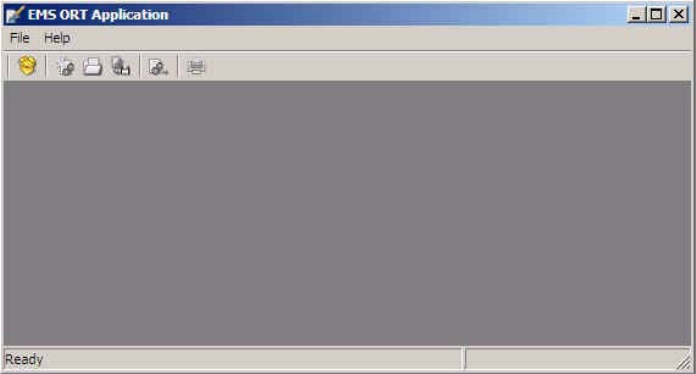
SYSTEM DESCRIPTION, INSTALLATION, AND MAINTENANCE MANUAL
eNfusion® HSD-440 Mark 2 Terminal
23-15-30 6-33
3 JUN 10
• Searching for an ORT Parameter
A. Creating an ORT Configuration
Creating an ORT configuration includes:
• Opening the ORT file template
• Editing parameters
• Saving the ORT configuration
To open an ORT configuration template:
1. Double-click on the ortedit.exe file.
The EMS ORT Application opens.
2. Click File, and then click Open Package.
The Choose ORT Package dialog box opens.
3. Navigate to the HSD440.ort file and click Open.
The default ORT parameters appear in the EMS ORT Application window.

SYSTEM DESCRIPTION, INSTALLATION, AND MAINTENANCE MANUAL
eNfusion® HSD-440 Mark 2 Terminal
23-15-30 6-34
3 JUN 10
The EMS ORT Application organizes ORT parameters into functional groups. You can
access each group by clicking on its tab at the top of the window. A lock symbol marks
groups of secure ORT parameters, and an open lock symbol marks the group of user
ORT parameters. Click the left and right arrows to see more tabs.
The functional groups of parameters are:
• Part Number—the part number of the Secure ORT
• Satellite Network
•MCDU
• CMC/CMU
•IRS
• Antenna
• 4-wire/POTS/CEPT-E1
• Routing
• Ethernet
• System
• User—all User parameters

SYSTEM DESCRIPTION, INSTALLATION, AND MAINTENANCE MANUAL
eNfusion® HSD-440 Mark 2 Terminal
23-15-30 6-35
3 JUN 10
To edit ORT parameters:
1. Click on the tab for the functional group that contains the parameter you wish to
edit.
2. Click on a parameter name in the Name column, then click on the parameter
value in the Value column.
For parameters with text or numerical values, the cursor appears. For parameters
with preset options, a menu appears.
NOTE: Some parameters are expandable. Click on the plus sign to the left of
the parameter name to expand the parameter. Alternatively, right-click
on the parameter name and click Expand all.
3. Type or select the new value for the parameter.
NOTE: To reset a parameter to its default value, right-click on the parameter
and click Reset to default.
The ORT application can save an ORT configuration as an XML file. If you do not finish
editing all the ORT parameters in one session, you can save the ORT configuration file
and re-open it at a later time. The XML file is not uploaded to the HSD-440 Mark 2
Terminal, it can only be opened in the ORT application for parameter editing.
To save an ORT configuration file:
1. In the EMS ORT Application, click File, and then click Save As.
The Save As dialog box opens.
2. In the File name field, type a name for the new ORT configuration, and then click
Save.
The new ORT configuration is saved as an XML file.
B. Opening a Saved ORT Configuration
The EMS ORT Application saves ORT configurations as XML files. You can open these
XML files in the EMS ORT Application.
To open a saved ORT configuration:
1. In the EMS ORT Application, click File, and then click Open.
The Select a file dialog box appears.
2. Click on a saved ORT configuration and then click Open.
The saved ORT configuration appears in the EMS ORT Application window.
C. Importing a Phone Book Into the ORT Configuration
The EMS ORT Application can import data into its Address book parameter. The data in
the Address book parameter includes:
• Name—the name displayed to identify the address book entry
• Number—the phone number
• Priority—the priority setting for calls to this number
• MCDU Editable—enables and disables changes to this entry from the MCDU

SYSTEM DESCRIPTION, INSTALLATION, AND MAINTENANCE MANUAL
eNfusion® HSD-440 Mark 2 Terminal
23-15-30 6-36
3 JUN 10
The ORT Address book parameter includes four categories with 100 entries in each
category. You can create and import a separate file for each category.
The EMS ORT Application creates address book entries from imported Comma
Separated Value (CSV) files that have the .csv file extension. You can create .csv files
with Microsoft® Excel®.
Importing a phone book includes:
• Creating a .csv file
• Importing the .csv file into the EMS ORT Application
To create a .csv file:
1. Open Microsoft Excel.
2. Type the following into the specified cells, as shown below:
• cell A1—addressBook/addressBookCategory[1]
• The EMS ORT Application adds the entries in this file into Category 1 of
the Address book.
• To create categories two, three, and four, change the category number
inside the square brackets. You need to create a separate .csv file for
each category.
• cell A2—abeName
• cell B2—abeNumber
• cell C2—abePriority
• cell D2—abeMCDUEditable
3. For each entry you want to add to the address book, type data in the columns
abeName, abeNumber, abePriority, and abeMCDUEditable. Each row
represents one address book entry:
• In column abeName, type the name of the address book entry. The maximum
length of the name is 14 alphanumeric characters.
• In column abeNumber, type the phone number without hyphens or spaces.
The maximum length of the phone number is 18 digits.
• In the column abePriority, type the priority of this entry. Priority may be one
of OP-HI, OP-LO, NON-OP, or EMG.
• In the abeMDCUEditable column, type YES or NO to indicate if this entry is
editable from the MCDU.

SYSTEM DESCRIPTION, INSTALLATION, AND MAINTENANCE MANUAL
eNfusion® HSD-440 Mark 2 Terminal
23-15-30 6-37
3 JUN 10
4. Save the spreadsheet as a .csv file.
To import a .csv file:
1. Open the EMS ORT Application.
2. Open an ORT file or create a new file—refer to “Creating an ORT Configuration”
on page 6-33 and “Opening a Saved ORT Configuration” on page 6-35.
3. In the EMS ORT Application, click File, and then click Import Phonebook.
The Choose CSV File dialog box appears.
4. Click on the CSV file and then click Open.
The Import Phonebook message confirms the number of entries imported from
the CSV file, and the EMS ORT Application adds the entries to the ORT
configuration.
D. Exporting an ORT File
The HSD-440 Mark 2 Terminal control processor uses a special file type that you can
export from the EMS ORT Application. When you export a file, the EMS ORT Application
creates two files—one for the control processor and one text (.txt) file for your reference.
To export an ORT file:
1. In the EMS ORT Application, click File, and then click Export.
The Choose Output File dialog box appears.
2. Type a new file name (no extension) in the File name box and then click Save.
The ORT configuration is exported (two files are created) and the Export
Document dialog box appears.
3. Click OK.
E. Loading an ORT File into the HSD-440 Mark 2 Terminal
You can load an exported ORT file into the HSD-440 Mark 2 Terminal through the
Ethernet connection.
To load the ORT file you’ll need:
• A computer with the tftp application
An ethernet cable
• A serial cable—see section b: "Maintenance Port Cable Assembly" on page 4-37.
• The IP address of the terminal’s Ethernet 1 port
SYSTEM DESCRIPTION, INSTALLATION, AND MAINTENANCE MANUAL
eNfusion® HSD-440 Mark 2 Terminal
23-15-30 6-38
3 JUN 10
To load an ORT file into the HSD-440 Mark 2 Terminal:
1. Connect a computer to an Ethernet port and the Maintenance Port on the
HSD-440 Mark 2 Terminal.
2. Copy the ORT file to the computer.
3. Start a HyperTerminal session to the Maintenance port of the HSD-440 Mark 2
Terminal.
Section c: "Interface Requirements" on page 4-38 provides the settings for this
connection.
4. To access the Maintenance Port Utility, type the password maint.
The password does not appear on the screen.
5. To navigate to Menu 2, press CTRL + N.
6. To allow tftp access to the terminal, in Menu 2, press l.
7. At the prompt, type the new password allowtftp.
A message confirms that tftp is allowed for ten minutes.
8. On your computer, click Start, and then click Run.
The Run dialog box appears.
9. In the Open field, type cmd.
The Command window appears.
10.Navigate to the directory that includes the new ORT file.
11. To load the ORT file, type tftp -i xxx.xxx.xxx.xxx put filename.
• xxx.xxx.xxx.xxx represents the IP address of the Ethernet 1 port.
• filename represents the name of the new ORT file.
When the tftp application loaded the file to the HSD-440 Mark 2 Terminal, a short
message confirms the number of bytes transferred.
12.To transfer the ORT parameters to the SCM, in Menu 3, press r.
13.At the prompt to transfer the ORT parameters to the SCM, type yesido.
The number of transferred bytes indicates the transfer progress.
The ORT file load is complete.
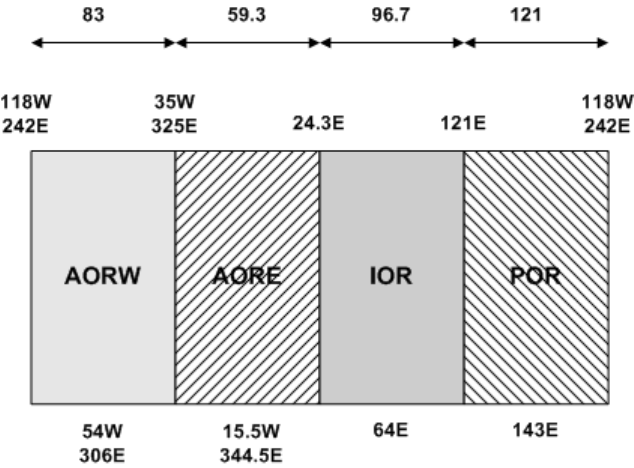
SYSTEM DESCRIPTION, INSTALLATION, AND MAINTENANCE MANUAL
eNfusion® HSD-440 Mark 2 Terminal
23-15-30 A-1
3 JUN 10
APPENDIX A: INMARSAT SATELLITE BEAM
COVERAGE
Inmarsat operates strategically placed geostationary satellites called I-3 and I-4. I-3 satellites
provide access to services such as Swift 64 and Aero H/H+, and I-4 satellites provide access to
SBB and Aero H/H+ services.
1. I-3 Satellites
Each I-3 satellite is located over and named after an OR. The four satellite ORs are:
• Atlantic Ocean Region-East (AOR-E)
• Atlantic Ocean Region-West (AOR-W)
• Indian Ocean Region (IOR)
• Pacific Ocean Region (POR)
Figure A-1 represents the ORs with approximate transfer coordinates for satellite transitions.
Figure A-1 ORs
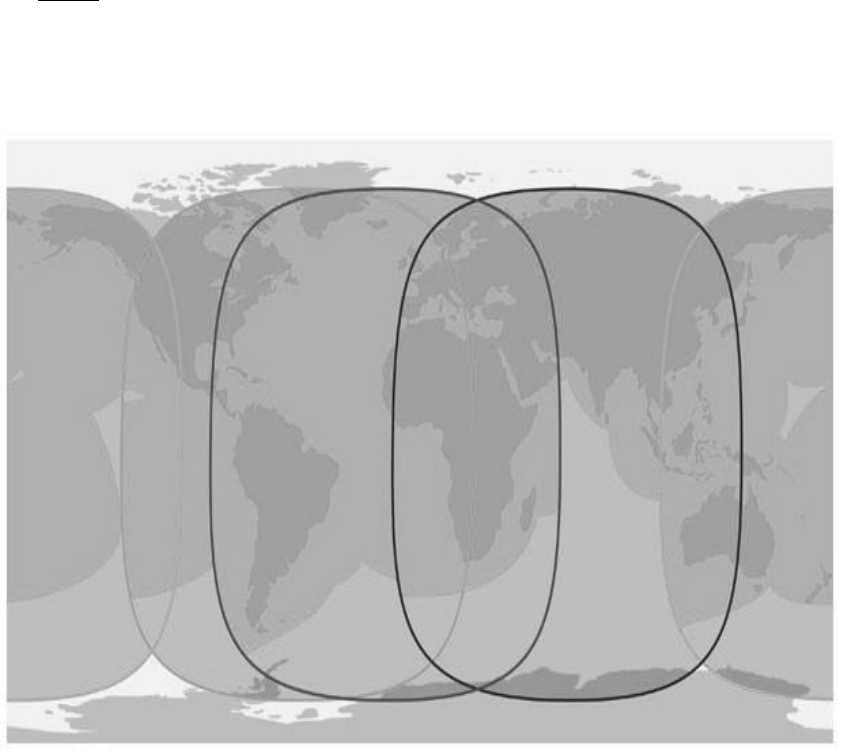
SYSTEM DESCRIPTION, INSTALLATION, AND MAINTENANCE MANUAL
eNfusion® HSD-440 Mark 2 Terminal
23-15-30 A-2
3 JUN 10
The four satellite ORs are made up of smaller, spot-beam coverage areas. The following maps
show the Inmarsat satellite spot-beam coverage for the four ORs, and a composite map of the
four regions combined.
NOTE: Figure A-2 and Figure A-3 depict Inmarsat's expectations of coverage but do not
represent a guarantee of service and should not be relied upon. The availability of
service at the edge of coverage areas fluctuates depending upon a variety of
conditions.
Figure A-2 Inmarsat I-3 Satellite Beam Coverage—Composite Map
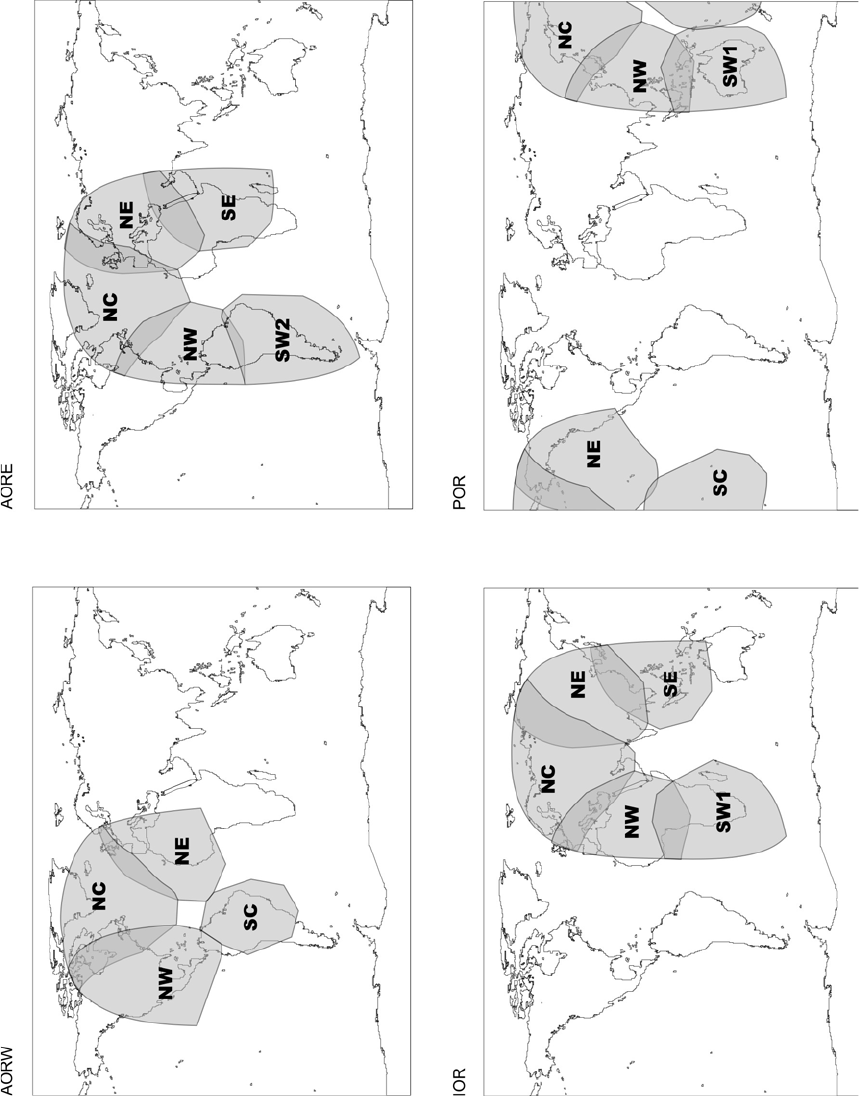
SYSTEM DESCRIPTION, INSTALLATION, AND MAINTENANCE MANUAL
eNfusion® HSD-440 Mark 2 Terminal
23-15-30 A-3
3 JUN 10
Figure A-3 Inmarsat I-3 Satellite Beam Coverage—OR Maps

SYSTEM DESCRIPTION, INSTALLATION, AND MAINTENANCE MANUAL
eNfusion® HSD-440 Mark 2 Terminal
23-15-30 A-4
3 JUN 10
2. I-4 Satellites
There are three I-4 satellites in service:
• I-4 Americas (98W)
• I-4 EMEA (25E)
• I-4 Asia-Pacific (143.5E)
Figure A-4 shows the I-4 satellite coverage regions.
Figure A-4 Inmarsat I-4 Satellite Beam Coverage Map

SYSTEM DESCRIPTION, INSTALLATION, AND MAINTENANCE MANUAL
eNfusion® HSD-440 Mark 2 Terminal
23-15-30 B-1
3 JUN 10
APPENDIX B: TROUBLESHOOTING CHECKLIST
Before performing the detailed testing and troubleshooting procedures provided in this manual,
read the following Troubleshooting Checklist. Use the Troubleshooting Checklist to make sure
that you have not missed any key steps in the HSD-440 Mark 2 Terminal setup.
1. Have you registered with a service provider to activate service?
You must activate an account with an Inmarsat-authorized service provider to access
the Satellite Communications network using an HSD-440 Mark 2 Terminal. Contact
Inmarsat for a list of available service providers at:
Inmarsat Customer Care
99 City Road, London, EC1Y 1AX
Tel: +44 20 7728 1777
Fax: +44 20 7728 1142
E-mail: customer_care@inmarsat.com
2. Has your account been activated?
Once registered, your HSD-440 Mark 2 Terminal is assigned terminal identification
numbers called FWD IDs. If you have SBB service, service information also includes
IMSI. The HSD-440 Mark 2 Terminal must be strapped accordingly. Refer to
"Installation" on page 3-1 for detailed strapping and installation instructions.
NOTE: The service registration information may take a few days to be incorporated
into the system databases at the LESGES level. New terminals being
commissioned are not validated by the LES/GES until their customer
database has been updated by Inmarsat to reflect the registration and
activation of your terminal.
NOTE: To verify that the service registration information has been validated at the
LES/GES, call 33 POUND KEY for assistance. Confirm with the LES/GES
operator that the FWD IDs assigned to your terminal are valid and active.
3. Is the HSD-440 Mark 2 Terminal seated properly?
In cases where the HSD-440 Mark 2 Terminal is not fully seated into the ARINC 600
connector (to the rear of the Fan Tray), the user may experience intermittent system
operation. If intermittent system operation occurs:
• Check that the polarization pins are installed correctly as indicated on the
applicable Outline and Installation diagram.
• Make sure that the HSD-440 Mark 2 Terminal is fully inserted into the tray and
that the front hold-down screws are securely tightened.
SYSTEM DESCRIPTION, INSTALLATION, AND MAINTENANCE MANUAL
eNfusion® HSD-440 Mark 2 Terminal
23-15-30 B-2
3 JUN 10
4. Is all cabling attached correctly and securely?
Broken connections and improper cabling are the most common causes of HSD-440
Mark 2 Terminal malfunctions. Before proceeding with testing and troubleshooting,
complete the following checks:
• Check that all cables and wiring are routed and connected correctly and securely.
• Make sure that the terminal is installed with the correct power source.
• Verify that all external user and networking devices (for example: TAs, routers,
fax, telephones, computers) are connected and configured properly.
5. Have any changes to the system been made?
For previously installed and functional terminals, make note of any changes made
to the system since the last time the terminal functioned without problems.
• Were any new devices or systems connected to the terminal?
• Have any connecting devices or equipment been removed or replaced? If so,
check that all new or replaced connections are attached and configured correctly.
• Have you changed service providers or re-configured the system in any way?
6. Are your Primary and Secondary LES/GES Access Codes programmed for all
ORs?
The system default for LES/GES access codes is set to 0 (zero), which must be
configured to valid LES/GES access codes before operation. Refer to "System
Operation" on page 2-1 for details.
7. Was the operational mode of the system strapped or configured correctly?
Verify that the system mode wiring straps match the installation configuration mode.
8. Are the SIM cards activated?
Activate report 69 and check that the OC column of the report shows ATCH (attached)
then dial a SBB call.
9. Is the APN set?
Verify that the APN is set.
1. Navigate to Menu 3 in the Maintenance Port Utility.
2. In the list of ORT parameters, navigate to and type the number next to the
miscellaneous EEPROM settings.
3. To view or set the APN, type the number next to the APN and then press ENTER.
10.Are GES preferences correctly set?
To verify GES preferences:
1. Navigate to Menu 3 in the Maintenance Port Utility.
2. In the list of ORT parameters, navigate to and type the number next to the Ocean
Region parameters.
SYSTEM DESCRIPTION, INSTALLATION, AND MAINTENANCE MANUAL
eNfusion® HSD-440 Mark 2 Terminal
23-15-30 B-3
3 JUN 10
3. To view GES preferences, type the number next to the GES preference, and
then press ENTER.
The GES priority table appears.
The eNfusion® HSD High-speed Data Terminal Developer’s Guide,
MN-1252-13005, provides more information about GES preferences.
SYSTEM DESCRIPTION, INSTALLATION, AND MAINTENANCE MANUAL
eNfusion® HSD-440 Mark 2 Terminal
23-15-30 B-4
3 JUN 10
Blank Page
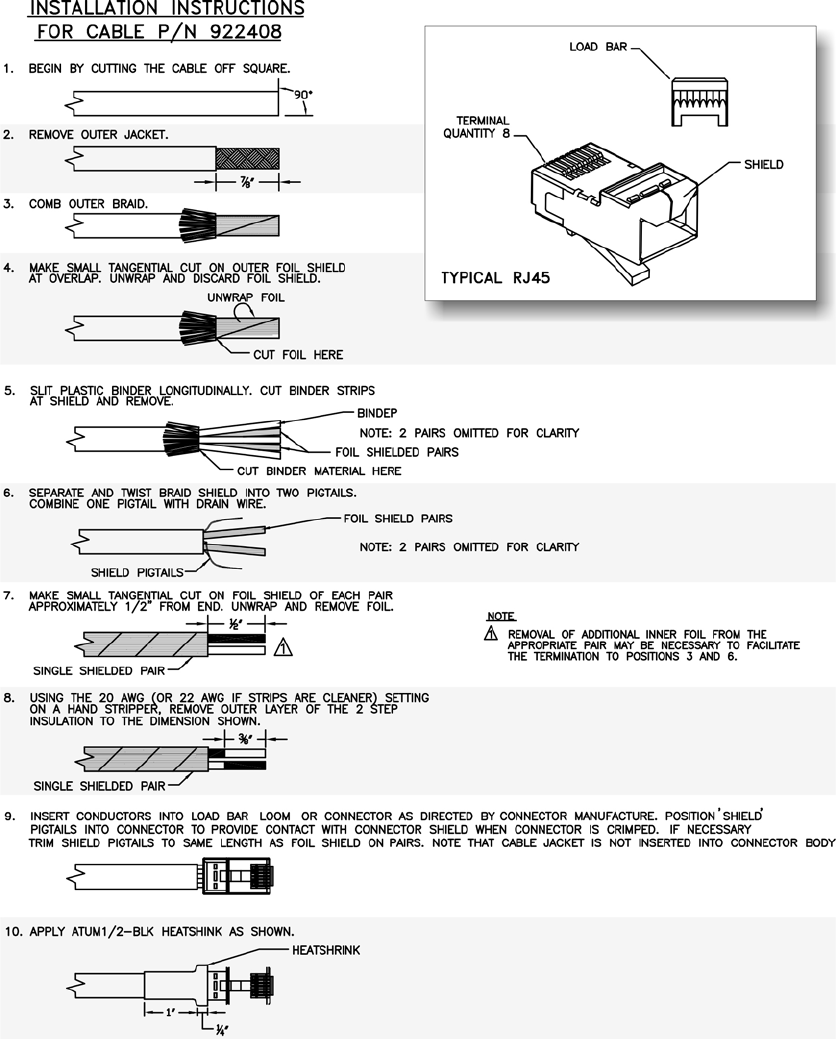
SYSTEM DESCRIPTION, INSTALLATION, AND MAINTENANCE MANUAL
eNfusion® HSD-440 Mark 2 Terminal
23-15-30 C-1
3 JUN 10
APPENDIX C: RJ45 CABLE TERMINATION DETAILS
SYSTEM DESCRIPTION, INSTALLATION, AND MAINTENANCE MANUAL
eNfusion® HSD-440 Mark 2 Terminal
23-15-30 C-2
3 JUN 10
Blank Page
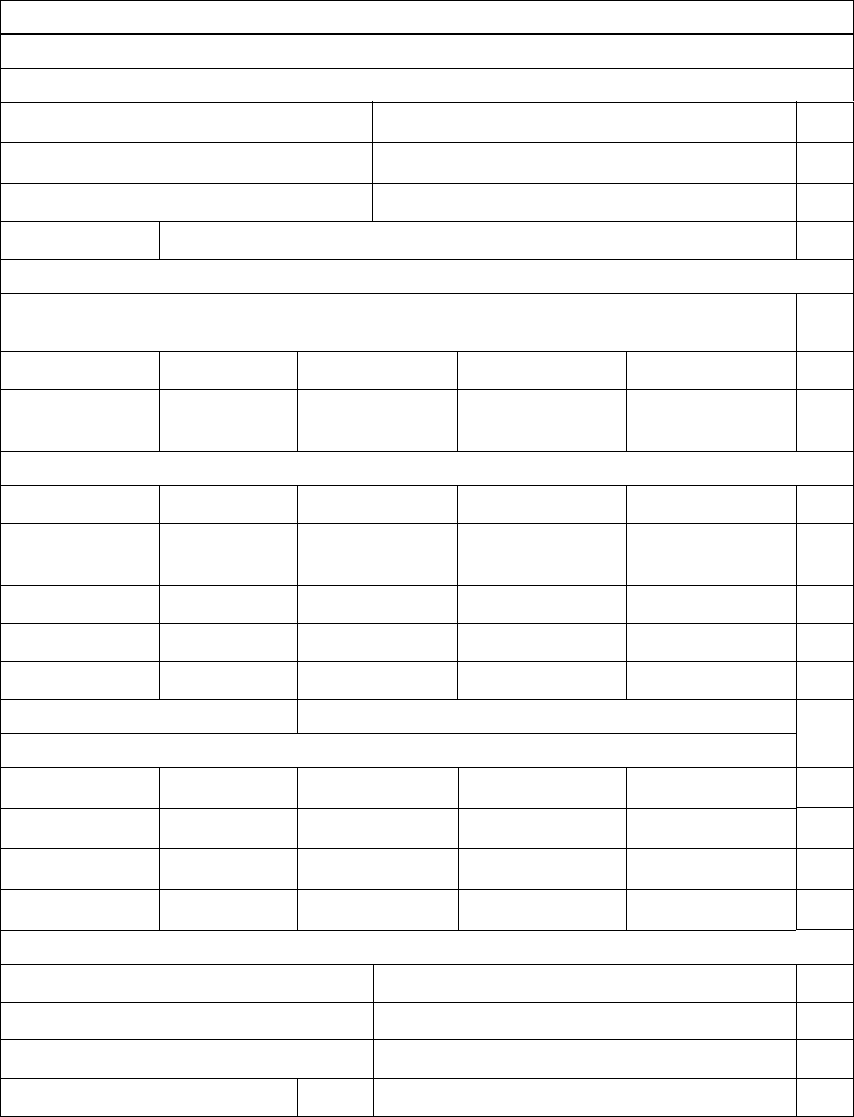
SYSTEM DESCRIPTION, INSTALLATION, AND MAINTENANCE MANUAL
eNfusion® HSD-440 Mark 2 Terminal
23-15-30 D-1
3 JUN 10
APPENDIX D: INSTALLATION PLANNING CHECKLIST
Installation Planning Steps
1. Register the terminal for services (if applicable)
Record the following information (provided by Honeywell upon purchase)
Inmarsat Serial Numbers (ISN) x 1
2
IMSI #1
Contact your Service Provider and provide the 12-digit ISNs from above
Record the FWD IDs received (from your Service Provider or from Inmarsat) and
corresponding Inmarsat Mobile Numbers (IMN)
FWD IDs
(last 6 digits of ISN)
IMNs
ISDN Speech
ISDN
(3.1 kHz audio)
ISDN 56 kbps
ISDN 64 kbps
MPDS
Service Provider
AOR-W
AOR-E
IOR
POR
2. Register the terminal for SBB services (if applicable)
APN
Master MSISDN
AMSISDN 1 ISDN 56 (RDI)
AMSISDN 1 ISDN64 (UDI)
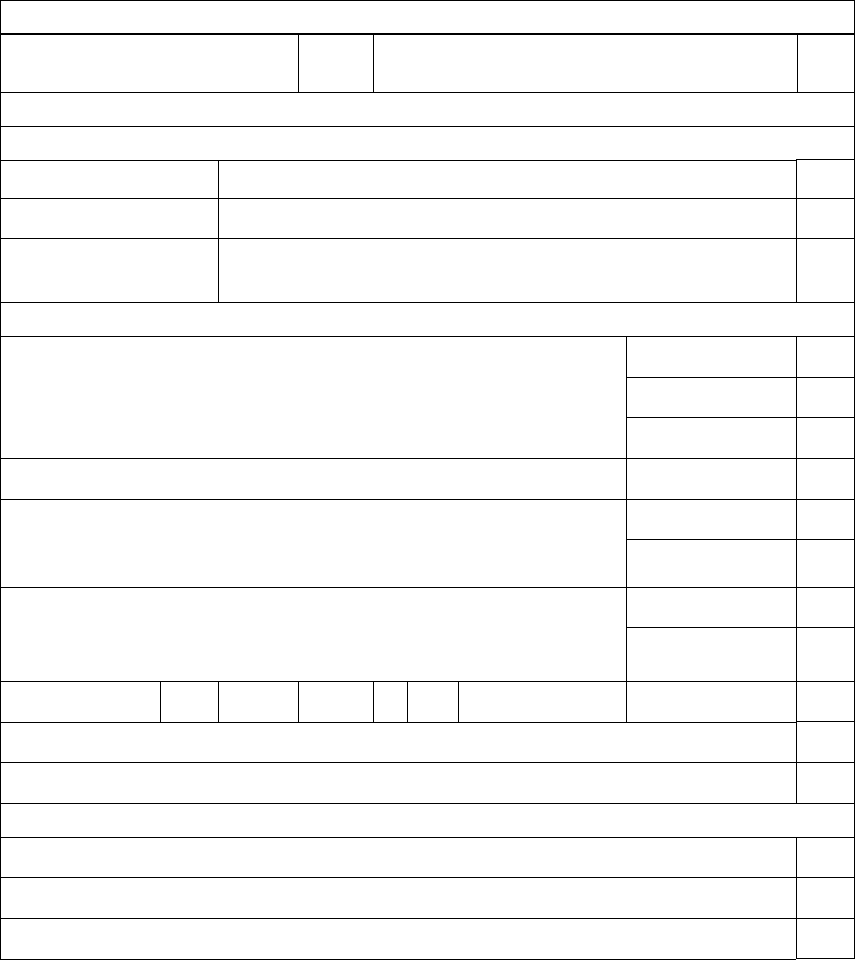
SYSTEM DESCRIPTION, INSTALLATION, AND MAINTENANCE MANUAL
eNfusion® HSD-440 Mark 2 Terminal
23-15-30 D-2
3 JUN 10
AMSISDN 5 CSFAX (3.1 kHz
audio)
3. Pin Strapping
The following strapping is required
Item Strapped pins, e.g., TP1A to BP1A
System Mode
Data I/O
(if applicable)
4. Wiring
Antenna Multi-Control
BITE A/B
HPA Mute A/B
Power
ISDN:
Wire ISDN line. Channel 1 operates over ISDN 1 and channel 3 over
ISDN 2.
ISDN-1
ISDN-2
Ethernet:
Wire both Ethernet ports for SBB capability
Wire both Ethernet ports to deploy 2 separate networks
Ethernet-1
Ethernet-2
Inertial Navigation System (INS)
Analog Tip/Ring
5. Configuration
Program the Land Earth Station (LES)/Ground Earth Station (GES) Access Codes
Program devices with the Multiple Subscriber Numbers (MSN)
Configure the CNX Cabin Gateway if required
Installation Planning Steps
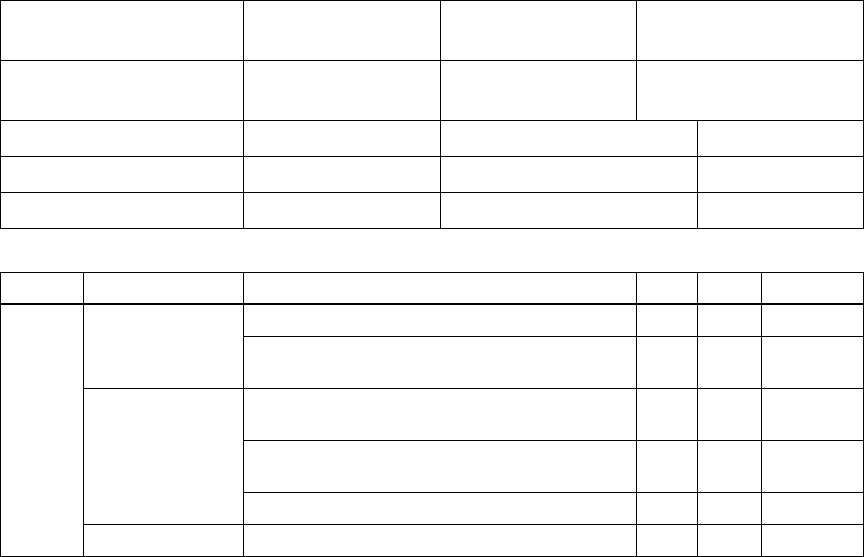
SYSTEM DESCRIPTION, INSTALLATION, AND MAINTENANCE MANUAL
eNfusion® HSD-440 Mark 2 Terminal
23-15-30 E-1
3 JUN 10
APPENDIX E: INSTALLATION CHECKLIST
Aircraft Identification: HSD-440 Mark 2
Terminal Model No:
HSD-440 Mark 2 Terminal
Installation Mode: HSD-440 Mark 2
Terminal Serial No:
Name Signature Date
Checks completed by:
Approved/Witnessed by:
Section Parameter Item N/A 9Value
Installation / Mechanical
Physical
Service/maintenance access
Environmental considerations—see
"Environmental Requirements" on page 3-2
Fan Tray
Plug configuration—see "Fan Tray
Requirements" on page 3-3
Chassis bonding—see "Chassis Grounding"
on page 3-4
Fan rotation—unobstructed
ARINC 600 Con. Polarized pins
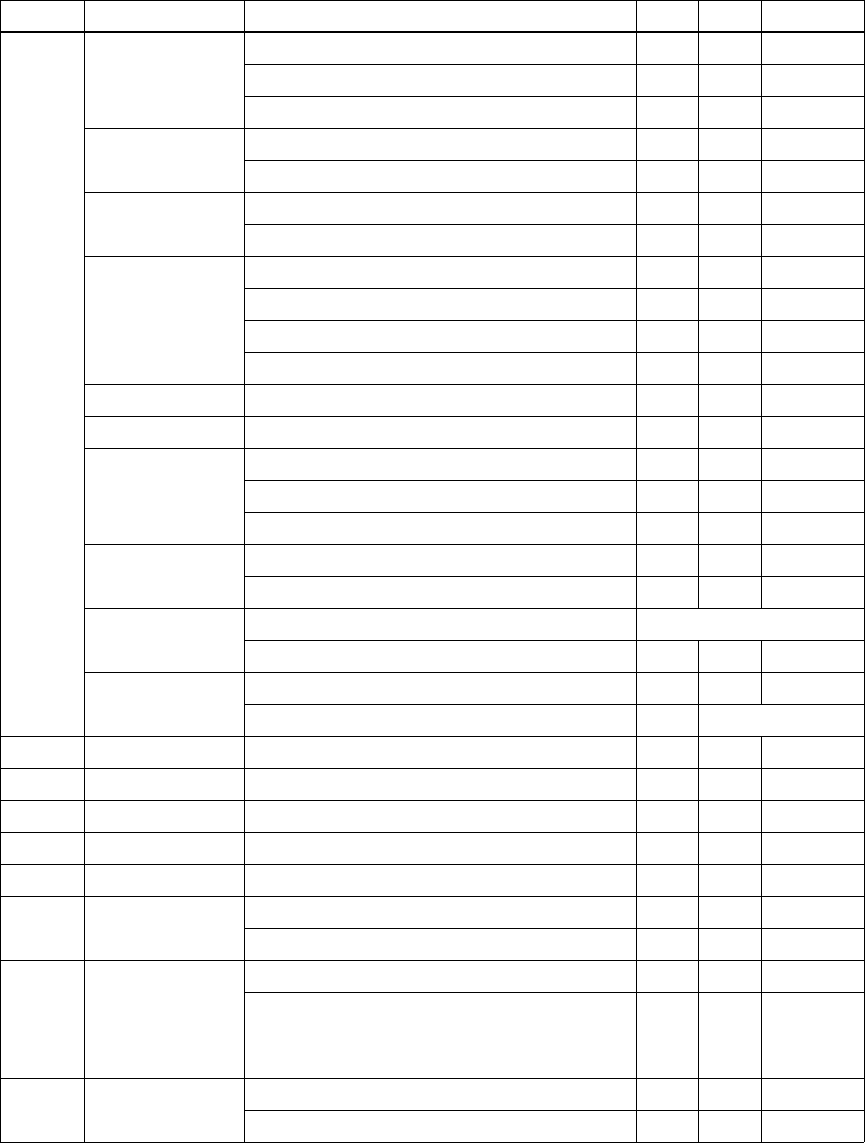
SYSTEM DESCRIPTION, INSTALLATION, AND MAINTENANCE MANUAL
eNfusion® HSD-440 Mark 2 Terminal
23-15-30 E-2
3 JUN 10
Move the aircraft in a circle and check the signal and C/No.
Installation / Electrical
Power
Connections
+ 28 V dc polarity
115 V ac polarity
Chassis grounding
Voltage Levels + 28 V dc level
115 V ac level
IRS Input (x2) IRS wiring
IRS format
Config. Strap
Pins
SDI
System configuration
ICAO address
WOW (optional)
Ethernet Wired to RJ45 distribution points (x2)
ISDN Wired to RJ45 distribution points
Remotes
Manual reset switch operation
Maintenance port (DB9 access)
Power and fault indicators
RF Coaxial Rx input cable loss
Tx output cable loss
Antenna Antenna manufacturer and type
Wired as per manufacturer
Configuration LES/GES access codes
ICAO ID
CEPT Wired to distribution point
CMU/CMC Wired to equipment
MCDU/WSCI Wired to equipment
4-Wire (x2) Wired to equipment
POTS Wired to distribution point
Test
System
Power-Up
Visual LED indications
Power-up computer display
Test On-Air
System Logon
Reset message observed
Logon verified for Swift 64 and SBB
Test
Optional Checks Ground segment
Flight segment
Section Parameter Item N/A 9Value

Heading
(Deg) Antenna
Selected Antenna
Azimuth HSD-440 Mark 2 Terminal
Swift 64 or SBB Classic
CH 1 CH 2 CH 3 CH 4 CH 5
Note: Channels 3, 4, and 5 can be different than channels 1,
and 2.
C/NoSignalC/NoSignalC/No SignalC/NoSignalC/No Signal
15
30
45
60
75
90
105
120
135
150
165
180
195
210
225
240
255
270
285
300
315
330
345
360
SYSTEM DESCRIPTION, INSTALLATION, AND MAINTENANCE MANUAL
eNfusion® HSD-440 Mark 2 Terminal
23-15-30 E-3
3 JUN 10
SYSTEM DESCRIPTION, INSTALLATION, AND MAINTENANCE MANUAL
eNfusion® HSD-440 Mark 2 Terminal
23-15-30 E-4
3 JUN 10
Blank Page

SYSTEM DESCRIPTION, INSTALLATION, AND MAINTENANCE MANUAL
eNfusion® HSD-440 Mark 2 Terminal
23-15-30 F-1
3 JUN 10
APPENDIX F: CMU MESSAGES
The CMU communicates with the HSD-440 Mark 2 Terminal using two types of communications:
Broadcast messages and Bit Oriented Protocol (BOP) messages. Both types of communication are
supported at the same time.
This section includes descriptions of the messages that the CMU will transmit to the HSD-440 Mark
2 Terminal and receive from the HSD-440 Mark 2 Terminal.
In this communication type, the CMU uses an ARINC 429 bus to convey status word exchanges,
join/leave words, and other control and command communications to the HSD-440 Mark 2 Terminal
using conventional ARINC 429 broadcast techniques.
The CMU can transmit messages to the HSD-440 Mark 2 Terminal and receive messages from the
HSD-440 Mark 2 Terminal using this communication type.
1. Understanding Messages Transmitted to the HSD-440 Mark 2 Terminal
This section provides details about the words sent to the HSD-440 Mark 2 Terminal from the CMUs:
• Understanding System Identification Label 172
• Understanding Status Word 1; Label 270
• Understanding Status Word 2; Label 276
• Understanding Protocol File Transfer to CMU via Williamsburg
A. Understanding System Identification Label 172
Each CMU transmits system identification label 172 (SAL 304) to the HSD-440 Mark 2
Terminal. Attachment 6 from ARINC Characteristic 758 describes the word format of this
label. Any other SAL is ignored.
B. Understanding Status Word 1; Label 270
Each CMU transmits status word 1 to the HSD-440 Mark 2 Terminal. The standby CMU
checks to see if its status words are the same as the active CMU using its cross-talk
connections.
The HSD-440 terminal uses bit 20 to determine which CMU is active. When bit 20 is set,
that CMU is active, and the other CMU should have its bit 20 cleared. In the event of an
error and both CMUs are shown as active, the CMU on input port 1 is considered active.
Table F-1 Status Word 1
Bit Label Meaning
9270 Determines the position of the CMU in the cockpit; see Table F-2
10 270 Determines the position of the CMU in the cockpit; see Table F-2
20 270 Determines which CMU is active and which is on standby

SYSTEM DESCRIPTION, INSTALLATION, AND MAINTENANCE MANUAL
eNfusion® HSD-440 Mark 2 Terminal
23-15-30 F-2
3 JUN 10
The CMU transmits its position in the cockpit to the HSD-440 Mark 2 Terminal using bits
9 and 10, as shown in Table F-2.
Table F-2 Bits 9 and 10 Positions
SDI 1 (bit 9) SDI 2 (bit 10) Position
0 0 Single
0 1 Left
1 0 Right
1 1 Not used
Attachment 6 from ARINC Characteristic 758 describes the word format of this label.
C. Understanding Status Word 2; Label 276
Each CMU transmits status word 2 to the HSD-440 Mark 2 Terminal. The HSD-440 Mark
2 Terminal determines which CMU is sending the message based upon bits 9/10 (the
SDI) as detailed in Table F-2.
The HSD-440 Mark 2 Terminal uses the SAT Link parameter (bit 19) to determine if the
CMU is receiving the appropriate link status from the HSD-440 terminal.
Attachment 6 from ARINC Characteristic 758 describes the word format of this label.
D. Understanding Protocol File Transfer to SDU1 via Williamsburg
Data is transferred to the HSD-440 Mark 2 Terminal using Williamsburg protocol.
Williamsburg messages use the SAL of the equipment they are talking to as the label. In
this case, the label is 307 as the sub-system identifier label sent from the HSD-440 to
the CMU is 307. For more information, refer to "Understanding Word Format" on page
F-7.
2. Understanding Messages Received from the HSD-440 Mark 2 Terminal
This section provides details about the words sent from the HSD-440 Mark 2 Terminal from the
CMUs:
• Understanding System Identification Label 172
• Understanding Status Word 1; Label 270
• Understanding Join/Leave Word; Label 271
• Understanding Protocol File Transfer to CMU via Williamsburg
A. Understanding System Identification Label 172
The HSD-440 Mark 2 Terminal transmits subsytem identifier label 172 which contains
the subsystem SAL in bits 9 to 16. The SAL is set to 307 (octal). Also:
• Bit 17 is set to indicate Inmarsat Aero
• Bits 18-31 are used for other Satcom services (or are spare) and are set to 0

SYSTEM DESCRIPTION, INSTALLATION, AND MAINTENANCE MANUAL
eNfusion® HSD-440 Mark 2 Terminal
23-15-30 F-3
3 JUN 10
• Bit 32 indicates parity
You can find the HSD-440 Mark 2 Terminal identity information in the ORT. If no
information is available, the terminal identifies itself as SAL 307 by default.
ARINC 781 Supplement 1 describes the word format of these labels.
B. Understanding Status Word 1; Label 270
Bits are defined as shown in Table F-3.
Table F-3 Status Word 1 Bits
Bit(s) Description If Set
9–10 SDI (per ARINC
Specification 429
Section 2.1.4)
•Set to 00, all call
11 Data Link via CMU
Inactive • HSD-440 Mark 2 Terminal is not able to offer Aero H data
services (due to a hardware fault or terminal is not logged on)
• ORT indicates that only CMU #1 is wired and label 270 is
missing for 3 or more seconds
• ORT indicates that only CMU #2 is wired and label 270 is
missing for 3 or more seconds
• ORT indicates that both CMU #1 and CMU #2 are wired and
both label 270 are missing for 3 ore more seconds
12 CMU 1 Inactive • CMU #1 bus label 270 is missing for 3 or more seconds
• Label 270 SSM coded to fail
• Label 270 bit 20 is not set
13 Voice Unavailable • Class Aero is not logged on
• Login Class is 1 or 4 (data only)
14 SELCAL This bit is set during the period when a ground to air call, including
a preemptive call, is being signaled but unanswered. If set:
• Indicates that a new cockpit voice circuit has been
established for a ground-initiated call
• Depending on the aircraft setting, this bit may result in a visual
annunciation of the new call on the EICAS/ECAM/EDU and
activation of the cockpit chime
• Crew should refer to the EICAS/ECAM/EDU to determine
which system is annunciating the call
• Bit should remain set until an appropriate acknowledgement
is received
• Crew should make sure that the bit has been cleared in all
transmitted samples for at least two seconds prior to being
set, and then set for at least four seconds or until the
annunciation is acknowledged, whichever occurs last

SYSTEM DESCRIPTION, INSTALLATION, AND MAINTENANCE MANUAL
eNfusion® HSD-440 Mark 2 Terminal
23-15-30 F-4
3 JUN 10
* These bits are cleared when the chime light inhibit discrete signal is asserted.
15 Message Alert with
Chime • Refer to MCDU messages for timely information
• Terminal should clear this bit once positive pilot response has
been detected
16 Message Alert without
Chime • This bit is never set, it is reserved for future use.
17 Not Logged-On • Terminal is not logged onto a ground station
18 Master/Slave • This bit is never set, slave operation is not supported.
•
19 CMU 2 Inactive • CMU 2 transmission of valid Label 270 is detected inactive
• Label 270 SSM coded to fail on CMU #2
• Label 270 bit 20 is not set
20 Cockpit Fault • Not used
21 Cockpit Voice Fault • Not used
22 Voice Call 1 • Terminal has detected a low priority (4) flight deck incoming
voice call on channel 1
23 Voice Call 2 • Terminal has detected a low priority (4) flight deck incoming
voice call on channel 2
24 Voice Alert 1 • Terminal has detected a high priority (1, 2, or 3) flight deck
incoming voice call on channel 1
25 Voice Alert 2 • Terminal has detected a high priority (1, 2, or 3) flight deck
incoming voice call on channel 2
26 Cockpit Voice
Communication 1 • A cockpit voice communication is connected on channel 1
27 Cockpit Voice
Communication 2 • A cockpit voice communication is connected on channel 2
28 • Never set
29 Data • No active CMU is available at the SDU, or the active CMU
does not respond with a Loop Word in response to a Test
Word
• This bit being set can be caused by the following:
• Bus inactivity on all CMU inputs
• Bus activity, but no declared active CMU
• Bit may be used to set a cockpit advisory message (for
example, >SATCOM DATA) indicating to the flight crew a loss
of data link capability due to a failure in the CMU interface.
Table F-3 Status Word 1 Bits (Continued)
Bit(s) Description If Set
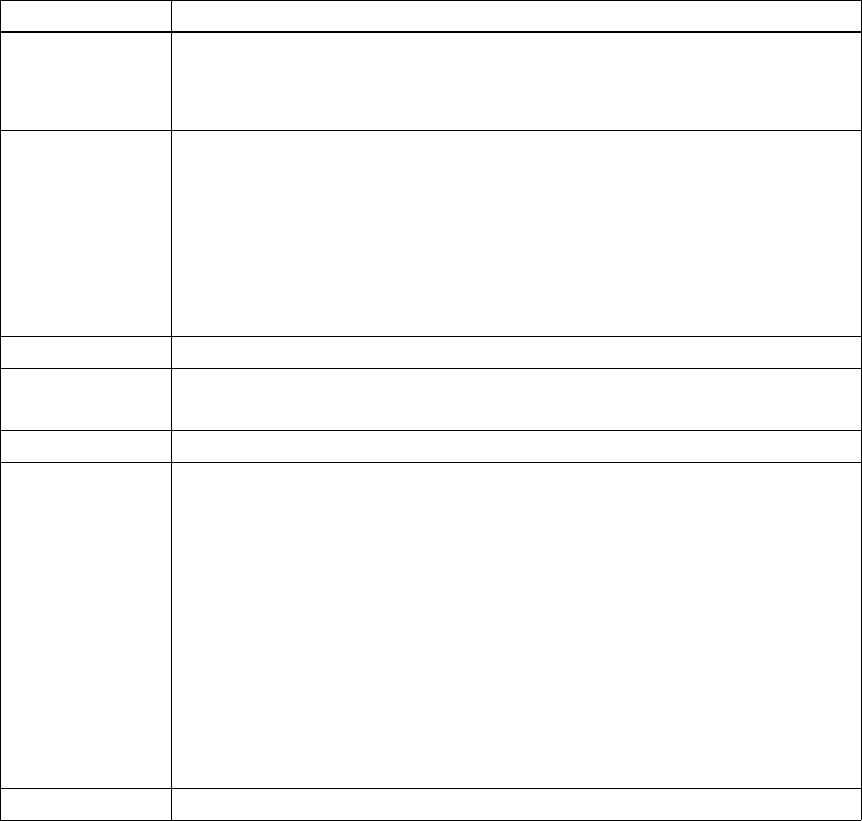
SYSTEM DESCRIPTION, INSTALLATION, AND MAINTENANCE MANUAL
eNfusion® HSD-440 Mark 2 Terminal
23-15-30 F-5
3 JUN 10
C. Understanding Join/Leave Word; Label 271
Each of the Aeronautical Telecommunications Network (ATN) subnetworks transmits join
and leave words to the CMU whenever a path to a specified ground address changes.
The join event notifies the CMU that a new path to a specified ground address is available,
triggering ATN air-to-ground communications. The leave event notifies the CMU that a
path to a specified ground address has been closed, ending ATN air-to-ground
communications.
The Join/Leave word (label 271) is transmitted on the CMU bus at a minimum rate of
once per second or be event driven based on log on and log off events as specified by
the 'CMU - SDU JOIN/LEAVE WORD TRANSMISSION' ORT parameter.
Table F-4 shows the definitions of the bits in the join/leave word.
Table F-4 Join/Leave Word Bits
Bits Defines
Bits 8–1 Word Label 271:
• Uses the A429 convention
• Coded as 10011101
Bits 16–9 GES ID:
• 0 is an invalid ID
• FF is used for all GESs
• ID numbers between 1 and FE are valid GES IDs
• GES ID is known to the HSD-440 Mark 2 Terminal
• Bits are cleared when the HSD-440 Mark 2 Terminal is not logged on
Bits 22–17 Satellite ID
Bits 25–23 Inmarsat Service:
• Aero H+ 011
Bits 28–26 Not used; padded with zeros
Bit 29 Data link from the AES to the GES:
• Available (a Join message; Bit = 1)
• Not Available (a Leave message; Bit = 0)
• Identified by the GES ID and Satellite ID fields
• CMU uses this information to initiate network layer virtual circuits with
available ground routers by determining the ground routers’ DTE
addresses from the provided GES identity
• Bits 9–16, (GES) and Bits 17–22 (Satellite ID) uniquely identify a GES
• Aero Service Type field may be used by the CMU to make routing decisions
• Bit is cleared when the HSD-440 Mark 2 Terminal is not logged on.
Bits 31–30 SSM information (ARINC 429 para 2.1.5.2)
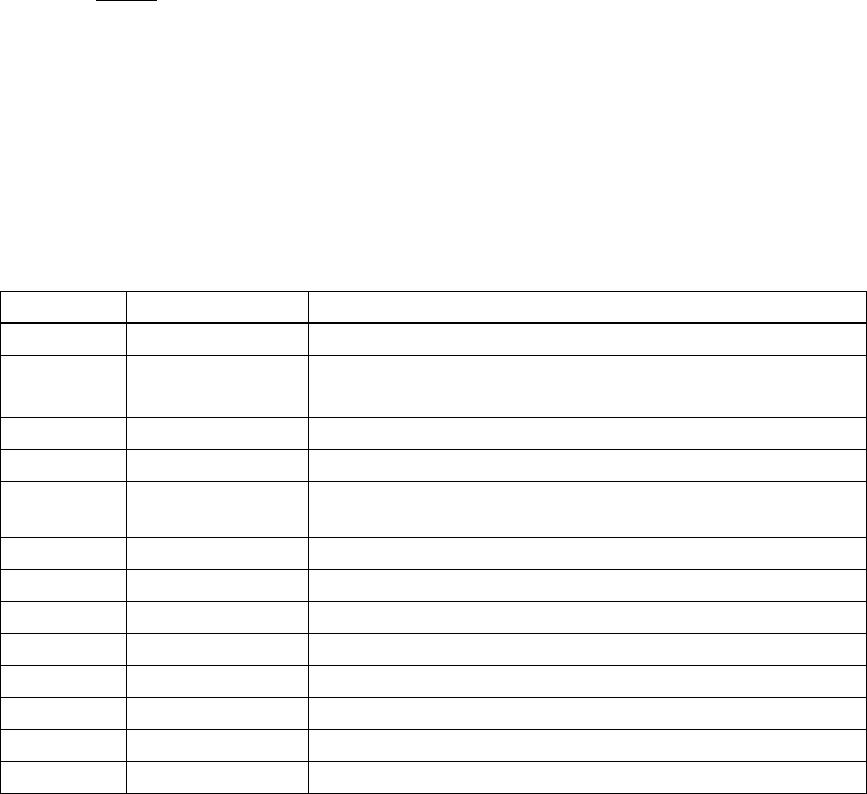
SYSTEM DESCRIPTION, INSTALLATION, AND MAINTENANCE MANUAL
eNfusion® HSD-440 Mark 2 Terminal
23-15-30 F-6
3 JUN 10
D. Understanding Protocol File Transfer to CMU via Williamsburg
Data is transferred to the CMU using Williamsburg protocol. Williamsburg messages use
the SAL of the equipment they are talking to as the label. In this case, the label is 304 as
the sub-system identifier label sent from the HSD-440 to the CMU is 304. For more
information, refer to "Understanding Word Format" on page F-7.
NOTE: Universal brand CMUs broadcast a different SAL in Label 172, but expect
transmission on a SAL of 304. This is achieved through the use of the CMU-SDU
HARD CODED SAL ORT parameter.
3. Understanding BOP Options
The HSD-440 Mark 2 Terminal uses the following BOP options for the CMU interface. The ORT
specifies the values for these options. If no information is available, then the options default to
the values shown in Table F-5.
Table F-5 BOP Option Defaults
Option Value Notes
O1 Half Half or Full Duplex Operation
O2 ORT value High or Low Speed Bus
Low speed is default
O3 No Automatic CTS when ready
O4 No Accept Automatic CTS
O5 Yes (high-speed
data terminal) System Priority to Resolve RTS Conflict
O6 -- Spare
O7 -- Spare
O8 Yes Use of SOLO word
(TEST/LOOP)
O9 -- Spare
O10 Yes Destination code in RTS/CTS /NCTS/BUSY Used
O11 Yes Bit-Protocol verification
O12 No Use subsystem SAL from ALO word
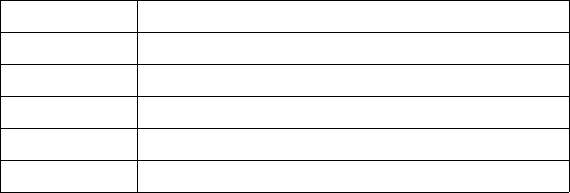
SYSTEM DESCRIPTION, INSTALLATION, AND MAINTENANCE MANUAL
eNfusion® HSD-440 Mark 2 Terminal
23-15-30 F-7
3 JUN 10
4. Understanding LDUs and File Size
BOP messages use Link Data Units (LDUs) encoded in binary octets to transmit data. LDUs
conform to the following rules:
• The data is transmitted from a source and is received by a sink.
• LDUs consist of a set of contiguous ARINC 429 32 bit data words.
• The initial data word of each LDU shall be a Start of Transmission (SOT) word.
• The end data word of each LDU shall be an End of Transmission (EOT).
• No data file shall exceed 255 LDUs.
5. Understanding LDU Size and Word Count
LDUs may vary in size from 3 to 255 ARINC 429 words. The minimum LDU consists of one
SOT word, one data word, and one EOT word, and the maximum LDU consists of one SOT,
253 data words, and one EOT.
The HSD-440 Mark 2 Terminal calculates word count when it organizes an LDU for transmission.
The word count appears in the RTS and CTS data words. See "Understanding Protocol Words"
on page F-9.
6. Understanding Word Format
The general word format of a BOP word is given in ARINC 429 (Attachment 11, Table 11-A).
The bit definitions are shown in Table F-6.
Table F-6 BOP Word Format
Bit Position Description
8-1 SAL
24-9 Data (28-9 for full data words)
28-25 GFI, control data or word type extensions
31-29 Word type
32 Parity bit
A. Understanding SALs
The HSD-440 Mark 2 Terminal sends LDUs by point to point by using a label field to carry
the destination SAL; therefore, each LDU that the HSD-440 Mark 2 Terminal sends is
prefixed by the SAL for the CMU, SAL 304.
The SAL for the HSD-440 Mark 2 Terminal is 307 (if designated SDU 1) or 173 (if
designated SDU 2). See ARINC 429, Part 1, attachment 1-1 for a complete list of all SALs.
B. Understanding Data
Data is sent in 4 or 5 nibble words. See "Understanding Word Types" on page F-8
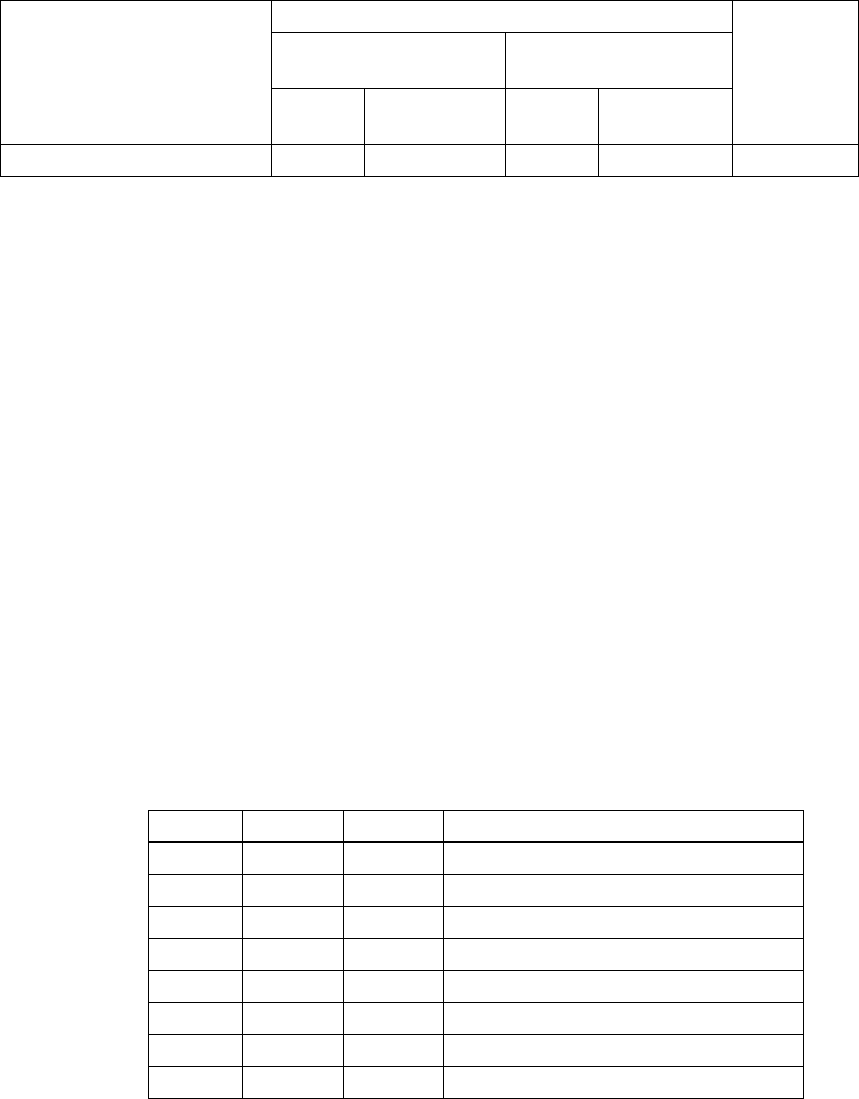
SYSTEM DESCRIPTION, INSTALLATION, AND MAINTENANCE MANUAL
eNfusion® HSD-440 Mark 2 Terminal
23-15-30 F-8
3 JUN 10
C. Understanding General Format Identifier (GFI) Definitions
Table F-7 defines the GFI definitions.
Table F-7 GFI Definitions
File Type
To
GFI
CMU HSD-440 Mark 2
Terminal
Label Destination
Code Label Destination
Code
Data 2 enveloped message 304 M307 (1) S1110b (Eh)
A GFI of 1110 b indicates a data 2 Enveloped ACARS Message. This message indicates
to the HSD-440 Mark 2 Terminal that this message is to be passed on through the ACARS
network. Only one message is transferred per link layer ARINC 429 file. If the HSD-440
Mark 2 Terminal is unable to deliver an enveloped message to its destination (CMU or
GES), the HSD-440 Mark 2 Terminal discards the message.
A data-2 HSD-440 Mark 2 Terminal transmits to the GES all messages passed from the
avionics network interface during the time that the HSD-440 Mark 2 Terminal is logged
on. If the HSD-440 Mark 2 Terminal is not logged on, any messages passed to the
HSD-440 Mark 2 Terminal shall be discarded. While the HSD-440 Mark 2 Terminal is
logged on, any messages received from the GES shall be forwarded to the avionics
network interface regardless of the state or availability of the destination avionics
equipment.
Any CMU message contains a destination code of M if it arrives from the ground to the
CMU. Similarly, any message originating from the CMU that is destined for a GES
contains a destination code of S. These codes are embedded in the RTS, CTS, and
NCTS protocol words (See "Understanding Protocol Words" on page F-9).
7. Understanding Word Types
The word types in Table F-8 are valid. For a full definition, see ARINC 429 P3, attachment 11.
Table F-8 Word Types
31 30 29 WORD TYPE
0 0 0 Full Binary Data Word
0 0 1 Partial Binary Data Word
0 1 0 Start of Frame—Version 3
0 1 1 End of Frame—Version 3
1 0 0 Protocol Word
1 0 1 Solo Word
1 1 0 Start Of Transmission—Version 1
1 1 1 End Of Transmission—Version 1

SYSTEM DESCRIPTION, INSTALLATION, AND MAINTENANCE MANUAL
eNfusion® HSD-440 Mark 2 Terminal
23-15-30 F-9
3 JUN 10
A. Understanding the Full Binary Data Word
This word shall transmit 5 nibbles of data. See ARINC 429P3 Attachment 11 for details.
B. Understanding the Partial Binary Data Word
This word shall transmit 4 or less nibbles of data. See ARINC 429P3 Attachment 11 for
details.
C. Understanding Protocol Words
The protocol words are shown in Table F-9. The protocol identifier occupies bits 28-25
of the protocol word.
Table F-9 Protocol Words and Uses
Protocol word Uses
RTS
(Request to Send)
The HSD-440 Mark 2 Terminal issues an RTS to the CMU when it is
ready to send an LDU. The RTS contains a destination code (bits 24–
17) and a word count (bits 16–9).
CTS
(Clear to Send)
When the HSD-440 Mark 2 Terminal receives an RTS, it issues a CTS
to the CMU when the CMU is ready to send an LDU. The CTS contains
the same destination code and word count as the HSD-440 Mark 2
Terminal received in the RTS.
Bit 11 of the Status Word Label 270 from the HSD-440 Mark 2 Terminal
indicates when a satellite link is available to proceed if this is a ground
destination message.
NCTS
(Not Clear to Send)
When the HSD-440 Mark 2 Terminal either receives a valid RTS and is
not ready to accept data or receives an RTS with an invalid destination
or word count, it responds with an NCTS. The NCTS contains a
destination code (bits 24–17).
NAK
(negative
acknowledgement)
If the HSD-440 Mark 2 Terminal notes a missing SOT or EOT word,
parity error, word count error, CRC error, or time out error, it will respond
with a NAK. The NAK contains the same file sequence number in bits
24–17 as the SOT word.
ACK
(acknowledgement) If the HSD-440 Mark 2 Terminal transfers each word within the
designated time and with odd parity, correct word count, and verified
CRC. The LDU is either next, first, or a duplicate. Then the HSD-440
Mark 2 Terminal sends an ACK. The ACK word contains the file
sequence number (bits 24–17) and the LDU sequence number (bits 16–
9).
ALO
(aloha)
The HSD-440 Mark 2 Terminal can initiate BOP V1 communication by
sending an ALO word out on the bus.
The first ALO word that the HSD-440 Mark 2 Terminal transmits contains
the highest version number it supports (bits 12–9). This word determines
the correct protocol to use for the exchange. The ALO also sends its own
SAL (bits 24–17).
ALR
(aloha response)
When the HSD-440 Mark 2 Terminal receives an ALO word, it leaves its
present task and responds with an ALR word. The response contains
the protocol version level supported.
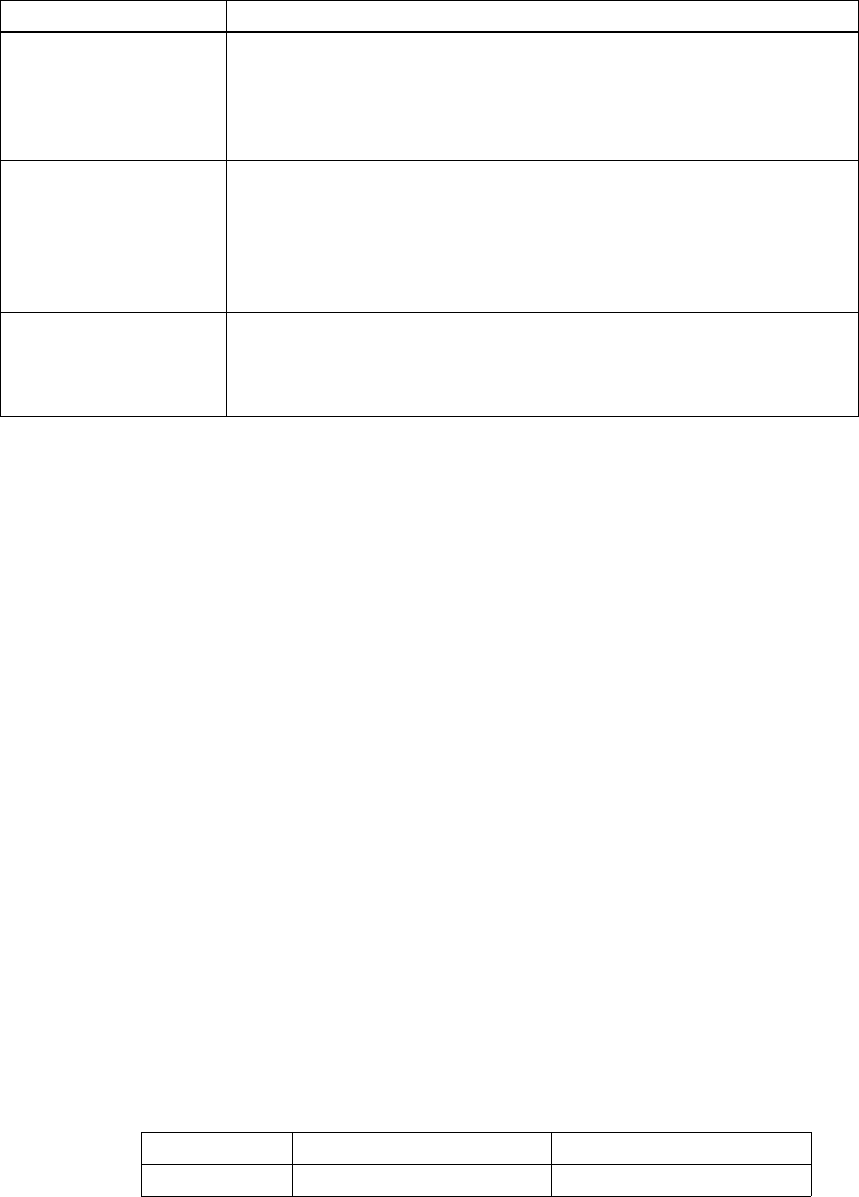
SYSTEM DESCRIPTION, INSTALLATION, AND MAINTENANCE MANUAL
eNfusion® HSD-440 Mark 2 Terminal
23-15-30 F-10
3 JUN 10
D. Understanding the Solo Word
If the data the HSD-440 Mark 2 Terminal is sending consists of only 1 or 2 octets, then
the data can be sent blind using the solo word instead of obtaining a CTS. Solo words
conform to the following rules:
• The solo word contains a 16 bit data field in bits 24–9
• Bits 31–29 are permanently set to 101b
• Solo words are not acknowledged at the link level
• Solo words are not interleaved with data file words during a data file transfer, however
if the HSD-440 Mark 2 Terminal receives a solo word during data transfer, the
HSD-440 Mark 2 Terminal shall process the solo word normally and resume file
transmission or reception.
The solo word also performs test and loop back functions to test the integrity of the ARINC
429 bus interconnection between the HSD-440 Mark 2 Terminal and the CMU.
The HSD-440 Mark 2 Terminal can send a 16 bit loop test pattern word (TEST) on the
ARINC 429 TX bus. The CMU then responds with the identical loop test pattern word
(LOOP) on the ARINC 429 RX bus. If the LOOP does not match the TEST, the HSD-440
Mark 2 Terminal indicates a TEST failure.
If the HSD-440 Mark 2 Terminal receives a TEST on its ARINC 429 RX bus, it responds
by transmitting an identical LOOP on the ARINC 429 TX bus.
A 4 bit identifier (bits 28–25) identifies the nature of the data being sent by the solo word.
The three types of data are shown in Table F-10.
SYN The HSD-440 Mark 2 Terminal transmits a SYN word to inform the CMU
that the construction of the last file that was transmitted is confused. The
reception of a SYN word causes the CMU to abort any reception or
transmission in progress. In addition, if the CMU was transmitting, it
should re-initiate transmission of the file that was aborted.
Destination code RTS, CTS, and NTCS words use a destination code. The destination
code field (when used, bits 24–17) indicates the final destination of the
LDU. If the LDU will be used in the HSD-440 Mark 2 Terminal, the
destination code can be set to 00h. If the LDU is intended to be passed
on to another onboard system, the destination code indicates that
system.
Word count RTS and CTS words use a word count. The word count field (bits 16–9)
reflects the number of ARINC 429 words that will be transmitted in a
subsequent LDU. The maximum word count value is 255 ARINC 429
words.
Table F-9 Protocol Words and Uses (Continued)
Protocol word Uses
Table F-10 Data Types
Purpose Bits 28-25b Description
Test 0000b 16 Bit Test Pattern

SYSTEM DESCRIPTION, INSTALLATION, AND MAINTENANCE MANUAL
eNfusion® HSD-440 Mark 2 Terminal
23-15-30 F-11
3 JUN 10
E. Understanding Start of Transmission (SOT)
When the HSD-440 Mark 2 Terminal receives a valid CTS with the destination code and
word count of the previous RTS, then it responds by sending an SOT word immediately
before the LDU. The SOT contains the file sequence number, the GFI, and the LDU
sequence number.
The file sequence number (bits 24–17) of the SOT word is an 8 bit number assigned to
the data file. It is initialized to 00h and increments by 1h for each new file sent over the
link. After reaching FFh, the file sequence number returns to 01h and recommences
incrementing by 1h for each new file sent. A file consisting of multiple LDUs has the same
file sequence number in each SOT word of each LDU. The file sequence number is also
used in ACK and NAK words.
The LDU sequence number (bits 16–9) of the SOT word is an 8 Bit number assigned to
the LDU. It is initialized to 00h and increments by 1h for each LDU sent (of the same file).
The LDU sequence number resets to 00h at the beginning of each new file. The LDU
sequence number is also used in the ACK word.
F. Understanding End of Transmission (EOT)
Each LDU is terminated by an EOT word. Bit 25 indicates if this LDU is the final LDU of
the transfer. If it is, then this bit shall be set to 1; if it is not the final LDU, it shall be set to
0. The EOT also contains the CRC word in bits 24–9. See ARINC 429 P3, paragraph
2.5.12, for details on generating and decoding the CRC word.
Loop 0001b 16 Bit Loop Back
Solo Word ID 16 Bit Data Filed
Table F-10 Data Types (Continued)
SYSTEM DESCRIPTION, INSTALLATION, AND MAINTENANCE MANUAL
eNfusion® HSD-440 Mark 2 Terminal
23-15-30 F-12
3 JUN 10
Blank Page

SYSTEM DESCRIPTION, INSTALLATION, AND MAINTENANCE MANUAL
eNfusion® HSD-440 Mark 2 Terminal
23-15-30 G-1
3 JUN 10
APPENDIX G: INTERNATIONAL ACCESS AND
COUNTRY CODES
Table G-1 shows a list of countries with their associated country codes and international access
codes.
Table G-1 International Access and Country Codes
Country Country Code International Access Code
Afghanistan 93 00
Albania 355 00
Algeria 213 00
Angola 244 00
Anguilla +1 (264) 011
Antigua +1 (268) 011
Argentina 54 00
Armenia 374 00
Aruba 297 00
Australia 61 00 11
Austria 43 00
Bahamas +1 (242) 011
Bahrain 973 00
Bangladesh 880 00
Barbados +1 (246) 011
Belarus 375 810
Belgium 32 00
Belize 501 00
Benin 229 00
Bermuda +1 (441) 011
Bolivia 591 00 10
Bosnia and Hercegovina 387 99
Botswana 267 00
Brazil 55 00
British Virgin Islands +1 (284) 011
Bulgaria 359 00
Burkina Faso 226 00
Burma (Myanmar) 95 00
Burundi 257 90
Cambodia 855 001

SYSTEM DESCRIPTION, INSTALLATION, AND MAINTENANCE MANUAL
eNfusion® HSD-440 Mark 2 Terminal
23-15-30 G-2
3 JUN 10
Cameroon 237 00
Canada 1011
Cape Verde 238 0
Cayman Islands +1 (345) 011
Central African Republic 236 19
Chad 235 15
Chile 56 00
China 86 00
Colombia 57 009
Comoros 269 00
Congo (Brazzaville) 242 00
Congo (Kinshasa, formerly Zaire) 243 00
Cook Islands 682 00
Costa Rica 506 00
Cote d'Ivoire (Ivory Coast) 225 00
Croatia 385 99
Cuba 53 119
Cyprus 357 00
Czech Republic 420 00
Denmark 45 00
Diego-Garcia 246 00
Djibouti 253 00
Dominica +1 (767) 011
Dominican Republic +1 (809), +1 (829) 011
East Timor 670 00
Ecuador 593 00
Egypt 20 00
El Salvador 503 0
Equatorial Guinea 240 00
Eritrea 291 00
Estonia 372 810
Ethiopia 251 00
Falkland Islands 500 01
Faroe Islands 298 009
Fiji 679 5
Finland 358 00
France 33 00
Table G-1 International Access and Country Codes (Continued)
Country Country Code International Access Code

SYSTEM DESCRIPTION, INSTALLATION, AND MAINTENANCE MANUAL
eNfusion® HSD-440 Mark 2 Terminal
23-15-30 G-3
3 JUN 10
French Antilles 590 00
French Guiana 594 00
French Polynesia 689 00
Gabon 241 00
Gambia 220 00
Germany 49 00
Ghana 233 00
Gibraltar 350 00
Greece 30 00
Greenland 299 009
Grenada +1 (473) 011
Guam +1 (671) 011
Guatemala 502 00
Guinea 224 00
Guinea-Bissau 245 00
Guyana 592 001
Haiti 509 00
Honduras 504 00
Hong Kong 852 001
Hungary 36 00
Iceland 354 90
India 91 900
Indonesia 62 001, 008
Iran 98 00
Iraq 964 00
Ireland 353 00
Israel 972 00
Italy 39 00
Ivory Coast (Cote d'Ivoire) 225 00
Jamaica +1 (876) 011
Japan 81 010
Jordan 962 00
Kazakstan 7810
Kenya 254 000
Kuwait 965 00
Kyrgyz Republic 996 00
Laos 856 00
Table G-1 International Access and Country Codes (Continued)
Country Country Code International Access Code

SYSTEM DESCRIPTION, INSTALLATION, AND MAINTENANCE MANUAL
eNfusion® HSD-440 Mark 2 Terminal
23-15-30 G-4
3 JUN 10
Latvia 371 810
Lebanon 961 00
Lesotho 266 00
Liberia 231 00
Libya 218 00
Liechtenstein 423 00
Lithuania 370 00
Luxembourg 352 00
Macao 853 00
Macedonia 389 00
Madagascar 261 16
Malawi 265 101
Malaysia 60 00
Maldives 960 00
Mali 223 00
Malta 356 356
Marshall Islands 692 011
Martinique 596 00
Mauritania 222 00
Mauritius 230 00
Mayotte and Reunion 262 10
Mexico 52 98
Micronesia 691 011
Moldova 373 00
Monaco 377 00
Mongolia 976 001
Montenegro 382 00
Montserrat +1 (664) 011
Morocco 212 00
Mozambique 258 00
Namibia 264 00
Nauru 674 00
Nepal 977 00
Netherlands 31 00
New Caledonia 687 00
New Zealand 64 00
Nicaragua 505 00
Table G-1 International Access and Country Codes (Continued)
Country Country Code International Access Code

SYSTEM DESCRIPTION, INSTALLATION, AND MAINTENANCE MANUAL
eNfusion® HSD-440 Mark 2 Terminal
23-15-30 G-5
3 JUN 10
Niger 227 00
Nigeria 234 009
Niue Island 683 00
North Korea 850 00
Northern Mariana Islands
(Commonwealth of) +1 (670) 011
Norway 47 095
Oman 968 00
Pakistan 92 00
Palau 680 011
Palestine 970 00
Panama 507 00
Papua New Guinea 675 05
Paraguay 595 002
Peru 51 00
Philippines 63 00
Poland 48 00
Portugal 351 00
Puerto Rico +1 (787) 011
Qatar 974 00
Romania 40 71
Russia 7810
Rwanda 250 00
Samoa 685 0
San Marino 378 00
Saudi Arabia 966 00
Senegal 221 00
Serbia 381 99
Seychelles 248 00
Sierra Leone 232 00
Singapore 65 001
Slovakia 421 00
Slovenia 386 99
Solomon Islands 677 00
Somalia 252 00
South Africa 27 00
South Korea 82 00
Table G-1 International Access and Country Codes (Continued)
Country Country Code International Access Code

SYSTEM DESCRIPTION, INSTALLATION, AND MAINTENANCE MANUAL
eNfusion® HSD-440 Mark 2 Terminal
23-15-30 G-6
3 JUN 10
Spain 34 00
Sri Lanka 94 00
St Helena and Tristan da Cunha 290 00
St Kitts +1 (869) 011
St Lucia +1 (758) 011
St Pierre and Miquelon 508 00
St Vincent +1 (784) 011
Sudan 249 00
Suriname 597 002
Swaziland 268 00
Sweden 46 00
Switzerland 41 00
Syria 963 00
Taiwan 886 002
Tajikistan 992 810
Tanzania 255 000
Thailand 66 001
Togolese Republic 228 00
Tokelau 690 00
Tonga 676 09
Trinidad and Tobago +1 (868) 011
Tunisia 216 00
Turkey 90 99
Turkmenistan 993 810
Turks and Caicos +1 (649) 011
Tuvalu, Ellice Islands 688 00
U.S. Pacific Islands +1 670, +1 671,
+1 684 011
U.S. Virgin Islands +1 (340) 011
Uganda 256 000
Ukraine 380 810
United Arab Emirates 971 00
United Kingdom 44 00
United States 1011
Uruguay 598 00
Uzbekistan 998 810
Vanuatu 678 00
Table G-1 International Access and Country Codes (Continued)
Country Country Code International Access Code
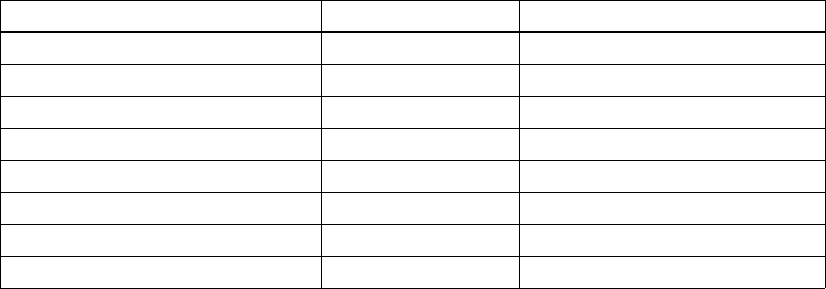
SYSTEM DESCRIPTION, INSTALLATION, AND MAINTENANCE MANUAL
eNfusion® HSD-440 Mark 2 Terminal
23-15-30 G-7
3 JUN 10
Vatican City +39, +379 00
Venezuela 58 00
Vietnam 84 00
Wallis and Futuna 681 19
Yemen 967 00
Yugoslavia (+38 discontinued) 99
Zambia 260 00
Zimbabwe 263 110
Table G-1 International Access and Country Codes (Continued)
Country Country Code International Access Code
SYSTEM DESCRIPTION, INSTALLATION, AND MAINTENANCE MANUAL
eNfusion® HSD-440 Mark 2 Terminal
23-15-30 G-8
3 JUN 10
Blank Page

SYSTEM DESCRIPTION, INSTALLATION, AND MAINTENANCE MANUAL
eNfusion® HSD-440 Mark 2 Terminal
23-15-30 H-1
3 JUN 10
APPENDIX H: INMARSAT CAUSE CODES
Table H-1 defines the maintenance port menu fault codes of the HSD-440 Mark 2 Terminal.
Table H-1 Inmarsat Cause Code Definitions
Inmarsat Cause Code Code Definition
1001 Call cleared by MES terminal (normal termination of call)
1011 Call failed, MES terminal busy
1012 Call cleared, MES terminal busy
1021 Call failed, MES time-out (no answer)
1081 Call failed, MES terminal not installed
1091 Call failed, MES terminal out-of-service
1092 Call cleared, MES terminal out-of-service
1141 MES preempted clear by higher priority call
1142 MES preempted fixed call by higher priority call
1143 Offered call cleared, pre-empted at MES
1144 Call cleared, MES initiated preemption
1145 Attempted call cleared, pre-empted at MES
1146 Attempted call abandoned by MES terminal
1202 Handover, MES ready
1281 Call failed, MES cannot accept
1291 Call failed, MES cannot accept at present
1351 Call cleared, insufficient free memory
1361 Call cleared by MES cable unwrap
1362 Call cleared, long interruption in reception at MES
1363 MES secondary clear due to re-point OR
1391 Call cleared, traveled distance exceeds 700km
1392 Call cleared, spot beam transition (call terminated because aircraft left
spot beam)
1393 Call cleared, cooperative mode
1451 Call failed, terrestrial circuits congested
1452 Call failed, LES congested (no channel and no circuit)

SYSTEM DESCRIPTION, INSTALLATION, AND MAINTENANCE MANUAL
eNfusion® HSD-440 Mark 2 Terminal
23-15-30 H-2
3 JUN 10
1502 Handover, LES Ready, normal clear
1551 Call failed, LES congested (no channel)
1581 Call failed, service not provided at this LES
1591 Call failed, service temporarily not available at this LES
1592 Call cleared, credit card type not supported
1651 Call failed, LES congested (no channel terminal)
1661 Call failed, long interruption in reception at LES
1662 LES long term blockage of SCPC MES
1790 Call cleared, failure credit card validation process
1791 Call cleared, failure authentication process
1811 NCS MES ID busy
1812 NCS MES ID busy IPDS
1841 Call cleared, NCS initiated preemption for incoming Pri.1 call
1842 Call cleared, NCS initiated preemption for incoming Pri.2 call
1843 Call cleared, NCS initiated preemption for incoming Pri.3 call
1844 Call cleared, NCS initiated preemption
1851 Call failed, satellite congestion NCS reject no SCPC available
1852 Call failed, satellite congestion NCS reject SCPC does not match
request
1853 Call failed, lease channel congestion
1854 Call failed, MES outside spot beam coverage area
1855 Call rejected, preemption failed, no channel available
1856 Call rejected, spot beam selection failed
1857 Handover failed, channel not available
2000 MES int reject MES RQ invalid CNO
2001 MES int reject MES RQ failed qualification
2010 MES int reject MES RP invalid CNO
2011 MES int reject MES RP failed qualification
2012 MES int reject MES RP operation timeout
2020 MES int reject NCSA missing
Table H-1 Inmarsat Cause Code Definitions (Continued)
Inmarsat Cause Code Code Definition

SYSTEM DESCRIPTION, INSTALLATION, AND MAINTENANCE MANUAL
eNfusion® HSD-440 Mark 2 Terminal
23-15-30 H-3
3 JUN 10
2021 MES int reject NCSA invalid CNO
2022 MES int reject NCSA failed qualification
2023 Call failed, Signal lost on NCSA during call setup, check antenna and
try again
2024 Call failed, Missing channel assignment, try again
2025 Call failed, Signal lost on NCSC during call setup, check antenna and
try again
2030 MES int reject LES ID failed qualification
2040 MES int reject SCCS invalid CNO
2041 MES int reject SCCS not paired
2048 Call failed, invalid number dialed
2049 Call failed, terminal not ready for call, try later
2050 Call failed, Not allowed to make another mobile call yet, wait 20 seconds
and try again
2051 Call failed, dialed number is barred
2052 Call failed, LES selected is barred
2053 Call failed, number dialed must be in a phonebook
2053 Call failed, terminal can only be used with a valid SIM
2055 Call failed, user not logged in
2056 Call failed, user not logged in to SIM
2057 Call failed, LES is not in SIM allowed list
2058 Call cleared, SIM removed during call
2059 Call failed, terminal is locked for outgoing calls
2060 MES int reject NCSS failed qualification
2061 MES int reject spot beam invalid
2062 Call failed, no spot beams in the ocean region, select another OR
2063 Terminal ID is not set correctly, check with dealer
2070 Lost NCSC signal, seeking
2071 Stand-Alone Mode finished, seeking network
2080 SIM error, check SIM is inserted correctly
Table H-1 Inmarsat Cause Code Definitions (Continued)
Inmarsat Cause Code Code Definition
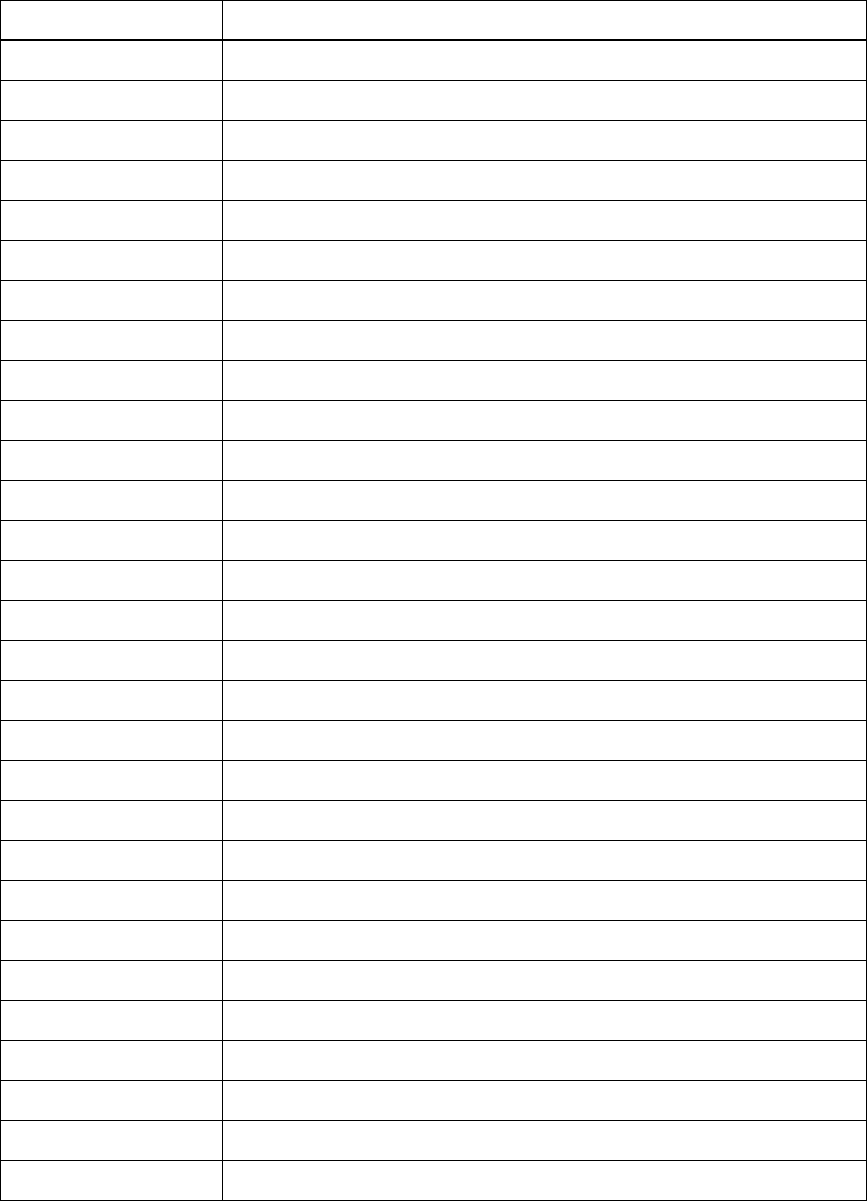
SYSTEM DESCRIPTION, INSTALLATION, AND MAINTENANCE MANUAL
eNfusion® HSD-440 Mark 2 Terminal
23-15-30 H-4
3 JUN 10
2090 MES int reject ORR query invalid
2091 MES int reject ORR invalid
2092 MES int reject MES RR failed qualification
2093 MES int reject MES RR invalid CNO
2094 MES int reject NCRA missing
2095 MES int reject NCRA lost lock
2100 MES int reject illegal call type
2101 MES Int reject illegal peripheral
2102 Call request failed, call already in progress
2103 Call failed, star code is badly formatted
2104 Call failed, cannot accept two address book star codes
2105 Call failed, address book entry not found
2106 Call failed, star code does not exist
2120 MES int reject no transmit power available
2200 Battery flat for terminal operation
2201 Call cleared, used all allocated time for call type
2300 MES int reject no coop response
2301 MES int reject no power
2302 MES int reject no location report
2400 MES int reject no ORA SU found
8000 ACSE Recycling
8001 ACSE Top Of Find BB
8002 ACSE Top Of Process BB
8010 ACSE Finding Primary NCS Long
8011 ACSE Finding Secondary NCS Short
8012 ACSE Finding Primary Standalone Short
8013 ACSE Finding Primary NCS Short
8014 ACSE Finding Primary Standalone Long
8018 ACSE Finding Secondary Standalone Short
Table H-1 Inmarsat Cause Code Definitions (Continued)
Inmarsat Cause Code Code Definition
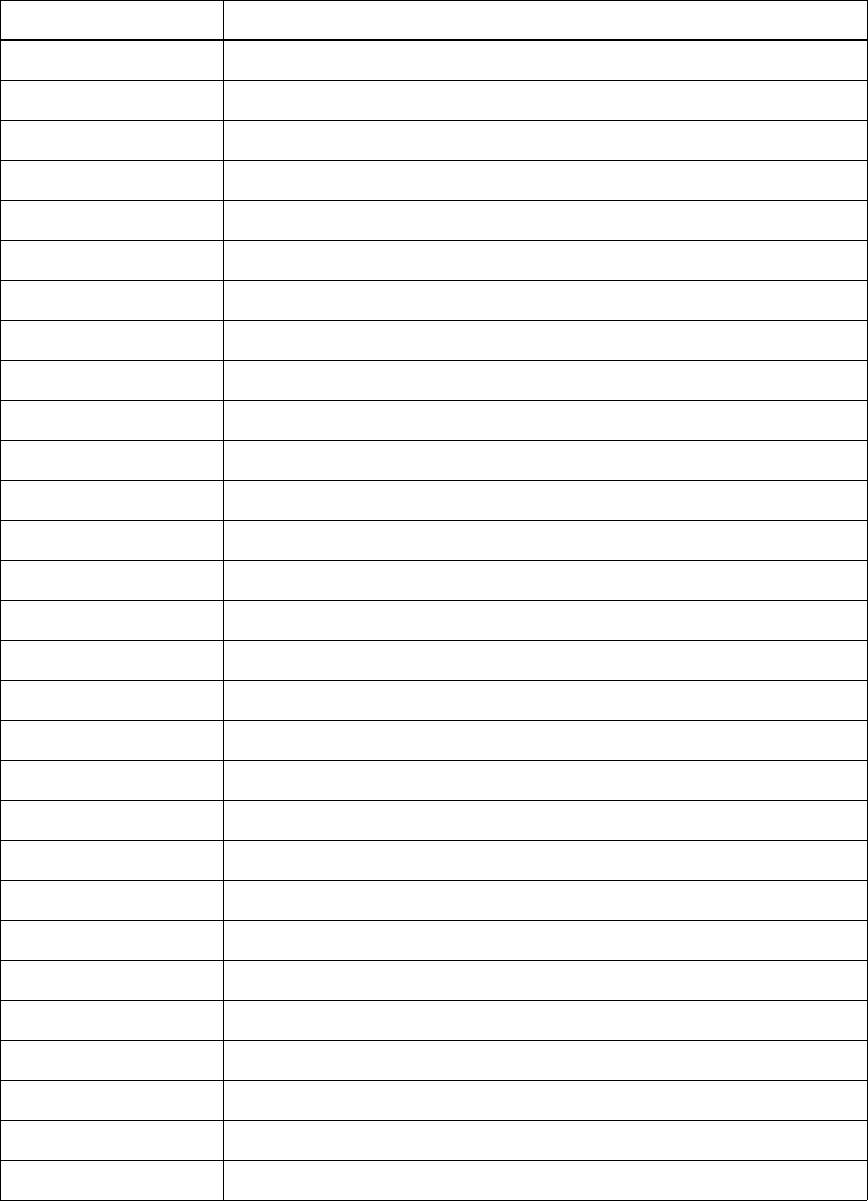
SYSTEM DESCRIPTION, INSTALLATION, AND MAINTENANCE MANUAL
eNfusion® HSD-440 Mark 2 Terminal
23-15-30 H-5
3 JUN 10
8019 ACSE Finding Secondary Standalone Long
8020 ACSE Found Primary NCS
8021 ACSE Found Secondary NCS
8022 ACSE Found Primary Standalone
8023 ACSE Found Secondary Standalone
8024 ACSE found primary NGNCS
8025 ACSE found secondary NGNCS
8030 ACSE NSR Invalid
8040 ACSE Inert
8041 ACSE ODU Status
8080 ACSE NSR Valid
8081 ACSE NSR Valid LES A
8100 ACSE Booting
8110 ACSE Booted
8120 ACSE FIDR ID Invalid
8200 ACSE Spot Beam Selection
8201 ACSE Next Spot Beam
8202 ACSE Successful Spot Beam Selection
8203 ACSE Failed To Find Spot Beam
8204 ACSE Spot Beam Selective Clear
8210 ACSE Spot Beam Reject Mobile Call No ID
8211 ACSE Spot Beam Reject Mobile Call No TDM
8300 ACSE ORR
8301 ACSE Successful ORR
8302 ACSE Failed ORR
8303 ACSE No ORR
8304 ACSE ORR Tune NCRA
8305 ACSE ORR MES RR
8306 ACSE failed retry ORR
Table H-1 Inmarsat Cause Code Definitions (Continued)
Inmarsat Cause Code Code Definition
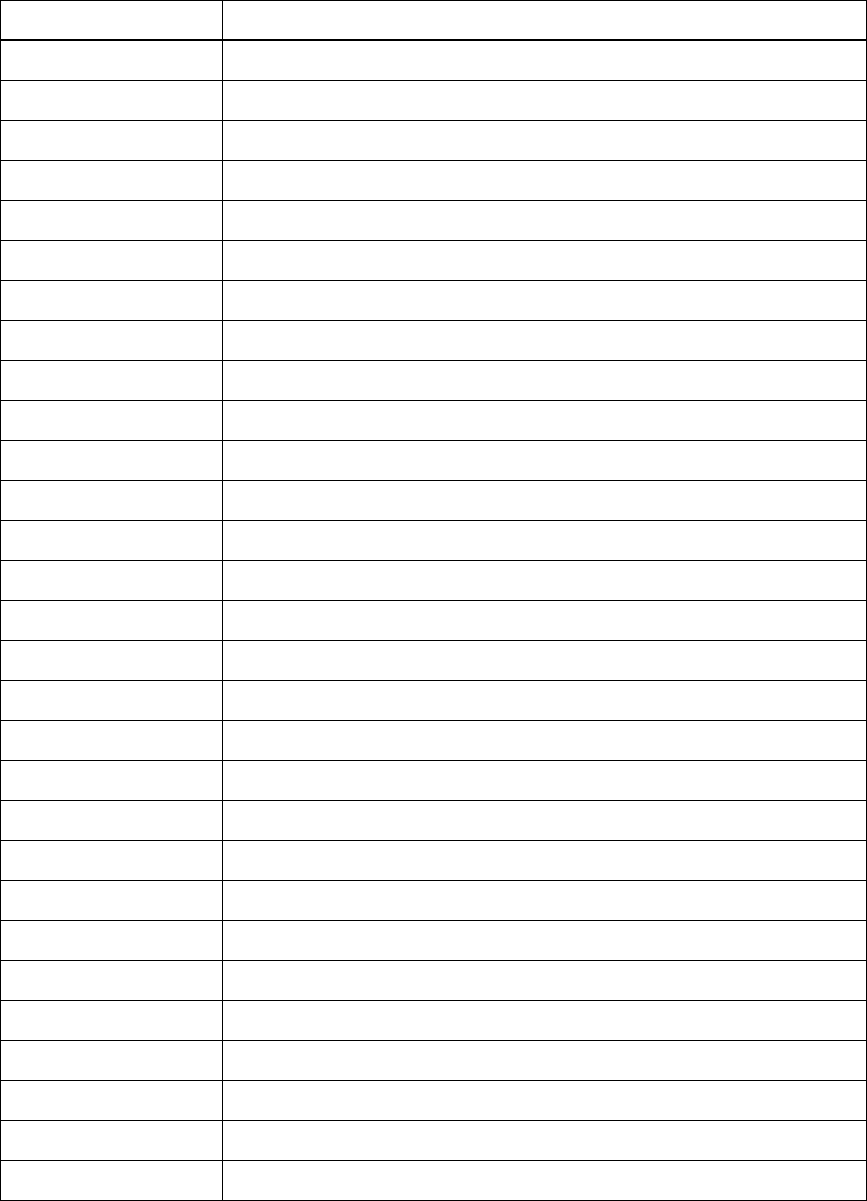
SYSTEM DESCRIPTION, INSTALLATION, AND MAINTENANCE MANUAL
eNfusion® HSD-440 Mark 2 Terminal
23-15-30 H-6
3 JUN 10
8310 ACSE ORR Query Begin
8311 ACSE ORR Query Burst
8312 ACSE ORR Query Successful
8313 ACSE ORR Query Failed
8400 ACSE Fixed Begin
8401 ACSE Fixed MESRP
8402 ACSE Fixed Call Type Set
8410 ACSE Fixed Tune NCSA
8411 ACSE Fixed Channel Assignment
8420 ACSE Fixed Clearing Call
8421 ACSE Fixed Selective Clear
8480 ACSE Fixed SCPC Begin
8481 ACSE Fixed SCPC Transmitting
8482 ACSE Fixed Authentication Begin
8483 ACSE Fixed Authentication End
8484 ACSE Fixed Power Control
8485 ACSE Fixed MES Connect
8486 ACSE Fixed Ringing Begin
8500 ACSE Mobile Begin
8501 ACSE Mobile MES RQ1
8502 ACSE Mobile MES RQ2
8503 ACSE Mobile Call Type Set
8510 ACSE Mobile Tune NCSA
8511 ACSE Mobile Channel Assignment
8520 ACSE Mobile Clearing Call
8521 ACSE Mobile Selective Clear
8580 ACSE Mobile SCPC Begin
8581 ACSE Mobile SCPC Transmitting
8582 ACSE Mobile Authentication Begin
Table H-1 Inmarsat Cause Code Definitions (Continued)
Inmarsat Cause Code Code Definition
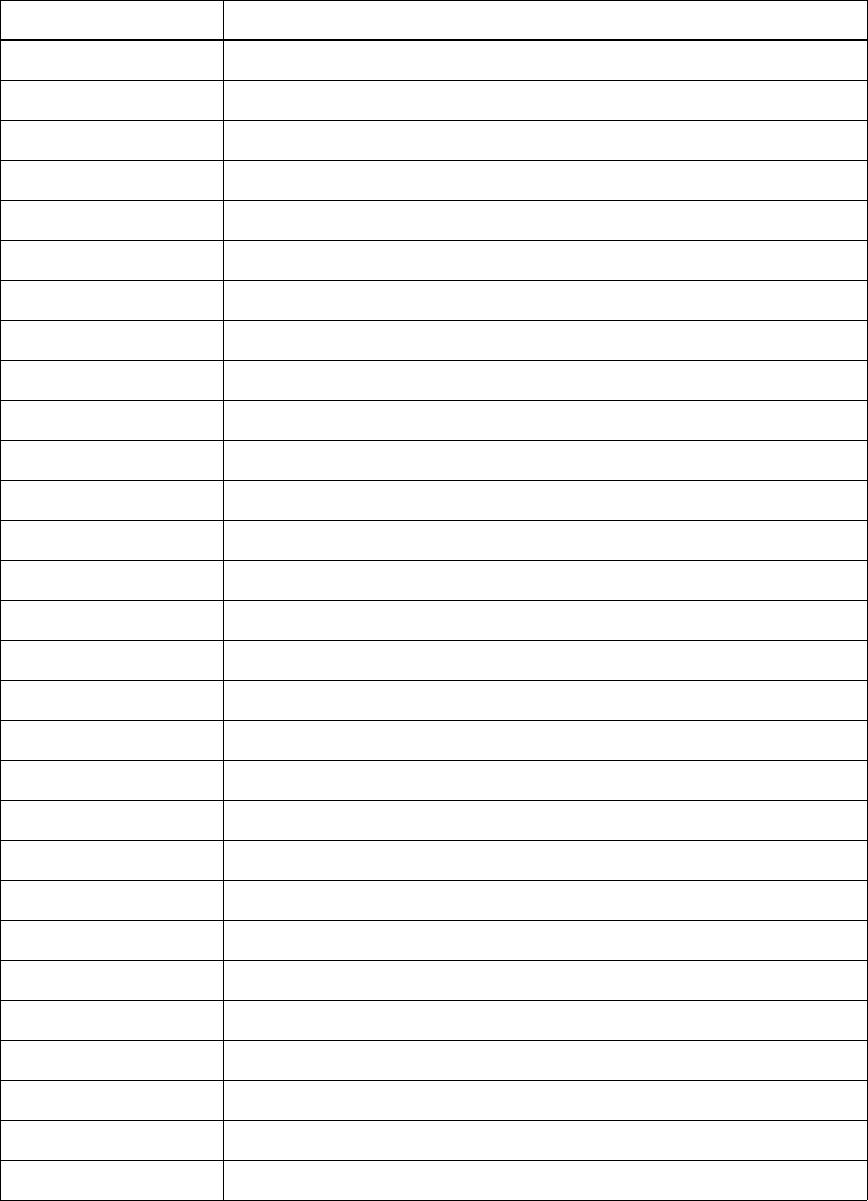
SYSTEM DESCRIPTION, INSTALLATION, AND MAINTENANCE MANUAL
eNfusion® HSD-440 Mark 2 Terminal
23-15-30 H-7
3 JUN 10
8583 ACSE Mobile Authentication End
8584 ACSE Mobile Power Control
8585 ACSE Mobile LES Connect
8586 ACSE Mobile Ringing Begin
8600 MPDS SCPC Mode Selected
8800 ACSE cable call begin
8801 ACSE cable call successful
8900 ACSE Logoff Begin
8901 ACSE Successful Logoff
8902 ACSE No ORR Logoff
9000 ACSE accepts call
9003 ACSE accepted
9004 ACSE rejected
9020 ACSE call waiting
9021 ACSE idle selective clear
9022 ACSE TDM not found
9080 ACSE rejected fixed call due to invalid NSR
9081 ACSE In MRSi
9082 ACSE sounder turned on
9083 ACSE sounder turned off
9084 ACSE in lock
9085 ACSE out of lock
9086 ACSE ext sounder turned on
9087 ACSE ext sounder turned off
9088 ACSE timer about to expire
9090 ACSE Smartcard activated
9091 ACSE Smartcard removed
9092 ACSE Smartcard error
9100 Peripheral on hook
Table H-1 Inmarsat Cause Code Definitions (Continued)
Inmarsat Cause Code Code Definition
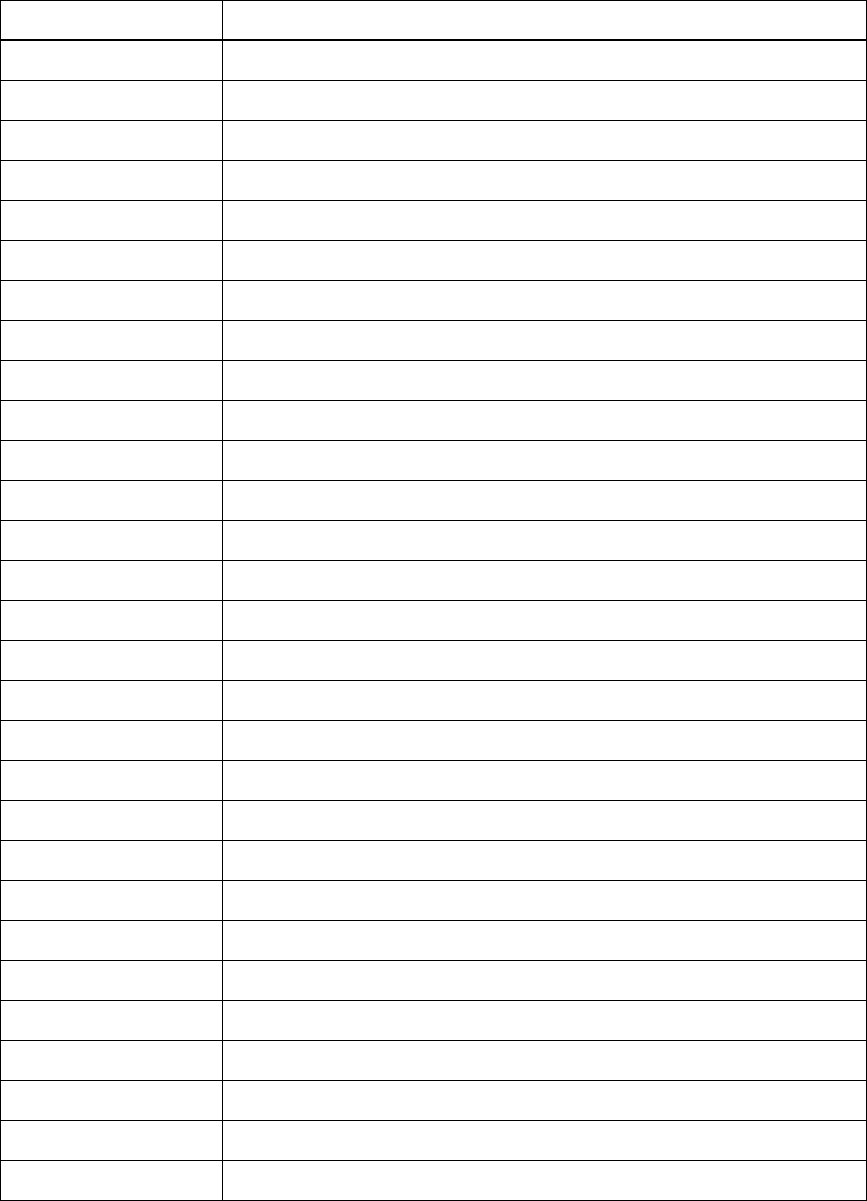
SYSTEM DESCRIPTION, INSTALLATION, AND MAINTENANCE MANUAL
eNfusion® HSD-440 Mark 2 Terminal
23-15-30 H-8
3 JUN 10
9101 Peripheral off hook
9102 Peripheral connected
9103 Peripheral ringing
9104 Peripheral ready
9105 Peripheral hanging up
9106 Peripheral hang up
9107 Peripheral not responding
9108 Peripheral dialing
9109 Peripheral abort dialing
9120 Peripheral DTMF accepted
9121 Peripheral DTMF rejected
9122 Peripheral invalid request
9123 Peripheral valid request
9124 Peripheral bonding auto
9125 Peripheral bonding slave
9126 Peripheral bonding none
9130 Peripheral STU enabled
9131 Peripheral STU disabled
9200 MSG T_AM received
9201 MSG A_AM received
9202 MSG T_HA received
9203 MMI normal
9204 MMI inert
9205 MMI programming
9206 MMI reboot
9207 MMI powerdown
9208 MMI accepted
9209 MMI rejected
400000 CT SP bad
Table H-1 Inmarsat Cause Code Definitions (Continued)
Inmarsat Cause Code Code Definition
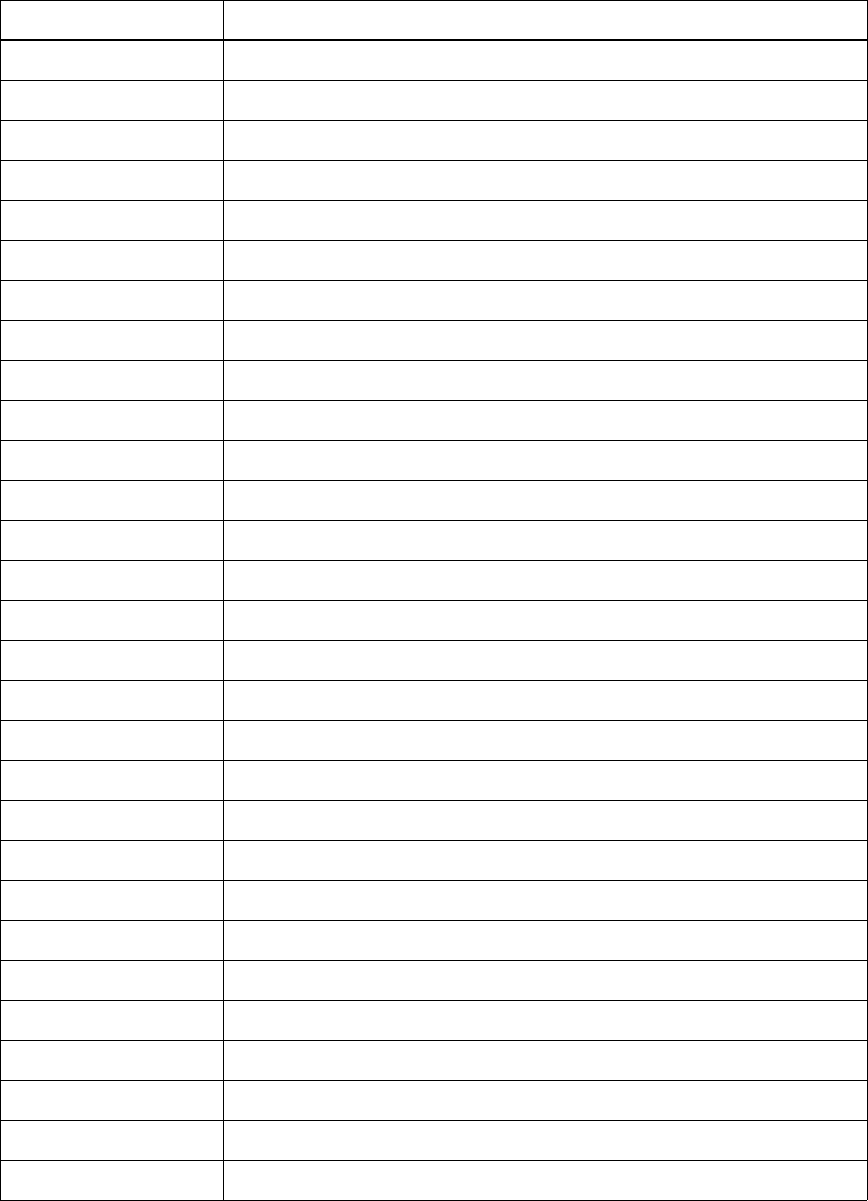
SYSTEM DESCRIPTION, INSTALLATION, AND MAINTENANCE MANUAL
eNfusion® HSD-440 Mark 2 Terminal
23-15-30 H-9
3 JUN 10
400000 No call pending
400001 CT SP good
400002 CT SP full
400003 CT SP access denied
400080 CT SP find
400081 CT SP enumerate
400082 CT SP no entries
400090 CT SP delete
400100 CT SP spot beam selection
400105 CT SP MPDS
400110 CT SP ocean region registration
400111 CT SP ORR query
400112 CT SP log off
400120 CT SP cable call
400200 CT SP go idle
400201 CT SP go idle due to configuration
400202 CT SP selective clear
400208 CT SP go idle clear spot beam
400209 CT SP go idle clear NSR
400210 CT SP go inert
400211 CT SP go inert Smartcard
400212 CT SP go inert DDS poll
400900 CT SP ODU status
400901 CT SP ODU status no alarms
400902 CT SP ODU status DDS
400910 CT SP prod test
400911 CT SP prod test ODU
401000 CT SP clear spot beam
800124 Mobile Aero 64k speech
Table H-1 Inmarsat Cause Code Definitions (Continued)
Inmarsat Cause Code Code Definition
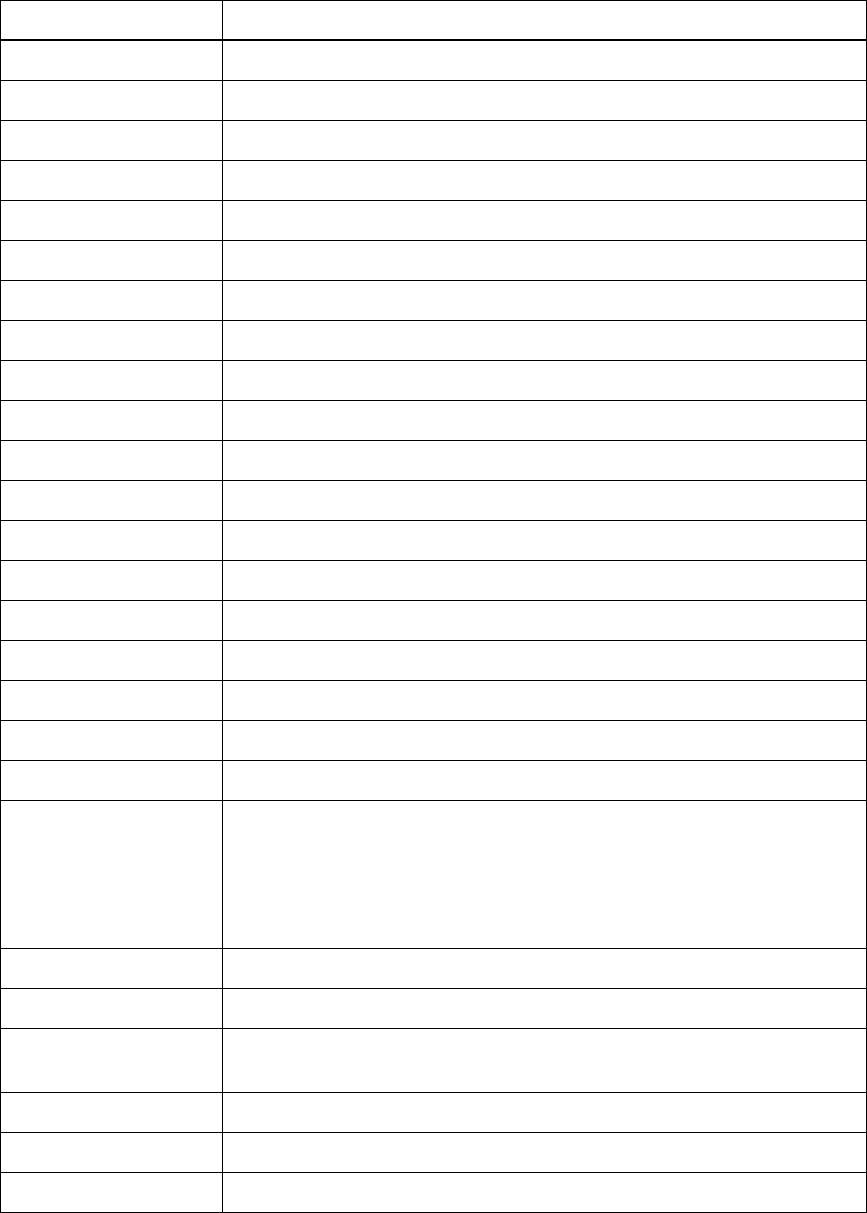
SYSTEM DESCRIPTION, INSTALLATION, AND MAINTENANCE MANUAL
eNfusion® HSD-440 Mark 2 Terminal
23-15-30 H-10
3 JUN 10
800404 Mobile data
800504 Mobile facsimile
800606 Mobile 64k UDI
800607 Mobile 56k UDI
800610 Mobile 64k audio 3k1
800622 Mobile Aero 64k UDI
800623 Mobile Aero 56k UDI
800625 Mobile Aero 64k audio 3k1
11A0 Call cleared, credit card not accepted
11D1 Call failed, Request data invalid
11D2 Call failed, insufficient digits in service address
11D3 Call failed, invalid service address
11D4 Call cleared, credit card data information invalid
11D5 Call cleared, invalid country code
11D6 Call cleared, PID information is not consistent
11D7 Call rejected, invalid service for Pri.1 or 2 call
11D8 Call cleared, dialed number not 2 or 3 digits for Pr.1 or 2 call
11E0 Call cleared, invalid credit card PIN at this LES
11E1 Call cleared, too many invalid credit card call attempts
12B1 Call cleared by MES for unspecified reason, for example:
• GPS conflict
• Insufficient HPA power available to make call
• HPA over current
12C2 Call cleared, no credit card valid message received
12C3 Call failed, MES time-out (no terrestrial answer)
12C4 Call cleared, authentication query not received (usually caused by call
setup failure)
12C5 Call cleared, MES missing sup service SU
12C6 Call cleared, MES missing sup service 2SU
12C7 Call cleared, MES missing SCPC channel release SU sup service
Table H-1 Inmarsat Cause Code Definitions (Continued)
Inmarsat Cause Code Code Definition
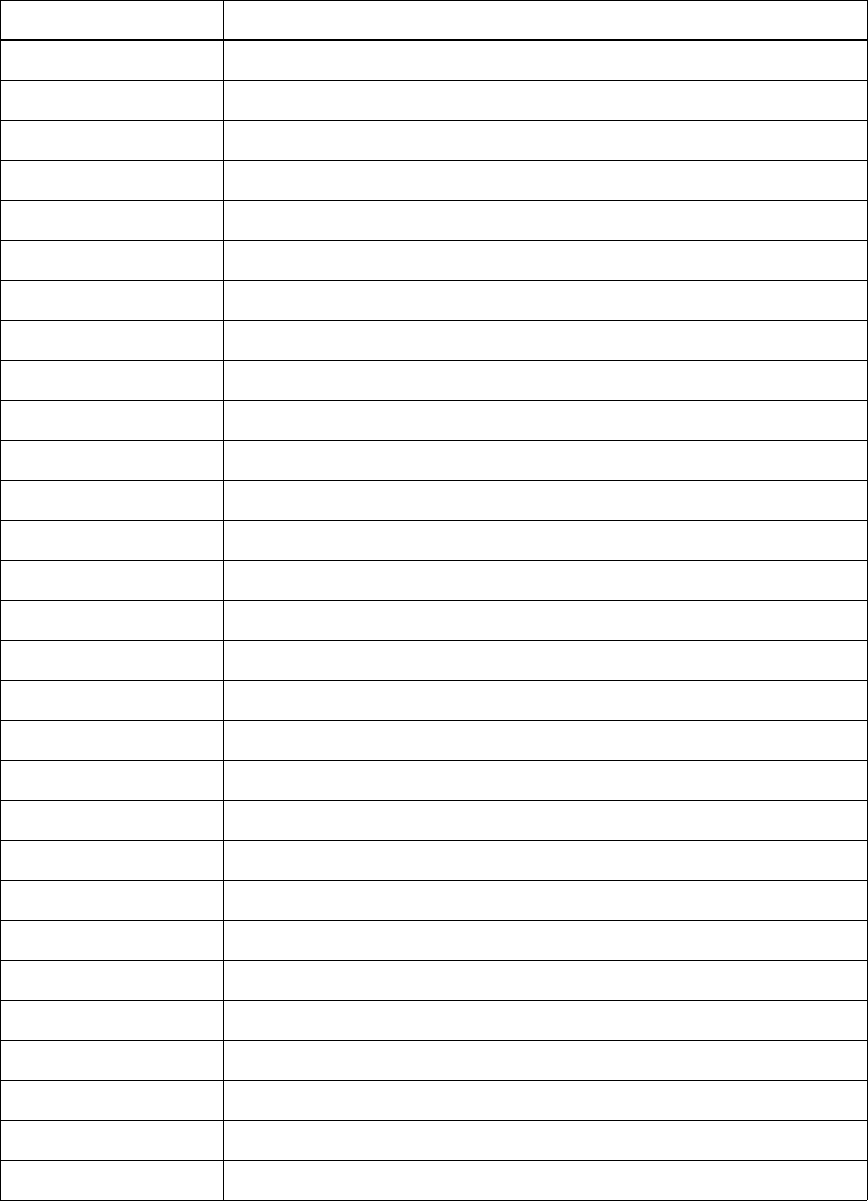
SYSTEM DESCRIPTION, INSTALLATION, AND MAINTENANCE MANUAL
eNfusion® HSD-440 Mark 2 Terminal
23-15-30 H-11
3 JUN 10
12C8 Handover failed, LES not detected
12D1 Call failed, Spot-beam data invalid
12D2 Call failed, invalid scrambling vector
15A1 Call failed, MES not authorized at this LES
15A2 Call failed, service not authorized at this LES
15A3 Call cleared, credit card not authorized
15A4 Call cleared, authentication reply invalid
15A5 Call failed, PID not authorized for any service
15A6 Call failed, PID not authorized for requested service
15B1 Call cleared by LES for unspecified reason
15C1 Call failed, LES time-out (no assignment)
15C2 Call failed, LES time-out (no service address)
15C3 Call failed, LES time-out (no scrambling vector)
15C4 Call failed, no service address and no scrambling vector
15C5 Call cleared, incomplete credit card data information
15C7 Call failed, LES time-out (no MES Connect)
15C9 Call cleared, no authentication reply
15CA Call cleared, notification ack not received
15CB Call cleared, invalid sequence number in notification ack
15CC Handover failed, no response to request
15CD Handover failed, MES not ready
15D1 Call failed, LES time-out (invalid assignment)
15D2 LES MES already busy
15E1 Call cleared but MES still transmitting (FAULT)
16C2 LES missing MES SCPC
16C3 Handover failed, MES not detected
18A1 NCS MES ID not found
18A2 Call failed, MES not authorized
18A3 Call failed, LES not authorized
Table H-1 Inmarsat Cause Code Definitions (Continued)
Inmarsat Cause Code Code Definition

SYSTEM DESCRIPTION, INSTALLATION, AND MAINTENANCE MANUAL
eNfusion® HSD-440 Mark 2 Terminal
23-15-30 H-12
3 JUN 10
18B1 Call failed by NCS for unspecified reason
18B2 Call rejected, invalid service requested
18C1 NCS MES burst missing
18C3 NCS MES busy preemption failed
18D1 Call failed, invalid call request
18E1 NCS MES busy already
18E2 NCS MES busy already MPDS
1F01 Call cleared by terrestrial circuit (normal call termination from ground
source)
1F11 Call failed, terrestrial party busy
1F21 Call failed, LES time-out (no answer)
1F61 Call failed, terrestrial circuit failure (call attempted during ORR)
1F62 Call failed, early clear by terrestrial circuit
2F00 LES int reject lack of MES RESP response
2F01 LES int reject lack of MES ARN response
2F02 LES int reject incorrect SVECSCPC
4000A0 CT SP any
4000F0 CT Terminal ID
4000F1 CT Options
4000F2 CT config names
80010F Mobile 64k speech
8D0FFF Mobile Mini-M
8E0FFF Mobile HSD
8F0FFF Mobile
90A0 EXPPORT bonding started
90A1 EXPPORT bonding ended
90A2 EXPPORT remote panel present
90A3 EXPPORT remote panel removed
90B0 ACSE MPDS mode selected
90B1 ACSE SCPC mode selected
Table H-1 Inmarsat Cause Code Definitions (Continued)
Inmarsat Cause Code Code Definition
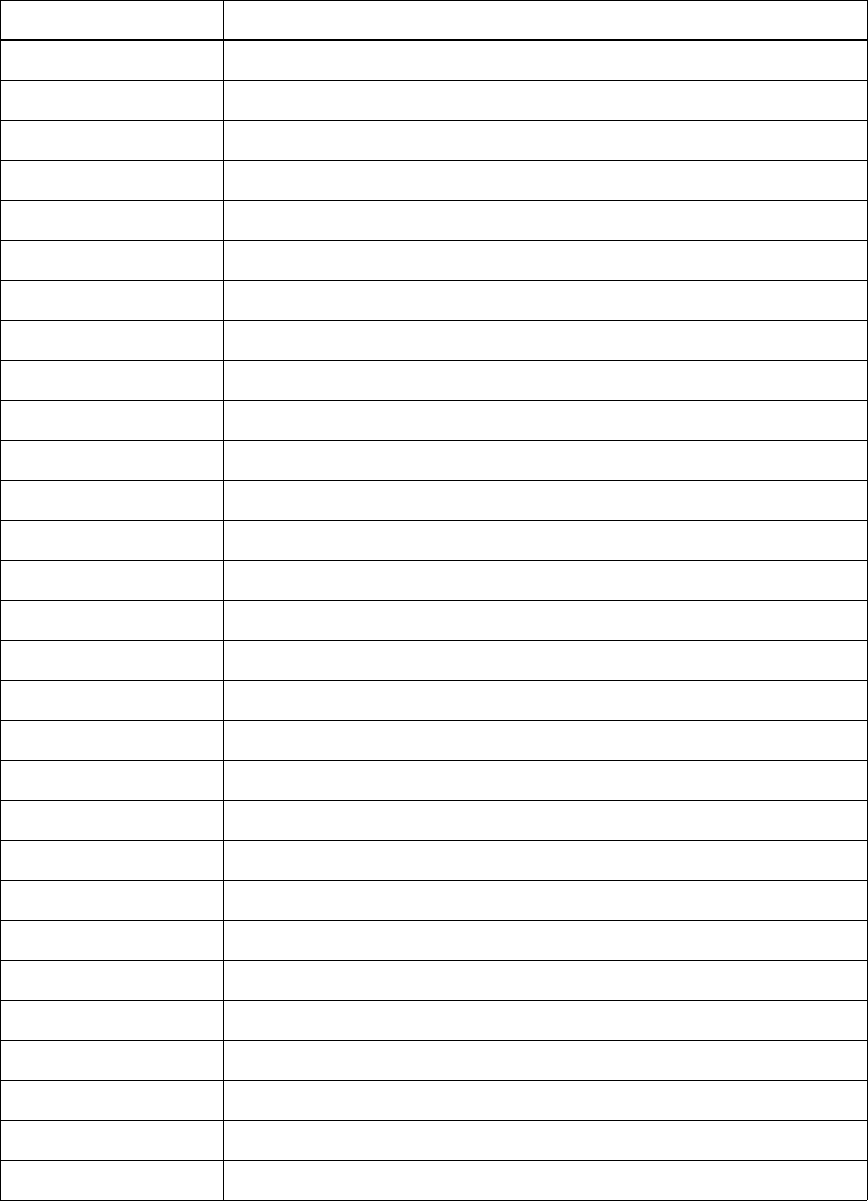
SYSTEM DESCRIPTION, INSTALLATION, AND MAINTENANCE MANUAL
eNfusion® HSD-440 Mark 2 Terminal
23-15-30 H-13
3 JUN 10
90C0 ACSE transmit on
90C1 ACSE transmit off
90D0 ACSE spot beam handover started
90D1 ACSE spot beam termination timer started
90F0 Event log wiped
B000 Mod error, general
B001 Mod error, tune failed
B002 Mod error, mode failed
B003 Mod error, mmr failed
B004 Mod error, not responding
B010 MOD Invalid Mode
B011 MOD Command Invalid
B020 Mod error, su underflow
B021 MOD Su overflow
B022 MOD Su not transmitted
B024 MOD invalid frame no
B025 MOD invalid slot no
B028 MOD cannot Tx Su while tuning
B030 MOD channel out of range
B032 MOD cannot tune while Tx
B033 MOD tuning in progress
B040 MOD error watchdog
B100 DEMOD error, general
B101 DEMOD error, tune failed
B102 DEMOD error, mode failed
B110 DEMOD invalid mode
B130 DEMOD channel out of range
B133 DEMOD tuning in progress
B200 Generic modem error
Table H-1 Inmarsat Cause Code Definitions (Continued)
Inmarsat Cause Code Code Definition
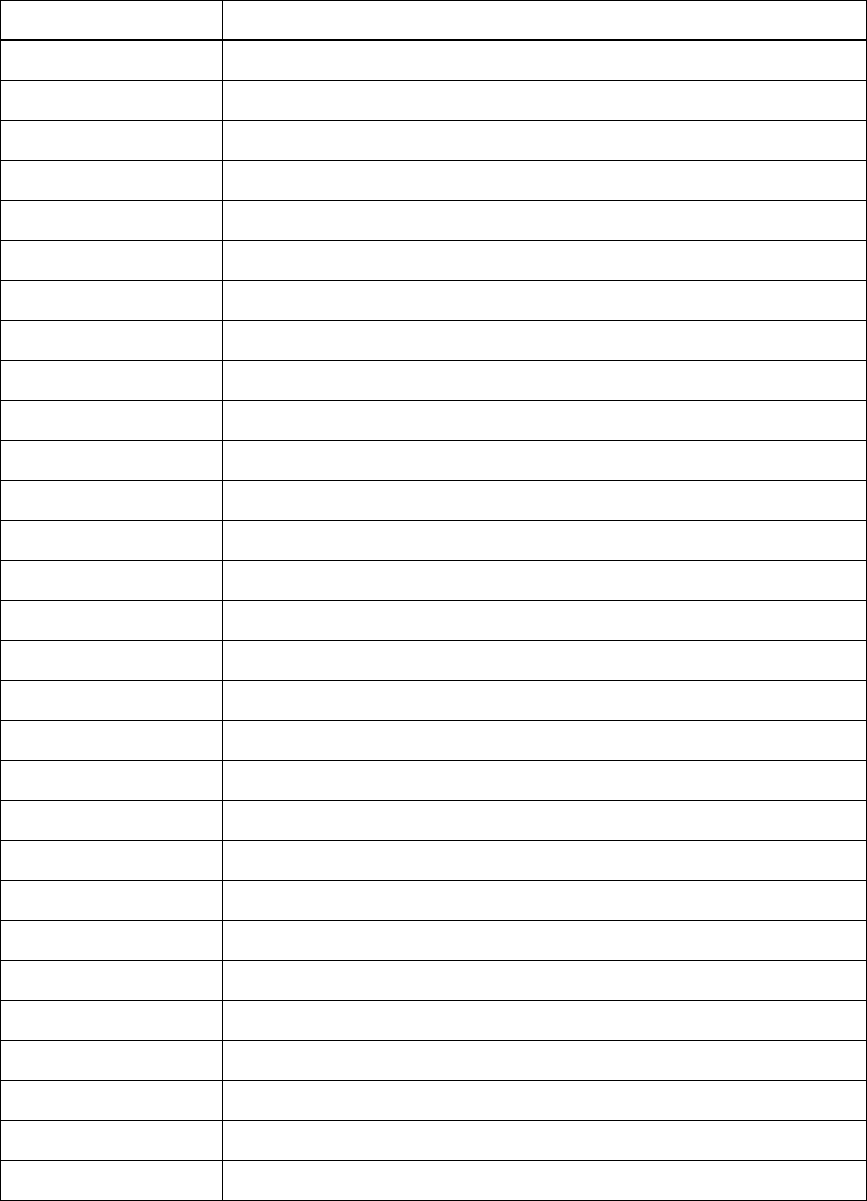
SYSTEM DESCRIPTION, INSTALLATION, AND MAINTENANCE MANUAL
eNfusion® HSD-440 Mark 2 Terminal
23-15-30 H-14
3 JUN 10
B201 RF error RX VHF
B202 RF error RX Lband
B204 RF error RX VHF
B208 RF error TX Lband
B210 RF error RF error
B220 RF error Ref error
B27F Mod watchdog tripped
B280 Generic voice codec errors
B281 TMS spurious interrupt
B300 Outdoor terminal failure, check connections to ODU
B301 ODU error cannot set cable attenuator
B310 ODU error power response missing
B311 ODU error tune response missing
B312 ODU error HPA control response missing
B313 ODU error HPA status response missing
B314 ODU error alarm response missing
B315 ODU error burst timer response missing
B316 ODU error HPA backoff response missing
B320 ODU error alarm heat
B321 ODU error alarm burst
B322 ODU error alarm power
B323 ODU error alarm over voltage
B324 ODU error alarm reverse power
B328 ODU failed due to tx power check
B329 ODU error alarm timeout
B330 ODU error alarm timeout no trip
B400 Internal temperature of terminal too high, turn off for 10 minutes
B401 Internal temperature sensor failed
B410 Mod error, handshake failure, power down/up and try again
Table H-1 Inmarsat Cause Code Definitions (Continued)
Inmarsat Cause Code Code Definition
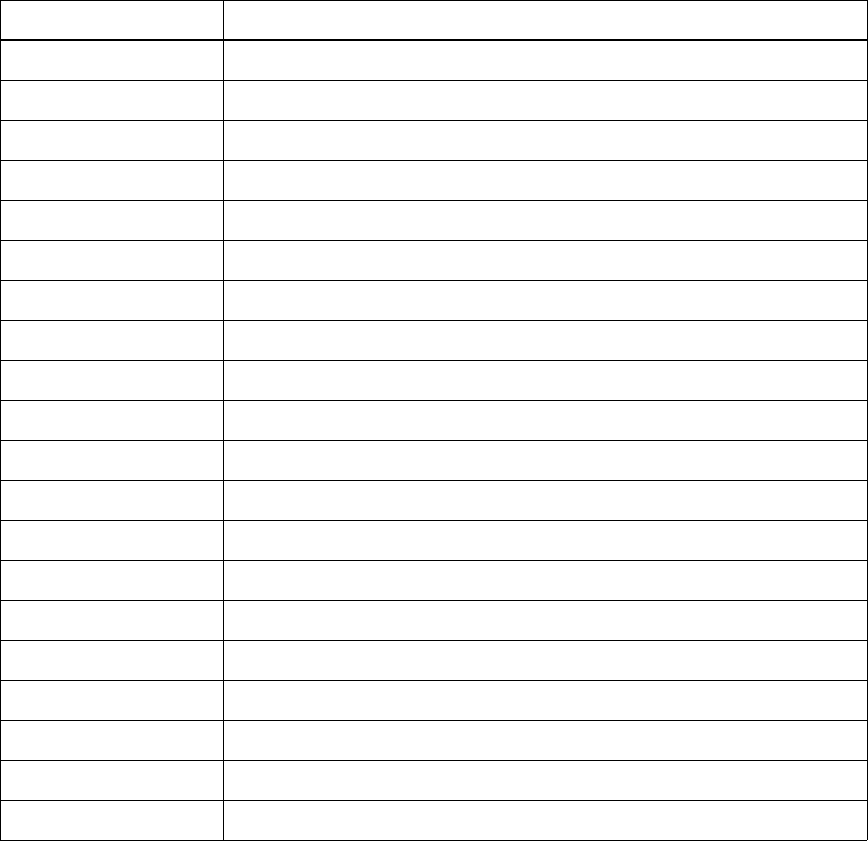
SYSTEM DESCRIPTION, INSTALLATION, AND MAINTENANCE MANUAL
eNfusion® HSD-440 Mark 2 Terminal
23-15-30 H-15
3 JUN 10
B500 Battery charging communication failure
B501 Power supply error
B580 Battery is over temperature, charging disabled
B581 Battery temperature is now ok, charging enabled
C0010F Fixed 64k speech
C00124 Fixed Aero 64k speech
C00404 Fixed data
C00504 Fixed facsimile
C00606 Fixed 64k UDI
C00607 Fixed 56k UDI
C00610 Fixed 64k audio 3k1
C00622 Fixed Aero 64k UDI
C00623 Fixed Aero 56k UDI
C00625 Fixed Aero 64k audio 3k1
CD0FFF Fixed Mini-M
CE0FFF Fixed HSD
CF0FFF Fixed
FFFD ACSE end marker (MPDS)
FFFE Status undefined (MPDS)
FFFF Status OK (MPDS)
Table H-1 Inmarsat Cause Code Definitions (Continued)
Inmarsat Cause Code Code Definition
SYSTEM DESCRIPTION, INSTALLATION, AND MAINTENANCE MANUAL
eNfusion® HSD-440 Mark 2 Terminal
23-15-30 H-16
3 JUN 10
Blank Page